Critical Approach for Port Management; the case of Greek Ports
VerifiedAdded on 2023/06/10
|85
|21272
|243
AI Summary
The study presents discussions on enumeration of performance of ports and dimensions are re-analysed for the two ports Piraeus and Thessaloniki during the period 2012 and 2015 in two different ways. The study also analyses the position of the two different ports in comparison to the European ports in terms of productivity and efficacy.
Contribute Materials
Your contribution can guide someone’s learning journey. Share your
documents today.
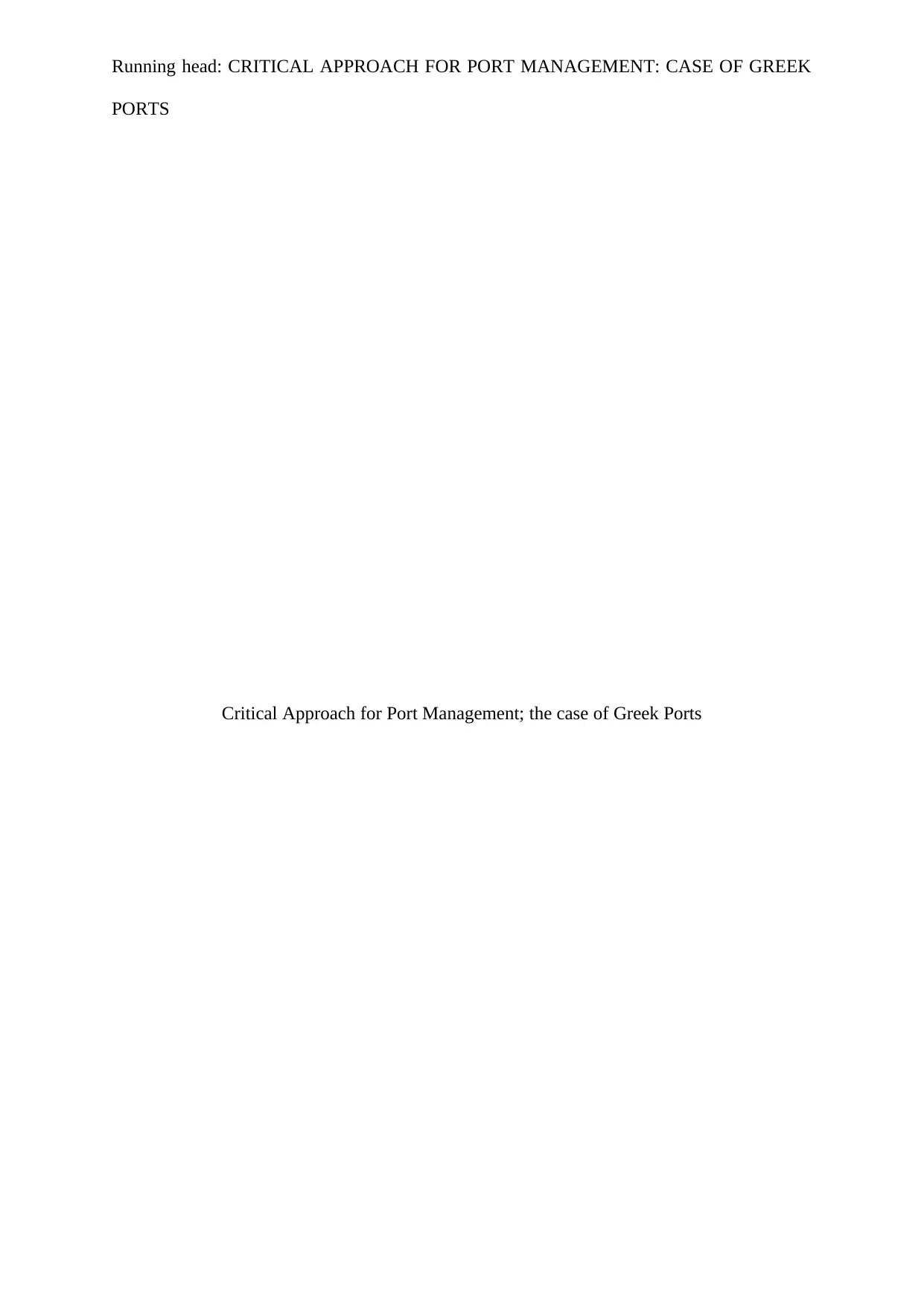
Running head: CRITICAL APPROACH FOR PORT MANAGEMENT: CASE OF GREEK
PORTS
Critical Approach for Port Management; the case of Greek Ports
PORTS
Critical Approach for Port Management; the case of Greek Ports
Secure Best Marks with AI Grader
Need help grading? Try our AI Grader for instant feedback on your assignments.

2
CRITICAL APPROACH FOR PORT MANAGEMENT: CASE OF GREEK PORTS
Acknowledgement
It has been a phase of concentrated and extensive learning for me, not only in the technical
pitch, but also on a personal plane. Presenting this dissertation has had a big influence on me
as I got the opportunity to reflect on those individuals who have upheld and supported me all
the way through the period.
Firstly, I would like to show gratitude to my colleagues from my internship undertaken at
(XYZ) for their magnificent association. You supported me to a great extent and were always
keen to help me in the research study on “Critical Approach for Port Management; the case of
Greek Ports”. I would particularly like to single out my supervisor at (XYZ), I want to thank
you for your excellent cooperation and for all of the opportunities I was given to accomplish
my research and further my dissertation. In addition, I would like to thank my tutors, (XYZ),
for their important supervision and assistance. You constantly delivered me with the tools
that I required to select the appropriate direction and successfully perform my dissertation.
I would also like to express thanks to my parents for their wise guidance and sympathetic ear.
You are for all time there for me to provide support and guidance. Essentially, there are my
friends. They were not only able to uphold each other by discussing over our concerns and
results, but gladly talked about things other than just research papers.
Thank you very much, everyone!
(XYZ)
CRITICAL APPROACH FOR PORT MANAGEMENT: CASE OF GREEK PORTS
Acknowledgement
It has been a phase of concentrated and extensive learning for me, not only in the technical
pitch, but also on a personal plane. Presenting this dissertation has had a big influence on me
as I got the opportunity to reflect on those individuals who have upheld and supported me all
the way through the period.
Firstly, I would like to show gratitude to my colleagues from my internship undertaken at
(XYZ) for their magnificent association. You supported me to a great extent and were always
keen to help me in the research study on “Critical Approach for Port Management; the case of
Greek Ports”. I would particularly like to single out my supervisor at (XYZ), I want to thank
you for your excellent cooperation and for all of the opportunities I was given to accomplish
my research and further my dissertation. In addition, I would like to thank my tutors, (XYZ),
for their important supervision and assistance. You constantly delivered me with the tools
that I required to select the appropriate direction and successfully perform my dissertation.
I would also like to express thanks to my parents for their wise guidance and sympathetic ear.
You are for all time there for me to provide support and guidance. Essentially, there are my
friends. They were not only able to uphold each other by discussing over our concerns and
results, but gladly talked about things other than just research papers.
Thank you very much, everyone!
(XYZ)
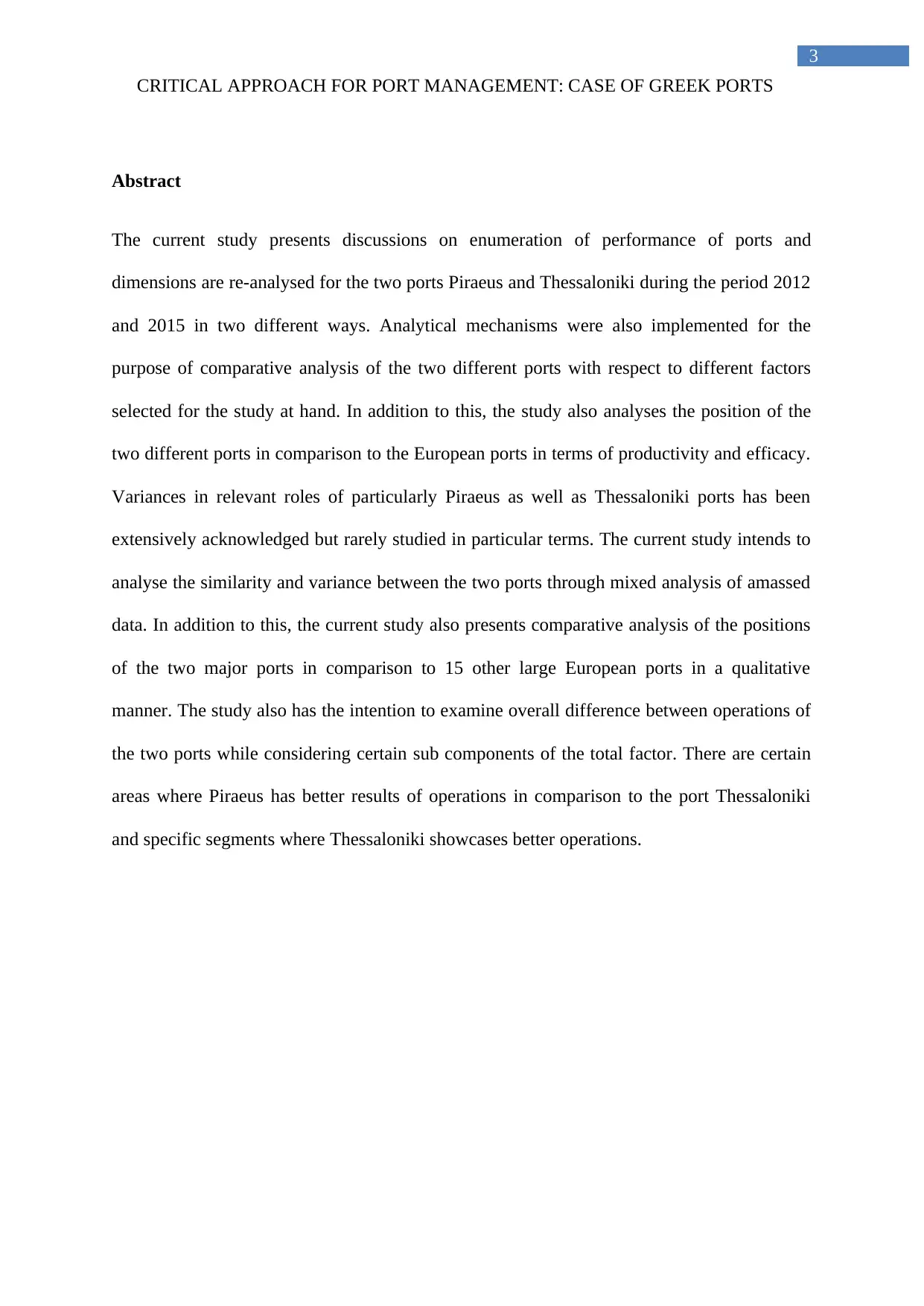
3
CRITICAL APPROACH FOR PORT MANAGEMENT: CASE OF GREEK PORTS
Abstract
The current study presents discussions on enumeration of performance of ports and
dimensions are re-analysed for the two ports Piraeus and Thessaloniki during the period 2012
and 2015 in two different ways. Analytical mechanisms were also implemented for the
purpose of comparative analysis of the two different ports with respect to different factors
selected for the study at hand. In addition to this, the study also analyses the position of the
two different ports in comparison to the European ports in terms of productivity and efficacy.
Variances in relevant roles of particularly Piraeus as well as Thessaloniki ports has been
extensively acknowledged but rarely studied in particular terms. The current study intends to
analyse the similarity and variance between the two ports through mixed analysis of amassed
data. In addition to this, the current study also presents comparative analysis of the positions
of the two major ports in comparison to 15 other large European ports in a qualitative
manner. The study also has the intention to examine overall difference between operations of
the two ports while considering certain sub components of the total factor. There are certain
areas where Piraeus has better results of operations in comparison to the port Thessaloniki
and specific segments where Thessaloniki showcases better operations.
CRITICAL APPROACH FOR PORT MANAGEMENT: CASE OF GREEK PORTS
Abstract
The current study presents discussions on enumeration of performance of ports and
dimensions are re-analysed for the two ports Piraeus and Thessaloniki during the period 2012
and 2015 in two different ways. Analytical mechanisms were also implemented for the
purpose of comparative analysis of the two different ports with respect to different factors
selected for the study at hand. In addition to this, the study also analyses the position of the
two different ports in comparison to the European ports in terms of productivity and efficacy.
Variances in relevant roles of particularly Piraeus as well as Thessaloniki ports has been
extensively acknowledged but rarely studied in particular terms. The current study intends to
analyse the similarity and variance between the two ports through mixed analysis of amassed
data. In addition to this, the current study also presents comparative analysis of the positions
of the two major ports in comparison to 15 other large European ports in a qualitative
manner. The study also has the intention to examine overall difference between operations of
the two ports while considering certain sub components of the total factor. There are certain
areas where Piraeus has better results of operations in comparison to the port Thessaloniki
and specific segments where Thessaloniki showcases better operations.
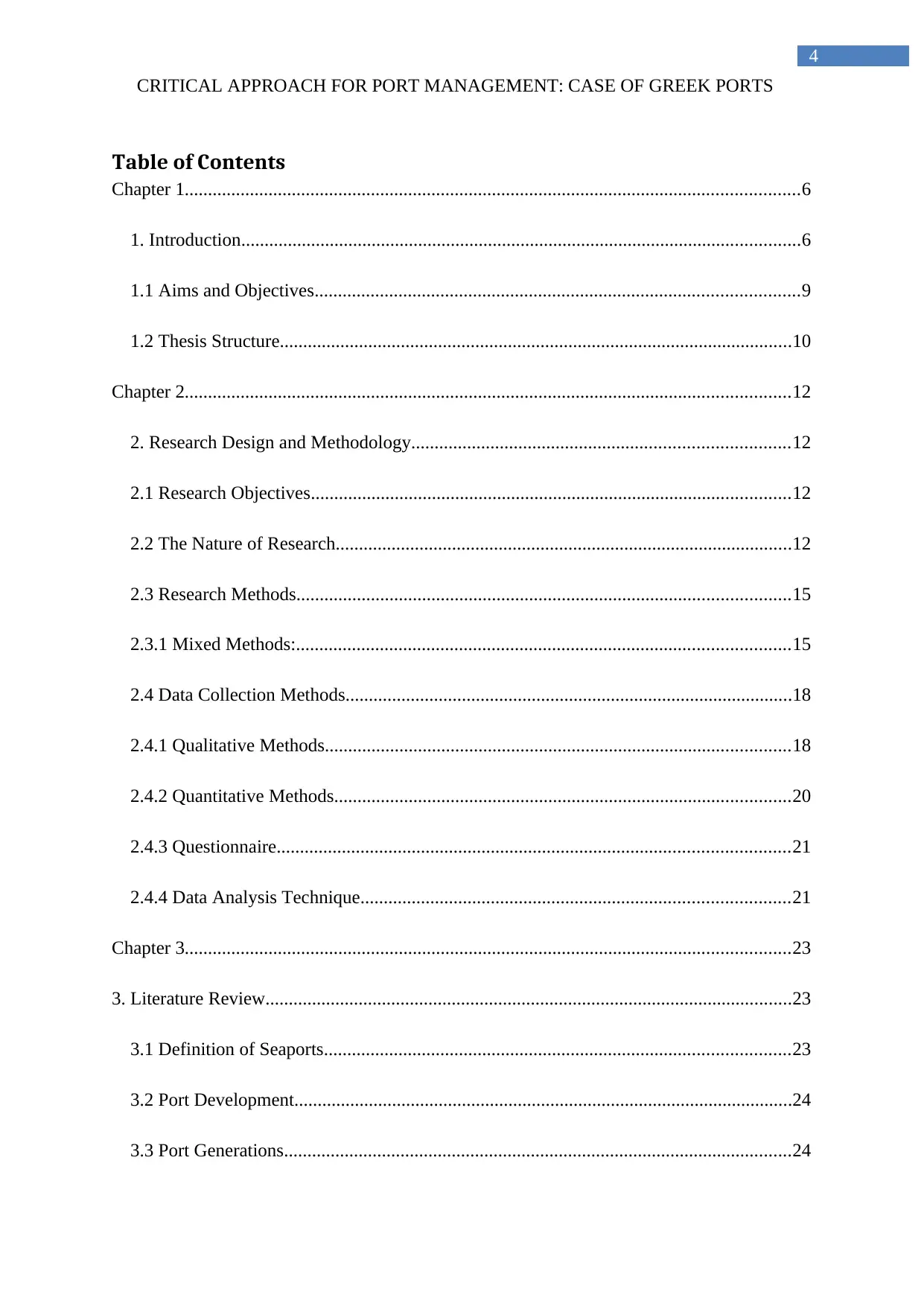
4
CRITICAL APPROACH FOR PORT MANAGEMENT: CASE OF GREEK PORTS
Table of Contents
Chapter 1....................................................................................................................................6
1. Introduction........................................................................................................................6
1.1 Aims and Objectives........................................................................................................9
1.2 Thesis Structure..............................................................................................................10
Chapter 2..................................................................................................................................12
2. Research Design and Methodology.................................................................................12
2.1 Research Objectives.......................................................................................................12
2.2 The Nature of Research..................................................................................................12
2.3 Research Methods..........................................................................................................15
2.3.1 Mixed Methods:..........................................................................................................15
2.4 Data Collection Methods................................................................................................18
2.4.1 Qualitative Methods....................................................................................................18
2.4.2 Quantitative Methods..................................................................................................20
2.4.3 Questionnaire..............................................................................................................21
2.4.4 Data Analysis Technique............................................................................................21
Chapter 3..................................................................................................................................23
3. Literature Review.................................................................................................................23
3.1 Definition of Seaports....................................................................................................23
3.2 Port Development...........................................................................................................24
3.3 Port Generations.............................................................................................................24
CRITICAL APPROACH FOR PORT MANAGEMENT: CASE OF GREEK PORTS
Table of Contents
Chapter 1....................................................................................................................................6
1. Introduction........................................................................................................................6
1.1 Aims and Objectives........................................................................................................9
1.2 Thesis Structure..............................................................................................................10
Chapter 2..................................................................................................................................12
2. Research Design and Methodology.................................................................................12
2.1 Research Objectives.......................................................................................................12
2.2 The Nature of Research..................................................................................................12
2.3 Research Methods..........................................................................................................15
2.3.1 Mixed Methods:..........................................................................................................15
2.4 Data Collection Methods................................................................................................18
2.4.1 Qualitative Methods....................................................................................................18
2.4.2 Quantitative Methods..................................................................................................20
2.4.3 Questionnaire..............................................................................................................21
2.4.4 Data Analysis Technique............................................................................................21
Chapter 3..................................................................................................................................23
3. Literature Review.................................................................................................................23
3.1 Definition of Seaports....................................................................................................23
3.2 Port Development...........................................................................................................24
3.3 Port Generations.............................................................................................................24
Paraphrase This Document
Need a fresh take? Get an instant paraphrase of this document with our AI Paraphraser
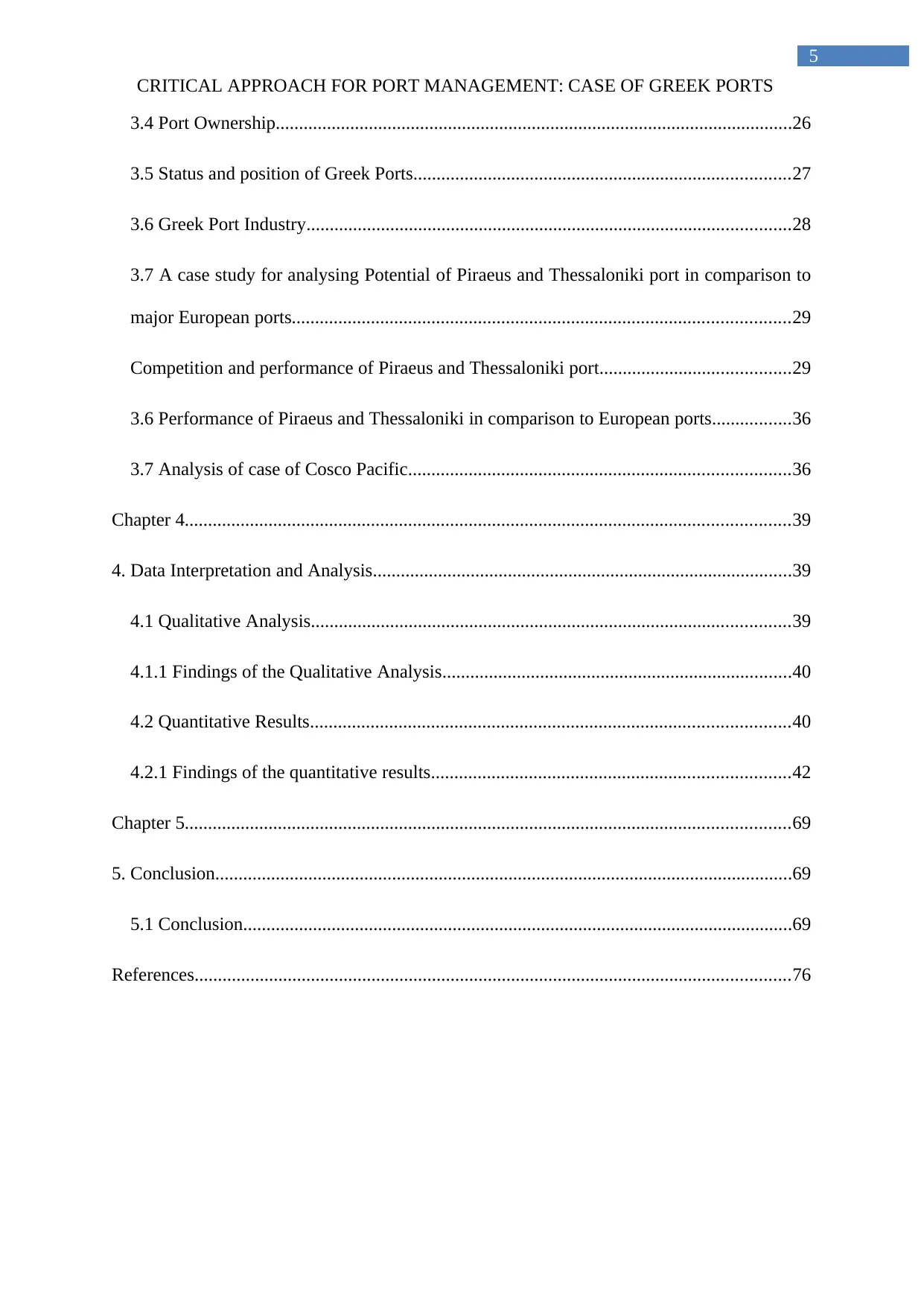
5
CRITICAL APPROACH FOR PORT MANAGEMENT: CASE OF GREEK PORTS
3.4 Port Ownership...............................................................................................................26
3.5 Status and position of Greek Ports.................................................................................27
3.6 Greek Port Industry........................................................................................................28
3.7 A case study for analysing Potential of Piraeus and Thessaloniki port in comparison to
major European ports...........................................................................................................29
Competition and performance of Piraeus and Thessaloniki port.........................................29
3.6 Performance of Piraeus and Thessaloniki in comparison to European ports.................36
3.7 Analysis of case of Cosco Pacific..................................................................................36
Chapter 4..................................................................................................................................39
4. Data Interpretation and Analysis..........................................................................................39
4.1 Qualitative Analysis.......................................................................................................39
4.1.1 Findings of the Qualitative Analysis...........................................................................40
4.2 Quantitative Results.......................................................................................................40
4.2.1 Findings of the quantitative results.............................................................................42
Chapter 5..................................................................................................................................69
5. Conclusion............................................................................................................................69
5.1 Conclusion......................................................................................................................69
References................................................................................................................................76
CRITICAL APPROACH FOR PORT MANAGEMENT: CASE OF GREEK PORTS
3.4 Port Ownership...............................................................................................................26
3.5 Status and position of Greek Ports.................................................................................27
3.6 Greek Port Industry........................................................................................................28
3.7 A case study for analysing Potential of Piraeus and Thessaloniki port in comparison to
major European ports...........................................................................................................29
Competition and performance of Piraeus and Thessaloniki port.........................................29
3.6 Performance of Piraeus and Thessaloniki in comparison to European ports.................36
3.7 Analysis of case of Cosco Pacific..................................................................................36
Chapter 4..................................................................................................................................39
4. Data Interpretation and Analysis..........................................................................................39
4.1 Qualitative Analysis.......................................................................................................39
4.1.1 Findings of the Qualitative Analysis...........................................................................40
4.2 Quantitative Results.......................................................................................................40
4.2.1 Findings of the quantitative results.............................................................................42
Chapter 5..................................................................................................................................69
5. Conclusion............................................................................................................................69
5.1 Conclusion......................................................................................................................69
References................................................................................................................................76
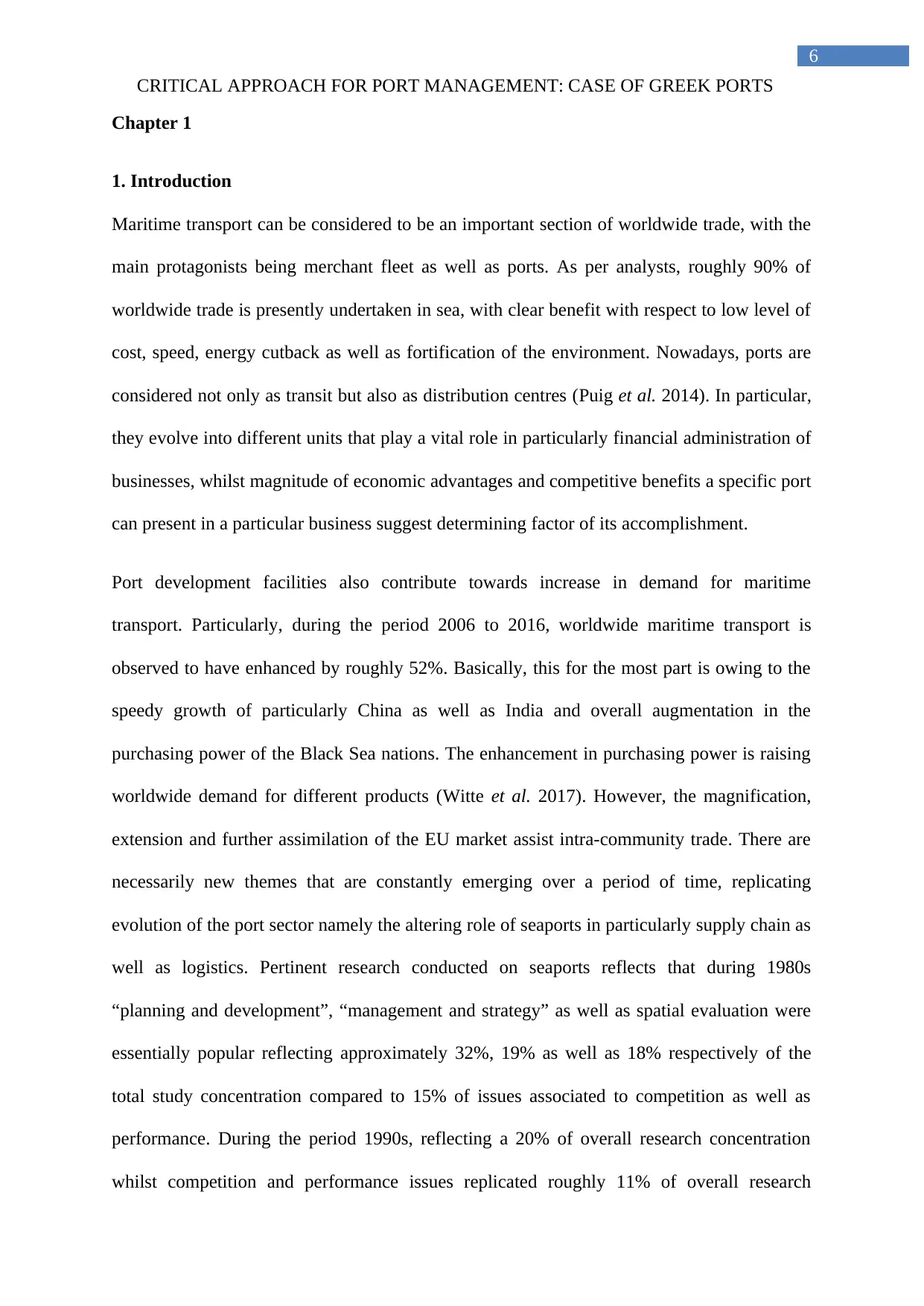
6
CRITICAL APPROACH FOR PORT MANAGEMENT: CASE OF GREEK PORTS
Chapter 1
1. Introduction
Maritime transport can be considered to be an important section of worldwide trade, with the
main protagonists being merchant fleet as well as ports. As per analysts, roughly 90% of
worldwide trade is presently undertaken in sea, with clear benefit with respect to low level of
cost, speed, energy cutback as well as fortification of the environment. Nowadays, ports are
considered not only as transit but also as distribution centres (Puig et al. 2014). In particular,
they evolve into different units that play a vital role in particularly financial administration of
businesses, whilst magnitude of economic advantages and competitive benefits a specific port
can present in a particular business suggest determining factor of its accomplishment.
Port development facilities also contribute towards increase in demand for maritime
transport. Particularly, during the period 2006 to 2016, worldwide maritime transport is
observed to have enhanced by roughly 52%. Basically, this for the most part is owing to the
speedy growth of particularly China as well as India and overall augmentation in the
purchasing power of the Black Sea nations. The enhancement in purchasing power is raising
worldwide demand for different products (Witte et al. 2017). However, the magnification,
extension and further assimilation of the EU market assist intra-community trade. There are
necessarily new themes that are constantly emerging over a period of time, replicating
evolution of the port sector namely the altering role of seaports in particularly supply chain as
well as logistics. Pertinent research conducted on seaports reflects that during 1980s
“planning and development”, “management and strategy” as well as spatial evaluation were
essentially popular reflecting approximately 32%, 19% as well as 18% respectively of the
total study concentration compared to 15% of issues associated to competition as well as
performance. During the period 1990s, reflecting a 20% of overall research concentration
whilst competition and performance issues replicated roughly 11% of overall research
CRITICAL APPROACH FOR PORT MANAGEMENT: CASE OF GREEK PORTS
Chapter 1
1. Introduction
Maritime transport can be considered to be an important section of worldwide trade, with the
main protagonists being merchant fleet as well as ports. As per analysts, roughly 90% of
worldwide trade is presently undertaken in sea, with clear benefit with respect to low level of
cost, speed, energy cutback as well as fortification of the environment. Nowadays, ports are
considered not only as transit but also as distribution centres (Puig et al. 2014). In particular,
they evolve into different units that play a vital role in particularly financial administration of
businesses, whilst magnitude of economic advantages and competitive benefits a specific port
can present in a particular business suggest determining factor of its accomplishment.
Port development facilities also contribute towards increase in demand for maritime
transport. Particularly, during the period 2006 to 2016, worldwide maritime transport is
observed to have enhanced by roughly 52%. Basically, this for the most part is owing to the
speedy growth of particularly China as well as India and overall augmentation in the
purchasing power of the Black Sea nations. The enhancement in purchasing power is raising
worldwide demand for different products (Witte et al. 2017). However, the magnification,
extension and further assimilation of the EU market assist intra-community trade. There are
necessarily new themes that are constantly emerging over a period of time, replicating
evolution of the port sector namely the altering role of seaports in particularly supply chain as
well as logistics. Pertinent research conducted on seaports reflects that during 1980s
“planning and development”, “management and strategy” as well as spatial evaluation were
essentially popular reflecting approximately 32%, 19% as well as 18% respectively of the
total study concentration compared to 15% of issues associated to competition as well as
performance. During the period 1990s, reflecting a 20% of overall research concentration
whilst competition and performance issues replicated roughly 11% of overall research
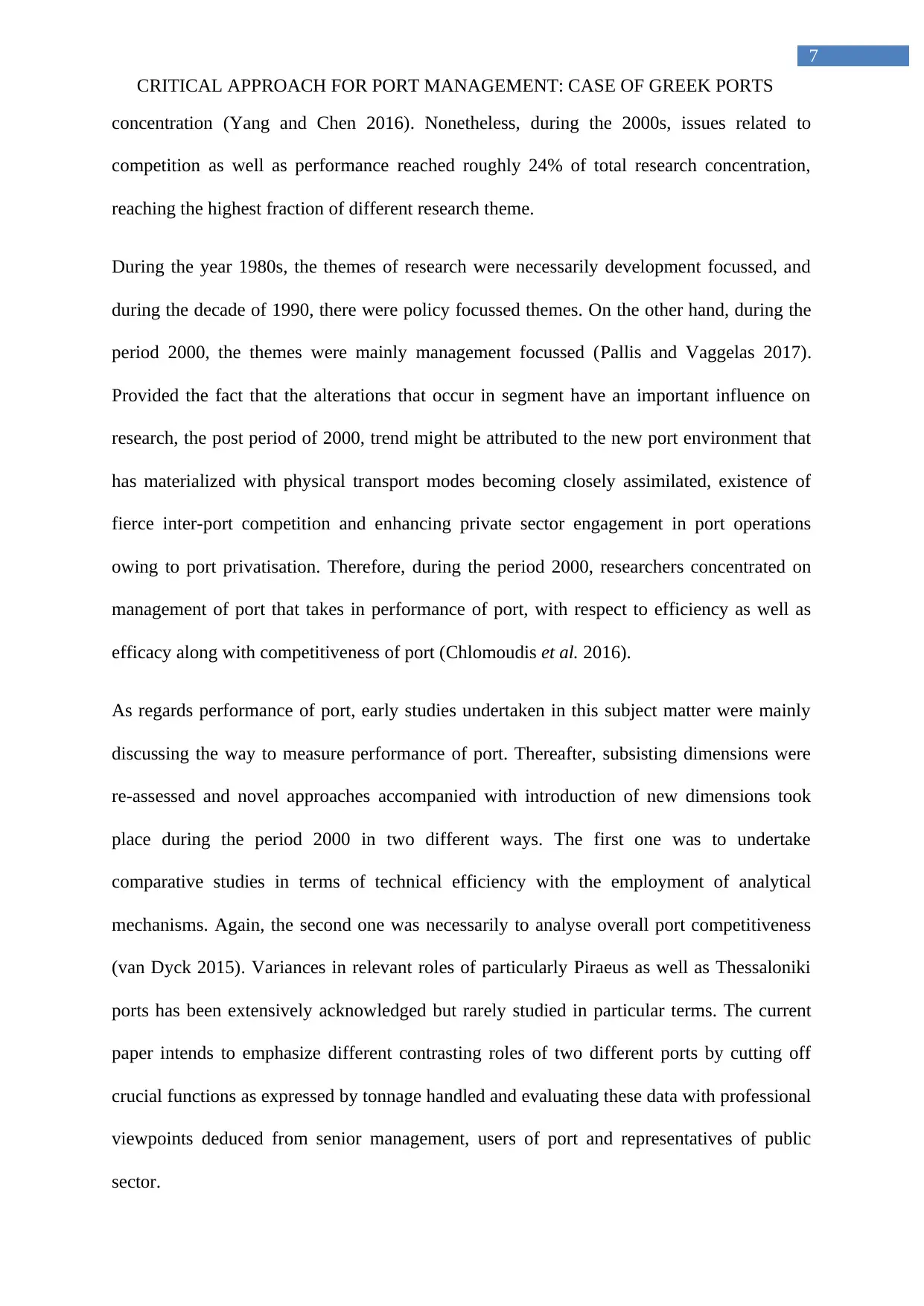
7
CRITICAL APPROACH FOR PORT MANAGEMENT: CASE OF GREEK PORTS
concentration (Yang and Chen 2016). Nonetheless, during the 2000s, issues related to
competition as well as performance reached roughly 24% of total research concentration,
reaching the highest fraction of different research theme.
During the year 1980s, the themes of research were necessarily development focussed, and
during the decade of 1990, there were policy focussed themes. On the other hand, during the
period 2000, the themes were mainly management focussed (Pallis and Vaggelas 2017).
Provided the fact that the alterations that occur in segment have an important influence on
research, the post period of 2000, trend might be attributed to the new port environment that
has materialized with physical transport modes becoming closely assimilated, existence of
fierce inter-port competition and enhancing private sector engagement in port operations
owing to port privatisation. Therefore, during the period 2000, researchers concentrated on
management of port that takes in performance of port, with respect to efficiency as well as
efficacy along with competitiveness of port (Chlomoudis et al. 2016).
As regards performance of port, early studies undertaken in this subject matter were mainly
discussing the way to measure performance of port. Thereafter, subsisting dimensions were
re-assessed and novel approaches accompanied with introduction of new dimensions took
place during the period 2000 in two different ways. The first one was to undertake
comparative studies in terms of technical efficiency with the employment of analytical
mechanisms. Again, the second one was necessarily to analyse overall port competitiveness
(van Dyck 2015). Variances in relevant roles of particularly Piraeus as well as Thessaloniki
ports has been extensively acknowledged but rarely studied in particular terms. The current
paper intends to emphasize different contrasting roles of two different ports by cutting off
crucial functions as expressed by tonnage handled and evaluating these data with professional
viewpoints deduced from senior management, users of port and representatives of public
sector.
CRITICAL APPROACH FOR PORT MANAGEMENT: CASE OF GREEK PORTS
concentration (Yang and Chen 2016). Nonetheless, during the 2000s, issues related to
competition as well as performance reached roughly 24% of total research concentration,
reaching the highest fraction of different research theme.
During the year 1980s, the themes of research were necessarily development focussed, and
during the decade of 1990, there were policy focussed themes. On the other hand, during the
period 2000, the themes were mainly management focussed (Pallis and Vaggelas 2017).
Provided the fact that the alterations that occur in segment have an important influence on
research, the post period of 2000, trend might be attributed to the new port environment that
has materialized with physical transport modes becoming closely assimilated, existence of
fierce inter-port competition and enhancing private sector engagement in port operations
owing to port privatisation. Therefore, during the period 2000, researchers concentrated on
management of port that takes in performance of port, with respect to efficiency as well as
efficacy along with competitiveness of port (Chlomoudis et al. 2016).
As regards performance of port, early studies undertaken in this subject matter were mainly
discussing the way to measure performance of port. Thereafter, subsisting dimensions were
re-assessed and novel approaches accompanied with introduction of new dimensions took
place during the period 2000 in two different ways. The first one was to undertake
comparative studies in terms of technical efficiency with the employment of analytical
mechanisms. Again, the second one was necessarily to analyse overall port competitiveness
(van Dyck 2015). Variances in relevant roles of particularly Piraeus as well as Thessaloniki
ports has been extensively acknowledged but rarely studied in particular terms. The current
paper intends to emphasize different contrasting roles of two different ports by cutting off
crucial functions as expressed by tonnage handled and evaluating these data with professional
viewpoints deduced from senior management, users of port and representatives of public
sector.
Secure Best Marks with AI Grader
Need help grading? Try our AI Grader for instant feedback on your assignments.
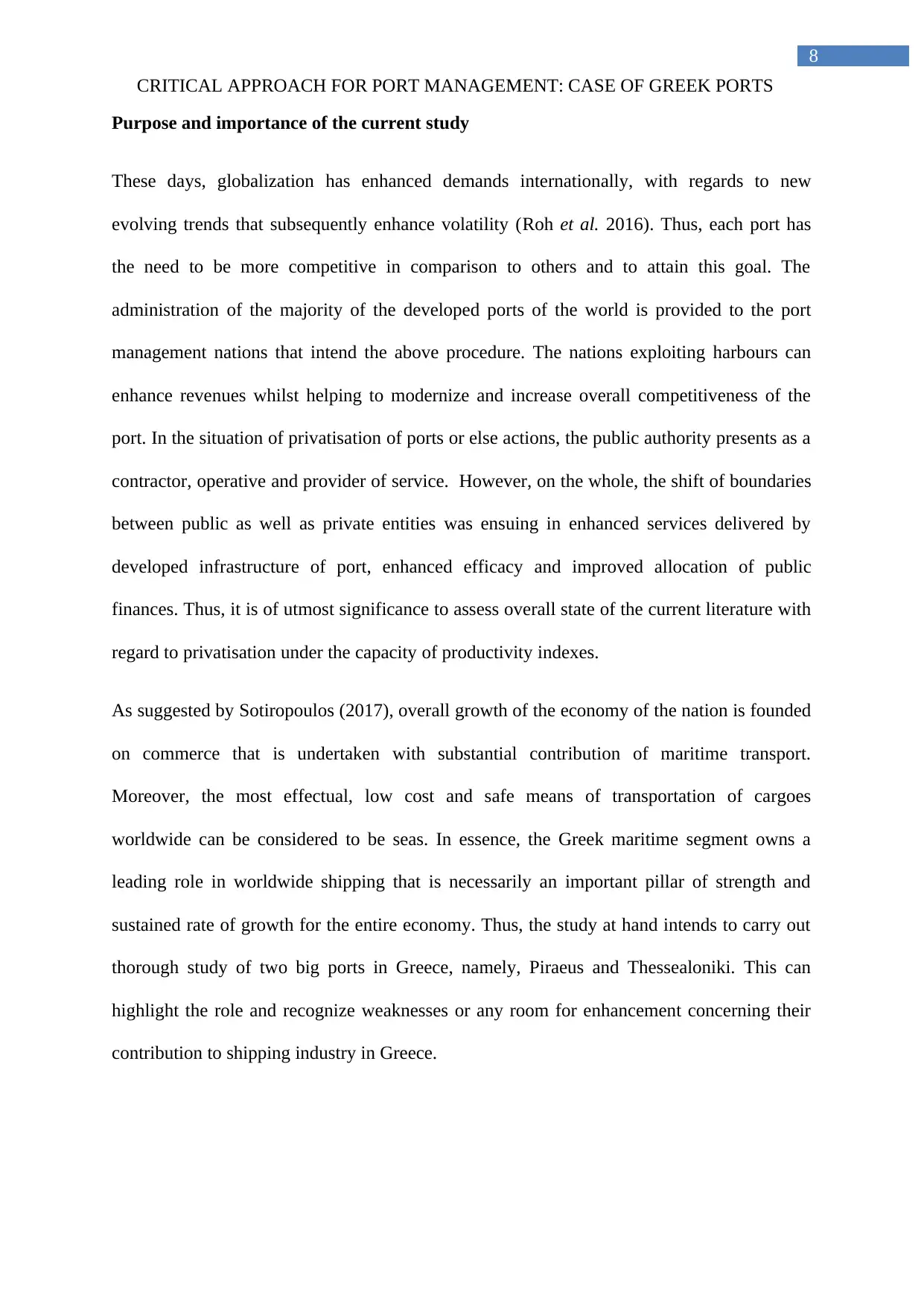
8
CRITICAL APPROACH FOR PORT MANAGEMENT: CASE OF GREEK PORTS
Purpose and importance of the current study
These days, globalization has enhanced demands internationally, with regards to new
evolving trends that subsequently enhance volatility (Roh et al. 2016). Thus, each port has
the need to be more competitive in comparison to others and to attain this goal. The
administration of the majority of the developed ports of the world is provided to the port
management nations that intend the above procedure. The nations exploiting harbours can
enhance revenues whilst helping to modernize and increase overall competitiveness of the
port. In the situation of privatisation of ports or else actions, the public authority presents as a
contractor, operative and provider of service. However, on the whole, the shift of boundaries
between public as well as private entities was ensuing in enhanced services delivered by
developed infrastructure of port, enhanced efficacy and improved allocation of public
finances. Thus, it is of utmost significance to assess overall state of the current literature with
regard to privatisation under the capacity of productivity indexes.
As suggested by Sotiropoulos (2017), overall growth of the economy of the nation is founded
on commerce that is undertaken with substantial contribution of maritime transport.
Moreover, the most effectual, low cost and safe means of transportation of cargoes
worldwide can be considered to be seas. In essence, the Greek maritime segment owns a
leading role in worldwide shipping that is necessarily an important pillar of strength and
sustained rate of growth for the entire economy. Thus, the study at hand intends to carry out
thorough study of two big ports in Greece, namely, Piraeus and Thessealoniki. This can
highlight the role and recognize weaknesses or any room for enhancement concerning their
contribution to shipping industry in Greece.
CRITICAL APPROACH FOR PORT MANAGEMENT: CASE OF GREEK PORTS
Purpose and importance of the current study
These days, globalization has enhanced demands internationally, with regards to new
evolving trends that subsequently enhance volatility (Roh et al. 2016). Thus, each port has
the need to be more competitive in comparison to others and to attain this goal. The
administration of the majority of the developed ports of the world is provided to the port
management nations that intend the above procedure. The nations exploiting harbours can
enhance revenues whilst helping to modernize and increase overall competitiveness of the
port. In the situation of privatisation of ports or else actions, the public authority presents as a
contractor, operative and provider of service. However, on the whole, the shift of boundaries
between public as well as private entities was ensuing in enhanced services delivered by
developed infrastructure of port, enhanced efficacy and improved allocation of public
finances. Thus, it is of utmost significance to assess overall state of the current literature with
regard to privatisation under the capacity of productivity indexes.
As suggested by Sotiropoulos (2017), overall growth of the economy of the nation is founded
on commerce that is undertaken with substantial contribution of maritime transport.
Moreover, the most effectual, low cost and safe means of transportation of cargoes
worldwide can be considered to be seas. In essence, the Greek maritime segment owns a
leading role in worldwide shipping that is necessarily an important pillar of strength and
sustained rate of growth for the entire economy. Thus, the study at hand intends to carry out
thorough study of two big ports in Greece, namely, Piraeus and Thessealoniki. This can
highlight the role and recognize weaknesses or any room for enhancement concerning their
contribution to shipping industry in Greece.
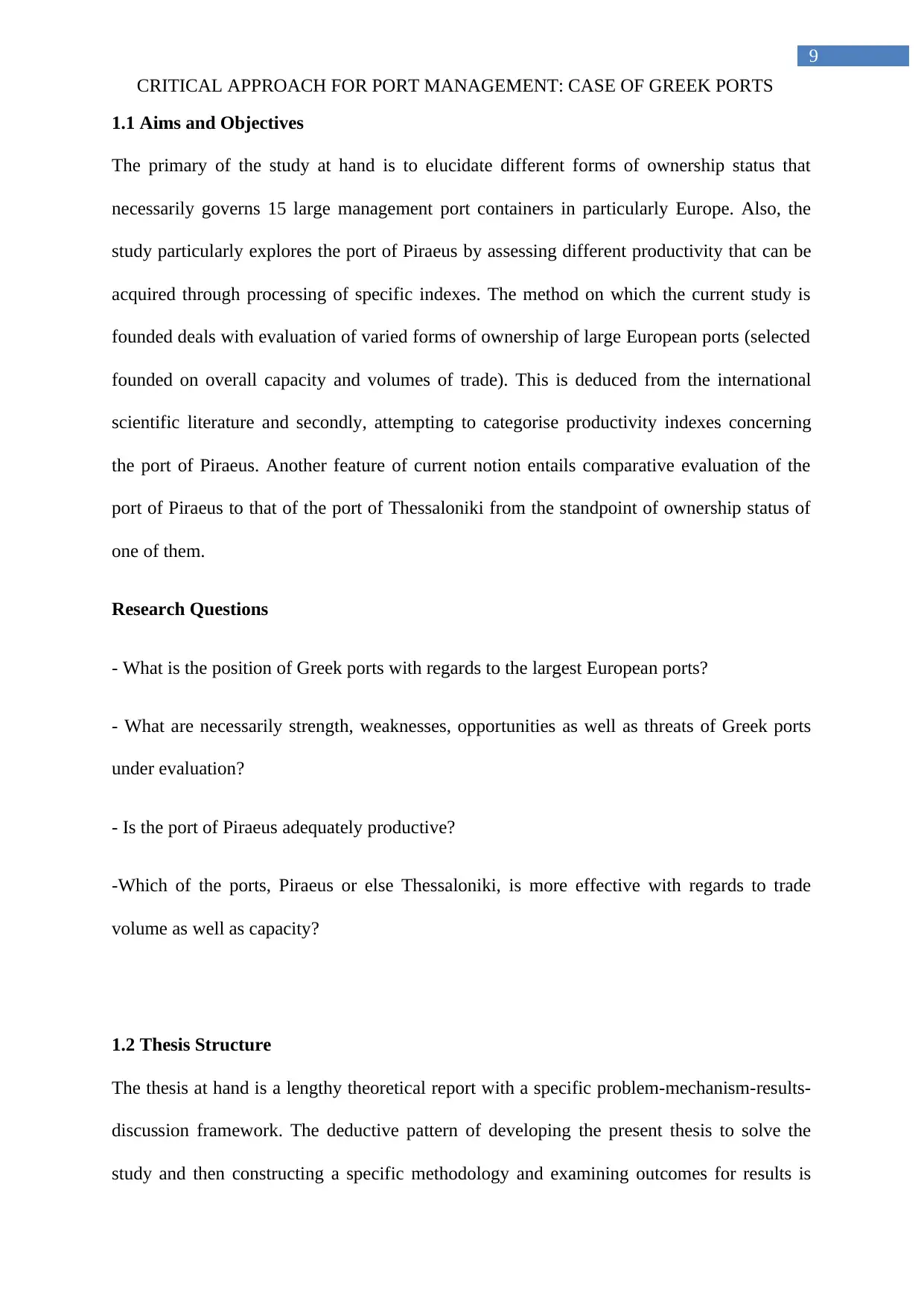
9
CRITICAL APPROACH FOR PORT MANAGEMENT: CASE OF GREEK PORTS
1.1 Aims and Objectives
The primary of the study at hand is to elucidate different forms of ownership status that
necessarily governs 15 large management port containers in particularly Europe. Also, the
study particularly explores the port of Piraeus by assessing different productivity that can be
acquired through processing of specific indexes. The method on which the current study is
founded deals with evaluation of varied forms of ownership of large European ports (selected
founded on overall capacity and volumes of trade). This is deduced from the international
scientific literature and secondly, attempting to categorise productivity indexes concerning
the port of Piraeus. Another feature of current notion entails comparative evaluation of the
port of Piraeus to that of the port of Thessaloniki from the standpoint of ownership status of
one of them.
Research Questions
- What is the position of Greek ports with regards to the largest European ports?
- What are necessarily strength, weaknesses, opportunities as well as threats of Greek ports
under evaluation?
- Is the port of Piraeus adequately productive?
-Which of the ports, Piraeus or else Thessaloniki, is more effective with regards to trade
volume as well as capacity?
1.2 Thesis Structure
The thesis at hand is a lengthy theoretical report with a specific problem-mechanism-results-
discussion framework. The deductive pattern of developing the present thesis to solve the
study and then constructing a specific methodology and examining outcomes for results is
CRITICAL APPROACH FOR PORT MANAGEMENT: CASE OF GREEK PORTS
1.1 Aims and Objectives
The primary of the study at hand is to elucidate different forms of ownership status that
necessarily governs 15 large management port containers in particularly Europe. Also, the
study particularly explores the port of Piraeus by assessing different productivity that can be
acquired through processing of specific indexes. The method on which the current study is
founded deals with evaluation of varied forms of ownership of large European ports (selected
founded on overall capacity and volumes of trade). This is deduced from the international
scientific literature and secondly, attempting to categorise productivity indexes concerning
the port of Piraeus. Another feature of current notion entails comparative evaluation of the
port of Piraeus to that of the port of Thessaloniki from the standpoint of ownership status of
one of them.
Research Questions
- What is the position of Greek ports with regards to the largest European ports?
- What are necessarily strength, weaknesses, opportunities as well as threats of Greek ports
under evaluation?
- Is the port of Piraeus adequately productive?
-Which of the ports, Piraeus or else Thessaloniki, is more effective with regards to trade
volume as well as capacity?
1.2 Thesis Structure
The thesis at hand is a lengthy theoretical report with a specific problem-mechanism-results-
discussion framework. The deductive pattern of developing the present thesis to solve the
study and then constructing a specific methodology and examining outcomes for results is
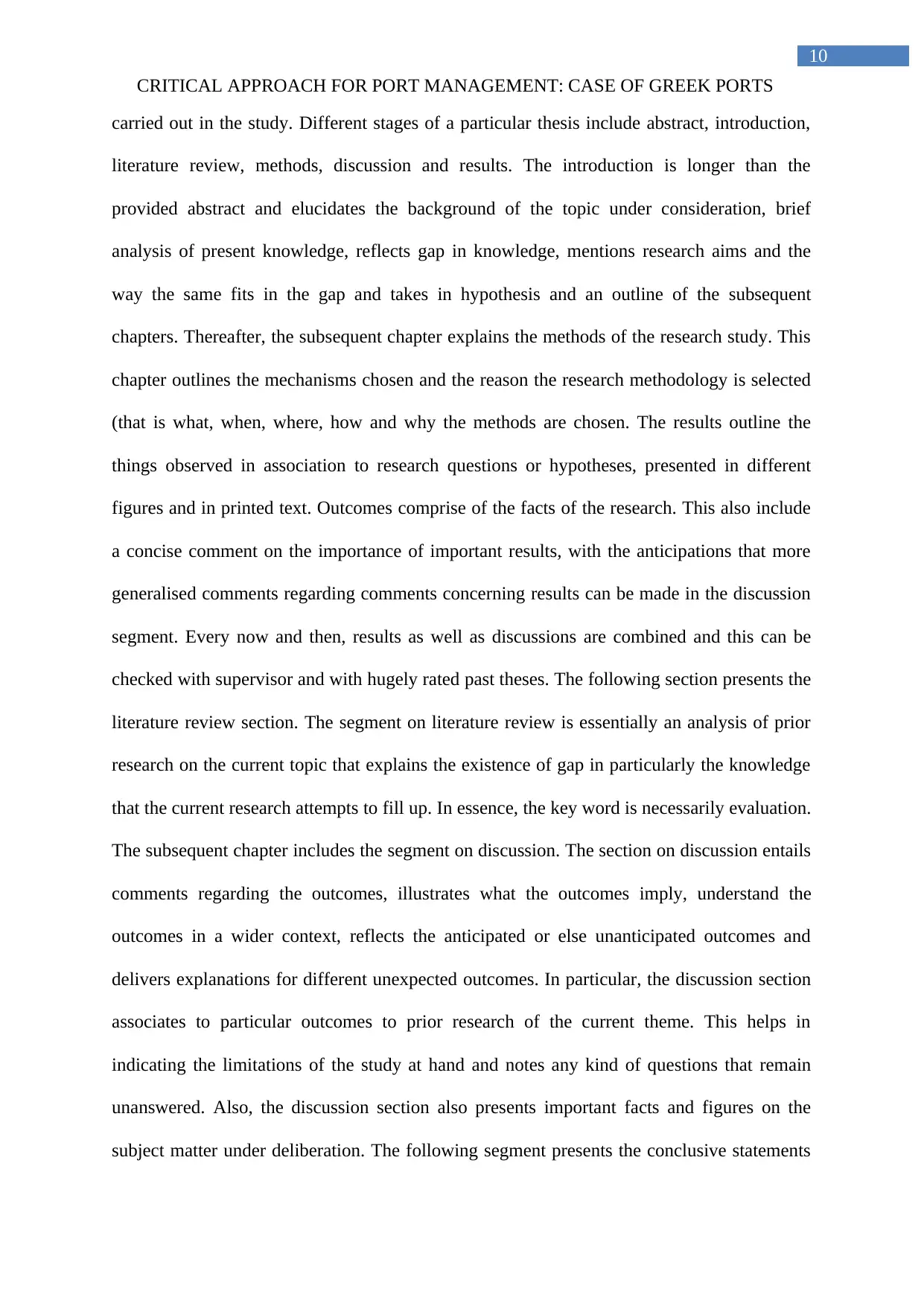
10
CRITICAL APPROACH FOR PORT MANAGEMENT: CASE OF GREEK PORTS
carried out in the study. Different stages of a particular thesis include abstract, introduction,
literature review, methods, discussion and results. The introduction is longer than the
provided abstract and elucidates the background of the topic under consideration, brief
analysis of present knowledge, reflects gap in knowledge, mentions research aims and the
way the same fits in the gap and takes in hypothesis and an outline of the subsequent
chapters. Thereafter, the subsequent chapter explains the methods of the research study. This
chapter outlines the mechanisms chosen and the reason the research methodology is selected
(that is what, when, where, how and why the methods are chosen. The results outline the
things observed in association to research questions or hypotheses, presented in different
figures and in printed text. Outcomes comprise of the facts of the research. This also include
a concise comment on the importance of important results, with the anticipations that more
generalised comments regarding comments concerning results can be made in the discussion
segment. Every now and then, results as well as discussions are combined and this can be
checked with supervisor and with hugely rated past theses. The following section presents the
literature review section. The segment on literature review is essentially an analysis of prior
research on the current topic that explains the existence of gap in particularly the knowledge
that the current research attempts to fill up. In essence, the key word is necessarily evaluation.
The subsequent chapter includes the segment on discussion. The section on discussion entails
comments regarding the outcomes, illustrates what the outcomes imply, understand the
outcomes in a wider context, reflects the anticipated or else unanticipated outcomes and
delivers explanations for different unexpected outcomes. In particular, the discussion section
associates to particular outcomes to prior research of the current theme. This helps in
indicating the limitations of the study at hand and notes any kind of questions that remain
unanswered. Also, the discussion section also presents important facts and figures on the
subject matter under deliberation. The following segment presents the conclusive statements
CRITICAL APPROACH FOR PORT MANAGEMENT: CASE OF GREEK PORTS
carried out in the study. Different stages of a particular thesis include abstract, introduction,
literature review, methods, discussion and results. The introduction is longer than the
provided abstract and elucidates the background of the topic under consideration, brief
analysis of present knowledge, reflects gap in knowledge, mentions research aims and the
way the same fits in the gap and takes in hypothesis and an outline of the subsequent
chapters. Thereafter, the subsequent chapter explains the methods of the research study. This
chapter outlines the mechanisms chosen and the reason the research methodology is selected
(that is what, when, where, how and why the methods are chosen. The results outline the
things observed in association to research questions or hypotheses, presented in different
figures and in printed text. Outcomes comprise of the facts of the research. This also include
a concise comment on the importance of important results, with the anticipations that more
generalised comments regarding comments concerning results can be made in the discussion
segment. Every now and then, results as well as discussions are combined and this can be
checked with supervisor and with hugely rated past theses. The following section presents the
literature review section. The segment on literature review is essentially an analysis of prior
research on the current topic that explains the existence of gap in particularly the knowledge
that the current research attempts to fill up. In essence, the key word is necessarily evaluation.
The subsequent chapter includes the segment on discussion. The section on discussion entails
comments regarding the outcomes, illustrates what the outcomes imply, understand the
outcomes in a wider context, reflects the anticipated or else unanticipated outcomes and
delivers explanations for different unexpected outcomes. In particular, the discussion section
associates to particular outcomes to prior research of the current theme. This helps in
indicating the limitations of the study at hand and notes any kind of questions that remain
unanswered. Also, the discussion section also presents important facts and figures on the
subject matter under deliberation. The following segment presents the conclusive statements
Paraphrase This Document
Need a fresh take? Get an instant paraphrase of this document with our AI Paraphraser

11
CRITICAL APPROACH FOR PORT MANAGEMENT: CASE OF GREEK PORTS
that emphasize research aims plus objectives attained. This also helps in emphasizing the
aims of the research that have been attained. Also, this also stresses the most important
outcomes, specifies the limitations and present suggestions for further study.
CRITICAL APPROACH FOR PORT MANAGEMENT: CASE OF GREEK PORTS
that emphasize research aims plus objectives attained. This also helps in emphasizing the
aims of the research that have been attained. Also, this also stresses the most important
outcomes, specifies the limitations and present suggestions for further study.
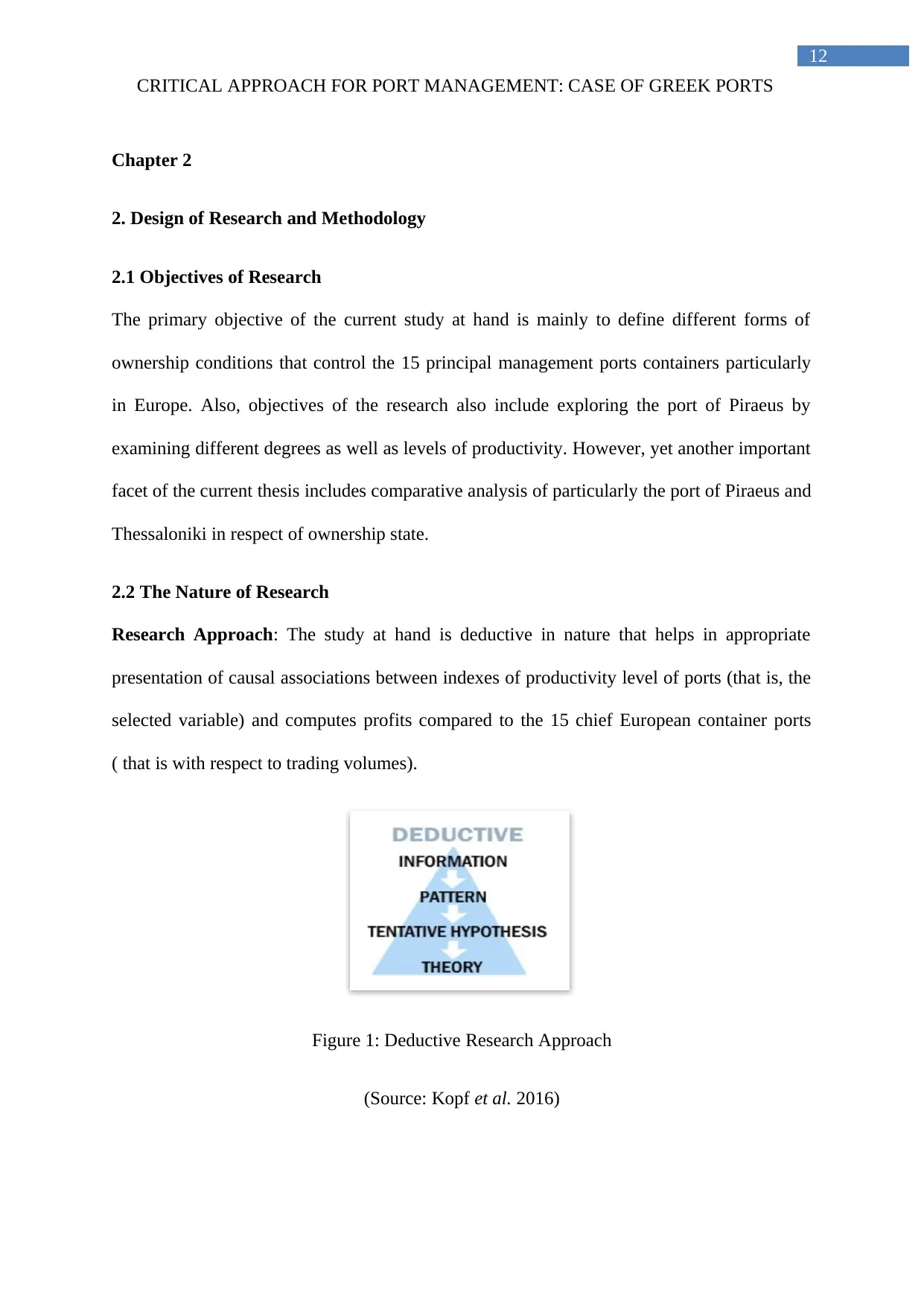
12
CRITICAL APPROACH FOR PORT MANAGEMENT: CASE OF GREEK PORTS
Chapter 2
2. Design of Research and Methodology
2.1 Objectives of Research
The primary objective of the current study at hand is mainly to define different forms of
ownership conditions that control the 15 principal management ports containers particularly
in Europe. Also, objectives of the research also include exploring the port of Piraeus by
examining different degrees as well as levels of productivity. However, yet another important
facet of the current thesis includes comparative analysis of particularly the port of Piraeus and
Thessaloniki in respect of ownership state.
2.2 The Nature of Research
Research Approach: The study at hand is deductive in nature that helps in appropriate
presentation of causal associations between indexes of productivity level of ports (that is, the
selected variable) and computes profits compared to the 15 chief European container ports
( that is with respect to trading volumes).
Figure 1: Deductive Research Approach
(Source: Kopf et al. 2016)
CRITICAL APPROACH FOR PORT MANAGEMENT: CASE OF GREEK PORTS
Chapter 2
2. Design of Research and Methodology
2.1 Objectives of Research
The primary objective of the current study at hand is mainly to define different forms of
ownership conditions that control the 15 principal management ports containers particularly
in Europe. Also, objectives of the research also include exploring the port of Piraeus by
examining different degrees as well as levels of productivity. However, yet another important
facet of the current thesis includes comparative analysis of particularly the port of Piraeus and
Thessaloniki in respect of ownership state.
2.2 The Nature of Research
Research Approach: The study at hand is deductive in nature that helps in appropriate
presentation of causal associations between indexes of productivity level of ports (that is, the
selected variable) and computes profits compared to the 15 chief European container ports
( that is with respect to trading volumes).
Figure 1: Deductive Research Approach
(Source: Kopf et al. 2016)
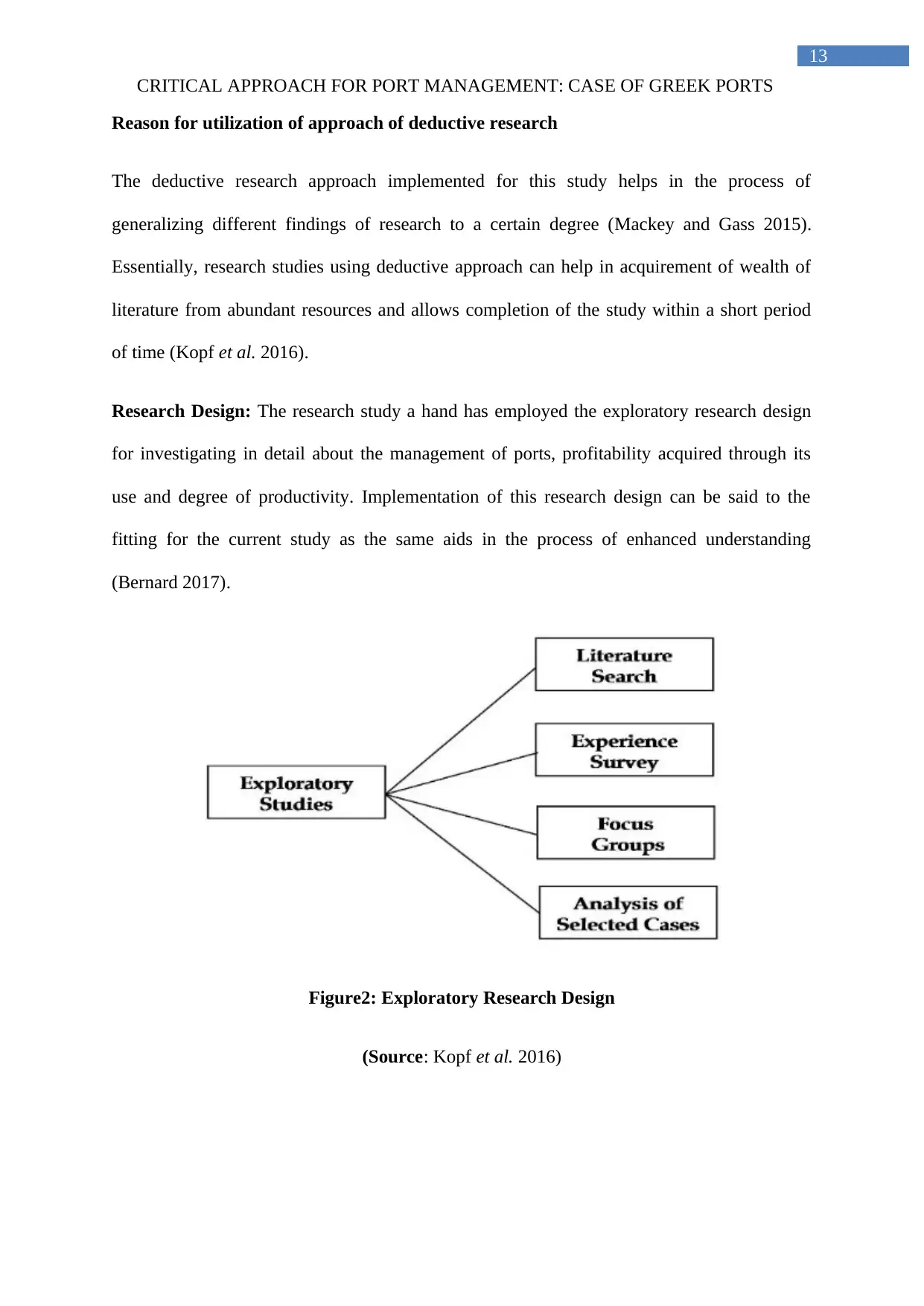
13
CRITICAL APPROACH FOR PORT MANAGEMENT: CASE OF GREEK PORTS
Reason for utilization of approach of deductive research
The deductive research approach implemented for this study helps in the process of
generalizing different findings of research to a certain degree (Mackey and Gass 2015).
Essentially, research studies using deductive approach can help in acquirement of wealth of
literature from abundant resources and allows completion of the study within a short period
of time (Kopf et al. 2016).
Research Design: The research study a hand has employed the exploratory research design
for investigating in detail about the management of ports, profitability acquired through its
use and degree of productivity. Implementation of this research design can be said to the
fitting for the current study as the same aids in the process of enhanced understanding
(Bernard 2017).
Figure2: Exploratory Research Design
(Source: Kopf et al. 2016)
CRITICAL APPROACH FOR PORT MANAGEMENT: CASE OF GREEK PORTS
Reason for utilization of approach of deductive research
The deductive research approach implemented for this study helps in the process of
generalizing different findings of research to a certain degree (Mackey and Gass 2015).
Essentially, research studies using deductive approach can help in acquirement of wealth of
literature from abundant resources and allows completion of the study within a short period
of time (Kopf et al. 2016).
Research Design: The research study a hand has employed the exploratory research design
for investigating in detail about the management of ports, profitability acquired through its
use and degree of productivity. Implementation of this research design can be said to the
fitting for the current study as the same aids in the process of enhanced understanding
(Bernard 2017).
Figure2: Exploratory Research Design
(Source: Kopf et al. 2016)
Secure Best Marks with AI Grader
Need help grading? Try our AI Grader for instant feedback on your assignments.
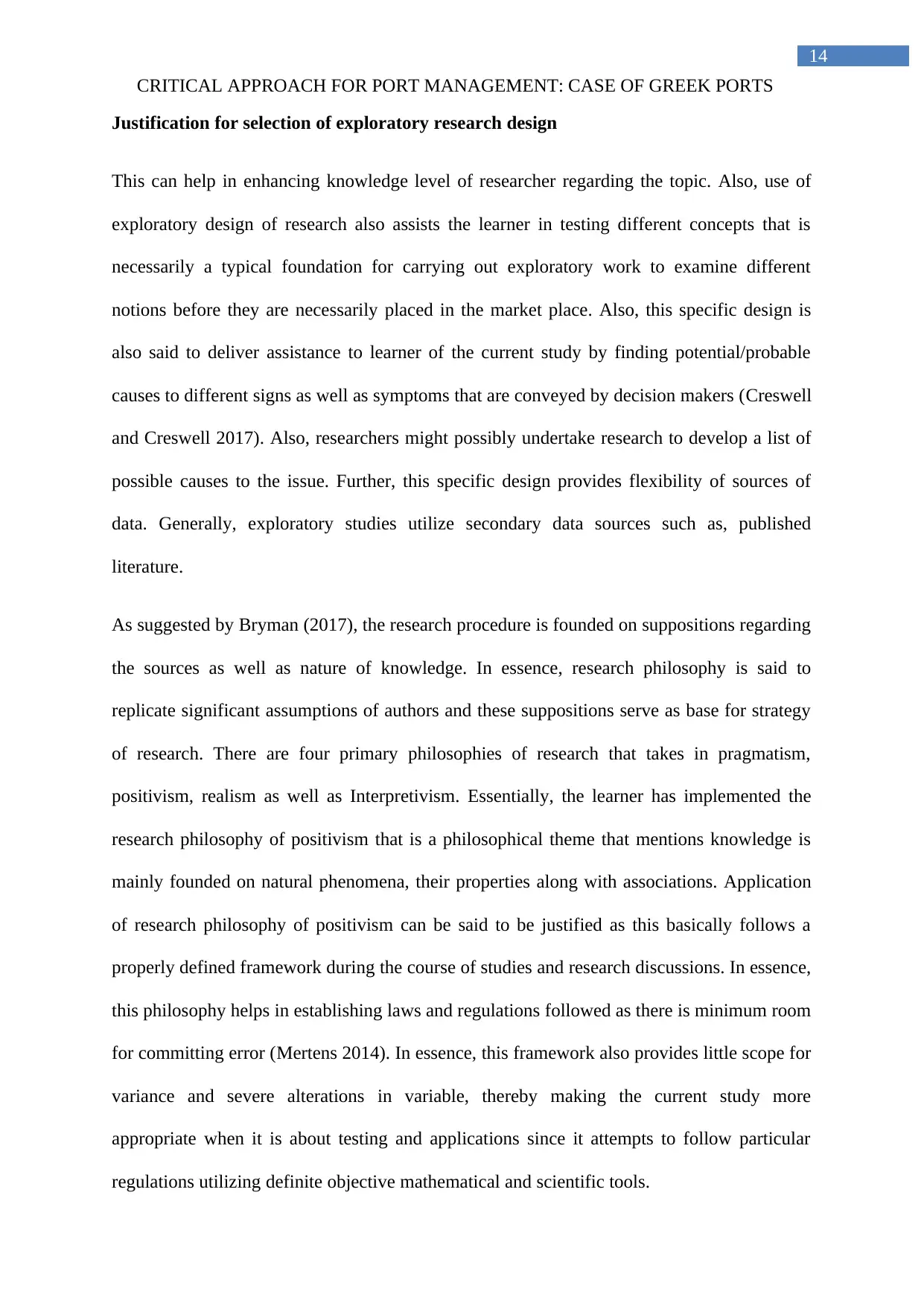
14
CRITICAL APPROACH FOR PORT MANAGEMENT: CASE OF GREEK PORTS
Justification for selection of exploratory research design
This can help in enhancing knowledge level of researcher regarding the topic. Also, use of
exploratory design of research also assists the learner in testing different concepts that is
necessarily a typical foundation for carrying out exploratory work to examine different
notions before they are necessarily placed in the market place. Also, this specific design is
also said to deliver assistance to learner of the current study by finding potential/probable
causes to different signs as well as symptoms that are conveyed by decision makers (Creswell
and Creswell 2017). Also, researchers might possibly undertake research to develop a list of
possible causes to the issue. Further, this specific design provides flexibility of sources of
data. Generally, exploratory studies utilize secondary data sources such as, published
literature.
As suggested by Bryman (2017), the research procedure is founded on suppositions regarding
the sources as well as nature of knowledge. In essence, research philosophy is said to
replicate significant assumptions of authors and these suppositions serve as base for strategy
of research. There are four primary philosophies of research that takes in pragmatism,
positivism, realism as well as Interpretivism. Essentially, the learner has implemented the
research philosophy of positivism that is a philosophical theme that mentions knowledge is
mainly founded on natural phenomena, their properties along with associations. Application
of research philosophy of positivism can be said to be justified as this basically follows a
properly defined framework during the course of studies and research discussions. In essence,
this philosophy helps in establishing laws and regulations followed as there is minimum room
for committing error (Mertens 2014). In essence, this framework also provides little scope for
variance and severe alterations in variable, thereby making the current study more
appropriate when it is about testing and applications since it attempts to follow particular
regulations utilizing definite objective mathematical and scientific tools.
CRITICAL APPROACH FOR PORT MANAGEMENT: CASE OF GREEK PORTS
Justification for selection of exploratory research design
This can help in enhancing knowledge level of researcher regarding the topic. Also, use of
exploratory design of research also assists the learner in testing different concepts that is
necessarily a typical foundation for carrying out exploratory work to examine different
notions before they are necessarily placed in the market place. Also, this specific design is
also said to deliver assistance to learner of the current study by finding potential/probable
causes to different signs as well as symptoms that are conveyed by decision makers (Creswell
and Creswell 2017). Also, researchers might possibly undertake research to develop a list of
possible causes to the issue. Further, this specific design provides flexibility of sources of
data. Generally, exploratory studies utilize secondary data sources such as, published
literature.
As suggested by Bryman (2017), the research procedure is founded on suppositions regarding
the sources as well as nature of knowledge. In essence, research philosophy is said to
replicate significant assumptions of authors and these suppositions serve as base for strategy
of research. There are four primary philosophies of research that takes in pragmatism,
positivism, realism as well as Interpretivism. Essentially, the learner has implemented the
research philosophy of positivism that is a philosophical theme that mentions knowledge is
mainly founded on natural phenomena, their properties along with associations. Application
of research philosophy of positivism can be said to be justified as this basically follows a
properly defined framework during the course of studies and research discussions. In essence,
this philosophy helps in establishing laws and regulations followed as there is minimum room
for committing error (Mertens 2014). In essence, this framework also provides little scope for
variance and severe alterations in variable, thereby making the current study more
appropriate when it is about testing and applications since it attempts to follow particular
regulations utilizing definite objective mathematical and scientific tools.

15
CRITICAL APPROACH FOR PORT MANAGEMENT: CASE OF GREEK PORTS
Figure 3: Research Philosophy
(Source: Creswell and Creswell 2017)
2.3 Research Methods
2.3.1 Mixed Methods:
A mixed method of research is particularly more specific in nature. This comprises of
combining mixing of qualitative as well as quantitative data, mechanisms, and specific
paradigms in a research. Mixed research method is a specific methodology for undertaking
research that entails collection, analysis as well as integration of quantitative (for example,
experiment study and surveys) and qualitative study (for example, focus groups as well as
interviews) research study (Silverman 2016). In essence, this research approach is utilized at
the time when this assimilation delivers a better comprehension of problem of research than
each of the case individually. As indicated by Walliman (2017), quantitative data takes in
close-ended information namely the ones found to measure attributes (that is to say, rating
scales), behaviours (namely, checklist of observations) and instruments of performance.
Essentially, evaluation of this kind of data comprises of statistically evaluating different
scores collected on diverse instruments (for example, questionnaires) or else checklists to
respond to different research questions or else to examine hypothesis (Bryman and Bell
2015).
CRITICAL APPROACH FOR PORT MANAGEMENT: CASE OF GREEK PORTS
Figure 3: Research Philosophy
(Source: Creswell and Creswell 2017)
2.3 Research Methods
2.3.1 Mixed Methods:
A mixed method of research is particularly more specific in nature. This comprises of
combining mixing of qualitative as well as quantitative data, mechanisms, and specific
paradigms in a research. Mixed research method is a specific methodology for undertaking
research that entails collection, analysis as well as integration of quantitative (for example,
experiment study and surveys) and qualitative study (for example, focus groups as well as
interviews) research study (Silverman 2016). In essence, this research approach is utilized at
the time when this assimilation delivers a better comprehension of problem of research than
each of the case individually. As indicated by Walliman (2017), quantitative data takes in
close-ended information namely the ones found to measure attributes (that is to say, rating
scales), behaviours (namely, checklist of observations) and instruments of performance.
Essentially, evaluation of this kind of data comprises of statistically evaluating different
scores collected on diverse instruments (for example, questionnaires) or else checklists to
respond to different research questions or else to examine hypothesis (Bryman and Bell
2015).
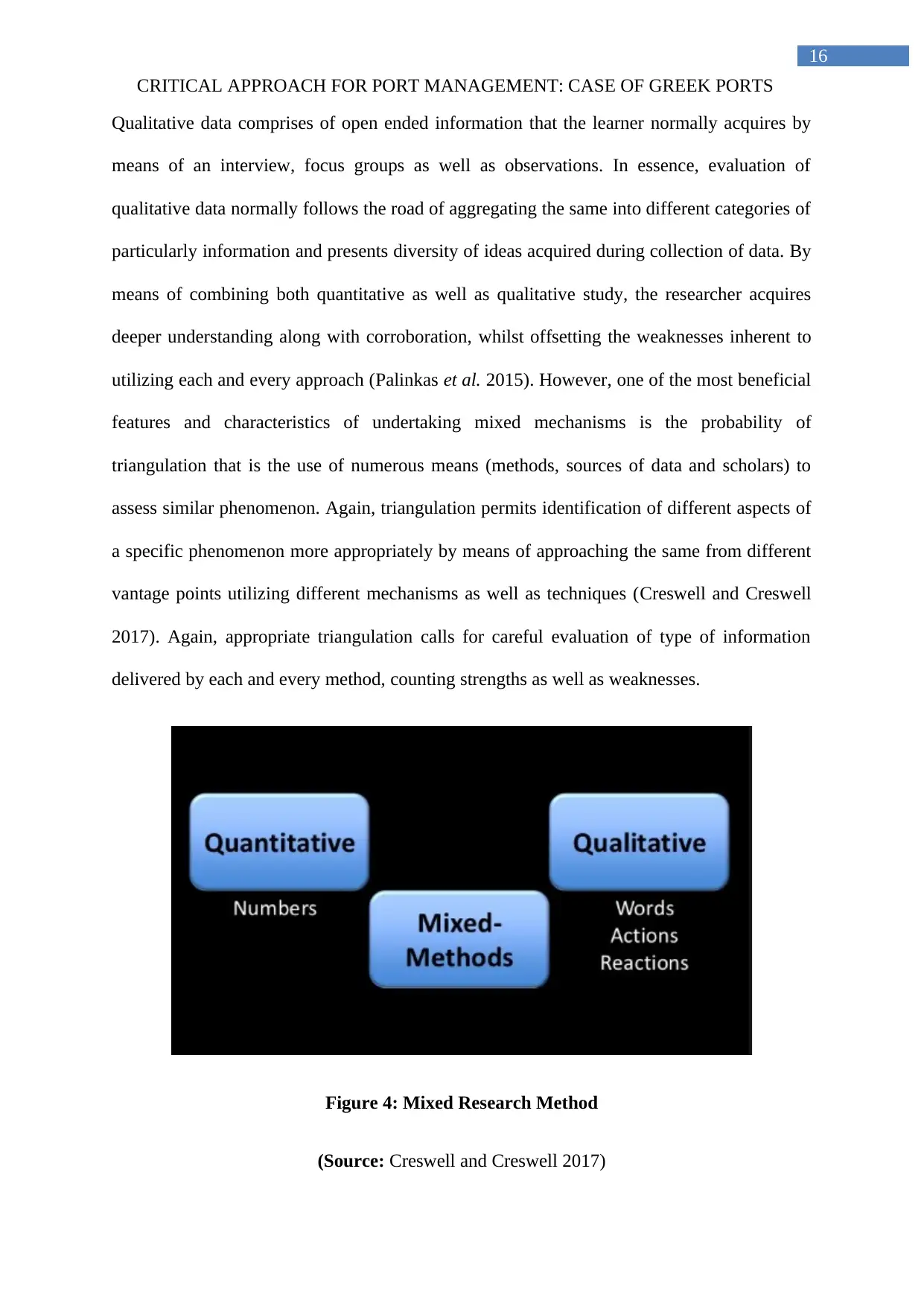
16
CRITICAL APPROACH FOR PORT MANAGEMENT: CASE OF GREEK PORTS
Qualitative data comprises of open ended information that the learner normally acquires by
means of an interview, focus groups as well as observations. In essence, evaluation of
qualitative data normally follows the road of aggregating the same into different categories of
particularly information and presents diversity of ideas acquired during collection of data. By
means of combining both quantitative as well as qualitative study, the researcher acquires
deeper understanding along with corroboration, whilst offsetting the weaknesses inherent to
utilizing each and every approach (Palinkas et al. 2015). However, one of the most beneficial
features and characteristics of undertaking mixed mechanisms is the probability of
triangulation that is the use of numerous means (methods, sources of data and scholars) to
assess similar phenomenon. Again, triangulation permits identification of different aspects of
a specific phenomenon more appropriately by means of approaching the same from different
vantage points utilizing different mechanisms as well as techniques (Creswell and Creswell
2017). Again, appropriate triangulation calls for careful evaluation of type of information
delivered by each and every method, counting strengths as well as weaknesses.
Figure 4: Mixed Research Method
(Source: Creswell and Creswell 2017)
CRITICAL APPROACH FOR PORT MANAGEMENT: CASE OF GREEK PORTS
Qualitative data comprises of open ended information that the learner normally acquires by
means of an interview, focus groups as well as observations. In essence, evaluation of
qualitative data normally follows the road of aggregating the same into different categories of
particularly information and presents diversity of ideas acquired during collection of data. By
means of combining both quantitative as well as qualitative study, the researcher acquires
deeper understanding along with corroboration, whilst offsetting the weaknesses inherent to
utilizing each and every approach (Palinkas et al. 2015). However, one of the most beneficial
features and characteristics of undertaking mixed mechanisms is the probability of
triangulation that is the use of numerous means (methods, sources of data and scholars) to
assess similar phenomenon. Again, triangulation permits identification of different aspects of
a specific phenomenon more appropriately by means of approaching the same from different
vantage points utilizing different mechanisms as well as techniques (Creswell and Creswell
2017). Again, appropriate triangulation calls for careful evaluation of type of information
delivered by each and every method, counting strengths as well as weaknesses.
Figure 4: Mixed Research Method
(Source: Creswell and Creswell 2017)
Paraphrase This Document
Need a fresh take? Get an instant paraphrase of this document with our AI Paraphraser
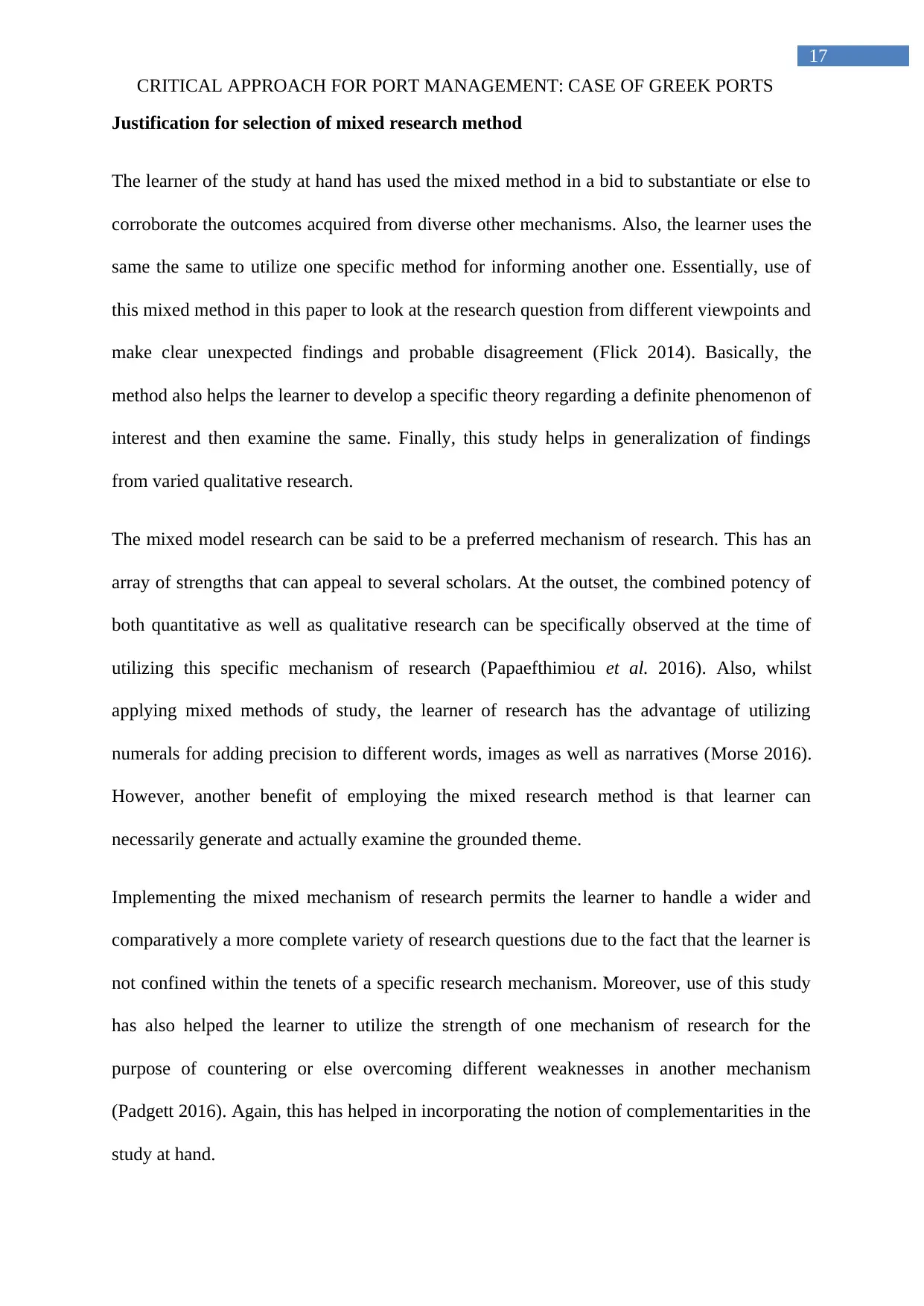
17
CRITICAL APPROACH FOR PORT MANAGEMENT: CASE OF GREEK PORTS
Justification for selection of mixed research method
The learner of the study at hand has used the mixed method in a bid to substantiate or else to
corroborate the outcomes acquired from diverse other mechanisms. Also, the learner uses the
same the same to utilize one specific method for informing another one. Essentially, use of
this mixed method in this paper to look at the research question from different viewpoints and
make clear unexpected findings and probable disagreement (Flick 2014). Basically, the
method also helps the learner to develop a specific theory regarding a definite phenomenon of
interest and then examine the same. Finally, this study helps in generalization of findings
from varied qualitative research.
The mixed model research can be said to be a preferred mechanism of research. This has an
array of strengths that can appeal to several scholars. At the outset, the combined potency of
both quantitative as well as qualitative research can be specifically observed at the time of
utilizing this specific mechanism of research (Papaefthimiou et al. 2016). Also, whilst
applying mixed methods of study, the learner of research has the advantage of utilizing
numerals for adding precision to different words, images as well as narratives (Morse 2016).
However, another benefit of employing the mixed research method is that learner can
necessarily generate and actually examine the grounded theme.
Implementing the mixed mechanism of research permits the learner to handle a wider and
comparatively a more complete variety of research questions due to the fact that the learner is
not confined within the tenets of a specific research mechanism. Moreover, use of this study
has also helped the learner to utilize the strength of one mechanism of research for the
purpose of countering or else overcoming different weaknesses in another mechanism
(Padgett 2016). Again, this has helped in incorporating the notion of complementarities in the
study at hand.
CRITICAL APPROACH FOR PORT MANAGEMENT: CASE OF GREEK PORTS
Justification for selection of mixed research method
The learner of the study at hand has used the mixed method in a bid to substantiate or else to
corroborate the outcomes acquired from diverse other mechanisms. Also, the learner uses the
same the same to utilize one specific method for informing another one. Essentially, use of
this mixed method in this paper to look at the research question from different viewpoints and
make clear unexpected findings and probable disagreement (Flick 2014). Basically, the
method also helps the learner to develop a specific theory regarding a definite phenomenon of
interest and then examine the same. Finally, this study helps in generalization of findings
from varied qualitative research.
The mixed model research can be said to be a preferred mechanism of research. This has an
array of strengths that can appeal to several scholars. At the outset, the combined potency of
both quantitative as well as qualitative research can be specifically observed at the time of
utilizing this specific mechanism of research (Papaefthimiou et al. 2016). Also, whilst
applying mixed methods of study, the learner of research has the advantage of utilizing
numerals for adding precision to different words, images as well as narratives (Morse 2016).
However, another benefit of employing the mixed research method is that learner can
necessarily generate and actually examine the grounded theme.
Implementing the mixed mechanism of research permits the learner to handle a wider and
comparatively a more complete variety of research questions due to the fact that the learner is
not confined within the tenets of a specific research mechanism. Moreover, use of this study
has also helped the learner to utilize the strength of one mechanism of research for the
purpose of countering or else overcoming different weaknesses in another mechanism
(Padgett 2016). Again, this has helped in incorporating the notion of complementarities in the
study at hand.
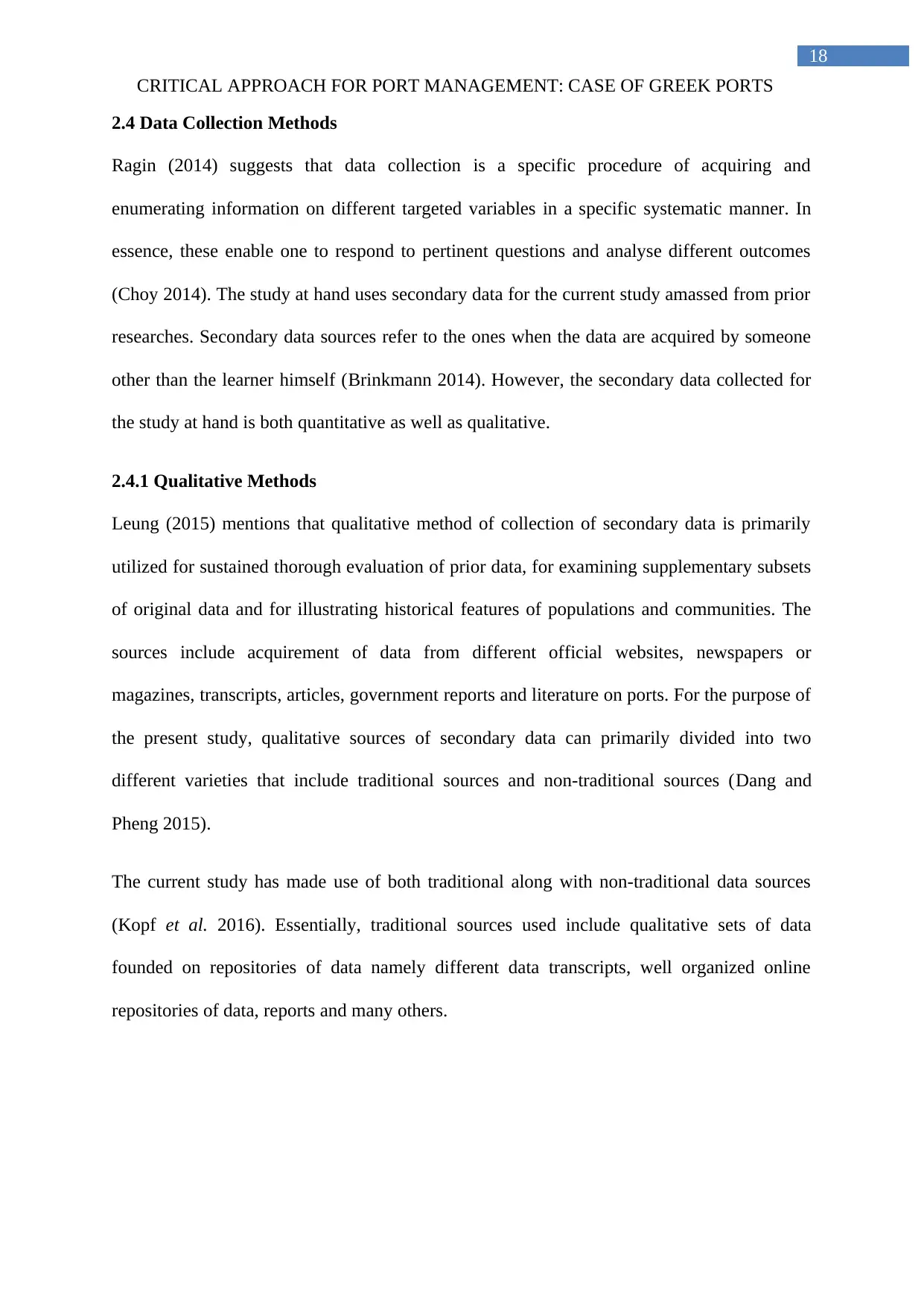
18
CRITICAL APPROACH FOR PORT MANAGEMENT: CASE OF GREEK PORTS
2.4 Data Collection Methods
Ragin (2014) suggests that data collection is a specific procedure of acquiring and
enumerating information on different targeted variables in a specific systematic manner. In
essence, these enable one to respond to pertinent questions and analyse different outcomes
(Choy 2014). The study at hand uses secondary data for the current study amassed from prior
researches. Secondary data sources refer to the ones when the data are acquired by someone
other than the learner himself (Brinkmann 2014). However, the secondary data collected for
the study at hand is both quantitative as well as qualitative.
2.4.1 Qualitative Methods
Leung (2015) mentions that qualitative method of collection of secondary data is primarily
utilized for sustained thorough evaluation of prior data, for examining supplementary subsets
of original data and for illustrating historical features of populations and communities. The
sources include acquirement of data from different official websites, newspapers or
magazines, transcripts, articles, government reports and literature on ports. For the purpose of
the present study, qualitative sources of secondary data can primarily divided into two
different varieties that include traditional sources and non-traditional sources (Dang and
Pheng 2015).
The current study has made use of both traditional along with non-traditional data sources
(Kopf et al. 2016). Essentially, traditional sources used include qualitative sets of data
founded on repositories of data namely different data transcripts, well organized online
repositories of data, reports and many others.
CRITICAL APPROACH FOR PORT MANAGEMENT: CASE OF GREEK PORTS
2.4 Data Collection Methods
Ragin (2014) suggests that data collection is a specific procedure of acquiring and
enumerating information on different targeted variables in a specific systematic manner. In
essence, these enable one to respond to pertinent questions and analyse different outcomes
(Choy 2014). The study at hand uses secondary data for the current study amassed from prior
researches. Secondary data sources refer to the ones when the data are acquired by someone
other than the learner himself (Brinkmann 2014). However, the secondary data collected for
the study at hand is both quantitative as well as qualitative.
2.4.1 Qualitative Methods
Leung (2015) mentions that qualitative method of collection of secondary data is primarily
utilized for sustained thorough evaluation of prior data, for examining supplementary subsets
of original data and for illustrating historical features of populations and communities. The
sources include acquirement of data from different official websites, newspapers or
magazines, transcripts, articles, government reports and literature on ports. For the purpose of
the present study, qualitative sources of secondary data can primarily divided into two
different varieties that include traditional sources and non-traditional sources (Dang and
Pheng 2015).
The current study has made use of both traditional along with non-traditional data sources
(Kopf et al. 2016). Essentially, traditional sources used include qualitative sets of data
founded on repositories of data namely different data transcripts, well organized online
repositories of data, reports and many others.
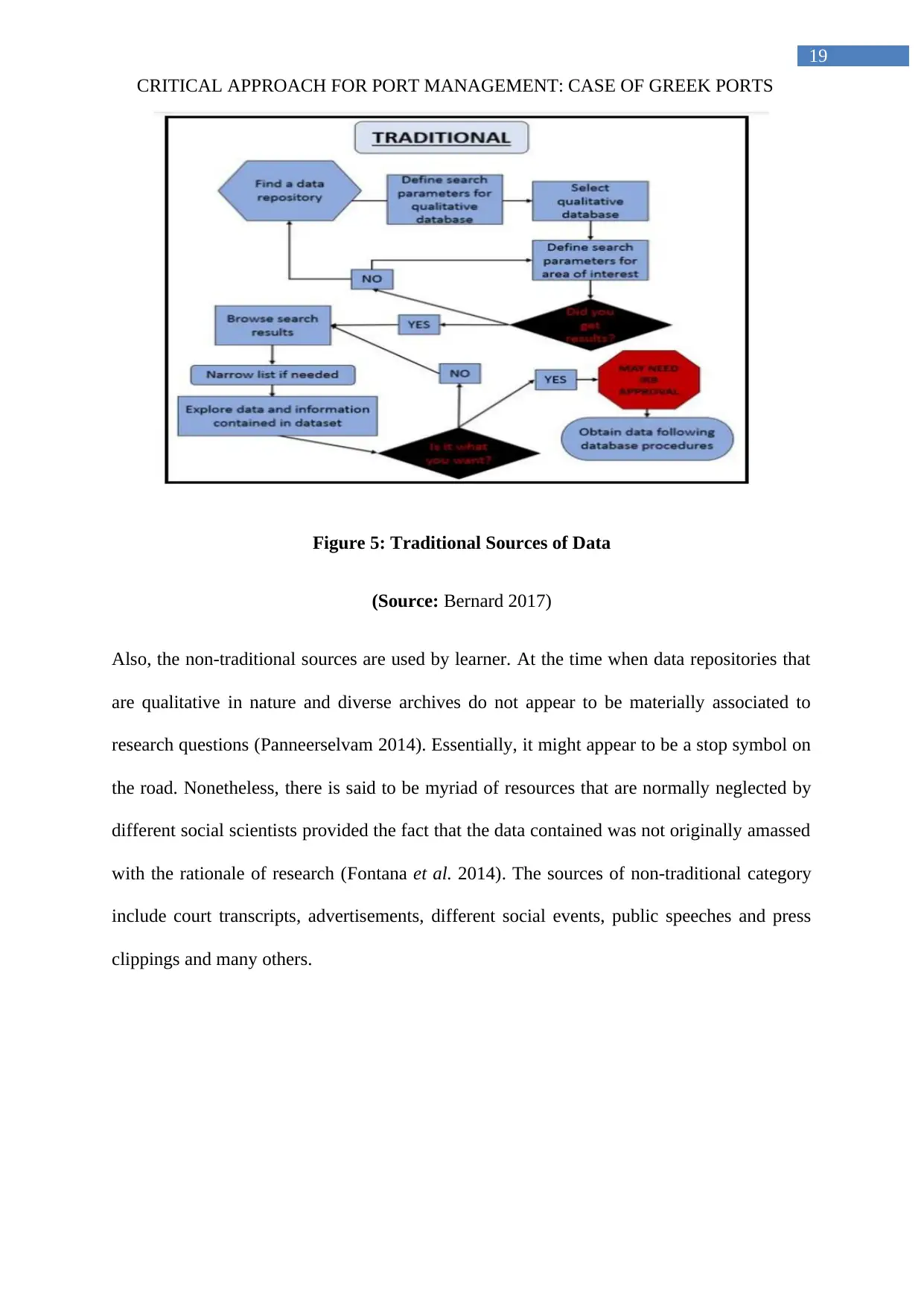
19
CRITICAL APPROACH FOR PORT MANAGEMENT: CASE OF GREEK PORTS
Figure 5: Traditional Sources of Data
(Source: Bernard 2017)
Also, the non-traditional sources are used by learner. At the time when data repositories that
are qualitative in nature and diverse archives do not appear to be materially associated to
research questions (Panneerselvam 2014). Essentially, it might appear to be a stop symbol on
the road. Nonetheless, there is said to be myriad of resources that are normally neglected by
different social scientists provided the fact that the data contained was not originally amassed
with the rationale of research (Fontana et al. 2014). The sources of non-traditional category
include court transcripts, advertisements, different social events, public speeches and press
clippings and many others.
CRITICAL APPROACH FOR PORT MANAGEMENT: CASE OF GREEK PORTS
Figure 5: Traditional Sources of Data
(Source: Bernard 2017)
Also, the non-traditional sources are used by learner. At the time when data repositories that
are qualitative in nature and diverse archives do not appear to be materially associated to
research questions (Panneerselvam 2014). Essentially, it might appear to be a stop symbol on
the road. Nonetheless, there is said to be myriad of resources that are normally neglected by
different social scientists provided the fact that the data contained was not originally amassed
with the rationale of research (Fontana et al. 2014). The sources of non-traditional category
include court transcripts, advertisements, different social events, public speeches and press
clippings and many others.
Secure Best Marks with AI Grader
Need help grading? Try our AI Grader for instant feedback on your assignments.

20
CRITICAL APPROACH FOR PORT MANAGEMENT: CASE OF GREEK PORTS
Figure 6: Non-Traditional Data Sources
(Sources: Anne et al. 2015)
The learner has used secondary qualitative data for the research study at hand as this helps in
saving time where rich data can be acquired from secondary researches. Also, the data sets
used can aid in comparing sets of data, generalisation of present research. This also delivers
the learner accessibility to unreachable else wise sensitive population where otherwise
acquiring access to the population might be tricky (Dutra et al. 2015). In addition to this,
secondary analysis lessens overall strain on vulnerable population and there is no interaction
is carried out with population of study. Particularly, the learner has necessarily used two prior
cases along and extensive academic sources for evaluating varied themes on the subject
matter under consideration.
2.4.2 Quantitative Methods
As suggested by Ensslin et al. (2017), quantitative data that are secondary in nature is easily
available and therefore calls for less amount of time to acquire all the pertinent information.
CRITICAL APPROACH FOR PORT MANAGEMENT: CASE OF GREEK PORTS
Figure 6: Non-Traditional Data Sources
(Sources: Anne et al. 2015)
The learner has used secondary qualitative data for the research study at hand as this helps in
saving time where rich data can be acquired from secondary researches. Also, the data sets
used can aid in comparing sets of data, generalisation of present research. This also delivers
the learner accessibility to unreachable else wise sensitive population where otherwise
acquiring access to the population might be tricky (Dutra et al. 2015). In addition to this,
secondary analysis lessens overall strain on vulnerable population and there is no interaction
is carried out with population of study. Particularly, the learner has necessarily used two prior
cases along and extensive academic sources for evaluating varied themes on the subject
matter under consideration.
2.4.2 Quantitative Methods
As suggested by Ensslin et al. (2017), quantitative data that are secondary in nature is easily
available and therefore calls for less amount of time to acquire all the pertinent information.
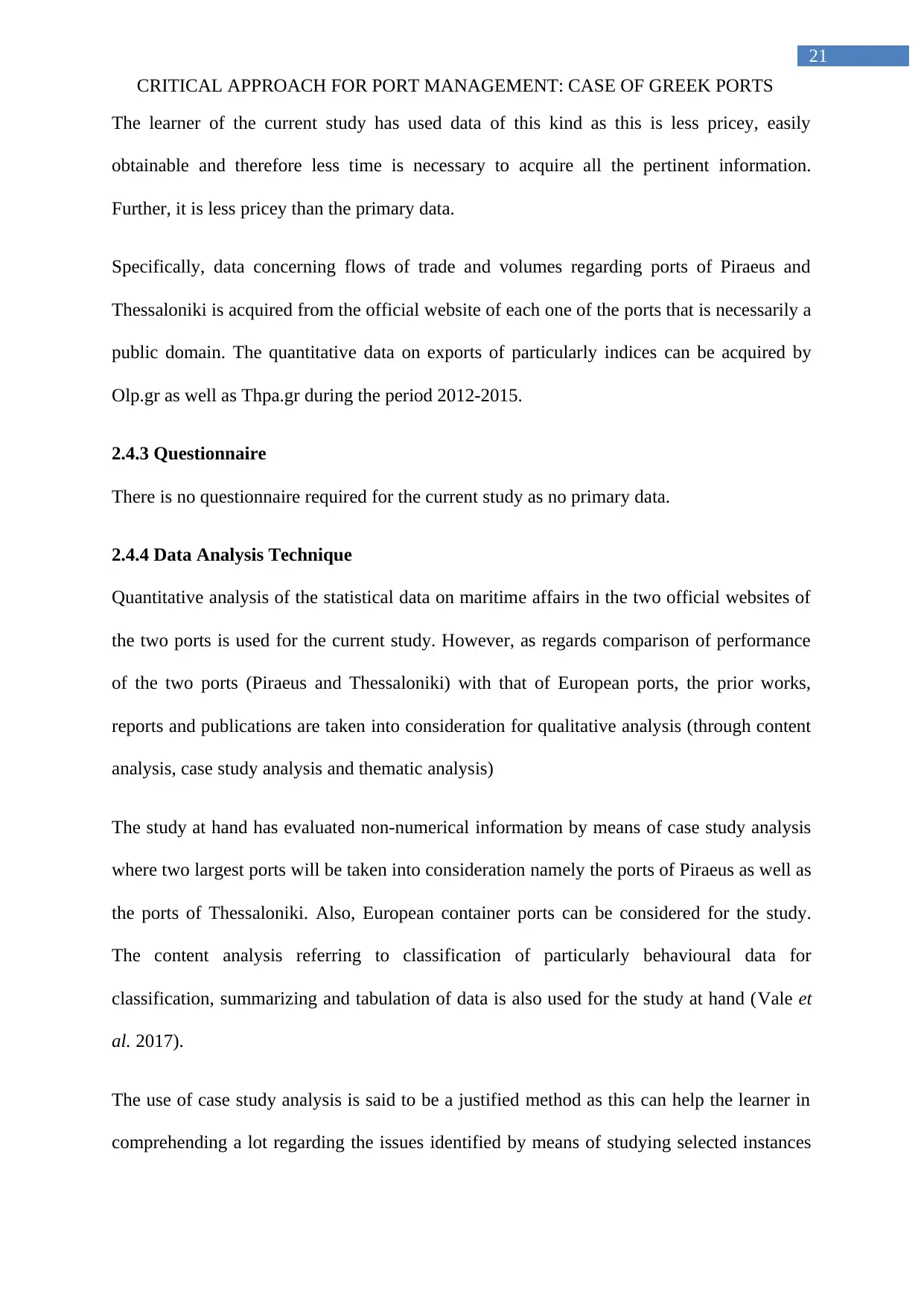
21
CRITICAL APPROACH FOR PORT MANAGEMENT: CASE OF GREEK PORTS
The learner of the current study has used data of this kind as this is less pricey, easily
obtainable and therefore less time is necessary to acquire all the pertinent information.
Further, it is less pricey than the primary data.
Specifically, data concerning flows of trade and volumes regarding ports of Piraeus and
Thessaloniki is acquired from the official website of each one of the ports that is necessarily a
public domain. The quantitative data on exports of particularly indices can be acquired by
Olp.gr as well as Thpa.gr during the period 2012-2015.
2.4.3 Questionnaire
There is no questionnaire required for the current study as no primary data.
2.4.4 Data Analysis Technique
Quantitative analysis of the statistical data on maritime affairs in the two official websites of
the two ports is used for the current study. However, as regards comparison of performance
of the two ports (Piraeus and Thessaloniki) with that of European ports, the prior works,
reports and publications are taken into consideration for qualitative analysis (through content
analysis, case study analysis and thematic analysis)
The study at hand has evaluated non-numerical information by means of case study analysis
where two largest ports will be taken into consideration namely the ports of Piraeus as well as
the ports of Thessaloniki. Also, European container ports can be considered for the study.
The content analysis referring to classification of particularly behavioural data for
classification, summarizing and tabulation of data is also used for the study at hand (Vale et
al. 2017).
The use of case study analysis is said to be a justified method as this can help the learner in
comprehending a lot regarding the issues identified by means of studying selected instances
CRITICAL APPROACH FOR PORT MANAGEMENT: CASE OF GREEK PORTS
The learner of the current study has used data of this kind as this is less pricey, easily
obtainable and therefore less time is necessary to acquire all the pertinent information.
Further, it is less pricey than the primary data.
Specifically, data concerning flows of trade and volumes regarding ports of Piraeus and
Thessaloniki is acquired from the official website of each one of the ports that is necessarily a
public domain. The quantitative data on exports of particularly indices can be acquired by
Olp.gr as well as Thpa.gr during the period 2012-2015.
2.4.3 Questionnaire
There is no questionnaire required for the current study as no primary data.
2.4.4 Data Analysis Technique
Quantitative analysis of the statistical data on maritime affairs in the two official websites of
the two ports is used for the current study. However, as regards comparison of performance
of the two ports (Piraeus and Thessaloniki) with that of European ports, the prior works,
reports and publications are taken into consideration for qualitative analysis (through content
analysis, case study analysis and thematic analysis)
The study at hand has evaluated non-numerical information by means of case study analysis
where two largest ports will be taken into consideration namely the ports of Piraeus as well as
the ports of Thessaloniki. Also, European container ports can be considered for the study.
The content analysis referring to classification of particularly behavioural data for
classification, summarizing and tabulation of data is also used for the study at hand (Vale et
al. 2017).
The use of case study analysis is said to be a justified method as this can help the learner in
comprehending a lot regarding the issues identified by means of studying selected instances
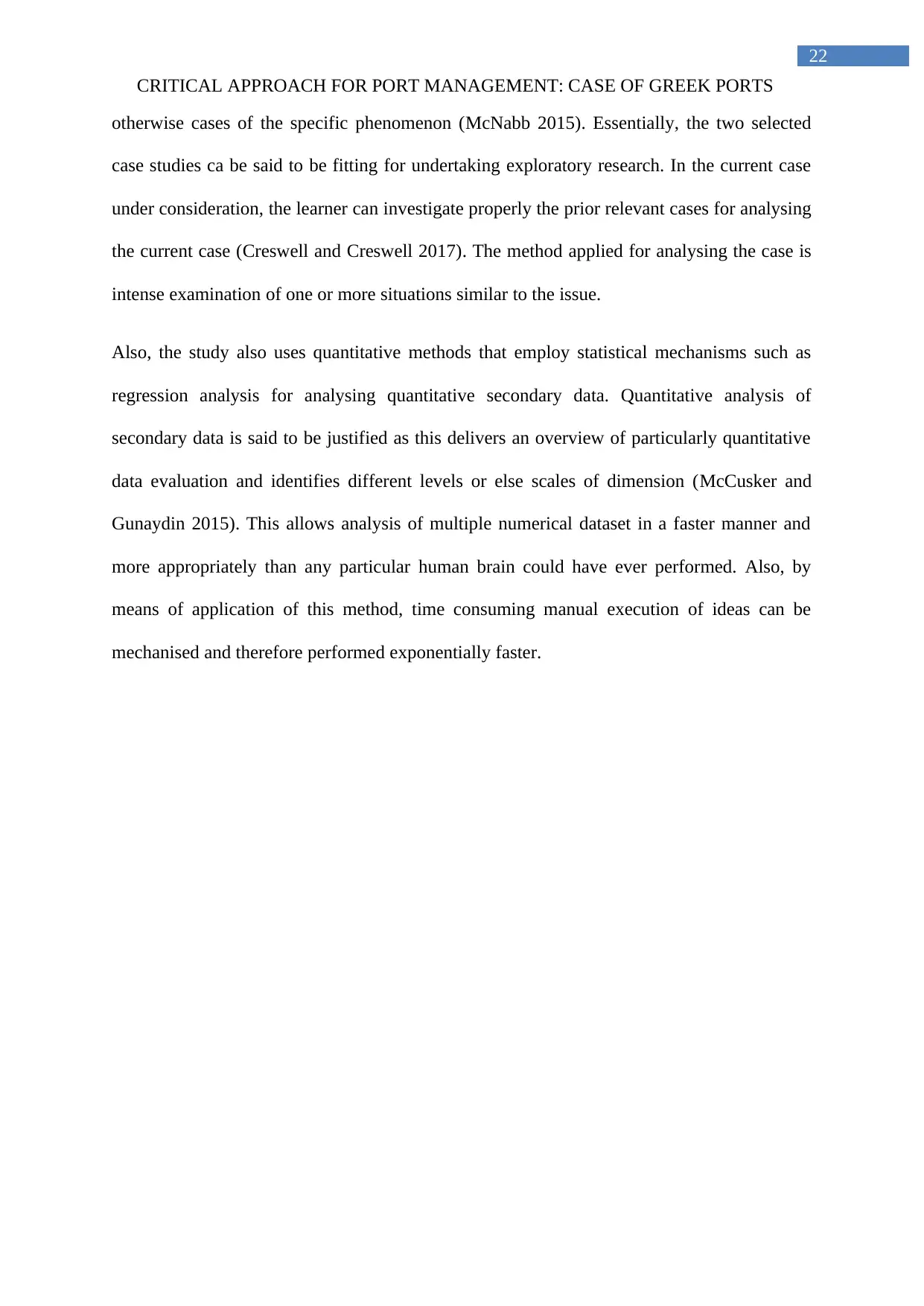
22
CRITICAL APPROACH FOR PORT MANAGEMENT: CASE OF GREEK PORTS
otherwise cases of the specific phenomenon (McNabb 2015). Essentially, the two selected
case studies ca be said to be fitting for undertaking exploratory research. In the current case
under consideration, the learner can investigate properly the prior relevant cases for analysing
the current case (Creswell and Creswell 2017). The method applied for analysing the case is
intense examination of one or more situations similar to the issue.
Also, the study also uses quantitative methods that employ statistical mechanisms such as
regression analysis for analysing quantitative secondary data. Quantitative analysis of
secondary data is said to be justified as this delivers an overview of particularly quantitative
data evaluation and identifies different levels or else scales of dimension (McCusker and
Gunaydin 2015). This allows analysis of multiple numerical dataset in a faster manner and
more appropriately than any particular human brain could have ever performed. Also, by
means of application of this method, time consuming manual execution of ideas can be
mechanised and therefore performed exponentially faster.
CRITICAL APPROACH FOR PORT MANAGEMENT: CASE OF GREEK PORTS
otherwise cases of the specific phenomenon (McNabb 2015). Essentially, the two selected
case studies ca be said to be fitting for undertaking exploratory research. In the current case
under consideration, the learner can investigate properly the prior relevant cases for analysing
the current case (Creswell and Creswell 2017). The method applied for analysing the case is
intense examination of one or more situations similar to the issue.
Also, the study also uses quantitative methods that employ statistical mechanisms such as
regression analysis for analysing quantitative secondary data. Quantitative analysis of
secondary data is said to be justified as this delivers an overview of particularly quantitative
data evaluation and identifies different levels or else scales of dimension (McCusker and
Gunaydin 2015). This allows analysis of multiple numerical dataset in a faster manner and
more appropriately than any particular human brain could have ever performed. Also, by
means of application of this method, time consuming manual execution of ideas can be
mechanised and therefore performed exponentially faster.
Paraphrase This Document
Need a fresh take? Get an instant paraphrase of this document with our AI Paraphraser
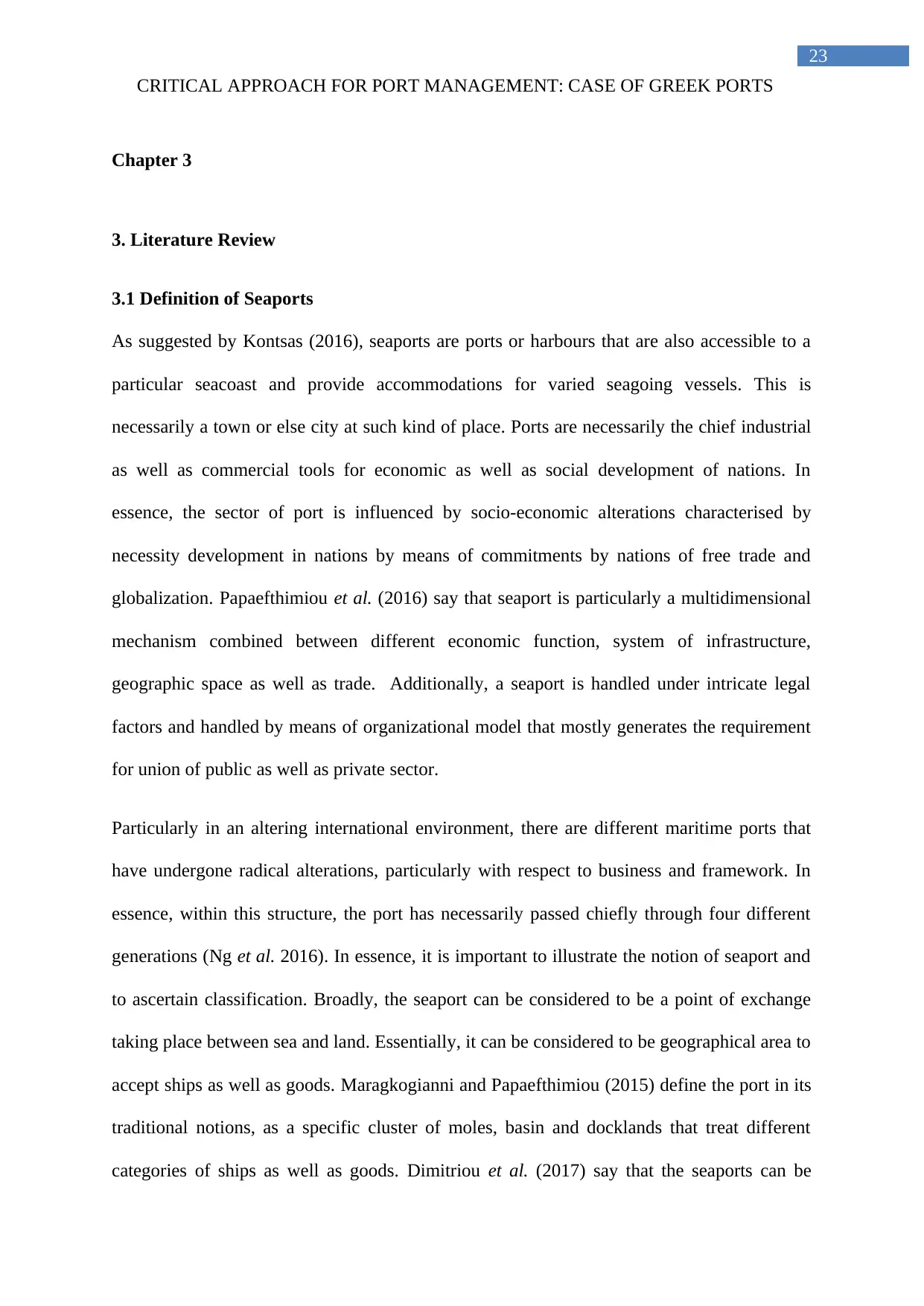
23
CRITICAL APPROACH FOR PORT MANAGEMENT: CASE OF GREEK PORTS
Chapter 3
3. Literature Review
3.1 Definition of Seaports
As suggested by Kontsas (2016), seaports are ports or harbours that are also accessible to a
particular seacoast and provide accommodations for varied seagoing vessels. This is
necessarily a town or else city at such kind of place. Ports are necessarily the chief industrial
as well as commercial tools for economic as well as social development of nations. In
essence, the sector of port is influenced by socio-economic alterations characterised by
necessity development in nations by means of commitments by nations of free trade and
globalization. Papaefthimiou et al. (2016) say that seaport is particularly a multidimensional
mechanism combined between different economic function, system of infrastructure,
geographic space as well as trade. Additionally, a seaport is handled under intricate legal
factors and handled by means of organizational model that mostly generates the requirement
for union of public as well as private sector.
Particularly in an altering international environment, there are different maritime ports that
have undergone radical alterations, particularly with respect to business and framework. In
essence, within this structure, the port has necessarily passed chiefly through four different
generations (Ng et al. 2016). In essence, it is important to illustrate the notion of seaport and
to ascertain classification. Broadly, the seaport can be considered to be a point of exchange
taking place between sea and land. Essentially, it can be considered to be geographical area to
accept ships as well as goods. Maragkogianni and Papaefthimiou (2015) define the port in its
traditional notions, as a specific cluster of moles, basin and docklands that treat different
categories of ships as well as goods. Dimitriou et al. (2017) say that the seaports can be
CRITICAL APPROACH FOR PORT MANAGEMENT: CASE OF GREEK PORTS
Chapter 3
3. Literature Review
3.1 Definition of Seaports
As suggested by Kontsas (2016), seaports are ports or harbours that are also accessible to a
particular seacoast and provide accommodations for varied seagoing vessels. This is
necessarily a town or else city at such kind of place. Ports are necessarily the chief industrial
as well as commercial tools for economic as well as social development of nations. In
essence, the sector of port is influenced by socio-economic alterations characterised by
necessity development in nations by means of commitments by nations of free trade and
globalization. Papaefthimiou et al. (2016) say that seaport is particularly a multidimensional
mechanism combined between different economic function, system of infrastructure,
geographic space as well as trade. Additionally, a seaport is handled under intricate legal
factors and handled by means of organizational model that mostly generates the requirement
for union of public as well as private sector.
Particularly in an altering international environment, there are different maritime ports that
have undergone radical alterations, particularly with respect to business and framework. In
essence, within this structure, the port has necessarily passed chiefly through four different
generations (Ng et al. 2016). In essence, it is important to illustrate the notion of seaport and
to ascertain classification. Broadly, the seaport can be considered to be a point of exchange
taking place between sea and land. Essentially, it can be considered to be geographical area to
accept ships as well as goods. Maragkogianni and Papaefthimiou (2015) define the port in its
traditional notions, as a specific cluster of moles, basin and docklands that treat different
categories of ships as well as goods. Dimitriou et al. (2017) say that the seaports can be

24
CRITICAL APPROACH FOR PORT MANAGEMENT: CASE OF GREEK PORTS
illustrated as per different approaches namely economic, institutional, geographical and
lawful factors.
3.2 Port Development
The current segment investigates trends present in existing literature on development of port
and associated issues stemming from the trends towards present developments in a port. In
essence, strategy of port development, regionalisation, terminalisation and development of
port system can be regarded as the general notions that are indicated in literature of port
logistics (Li et al. 2015).
As indicated by Gagatsi et al. (2014), ports as a business comprise of a combination of
industry as well as services that address novel challenges inflicted by present segment with
the outcome such that the port merchandise has undergone a huge alteration. The alteration of
the port merchandise can be measured as the outcome of alterations in different production
procedures along with technological improvement. Furthermore, another alteration, in the
character of particularly the ports that is obligatory is privatisation. As ports form connection
to the common trade chain, their level of productivity can be regarded to be a serious facet for
each and every state to attain a competitive gain over several other states (Lee and Lee 2016).
Basically, the engagement of particularly the private segment in mainly the ownership,
administration as well as role of ports can aid port establishment to enhance overall
functional efficacies. Dalaklis et al. (2014) say that the competitiveness in mainly the
transport segment and the requirement for continuous refuelling of different consumers as
well as businesses generates huge pressure on costs of management port plus margins. As
correctly mentioned by Mantalis et al. (2015), development of particularly worldwide supply
chain can help ion driving the ports along with business concerns to reconsider their mode of
operations.
CRITICAL APPROACH FOR PORT MANAGEMENT: CASE OF GREEK PORTS
illustrated as per different approaches namely economic, institutional, geographical and
lawful factors.
3.2 Port Development
The current segment investigates trends present in existing literature on development of port
and associated issues stemming from the trends towards present developments in a port. In
essence, strategy of port development, regionalisation, terminalisation and development of
port system can be regarded as the general notions that are indicated in literature of port
logistics (Li et al. 2015).
As indicated by Gagatsi et al. (2014), ports as a business comprise of a combination of
industry as well as services that address novel challenges inflicted by present segment with
the outcome such that the port merchandise has undergone a huge alteration. The alteration of
the port merchandise can be measured as the outcome of alterations in different production
procedures along with technological improvement. Furthermore, another alteration, in the
character of particularly the ports that is obligatory is privatisation. As ports form connection
to the common trade chain, their level of productivity can be regarded to be a serious facet for
each and every state to attain a competitive gain over several other states (Lee and Lee 2016).
Basically, the engagement of particularly the private segment in mainly the ownership,
administration as well as role of ports can aid port establishment to enhance overall
functional efficacies. Dalaklis et al. (2014) say that the competitiveness in mainly the
transport segment and the requirement for continuous refuelling of different consumers as
well as businesses generates huge pressure on costs of management port plus margins. As
correctly mentioned by Mantalis et al. (2015), development of particularly worldwide supply
chain can help ion driving the ports along with business concerns to reconsider their mode of
operations.
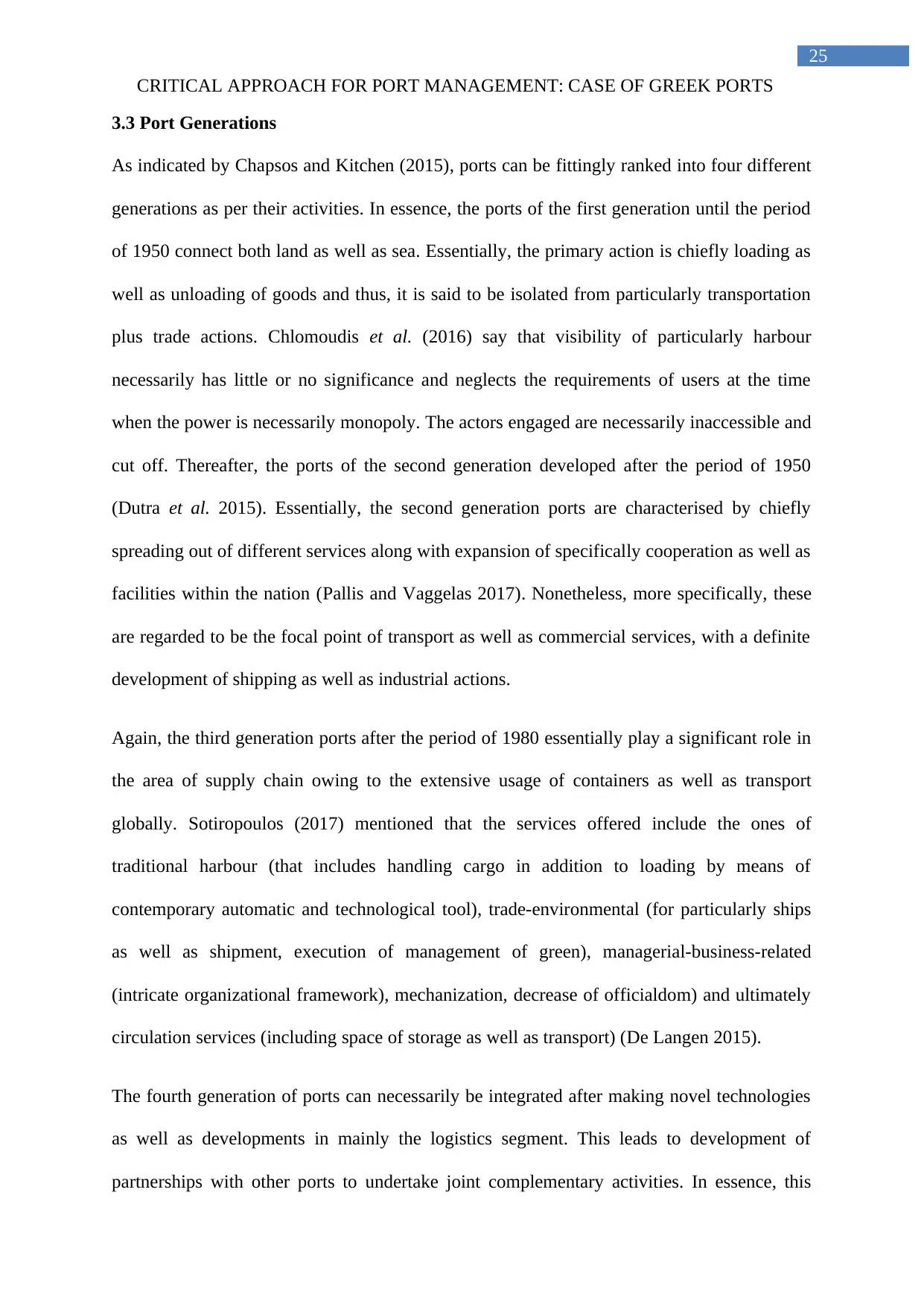
25
CRITICAL APPROACH FOR PORT MANAGEMENT: CASE OF GREEK PORTS
3.3 Port Generations
As indicated by Chapsos and Kitchen (2015), ports can be fittingly ranked into four different
generations as per their activities. In essence, the ports of the first generation until the period
of 1950 connect both land as well as sea. Essentially, the primary action is chiefly loading as
well as unloading of goods and thus, it is said to be isolated from particularly transportation
plus trade actions. Chlomoudis et al. (2016) say that visibility of particularly harbour
necessarily has little or no significance and neglects the requirements of users at the time
when the power is necessarily monopoly. The actors engaged are necessarily inaccessible and
cut off. Thereafter, the ports of the second generation developed after the period of 1950
(Dutra et al. 2015). Essentially, the second generation ports are characterised by chiefly
spreading out of different services along with expansion of specifically cooperation as well as
facilities within the nation (Pallis and Vaggelas 2017). Nonetheless, more specifically, these
are regarded to be the focal point of transport as well as commercial services, with a definite
development of shipping as well as industrial actions.
Again, the third generation ports after the period of 1980 essentially play a significant role in
the area of supply chain owing to the extensive usage of containers as well as transport
globally. Sotiropoulos (2017) mentioned that the services offered include the ones of
traditional harbour (that includes handling cargo in addition to loading by means of
contemporary automatic and technological tool), trade-environmental (for particularly ships
as well as shipment, execution of management of green), managerial-business-related
(intricate organizational framework), mechanization, decrease of officialdom) and ultimately
circulation services (including space of storage as well as transport) (De Langen 2015).
The fourth generation of ports can necessarily be integrated after making novel technologies
as well as developments in mainly the logistics segment. This leads to development of
partnerships with other ports to undertake joint complementary activities. In essence, this
CRITICAL APPROACH FOR PORT MANAGEMENT: CASE OF GREEK PORTS
3.3 Port Generations
As indicated by Chapsos and Kitchen (2015), ports can be fittingly ranked into four different
generations as per their activities. In essence, the ports of the first generation until the period
of 1950 connect both land as well as sea. Essentially, the primary action is chiefly loading as
well as unloading of goods and thus, it is said to be isolated from particularly transportation
plus trade actions. Chlomoudis et al. (2016) say that visibility of particularly harbour
necessarily has little or no significance and neglects the requirements of users at the time
when the power is necessarily monopoly. The actors engaged are necessarily inaccessible and
cut off. Thereafter, the ports of the second generation developed after the period of 1950
(Dutra et al. 2015). Essentially, the second generation ports are characterised by chiefly
spreading out of different services along with expansion of specifically cooperation as well as
facilities within the nation (Pallis and Vaggelas 2017). Nonetheless, more specifically, these
are regarded to be the focal point of transport as well as commercial services, with a definite
development of shipping as well as industrial actions.
Again, the third generation ports after the period of 1980 essentially play a significant role in
the area of supply chain owing to the extensive usage of containers as well as transport
globally. Sotiropoulos (2017) mentioned that the services offered include the ones of
traditional harbour (that includes handling cargo in addition to loading by means of
contemporary automatic and technological tool), trade-environmental (for particularly ships
as well as shipment, execution of management of green), managerial-business-related
(intricate organizational framework), mechanization, decrease of officialdom) and ultimately
circulation services (including space of storage as well as transport) (De Langen 2015).
The fourth generation of ports can necessarily be integrated after making novel technologies
as well as developments in mainly the logistics segment. This leads to development of
partnerships with other ports to undertake joint complementary activities. In essence, this
Secure Best Marks with AI Grader
Need help grading? Try our AI Grader for instant feedback on your assignments.

26
CRITICAL APPROACH FOR PORT MANAGEMENT: CASE OF GREEK PORTS
generation also reflects port communities (Mantalis et al. 2015). In essence, basic
prerequisites for the ports can be considered to be complete mechanization of terminal
functions and their functions as parts of assimilated systems of supply chain.
3.4 Port Ownership
During the period 2016, majority of port authorities particularly in Europe are publicly
owned. Complete ownership by the state or else by the municipality remains prime. As such,
very few port authorities merge and unite ownership of different levels of government.
Kontsas (2016) asserts that mixed public private partnership can be said to be limited.
However, authorities of port listed under the stock exchange remain the exception during the
period 2016. However, entirely private ownership in which the port authority is entirely
owned by private parties. In essence, there are no other fully private ports from other nations
in the sample of respondent ports (Dimitriou et al. 2017). The ownership image necessarily
did not alter considerably since the period of 2010, in spite of financial and economic crisis
and pressure on budgets of member states (Papaefthimiou et al. 2016). The seaports of EU
also assume different path than airports of EU that undergo a clear trend towards more
private ownership. Ownership of port authorities of EU stands at 87% public ownership, 7%
mixed ownership and 6% private ownership. Again, in terms of level of public control there
is 59% state ownership, 33% municipality ownership, 5% combined ownership and 3%
province or else other government level ownership (Lee et al. 2016).
As far as port authorities are concerned, almost roughly half of the total number of
respondents of port authorities entirely or partly owns the land that they hold (Davarzani et
al. 2016). However, for the other half of authorities of the port that does not have possession
of the land, a lawful structure exists that gives the right to port authorities to handle the land
for port on behalf of owners (Maragkogianni and Papaefthimiou 2015). Fundamentally, this
lawful framework varies from nation to nation. For instance, these kinds of arrangements
CRITICAL APPROACH FOR PORT MANAGEMENT: CASE OF GREEK PORTS
generation also reflects port communities (Mantalis et al. 2015). In essence, basic
prerequisites for the ports can be considered to be complete mechanization of terminal
functions and their functions as parts of assimilated systems of supply chain.
3.4 Port Ownership
During the period 2016, majority of port authorities particularly in Europe are publicly
owned. Complete ownership by the state or else by the municipality remains prime. As such,
very few port authorities merge and unite ownership of different levels of government.
Kontsas (2016) asserts that mixed public private partnership can be said to be limited.
However, authorities of port listed under the stock exchange remain the exception during the
period 2016. However, entirely private ownership in which the port authority is entirely
owned by private parties. In essence, there are no other fully private ports from other nations
in the sample of respondent ports (Dimitriou et al. 2017). The ownership image necessarily
did not alter considerably since the period of 2010, in spite of financial and economic crisis
and pressure on budgets of member states (Papaefthimiou et al. 2016). The seaports of EU
also assume different path than airports of EU that undergo a clear trend towards more
private ownership. Ownership of port authorities of EU stands at 87% public ownership, 7%
mixed ownership and 6% private ownership. Again, in terms of level of public control there
is 59% state ownership, 33% municipality ownership, 5% combined ownership and 3%
province or else other government level ownership (Lee et al. 2016).
As far as port authorities are concerned, almost roughly half of the total number of
respondents of port authorities entirely or partly owns the land that they hold (Davarzani et
al. 2016). However, for the other half of authorities of the port that does not have possession
of the land, a lawful structure exists that gives the right to port authorities to handle the land
for port on behalf of owners (Maragkogianni and Papaefthimiou 2015). Fundamentally, this
lawful framework varies from nation to nation. For instance, these kinds of arrangements
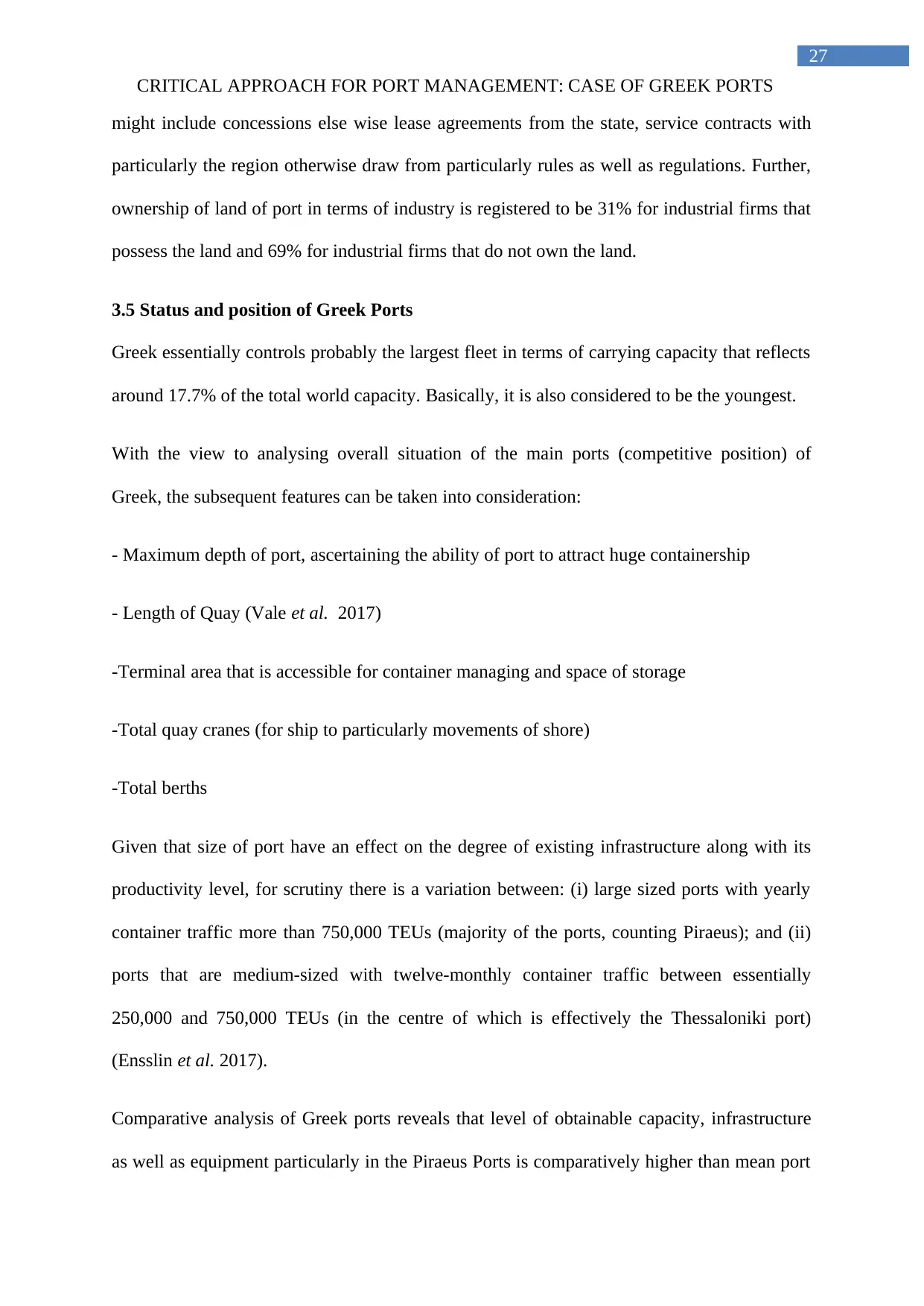
27
CRITICAL APPROACH FOR PORT MANAGEMENT: CASE OF GREEK PORTS
might include concessions else wise lease agreements from the state, service contracts with
particularly the region otherwise draw from particularly rules as well as regulations. Further,
ownership of land of port in terms of industry is registered to be 31% for industrial firms that
possess the land and 69% for industrial firms that do not own the land.
3.5 Status and position of Greek Ports
Greek essentially controls probably the largest fleet in terms of carrying capacity that reflects
around 17.7% of the total world capacity. Basically, it is also considered to be the youngest.
With the view to analysing overall situation of the main ports (competitive position) of
Greek, the subsequent features can be taken into consideration:
- Maximum depth of port, ascertaining the ability of port to attract huge containership
- Length of Quay (Vale et al. 2017)
-Terminal area that is accessible for container managing and space of storage
-Total quay cranes (for ship to particularly movements of shore)
-Total berths
Given that size of port have an effect on the degree of existing infrastructure along with its
productivity level, for scrutiny there is a variation between: (i) large sized ports with yearly
container traffic more than 750,000 TEUs (majority of the ports, counting Piraeus); and (ii)
ports that are medium-sized with twelve-monthly container traffic between essentially
250,000 and 750,000 TEUs (in the centre of which is effectively the Thessaloniki port)
(Ensslin et al. 2017).
Comparative analysis of Greek ports reveals that level of obtainable capacity, infrastructure
as well as equipment particularly in the Piraeus Ports is comparatively higher than mean port
CRITICAL APPROACH FOR PORT MANAGEMENT: CASE OF GREEK PORTS
might include concessions else wise lease agreements from the state, service contracts with
particularly the region otherwise draw from particularly rules as well as regulations. Further,
ownership of land of port in terms of industry is registered to be 31% for industrial firms that
possess the land and 69% for industrial firms that do not own the land.
3.5 Status and position of Greek Ports
Greek essentially controls probably the largest fleet in terms of carrying capacity that reflects
around 17.7% of the total world capacity. Basically, it is also considered to be the youngest.
With the view to analysing overall situation of the main ports (competitive position) of
Greek, the subsequent features can be taken into consideration:
- Maximum depth of port, ascertaining the ability of port to attract huge containership
- Length of Quay (Vale et al. 2017)
-Terminal area that is accessible for container managing and space of storage
-Total quay cranes (for ship to particularly movements of shore)
-Total berths
Given that size of port have an effect on the degree of existing infrastructure along with its
productivity level, for scrutiny there is a variation between: (i) large sized ports with yearly
container traffic more than 750,000 TEUs (majority of the ports, counting Piraeus); and (ii)
ports that are medium-sized with twelve-monthly container traffic between essentially
250,000 and 750,000 TEUs (in the centre of which is effectively the Thessaloniki port)
(Ensslin et al. 2017).
Comparative analysis of Greek ports reveals that level of obtainable capacity, infrastructure
as well as equipment particularly in the Piraeus Ports is comparatively higher than mean port
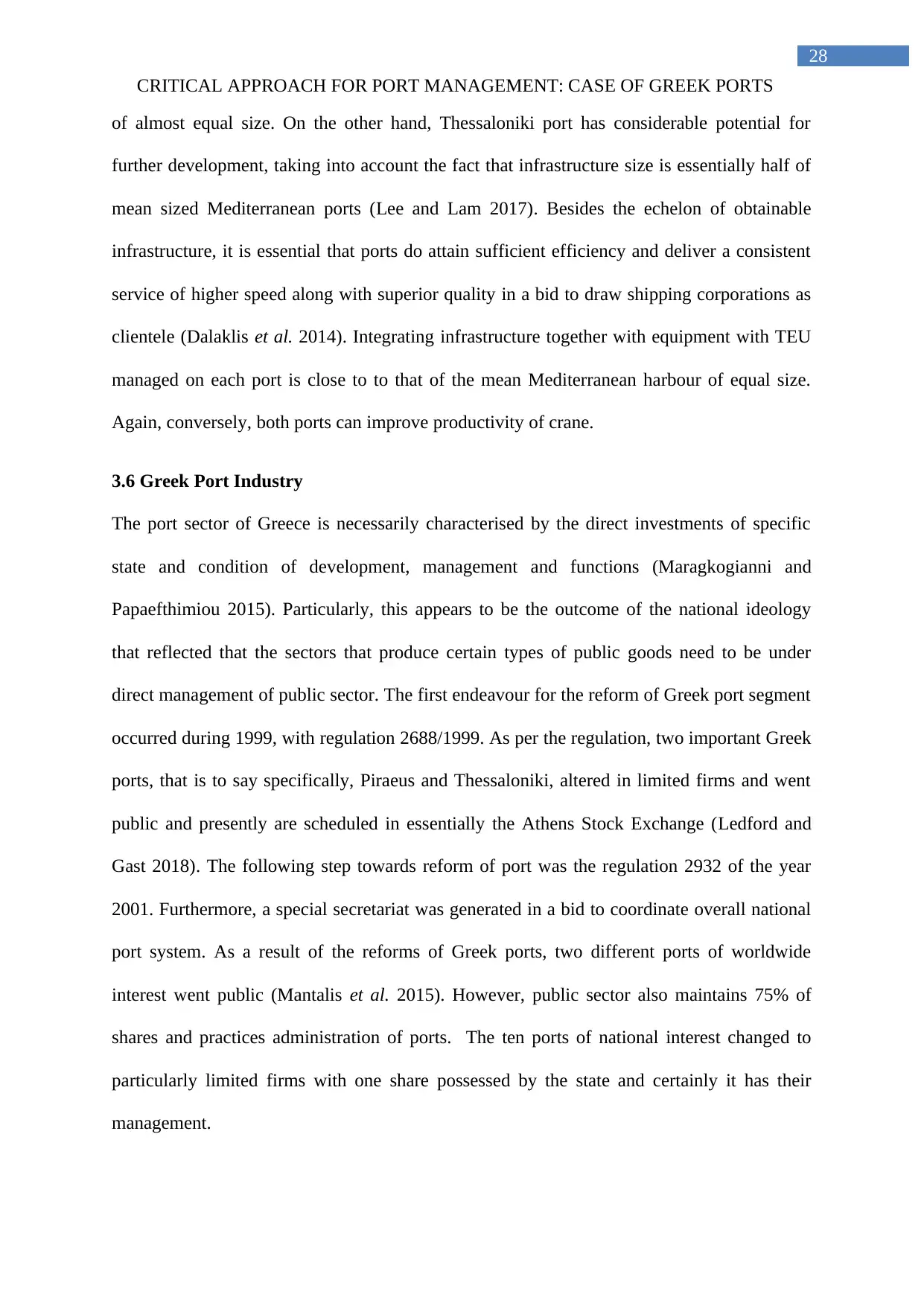
28
CRITICAL APPROACH FOR PORT MANAGEMENT: CASE OF GREEK PORTS
of almost equal size. On the other hand, Thessaloniki port has considerable potential for
further development, taking into account the fact that infrastructure size is essentially half of
mean sized Mediterranean ports (Lee and Lam 2017). Besides the echelon of obtainable
infrastructure, it is essential that ports do attain sufficient efficiency and deliver a consistent
service of higher speed along with superior quality in a bid to draw shipping corporations as
clientele (Dalaklis et al. 2014). Integrating infrastructure together with equipment with TEU
managed on each port is close to to that of the mean Mediterranean harbour of equal size.
Again, conversely, both ports can improve productivity of crane.
3.6 Greek Port Industry
The port sector of Greece is necessarily characterised by the direct investments of specific
state and condition of development, management and functions (Maragkogianni and
Papaefthimiou 2015). Particularly, this appears to be the outcome of the national ideology
that reflected that the sectors that produce certain types of public goods need to be under
direct management of public sector. The first endeavour for the reform of Greek port segment
occurred during 1999, with regulation 2688/1999. As per the regulation, two important Greek
ports, that is to say specifically, Piraeus and Thessaloniki, altered in limited firms and went
public and presently are scheduled in essentially the Athens Stock Exchange (Ledford and
Gast 2018). The following step towards reform of port was the regulation 2932 of the year
2001. Furthermore, a special secretariat was generated in a bid to coordinate overall national
port system. As a result of the reforms of Greek ports, two different ports of worldwide
interest went public (Mantalis et al. 2015). However, public sector also maintains 75% of
shares and practices administration of ports. The ten ports of national interest changed to
particularly limited firms with one share possessed by the state and certainly it has their
management.
CRITICAL APPROACH FOR PORT MANAGEMENT: CASE OF GREEK PORTS
of almost equal size. On the other hand, Thessaloniki port has considerable potential for
further development, taking into account the fact that infrastructure size is essentially half of
mean sized Mediterranean ports (Lee and Lam 2017). Besides the echelon of obtainable
infrastructure, it is essential that ports do attain sufficient efficiency and deliver a consistent
service of higher speed along with superior quality in a bid to draw shipping corporations as
clientele (Dalaklis et al. 2014). Integrating infrastructure together with equipment with TEU
managed on each port is close to to that of the mean Mediterranean harbour of equal size.
Again, conversely, both ports can improve productivity of crane.
3.6 Greek Port Industry
The port sector of Greece is necessarily characterised by the direct investments of specific
state and condition of development, management and functions (Maragkogianni and
Papaefthimiou 2015). Particularly, this appears to be the outcome of the national ideology
that reflected that the sectors that produce certain types of public goods need to be under
direct management of public sector. The first endeavour for the reform of Greek port segment
occurred during 1999, with regulation 2688/1999. As per the regulation, two important Greek
ports, that is to say specifically, Piraeus and Thessaloniki, altered in limited firms and went
public and presently are scheduled in essentially the Athens Stock Exchange (Ledford and
Gast 2018). The following step towards reform of port was the regulation 2932 of the year
2001. Furthermore, a special secretariat was generated in a bid to coordinate overall national
port system. As a result of the reforms of Greek ports, two different ports of worldwide
interest went public (Mantalis et al. 2015). However, public sector also maintains 75% of
shares and practices administration of ports. The ten ports of national interest changed to
particularly limited firms with one share possessed by the state and certainly it has their
management.
Paraphrase This Document
Need a fresh take? Get an instant paraphrase of this document with our AI Paraphraser
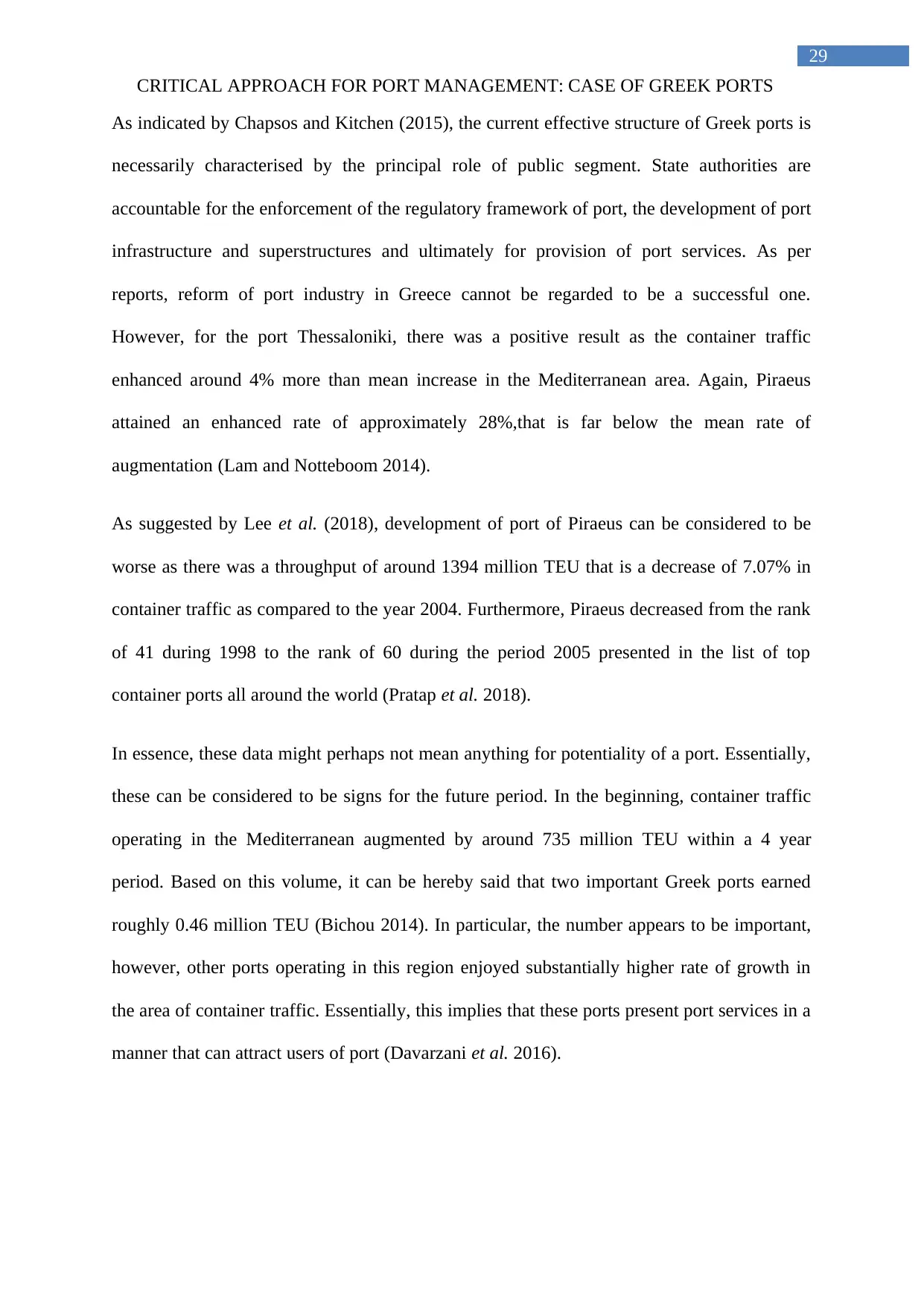
29
CRITICAL APPROACH FOR PORT MANAGEMENT: CASE OF GREEK PORTS
As indicated by Chapsos and Kitchen (2015), the current effective structure of Greek ports is
necessarily characterised by the principal role of public segment. State authorities are
accountable for the enforcement of the regulatory framework of port, the development of port
infrastructure and superstructures and ultimately for provision of port services. As per
reports, reform of port industry in Greece cannot be regarded to be a successful one.
However, for the port Thessaloniki, there was a positive result as the container traffic
enhanced around 4% more than mean increase in the Mediterranean area. Again, Piraeus
attained an enhanced rate of approximately 28%,that is far below the mean rate of
augmentation (Lam and Notteboom 2014).
As suggested by Lee et al. (2018), development of port of Piraeus can be considered to be
worse as there was a throughput of around 1394 million TEU that is a decrease of 7.07% in
container traffic as compared to the year 2004. Furthermore, Piraeus decreased from the rank
of 41 during 1998 to the rank of 60 during the period 2005 presented in the list of top
container ports all around the world (Pratap et al. 2018).
In essence, these data might perhaps not mean anything for potentiality of a port. Essentially,
these can be considered to be signs for the future period. In the beginning, container traffic
operating in the Mediterranean augmented by around 735 million TEU within a 4 year
period. Based on this volume, it can be hereby said that two important Greek ports earned
roughly 0.46 million TEU (Bichou 2014). In particular, the number appears to be important,
however, other ports operating in this region enjoyed substantially higher rate of growth in
the area of container traffic. Essentially, this implies that these ports present port services in a
manner that can attract users of port (Davarzani et al. 2016).
CRITICAL APPROACH FOR PORT MANAGEMENT: CASE OF GREEK PORTS
As indicated by Chapsos and Kitchen (2015), the current effective structure of Greek ports is
necessarily characterised by the principal role of public segment. State authorities are
accountable for the enforcement of the regulatory framework of port, the development of port
infrastructure and superstructures and ultimately for provision of port services. As per
reports, reform of port industry in Greece cannot be regarded to be a successful one.
However, for the port Thessaloniki, there was a positive result as the container traffic
enhanced around 4% more than mean increase in the Mediterranean area. Again, Piraeus
attained an enhanced rate of approximately 28%,that is far below the mean rate of
augmentation (Lam and Notteboom 2014).
As suggested by Lee et al. (2018), development of port of Piraeus can be considered to be
worse as there was a throughput of around 1394 million TEU that is a decrease of 7.07% in
container traffic as compared to the year 2004. Furthermore, Piraeus decreased from the rank
of 41 during 1998 to the rank of 60 during the period 2005 presented in the list of top
container ports all around the world (Pratap et al. 2018).
In essence, these data might perhaps not mean anything for potentiality of a port. Essentially,
these can be considered to be signs for the future period. In the beginning, container traffic
operating in the Mediterranean augmented by around 735 million TEU within a 4 year
period. Based on this volume, it can be hereby said that two important Greek ports earned
roughly 0.46 million TEU (Bichou 2014). In particular, the number appears to be important,
however, other ports operating in this region enjoyed substantially higher rate of growth in
the area of container traffic. Essentially, this implies that these ports present port services in a
manner that can attract users of port (Davarzani et al. 2016).
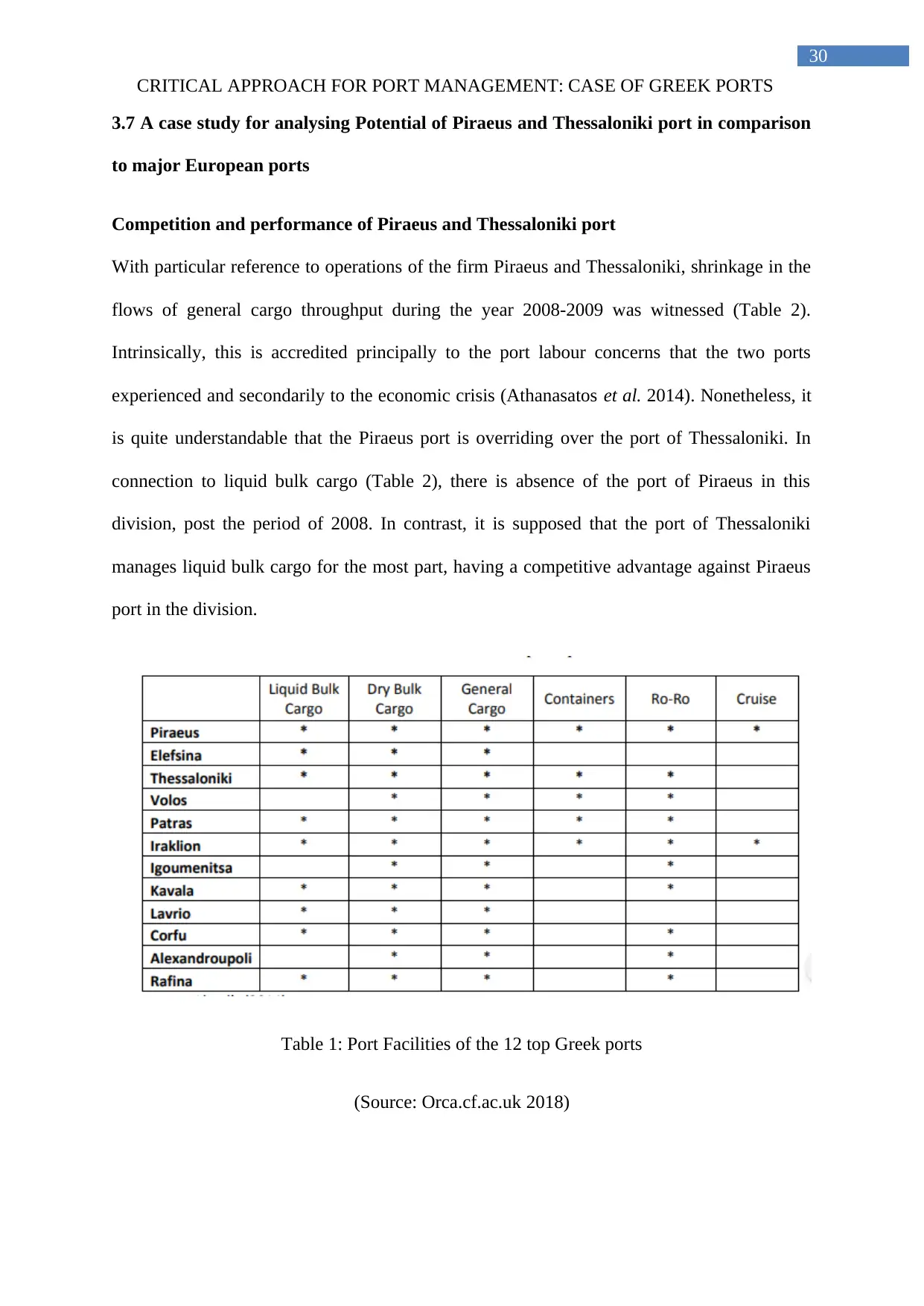
30
CRITICAL APPROACH FOR PORT MANAGEMENT: CASE OF GREEK PORTS
3.7 A case study for analysing Potential of Piraeus and Thessaloniki port in comparison
to major European ports
Competition and performance of Piraeus and Thessaloniki port
With particular reference to operations of the firm Piraeus and Thessaloniki, shrinkage in the
flows of general cargo throughput during the year 2008-2009 was witnessed (Table 2).
Intrinsically, this is accredited principally to the port labour concerns that the two ports
experienced and secondarily to the economic crisis (Athanasatos et al. 2014). Nonetheless, it
is quite understandable that the Piraeus port is overriding over the port of Thessaloniki. In
connection to liquid bulk cargo (Table 2), there is absence of the port of Piraeus in this
division, post the period of 2008. In contrast, it is supposed that the port of Thessaloniki
manages liquid bulk cargo for the most part, having a competitive advantage against Piraeus
port in the division.
Table 1: Port Facilities of the 12 top Greek ports
(Source: Orca.cf.ac.uk 2018)
CRITICAL APPROACH FOR PORT MANAGEMENT: CASE OF GREEK PORTS
3.7 A case study for analysing Potential of Piraeus and Thessaloniki port in comparison
to major European ports
Competition and performance of Piraeus and Thessaloniki port
With particular reference to operations of the firm Piraeus and Thessaloniki, shrinkage in the
flows of general cargo throughput during the year 2008-2009 was witnessed (Table 2).
Intrinsically, this is accredited principally to the port labour concerns that the two ports
experienced and secondarily to the economic crisis (Athanasatos et al. 2014). Nonetheless, it
is quite understandable that the Piraeus port is overriding over the port of Thessaloniki. In
connection to liquid bulk cargo (Table 2), there is absence of the port of Piraeus in this
division, post the period of 2008. In contrast, it is supposed that the port of Thessaloniki
manages liquid bulk cargo for the most part, having a competitive advantage against Piraeus
port in the division.
Table 1: Port Facilities of the 12 top Greek ports
(Source: Orca.cf.ac.uk 2018)

31
CRITICAL APPROACH FOR PORT MANAGEMENT: CASE OF GREEK PORTS
In terms of cargo by type, the Thessaloniki port can be considered to be more important than
the Piraeus port (Grew 2015). Essentially, the recessionary period that started during the
period 2008 and 2009 generated labour protests in the ports that again directed towards short-
term closing of the ports along with considerable shortfall of cargo throughput that affected
both of the ports immensely.
Table 2: Cargo By type
(Source: Orca.cf.ac.uk 2018)
Again, the prior research has identified the fact that with regard to Ro-Ro Traffic, the port of
Thessaloniki remains behind the port of Piraeus. In addition to this, labour unrest during the
period of 2008 and 2009 and thereafter, negatively affected overall throughput in different
ports and specifically the Piraeus port (de Langen and van der Lugt 2017). Nonetheless, the
latter is said to be regaining the lost market share.
CRITICAL APPROACH FOR PORT MANAGEMENT: CASE OF GREEK PORTS
In terms of cargo by type, the Thessaloniki port can be considered to be more important than
the Piraeus port (Grew 2015). Essentially, the recessionary period that started during the
period 2008 and 2009 generated labour protests in the ports that again directed towards short-
term closing of the ports along with considerable shortfall of cargo throughput that affected
both of the ports immensely.
Table 2: Cargo By type
(Source: Orca.cf.ac.uk 2018)
Again, the prior research has identified the fact that with regard to Ro-Ro Traffic, the port of
Thessaloniki remains behind the port of Piraeus. In addition to this, labour unrest during the
period of 2008 and 2009 and thereafter, negatively affected overall throughput in different
ports and specifically the Piraeus port (de Langen and van der Lugt 2017). Nonetheless, the
latter is said to be regaining the lost market share.
Secure Best Marks with AI Grader
Need help grading? Try our AI Grader for instant feedback on your assignments.
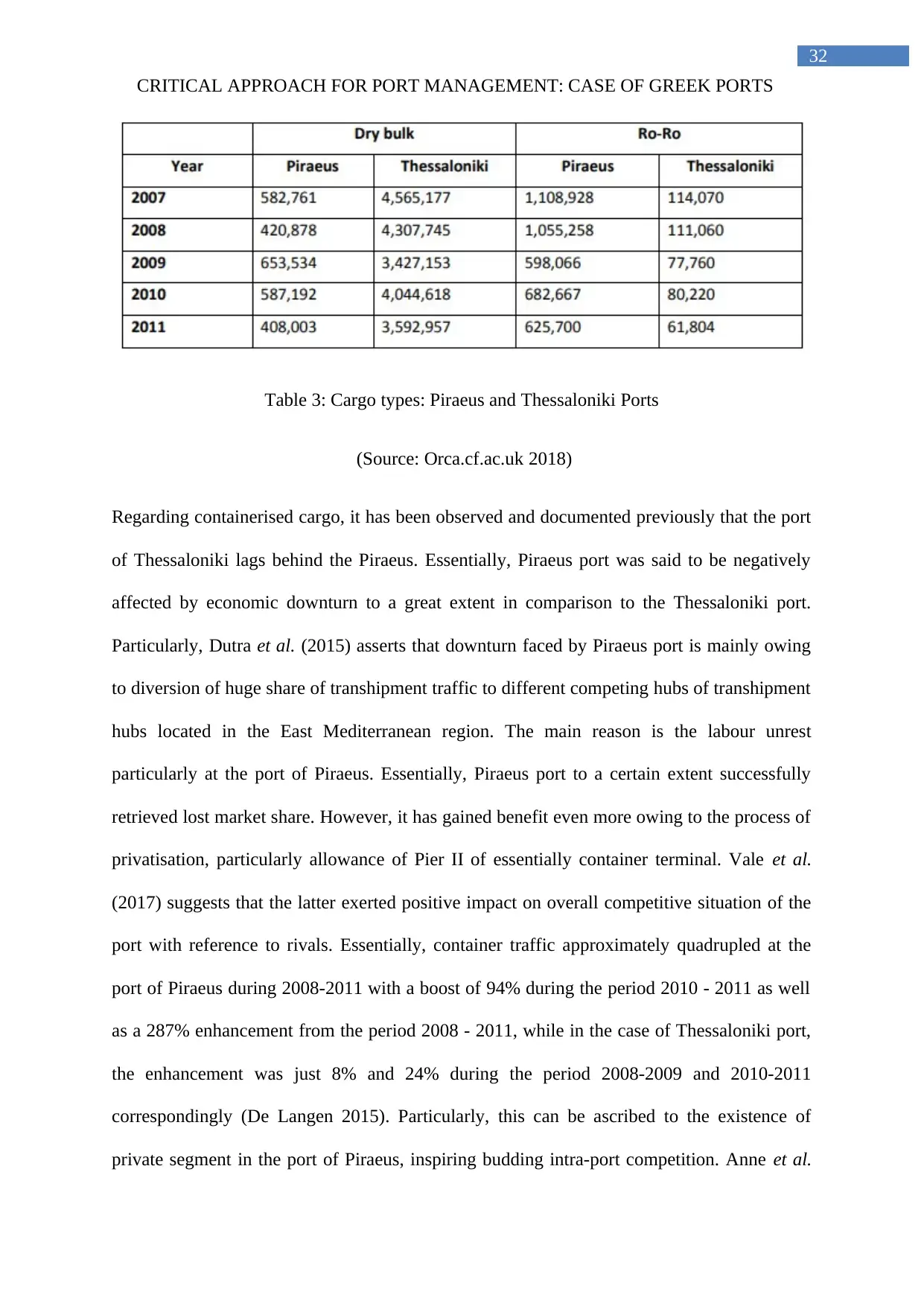
32
CRITICAL APPROACH FOR PORT MANAGEMENT: CASE OF GREEK PORTS
Table 3: Cargo types: Piraeus and Thessaloniki Ports
(Source: Orca.cf.ac.uk 2018)
Regarding containerised cargo, it has been observed and documented previously that the port
of Thessaloniki lags behind the Piraeus. Essentially, Piraeus port was said to be negatively
affected by economic downturn to a great extent in comparison to the Thessaloniki port.
Particularly, Dutra et al. (2015) asserts that downturn faced by Piraeus port is mainly owing
to diversion of huge share of transhipment traffic to different competing hubs of transhipment
hubs located in the East Mediterranean region. The main reason is the labour unrest
particularly at the port of Piraeus. Essentially, Piraeus port to a certain extent successfully
retrieved lost market share. However, it has gained benefit even more owing to the process of
privatisation, particularly allowance of Pier II of essentially container terminal. Vale et al.
(2017) suggests that the latter exerted positive impact on overall competitive situation of the
port with reference to rivals. Essentially, container traffic approximately quadrupled at the
port of Piraeus during 2008-2011 with a boost of 94% during the period 2010 - 2011 as well
as a 287% enhancement from the period 2008 - 2011, while in the case of Thessaloniki port,
the enhancement was just 8% and 24% during the period 2008-2009 and 2010-2011
correspondingly (De Langen 2015). Particularly, this can be ascribed to the existence of
private segment in the port of Piraeus, inspiring budding intra-port competition. Anne et al.
CRITICAL APPROACH FOR PORT MANAGEMENT: CASE OF GREEK PORTS
Table 3: Cargo types: Piraeus and Thessaloniki Ports
(Source: Orca.cf.ac.uk 2018)
Regarding containerised cargo, it has been observed and documented previously that the port
of Thessaloniki lags behind the Piraeus. Essentially, Piraeus port was said to be negatively
affected by economic downturn to a great extent in comparison to the Thessaloniki port.
Particularly, Dutra et al. (2015) asserts that downturn faced by Piraeus port is mainly owing
to diversion of huge share of transhipment traffic to different competing hubs of transhipment
hubs located in the East Mediterranean region. The main reason is the labour unrest
particularly at the port of Piraeus. Essentially, Piraeus port to a certain extent successfully
retrieved lost market share. However, it has gained benefit even more owing to the process of
privatisation, particularly allowance of Pier II of essentially container terminal. Vale et al.
(2017) suggests that the latter exerted positive impact on overall competitive situation of the
port with reference to rivals. Essentially, container traffic approximately quadrupled at the
port of Piraeus during 2008-2011 with a boost of 94% during the period 2010 - 2011 as well
as a 287% enhancement from the period 2008 - 2011, while in the case of Thessaloniki port,
the enhancement was just 8% and 24% during the period 2008-2009 and 2010-2011
correspondingly (De Langen 2015). Particularly, this can be ascribed to the existence of
private segment in the port of Piraeus, inspiring budding intra-port competition. Anne et al.
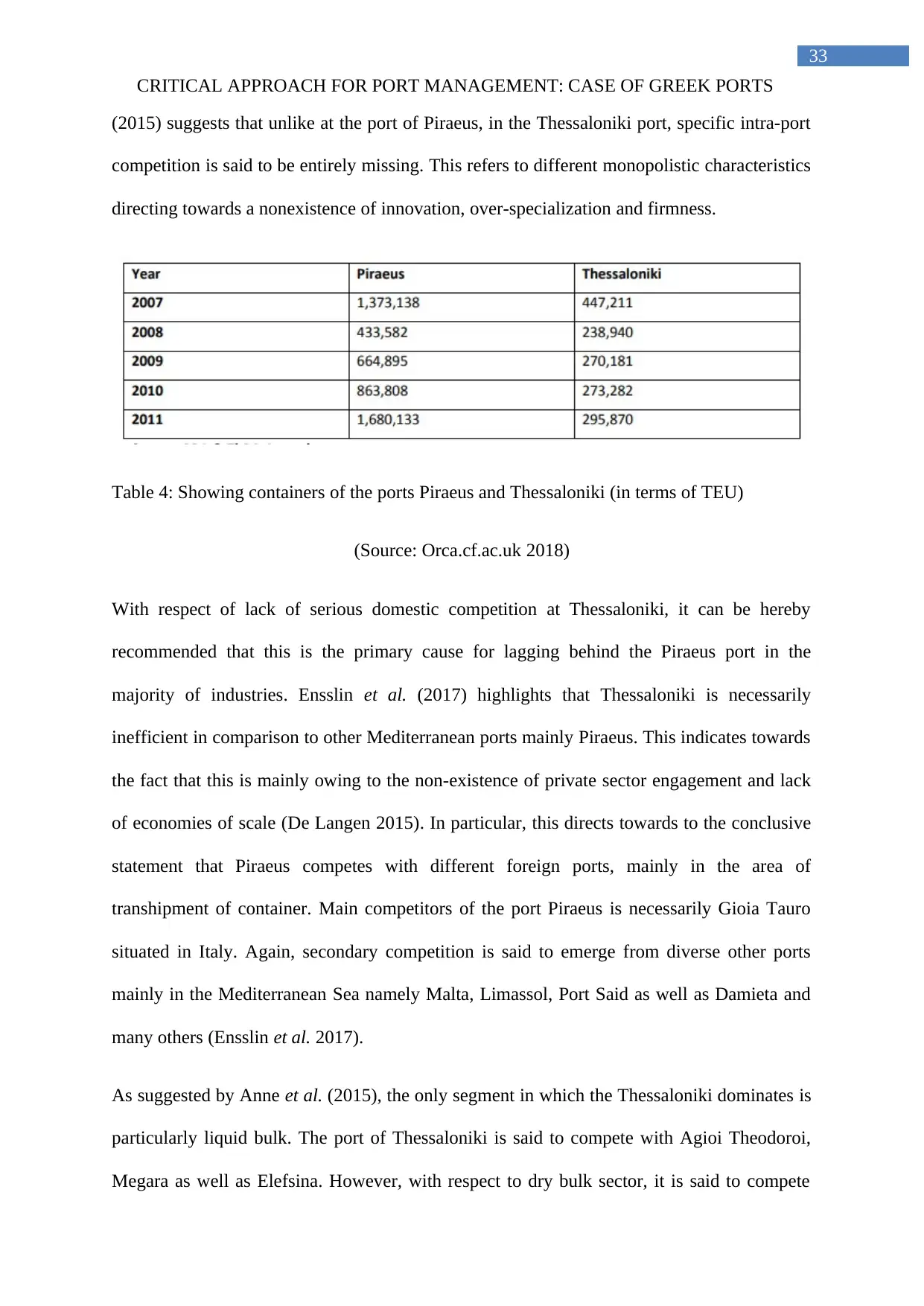
33
CRITICAL APPROACH FOR PORT MANAGEMENT: CASE OF GREEK PORTS
(2015) suggests that unlike at the port of Piraeus, in the Thessaloniki port, specific intra-port
competition is said to be entirely missing. This refers to different monopolistic characteristics
directing towards a nonexistence of innovation, over-specialization and firmness.
Table 4: Showing containers of the ports Piraeus and Thessaloniki (in terms of TEU)
(Source: Orca.cf.ac.uk 2018)
With respect of lack of serious domestic competition at Thessaloniki, it can be hereby
recommended that this is the primary cause for lagging behind the Piraeus port in the
majority of industries. Ensslin et al. (2017) highlights that Thessaloniki is necessarily
inefficient in comparison to other Mediterranean ports mainly Piraeus. This indicates towards
the fact that this is mainly owing to the non-existence of private sector engagement and lack
of economies of scale (De Langen 2015). In particular, this directs towards to the conclusive
statement that Piraeus competes with different foreign ports, mainly in the area of
transhipment of container. Main competitors of the port Piraeus is necessarily Gioia Tauro
situated in Italy. Again, secondary competition is said to emerge from diverse other ports
mainly in the Mediterranean Sea namely Malta, Limassol, Port Said as well as Damieta and
many others (Ensslin et al. 2017).
As suggested by Anne et al. (2015), the only segment in which the Thessaloniki dominates is
particularly liquid bulk. The port of Thessaloniki is said to compete with Agioi Theodoroi,
Megara as well as Elefsina. However, with respect to dry bulk sector, it is said to compete
CRITICAL APPROACH FOR PORT MANAGEMENT: CASE OF GREEK PORTS
(2015) suggests that unlike at the port of Piraeus, in the Thessaloniki port, specific intra-port
competition is said to be entirely missing. This refers to different monopolistic characteristics
directing towards a nonexistence of innovation, over-specialization and firmness.
Table 4: Showing containers of the ports Piraeus and Thessaloniki (in terms of TEU)
(Source: Orca.cf.ac.uk 2018)
With respect of lack of serious domestic competition at Thessaloniki, it can be hereby
recommended that this is the primary cause for lagging behind the Piraeus port in the
majority of industries. Ensslin et al. (2017) highlights that Thessaloniki is necessarily
inefficient in comparison to other Mediterranean ports mainly Piraeus. This indicates towards
the fact that this is mainly owing to the non-existence of private sector engagement and lack
of economies of scale (De Langen 2015). In particular, this directs towards to the conclusive
statement that Piraeus competes with different foreign ports, mainly in the area of
transhipment of container. Main competitors of the port Piraeus is necessarily Gioia Tauro
situated in Italy. Again, secondary competition is said to emerge from diverse other ports
mainly in the Mediterranean Sea namely Malta, Limassol, Port Said as well as Damieta and
many others (Ensslin et al. 2017).
As suggested by Anne et al. (2015), the only segment in which the Thessaloniki dominates is
particularly liquid bulk. The port of Thessaloniki is said to compete with Agioi Theodoroi,
Megara as well as Elefsina. However, with respect to dry bulk sector, it is said to compete
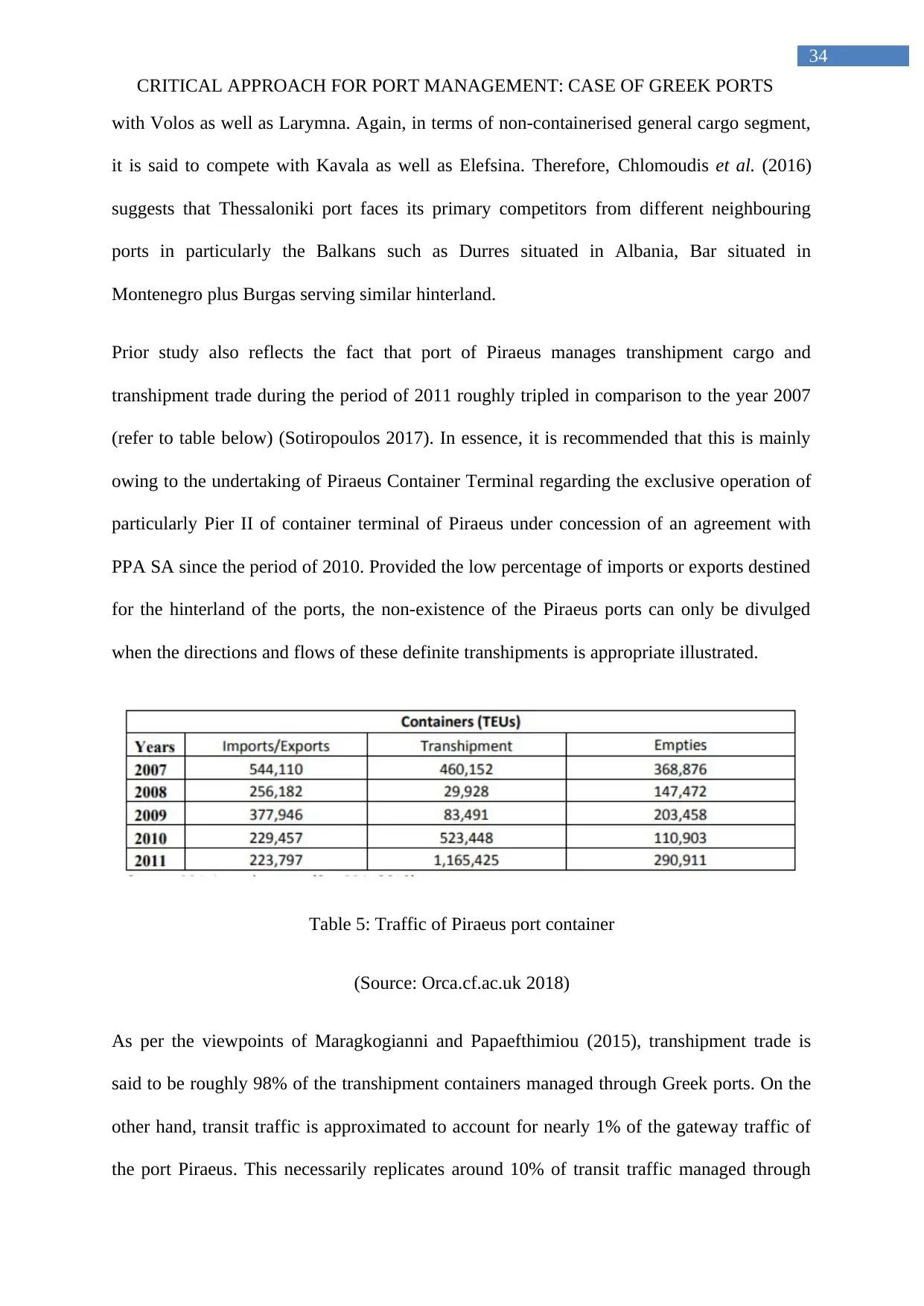
34
CRITICAL APPROACH FOR PORT MANAGEMENT: CASE OF GREEK PORTS
with Volos as well as Larymna. Again, in terms of non-containerised general cargo segment,
it is said to compete with Kavala as well as Elefsina. Therefore, Chlomoudis et al. (2016)
suggests that Thessaloniki port faces its primary competitors from different neighbouring
ports in particularly the Balkans such as Durres situated in Albania, Bar situated in
Montenegro plus Burgas serving similar hinterland.
Prior study also reflects the fact that port of Piraeus manages transhipment cargo and
transhipment trade during the period of 2011 roughly tripled in comparison to the year 2007
(refer to table below) (Sotiropoulos 2017). In essence, it is recommended that this is mainly
owing to the undertaking of Piraeus Container Terminal regarding the exclusive operation of
particularly Pier II of container terminal of Piraeus under concession of an agreement with
PPA SA since the period of 2010. Provided the low percentage of imports or exports destined
for the hinterland of the ports, the non-existence of the Piraeus ports can only be divulged
when the directions and flows of these definite transhipments is appropriate illustrated.
Table 5: Traffic of Piraeus port container
(Source: Orca.cf.ac.uk 2018)
As per the viewpoints of Maragkogianni and Papaefthimiou (2015), transhipment trade is
said to be roughly 98% of the transhipment containers managed through Greek ports. On the
other hand, transit traffic is approximated to account for nearly 1% of the gateway traffic of
the port Piraeus. This necessarily replicates around 10% of transit traffic managed through
CRITICAL APPROACH FOR PORT MANAGEMENT: CASE OF GREEK PORTS
with Volos as well as Larymna. Again, in terms of non-containerised general cargo segment,
it is said to compete with Kavala as well as Elefsina. Therefore, Chlomoudis et al. (2016)
suggests that Thessaloniki port faces its primary competitors from different neighbouring
ports in particularly the Balkans such as Durres situated in Albania, Bar situated in
Montenegro plus Burgas serving similar hinterland.
Prior study also reflects the fact that port of Piraeus manages transhipment cargo and
transhipment trade during the period of 2011 roughly tripled in comparison to the year 2007
(refer to table below) (Sotiropoulos 2017). In essence, it is recommended that this is mainly
owing to the undertaking of Piraeus Container Terminal regarding the exclusive operation of
particularly Pier II of container terminal of Piraeus under concession of an agreement with
PPA SA since the period of 2010. Provided the low percentage of imports or exports destined
for the hinterland of the ports, the non-existence of the Piraeus ports can only be divulged
when the directions and flows of these definite transhipments is appropriate illustrated.
Table 5: Traffic of Piraeus port container
(Source: Orca.cf.ac.uk 2018)
As per the viewpoints of Maragkogianni and Papaefthimiou (2015), transhipment trade is
said to be roughly 98% of the transhipment containers managed through Greek ports. On the
other hand, transit traffic is approximated to account for nearly 1% of the gateway traffic of
the port Piraeus. This necessarily replicates around 10% of transit traffic managed through
Paraphrase This Document
Need a fresh take? Get an instant paraphrase of this document with our AI Paraphraser
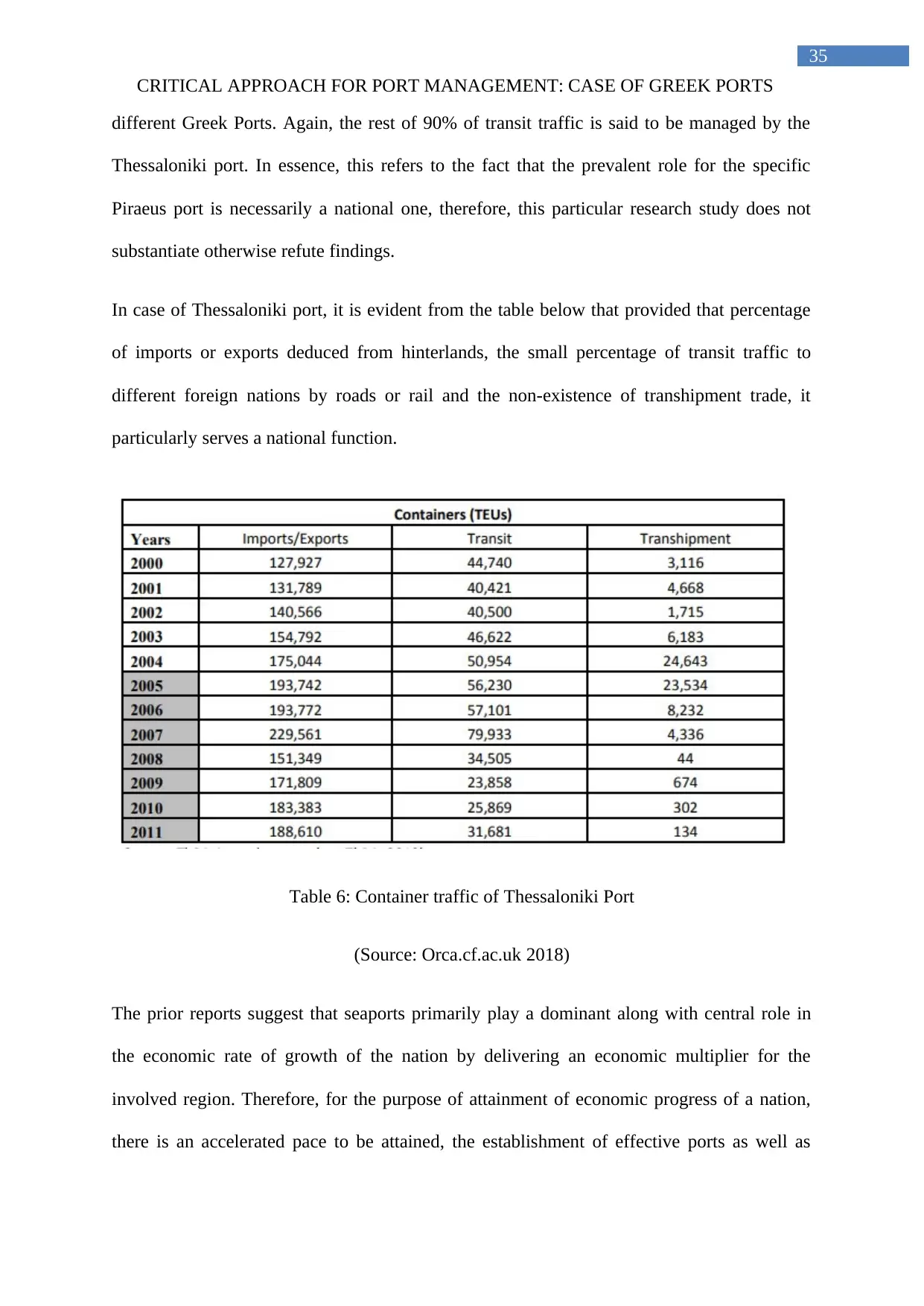
35
CRITICAL APPROACH FOR PORT MANAGEMENT: CASE OF GREEK PORTS
different Greek Ports. Again, the rest of 90% of transit traffic is said to be managed by the
Thessaloniki port. In essence, this refers to the fact that the prevalent role for the specific
Piraeus port is necessarily a national one, therefore, this particular research study does not
substantiate otherwise refute findings.
In case of Thessaloniki port, it is evident from the table below that provided that percentage
of imports or exports deduced from hinterlands, the small percentage of transit traffic to
different foreign nations by roads or rail and the non-existence of transhipment trade, it
particularly serves a national function.
Table 6: Container traffic of Thessaloniki Port
(Source: Orca.cf.ac.uk 2018)
The prior reports suggest that seaports primarily play a dominant along with central role in
the economic rate of growth of the nation by delivering an economic multiplier for the
involved region. Therefore, for the purpose of attainment of economic progress of a nation,
there is an accelerated pace to be attained, the establishment of effective ports as well as
CRITICAL APPROACH FOR PORT MANAGEMENT: CASE OF GREEK PORTS
different Greek Ports. Again, the rest of 90% of transit traffic is said to be managed by the
Thessaloniki port. In essence, this refers to the fact that the prevalent role for the specific
Piraeus port is necessarily a national one, therefore, this particular research study does not
substantiate otherwise refute findings.
In case of Thessaloniki port, it is evident from the table below that provided that percentage
of imports or exports deduced from hinterlands, the small percentage of transit traffic to
different foreign nations by roads or rail and the non-existence of transhipment trade, it
particularly serves a national function.
Table 6: Container traffic of Thessaloniki Port
(Source: Orca.cf.ac.uk 2018)
The prior reports suggest that seaports primarily play a dominant along with central role in
the economic rate of growth of the nation by delivering an economic multiplier for the
involved region. Therefore, for the purpose of attainment of economic progress of a nation,
there is an accelerated pace to be attained, the establishment of effective ports as well as
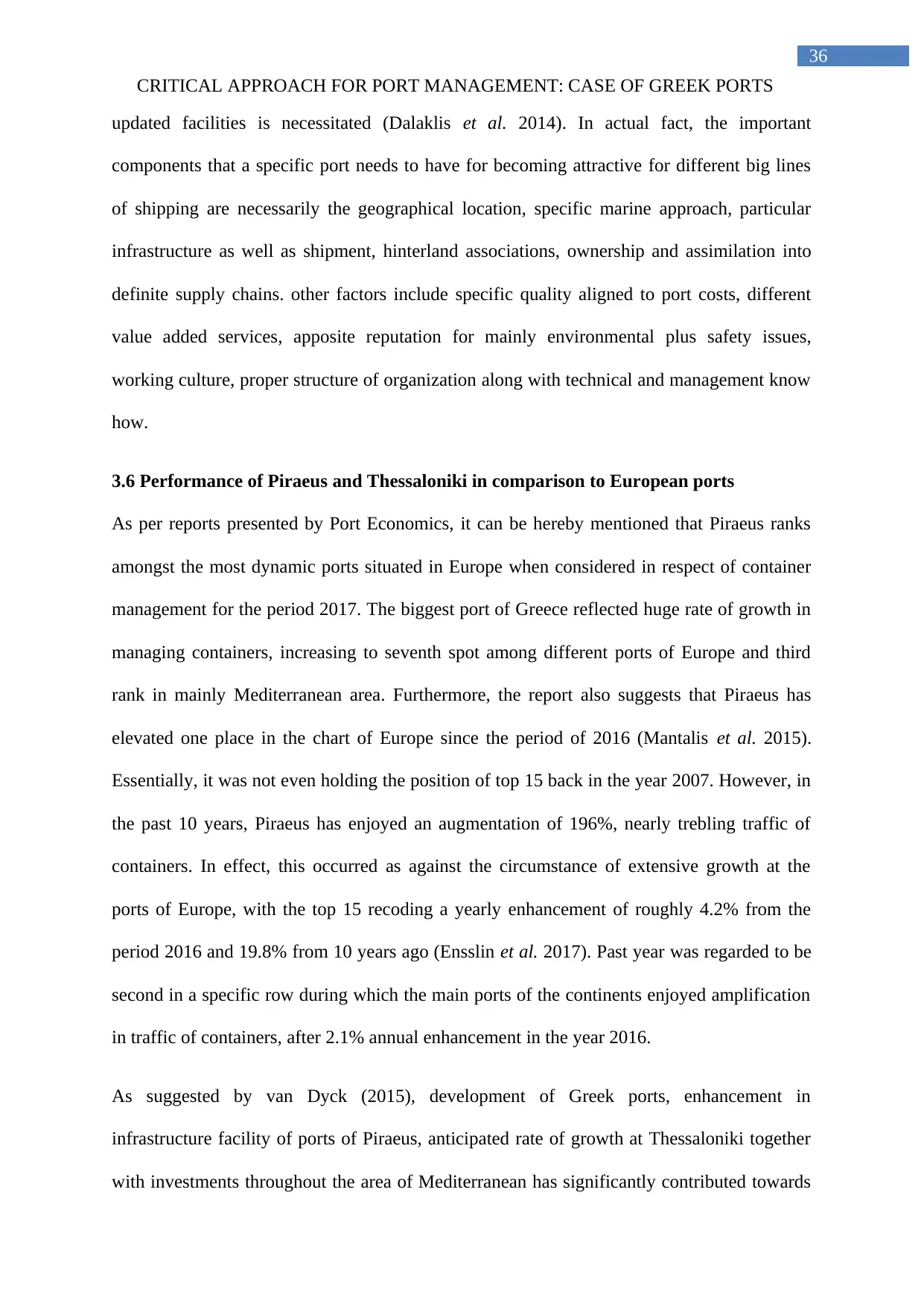
36
CRITICAL APPROACH FOR PORT MANAGEMENT: CASE OF GREEK PORTS
updated facilities is necessitated (Dalaklis et al. 2014). In actual fact, the important
components that a specific port needs to have for becoming attractive for different big lines
of shipping are necessarily the geographical location, specific marine approach, particular
infrastructure as well as shipment, hinterland associations, ownership and assimilation into
definite supply chains. other factors include specific quality aligned to port costs, different
value added services, apposite reputation for mainly environmental plus safety issues,
working culture, proper structure of organization along with technical and management know
how.
3.6 Performance of Piraeus and Thessaloniki in comparison to European ports
As per reports presented by Port Economics, it can be hereby mentioned that Piraeus ranks
amongst the most dynamic ports situated in Europe when considered in respect of container
management for the period 2017. The biggest port of Greece reflected huge rate of growth in
managing containers, increasing to seventh spot among different ports of Europe and third
rank in mainly Mediterranean area. Furthermore, the report also suggests that Piraeus has
elevated one place in the chart of Europe since the period of 2016 (Mantalis et al. 2015).
Essentially, it was not even holding the position of top 15 back in the year 2007. However, in
the past 10 years, Piraeus has enjoyed an augmentation of 196%, nearly trebling traffic of
containers. In effect, this occurred as against the circumstance of extensive growth at the
ports of Europe, with the top 15 recoding a yearly enhancement of roughly 4.2% from the
period 2016 and 19.8% from 10 years ago (Ensslin et al. 2017). Past year was regarded to be
second in a specific row during which the main ports of the continents enjoyed amplification
in traffic of containers, after 2.1% annual enhancement in the year 2016.
As suggested by van Dyck (2015), development of Greek ports, enhancement in
infrastructure facility of ports of Piraeus, anticipated rate of growth at Thessaloniki together
with investments throughout the area of Mediterranean has significantly contributed towards
CRITICAL APPROACH FOR PORT MANAGEMENT: CASE OF GREEK PORTS
updated facilities is necessitated (Dalaklis et al. 2014). In actual fact, the important
components that a specific port needs to have for becoming attractive for different big lines
of shipping are necessarily the geographical location, specific marine approach, particular
infrastructure as well as shipment, hinterland associations, ownership and assimilation into
definite supply chains. other factors include specific quality aligned to port costs, different
value added services, apposite reputation for mainly environmental plus safety issues,
working culture, proper structure of organization along with technical and management know
how.
3.6 Performance of Piraeus and Thessaloniki in comparison to European ports
As per reports presented by Port Economics, it can be hereby mentioned that Piraeus ranks
amongst the most dynamic ports situated in Europe when considered in respect of container
management for the period 2017. The biggest port of Greece reflected huge rate of growth in
managing containers, increasing to seventh spot among different ports of Europe and third
rank in mainly Mediterranean area. Furthermore, the report also suggests that Piraeus has
elevated one place in the chart of Europe since the period of 2016 (Mantalis et al. 2015).
Essentially, it was not even holding the position of top 15 back in the year 2007. However, in
the past 10 years, Piraeus has enjoyed an augmentation of 196%, nearly trebling traffic of
containers. In effect, this occurred as against the circumstance of extensive growth at the
ports of Europe, with the top 15 recoding a yearly enhancement of roughly 4.2% from the
period 2016 and 19.8% from 10 years ago (Ensslin et al. 2017). Past year was regarded to be
second in a specific row during which the main ports of the continents enjoyed amplification
in traffic of containers, after 2.1% annual enhancement in the year 2016.
As suggested by van Dyck (2015), development of Greek ports, enhancement in
infrastructure facility of ports of Piraeus, anticipated rate of growth at Thessaloniki together
with investments throughout the area of Mediterranean has significantly contributed towards
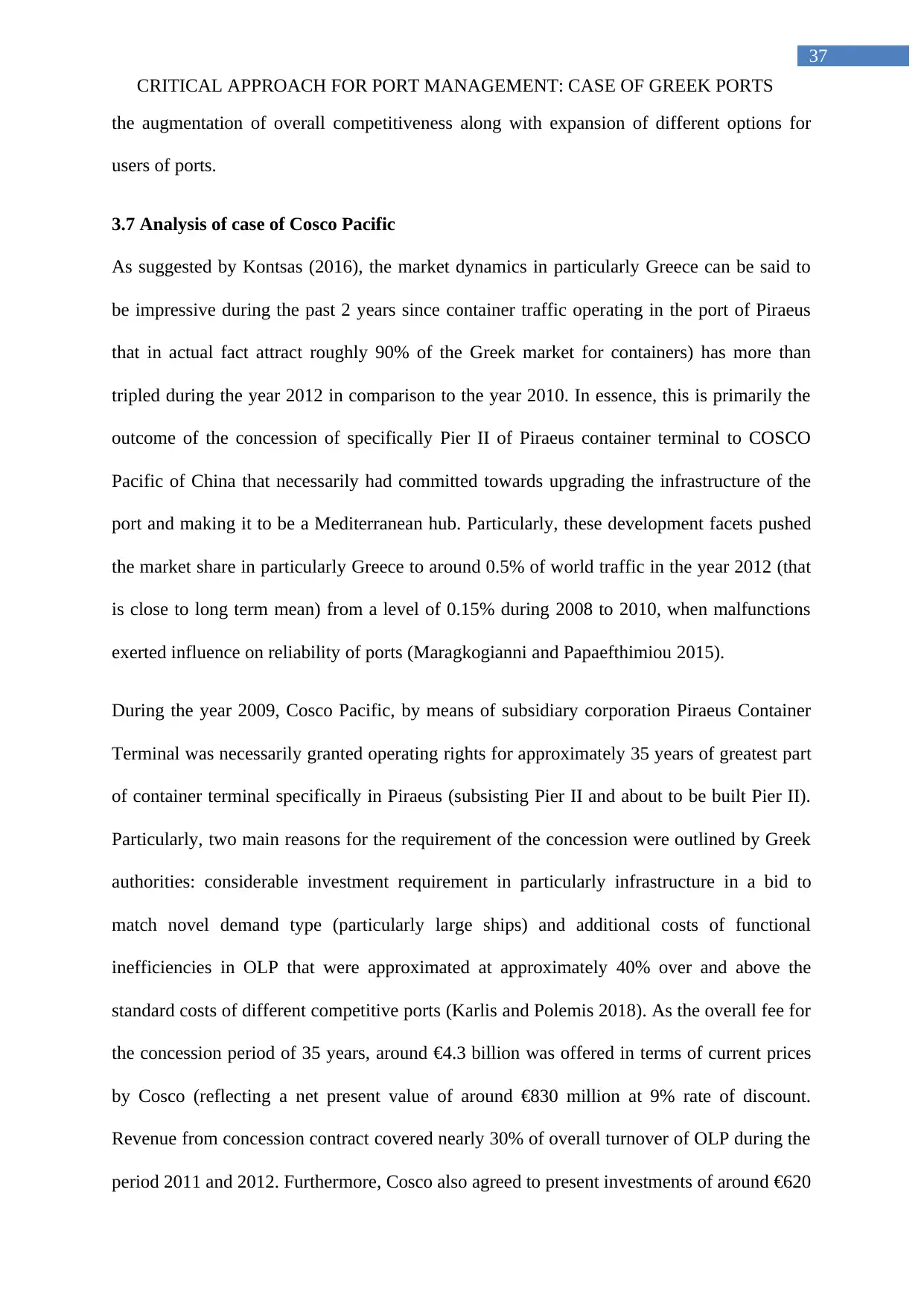
37
CRITICAL APPROACH FOR PORT MANAGEMENT: CASE OF GREEK PORTS
the augmentation of overall competitiveness along with expansion of different options for
users of ports.
3.7 Analysis of case of Cosco Pacific
As suggested by Kontsas (2016), the market dynamics in particularly Greece can be said to
be impressive during the past 2 years since container traffic operating in the port of Piraeus
that in actual fact attract roughly 90% of the Greek market for containers) has more than
tripled during the year 2012 in comparison to the year 2010. In essence, this is primarily the
outcome of the concession of specifically Pier II of Piraeus container terminal to COSCO
Pacific of China that necessarily had committed towards upgrading the infrastructure of the
port and making it to be a Mediterranean hub. Particularly, these development facets pushed
the market share in particularly Greece to around 0.5% of world traffic in the year 2012 (that
is close to long term mean) from a level of 0.15% during 2008 to 2010, when malfunctions
exerted influence on reliability of ports (Maragkogianni and Papaefthimiou 2015).
During the year 2009, Cosco Pacific, by means of subsidiary corporation Piraeus Container
Terminal was necessarily granted operating rights for approximately 35 years of greatest part
of container terminal specifically in Piraeus (subsisting Pier II and about to be built Pier II).
Particularly, two main reasons for the requirement of the concession were outlined by Greek
authorities: considerable investment requirement in particularly infrastructure in a bid to
match novel demand type (particularly large ships) and additional costs of functional
inefficiencies in OLP that were approximated at approximately 40% over and above the
standard costs of different competitive ports (Karlis and Polemis 2018). As the overall fee for
the concession period of 35 years, around €4.3 billion was offered in terms of current prices
by Cosco (reflecting a net present value of around €830 million at 9% rate of discount.
Revenue from concession contract covered nearly 30% of overall turnover of OLP during the
period 2011 and 2012. Furthermore, Cosco also agreed to present investments of around €620
CRITICAL APPROACH FOR PORT MANAGEMENT: CASE OF GREEK PORTS
the augmentation of overall competitiveness along with expansion of different options for
users of ports.
3.7 Analysis of case of Cosco Pacific
As suggested by Kontsas (2016), the market dynamics in particularly Greece can be said to
be impressive during the past 2 years since container traffic operating in the port of Piraeus
that in actual fact attract roughly 90% of the Greek market for containers) has more than
tripled during the year 2012 in comparison to the year 2010. In essence, this is primarily the
outcome of the concession of specifically Pier II of Piraeus container terminal to COSCO
Pacific of China that necessarily had committed towards upgrading the infrastructure of the
port and making it to be a Mediterranean hub. Particularly, these development facets pushed
the market share in particularly Greece to around 0.5% of world traffic in the year 2012 (that
is close to long term mean) from a level of 0.15% during 2008 to 2010, when malfunctions
exerted influence on reliability of ports (Maragkogianni and Papaefthimiou 2015).
During the year 2009, Cosco Pacific, by means of subsidiary corporation Piraeus Container
Terminal was necessarily granted operating rights for approximately 35 years of greatest part
of container terminal specifically in Piraeus (subsisting Pier II and about to be built Pier II).
Particularly, two main reasons for the requirement of the concession were outlined by Greek
authorities: considerable investment requirement in particularly infrastructure in a bid to
match novel demand type (particularly large ships) and additional costs of functional
inefficiencies in OLP that were approximated at approximately 40% over and above the
standard costs of different competitive ports (Karlis and Polemis 2018). As the overall fee for
the concession period of 35 years, around €4.3 billion was offered in terms of current prices
by Cosco (reflecting a net present value of around €830 million at 9% rate of discount.
Revenue from concession contract covered nearly 30% of overall turnover of OLP during the
period 2011 and 2012. Furthermore, Cosco also agreed to present investments of around €620
Secure Best Marks with AI Grader
Need help grading? Try our AI Grader for instant feedback on your assignments.
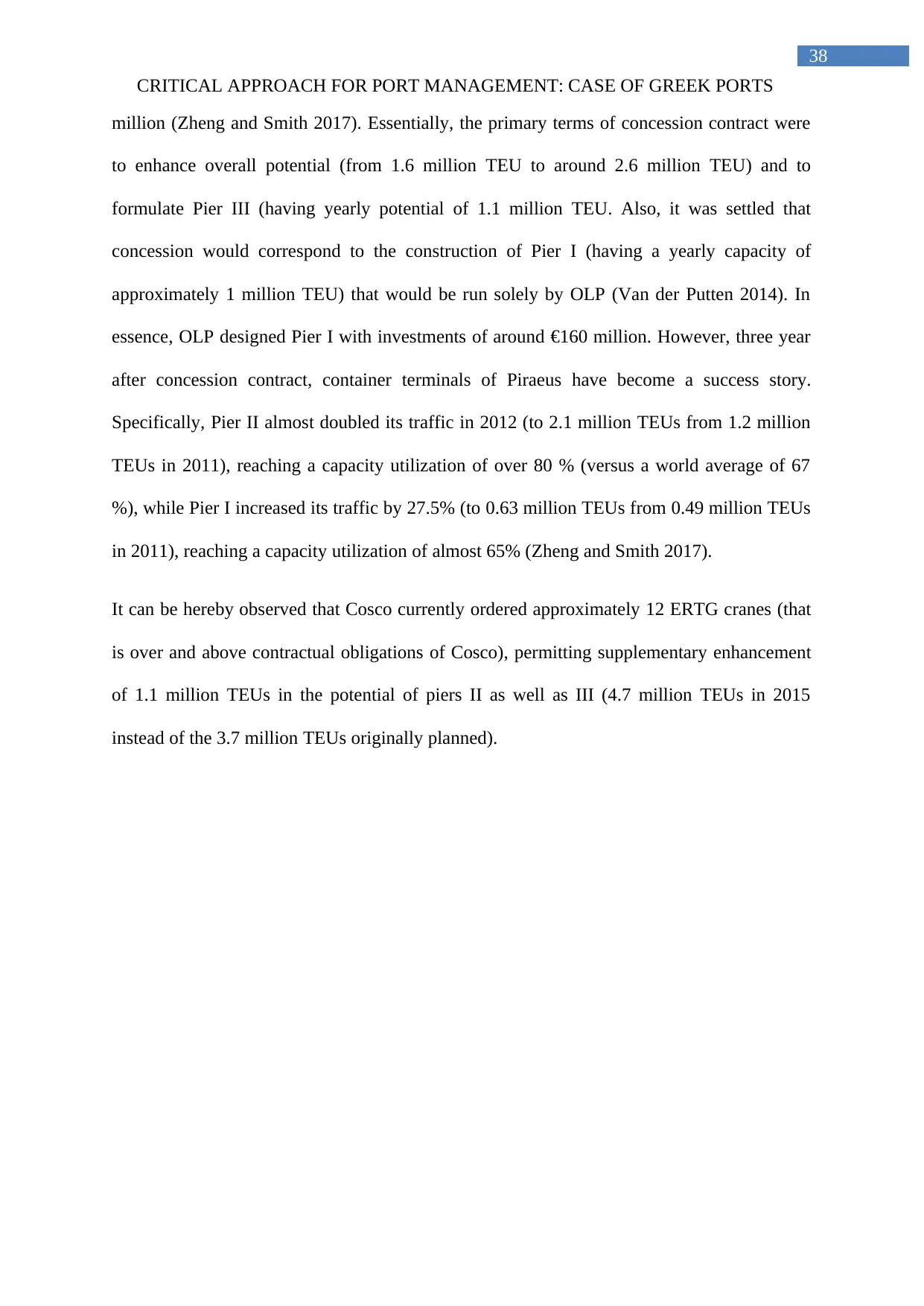
38
CRITICAL APPROACH FOR PORT MANAGEMENT: CASE OF GREEK PORTS
million (Zheng and Smith 2017). Essentially, the primary terms of concession contract were
to enhance overall potential (from 1.6 million TEU to around 2.6 million TEU) and to
formulate Pier III (having yearly potential of 1.1 million TEU. Also, it was settled that
concession would correspond to the construction of Pier I (having a yearly capacity of
approximately 1 million TEU) that would be run solely by OLP (Van der Putten 2014). In
essence, OLP designed Pier I with investments of around €160 million. However, three year
after concession contract, container terminals of Piraeus have become a success story.
Specifically, Pier II almost doubled its traffic in 2012 (to 2.1 million TEUs from 1.2 million
TEUs in 2011), reaching a capacity utilization of over 80 % (versus a world average of 67
%), while Pier I increased its traffic by 27.5% (to 0.63 million TEUs from 0.49 million TEUs
in 2011), reaching a capacity utilization of almost 65% (Zheng and Smith 2017).
It can be hereby observed that Cosco currently ordered approximately 12 ERTG cranes (that
is over and above contractual obligations of Cosco), permitting supplementary enhancement
of 1.1 million TEUs in the potential of piers II as well as III (4.7 million TEUs in 2015
instead of the 3.7 million TEUs originally planned).
CRITICAL APPROACH FOR PORT MANAGEMENT: CASE OF GREEK PORTS
million (Zheng and Smith 2017). Essentially, the primary terms of concession contract were
to enhance overall potential (from 1.6 million TEU to around 2.6 million TEU) and to
formulate Pier III (having yearly potential of 1.1 million TEU. Also, it was settled that
concession would correspond to the construction of Pier I (having a yearly capacity of
approximately 1 million TEU) that would be run solely by OLP (Van der Putten 2014). In
essence, OLP designed Pier I with investments of around €160 million. However, three year
after concession contract, container terminals of Piraeus have become a success story.
Specifically, Pier II almost doubled its traffic in 2012 (to 2.1 million TEUs from 1.2 million
TEUs in 2011), reaching a capacity utilization of over 80 % (versus a world average of 67
%), while Pier I increased its traffic by 27.5% (to 0.63 million TEUs from 0.49 million TEUs
in 2011), reaching a capacity utilization of almost 65% (Zheng and Smith 2017).
It can be hereby observed that Cosco currently ordered approximately 12 ERTG cranes (that
is over and above contractual obligations of Cosco), permitting supplementary enhancement
of 1.1 million TEUs in the potential of piers II as well as III (4.7 million TEUs in 2015
instead of the 3.7 million TEUs originally planned).
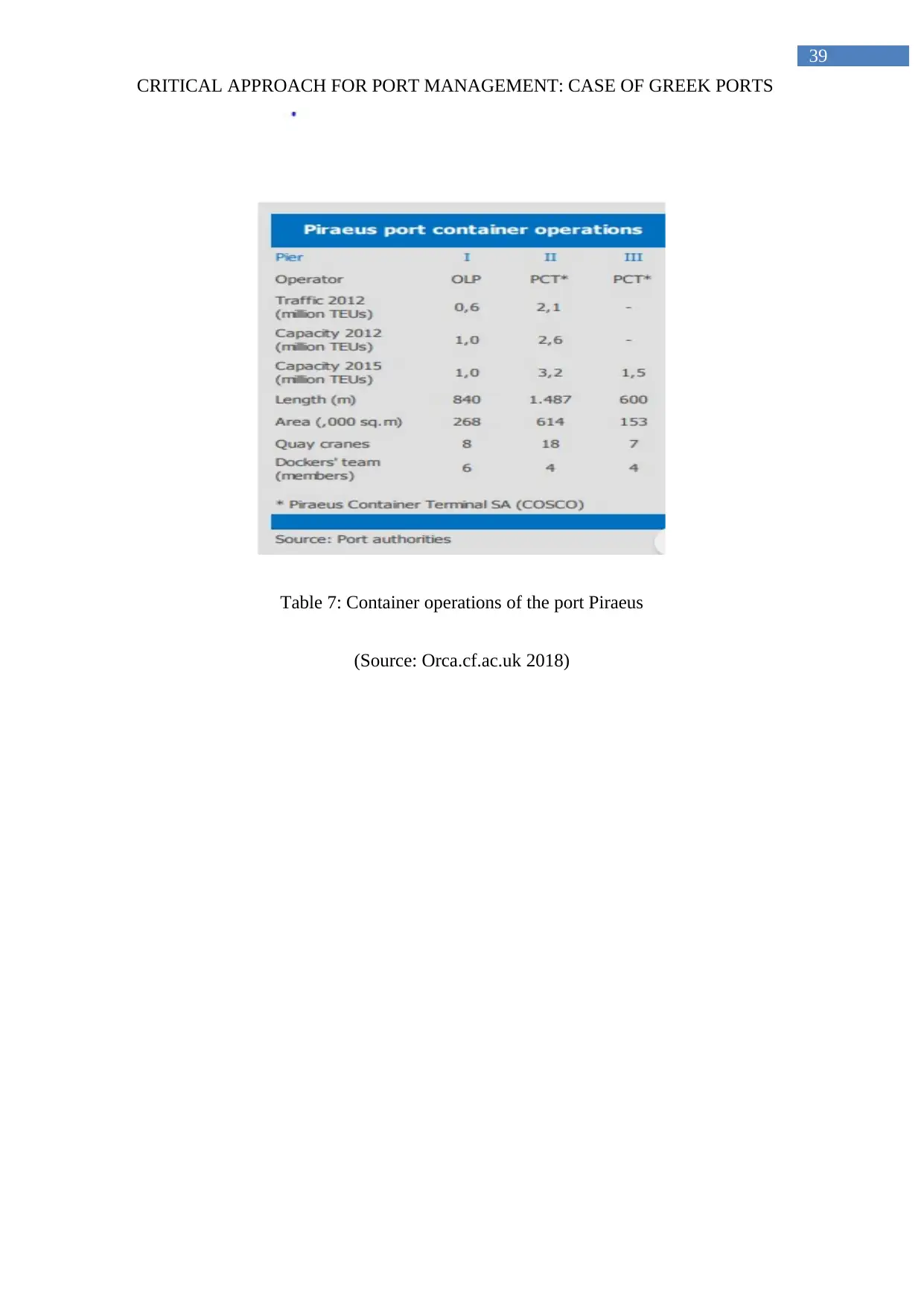
39
CRITICAL APPROACH FOR PORT MANAGEMENT: CASE OF GREEK PORTS
Table 7: Container operations of the port Piraeus
(Source: Orca.cf.ac.uk 2018)
CRITICAL APPROACH FOR PORT MANAGEMENT: CASE OF GREEK PORTS
Table 7: Container operations of the port Piraeus
(Source: Orca.cf.ac.uk 2018)
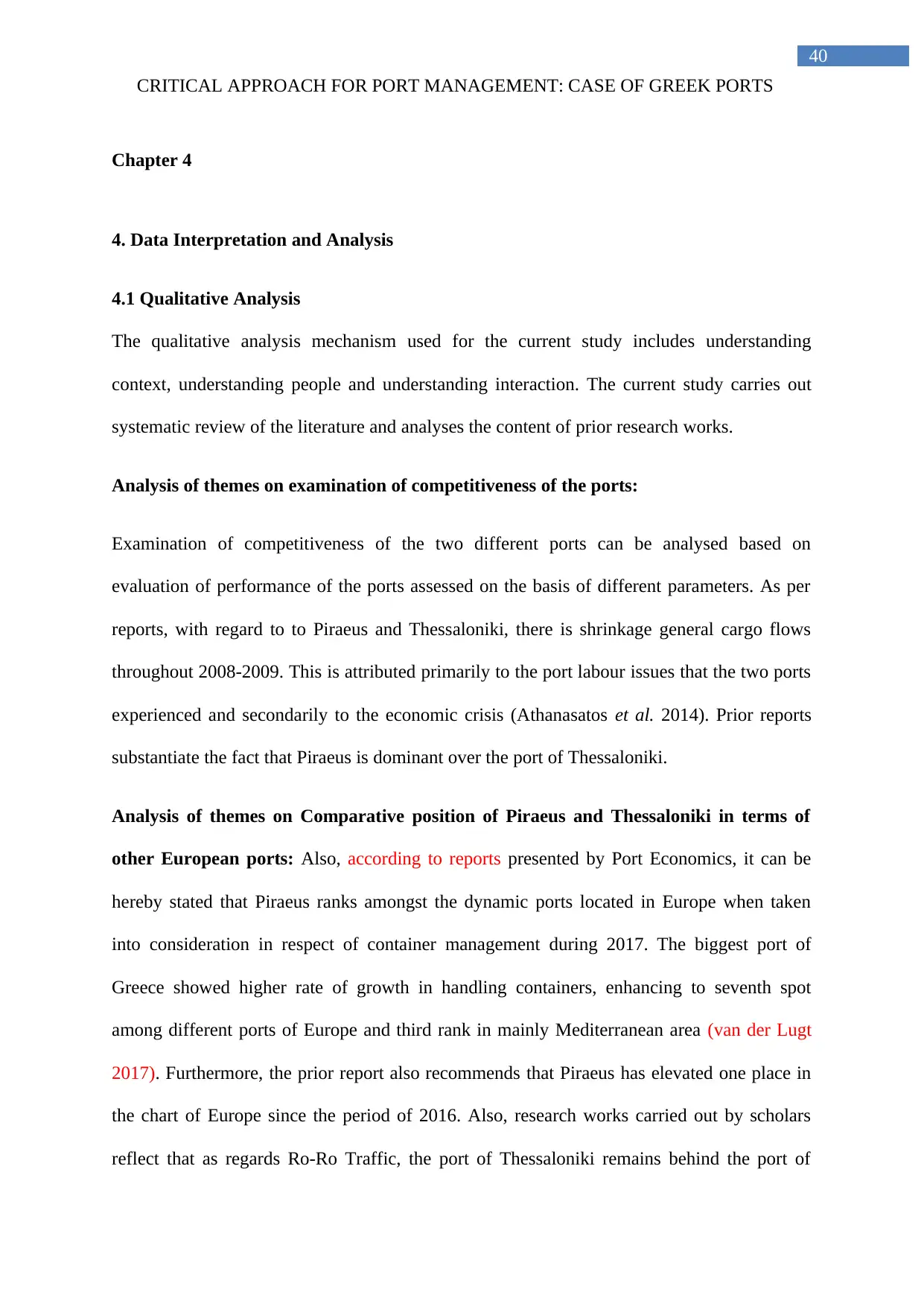
40
CRITICAL APPROACH FOR PORT MANAGEMENT: CASE OF GREEK PORTS
Chapter 4
4. Data Interpretation and Analysis
4.1 Qualitative Analysis
The qualitative analysis mechanism used for the current study includes understanding
context, understanding people and understanding interaction. The current study carries out
systematic review of the literature and analyses the content of prior research works.
Analysis of themes on examination of competitiveness of the ports:
Examination of competitiveness of the two different ports can be analysed based on
evaluation of performance of the ports assessed on the basis of different parameters. As per
reports, with regard to to Piraeus and Thessaloniki, there is shrinkage general cargo flows
throughout 2008-2009. This is attributed primarily to the port labour issues that the two ports
experienced and secondarily to the economic crisis (Athanasatos et al. 2014). Prior reports
substantiate the fact that Piraeus is dominant over the port of Thessaloniki.
Analysis of themes on Comparative position of Piraeus and Thessaloniki in terms of
other European ports: Also, according to reports presented by Port Economics, it can be
hereby stated that Piraeus ranks amongst the dynamic ports located in Europe when taken
into consideration in respect of container management during 2017. The biggest port of
Greece showed higher rate of growth in handling containers, enhancing to seventh spot
among different ports of Europe and third rank in mainly Mediterranean area (van der Lugt
2017). Furthermore, the prior report also recommends that Piraeus has elevated one place in
the chart of Europe since the period of 2016. Also, research works carried out by scholars
reflect that as regards Ro-Ro Traffic, the port of Thessaloniki remains behind the port of
CRITICAL APPROACH FOR PORT MANAGEMENT: CASE OF GREEK PORTS
Chapter 4
4. Data Interpretation and Analysis
4.1 Qualitative Analysis
The qualitative analysis mechanism used for the current study includes understanding
context, understanding people and understanding interaction. The current study carries out
systematic review of the literature and analyses the content of prior research works.
Analysis of themes on examination of competitiveness of the ports:
Examination of competitiveness of the two different ports can be analysed based on
evaluation of performance of the ports assessed on the basis of different parameters. As per
reports, with regard to to Piraeus and Thessaloniki, there is shrinkage general cargo flows
throughout 2008-2009. This is attributed primarily to the port labour issues that the two ports
experienced and secondarily to the economic crisis (Athanasatos et al. 2014). Prior reports
substantiate the fact that Piraeus is dominant over the port of Thessaloniki.
Analysis of themes on Comparative position of Piraeus and Thessaloniki in terms of
other European ports: Also, according to reports presented by Port Economics, it can be
hereby stated that Piraeus ranks amongst the dynamic ports located in Europe when taken
into consideration in respect of container management during 2017. The biggest port of
Greece showed higher rate of growth in handling containers, enhancing to seventh spot
among different ports of Europe and third rank in mainly Mediterranean area (van der Lugt
2017). Furthermore, the prior report also recommends that Piraeus has elevated one place in
the chart of Europe since the period of 2016. Also, research works carried out by scholars
reflect that as regards Ro-Ro Traffic, the port of Thessaloniki remains behind the port of
Paraphrase This Document
Need a fresh take? Get an instant paraphrase of this document with our AI Paraphraser
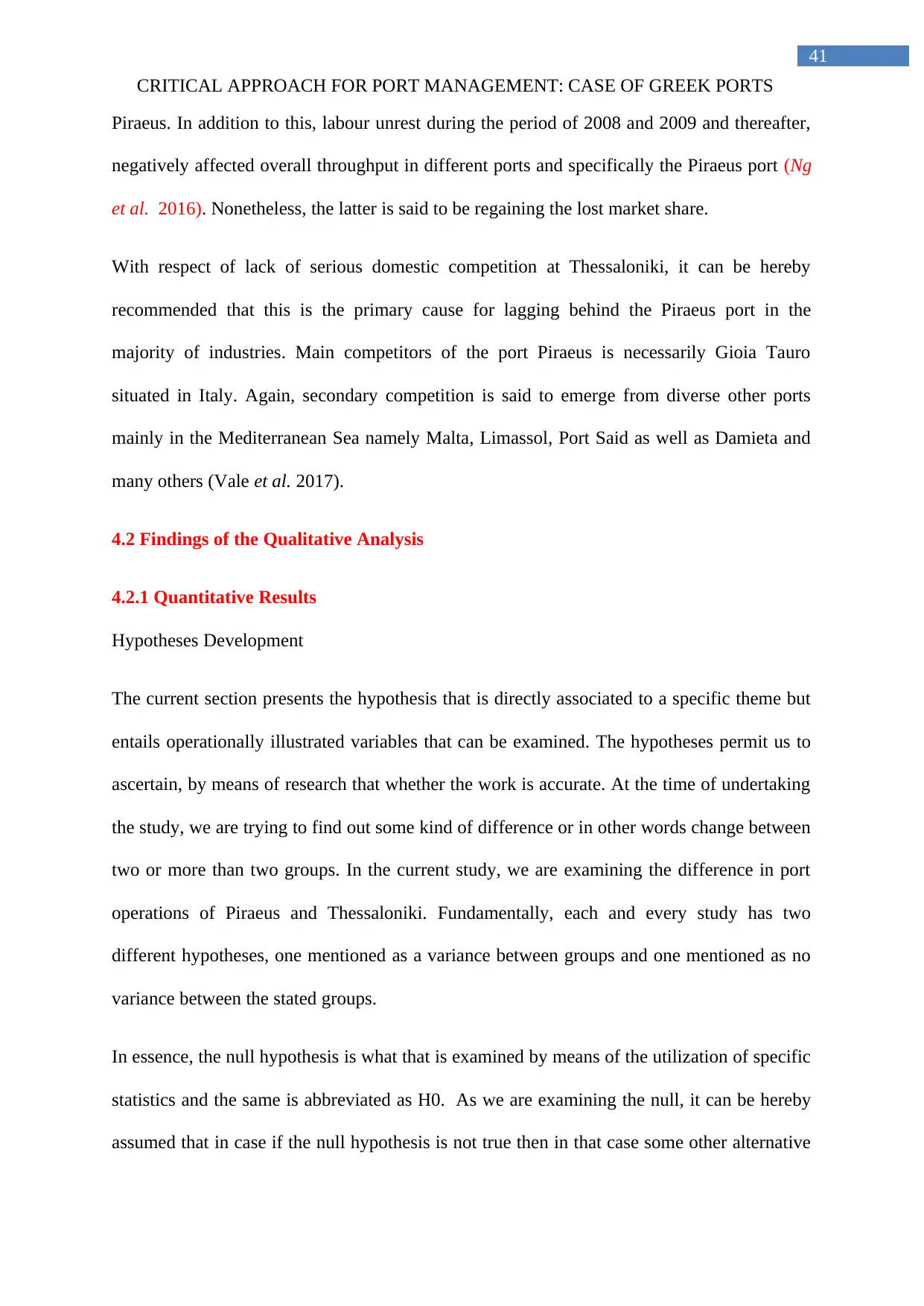
41
CRITICAL APPROACH FOR PORT MANAGEMENT: CASE OF GREEK PORTS
Piraeus. In addition to this, labour unrest during the period of 2008 and 2009 and thereafter,
negatively affected overall throughput in different ports and specifically the Piraeus port (Ng
et al. 2016). Nonetheless, the latter is said to be regaining the lost market share.
With respect of lack of serious domestic competition at Thessaloniki, it can be hereby
recommended that this is the primary cause for lagging behind the Piraeus port in the
majority of industries. Main competitors of the port Piraeus is necessarily Gioia Tauro
situated in Italy. Again, secondary competition is said to emerge from diverse other ports
mainly in the Mediterranean Sea namely Malta, Limassol, Port Said as well as Damieta and
many others (Vale et al. 2017).
4.2 Findings of the Qualitative Analysis
4.2.1 Quantitative Results
Hypotheses Development
The current section presents the hypothesis that is directly associated to a specific theme but
entails operationally illustrated variables that can be examined. The hypotheses permit us to
ascertain, by means of research that whether the work is accurate. At the time of undertaking
the study, we are trying to find out some kind of difference or in other words change between
two or more than two groups. In the current study, we are examining the difference in port
operations of Piraeus and Thessaloniki. Fundamentally, each and every study has two
different hypotheses, one mentioned as a variance between groups and one mentioned as no
variance between the stated groups.
In essence, the null hypothesis is what that is examined by means of the utilization of specific
statistics and the same is abbreviated as H0. As we are examining the null, it can be hereby
assumed that in case if the null hypothesis is not true then in that case some other alternative
CRITICAL APPROACH FOR PORT MANAGEMENT: CASE OF GREEK PORTS
Piraeus. In addition to this, labour unrest during the period of 2008 and 2009 and thereafter,
negatively affected overall throughput in different ports and specifically the Piraeus port (Ng
et al. 2016). Nonetheless, the latter is said to be regaining the lost market share.
With respect of lack of serious domestic competition at Thessaloniki, it can be hereby
recommended that this is the primary cause for lagging behind the Piraeus port in the
majority of industries. Main competitors of the port Piraeus is necessarily Gioia Tauro
situated in Italy. Again, secondary competition is said to emerge from diverse other ports
mainly in the Mediterranean Sea namely Malta, Limassol, Port Said as well as Damieta and
many others (Vale et al. 2017).
4.2 Findings of the Qualitative Analysis
4.2.1 Quantitative Results
Hypotheses Development
The current section presents the hypothesis that is directly associated to a specific theme but
entails operationally illustrated variables that can be examined. The hypotheses permit us to
ascertain, by means of research that whether the work is accurate. At the time of undertaking
the study, we are trying to find out some kind of difference or in other words change between
two or more than two groups. In the current study, we are examining the difference in port
operations of Piraeus and Thessaloniki. Fundamentally, each and every study has two
different hypotheses, one mentioned as a variance between groups and one mentioned as no
variance between the stated groups.
In essence, the null hypothesis is what that is examined by means of the utilization of specific
statistics and the same is abbreviated as H0. As we are examining the null, it can be hereby
assumed that in case if the null hypothesis is not true then in that case some other alternative
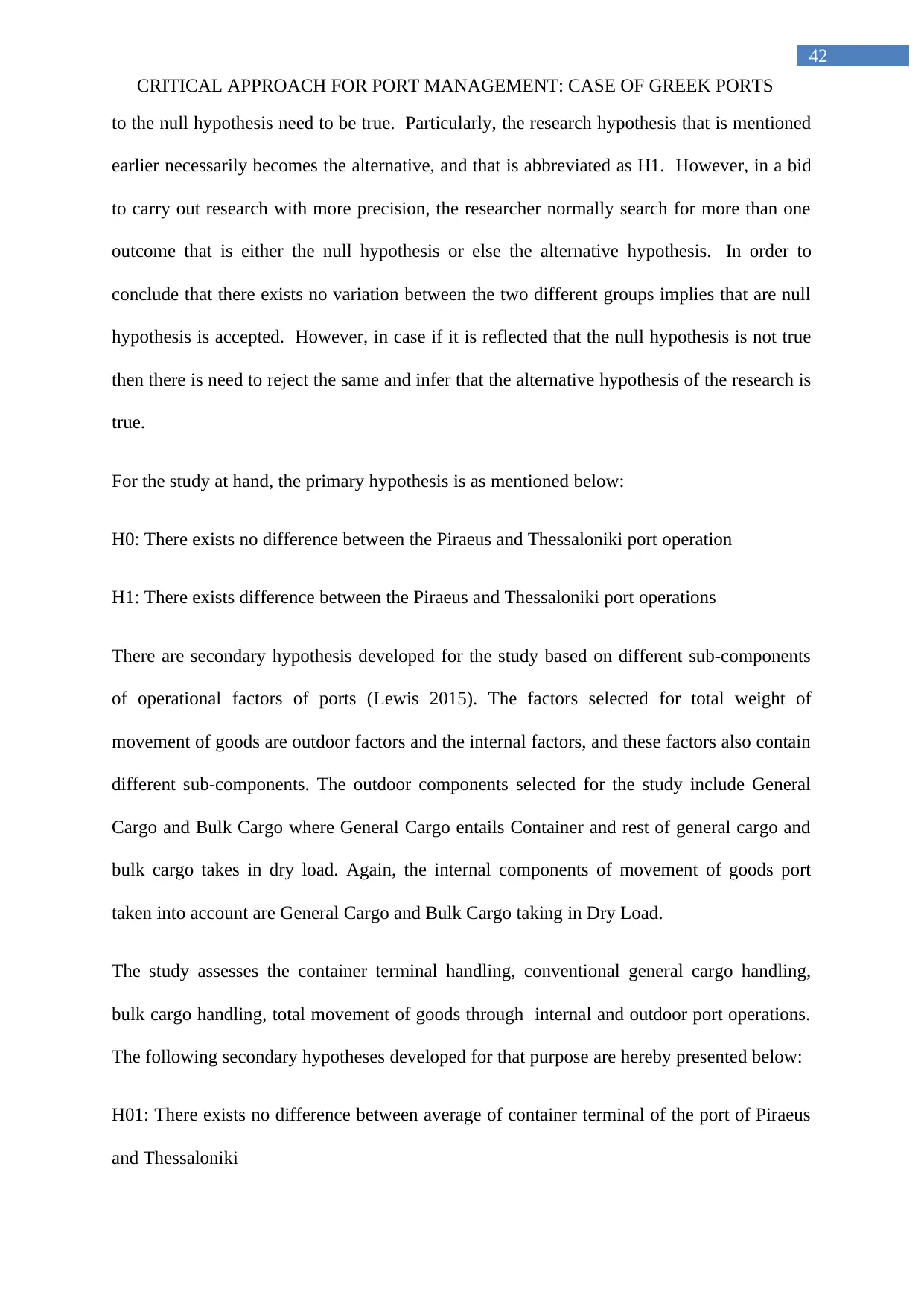
42
CRITICAL APPROACH FOR PORT MANAGEMENT: CASE OF GREEK PORTS
to the null hypothesis need to be true. Particularly, the research hypothesis that is mentioned
earlier necessarily becomes the alternative, and that is abbreviated as H1. However, in a bid
to carry out research with more precision, the researcher normally search for more than one
outcome that is either the null hypothesis or else the alternative hypothesis. In order to
conclude that there exists no variation between the two different groups implies that are null
hypothesis is accepted. However, in case if it is reflected that the null hypothesis is not true
then there is need to reject the same and infer that the alternative hypothesis of the research is
true.
For the study at hand, the primary hypothesis is as mentioned below:
H0: There exists no difference between the Piraeus and Thessaloniki port operation
H1: There exists difference between the Piraeus and Thessaloniki port operations
There are secondary hypothesis developed for the study based on different sub-components
of operational factors of ports (Lewis 2015). The factors selected for total weight of
movement of goods are outdoor factors and the internal factors, and these factors also contain
different sub-components. The outdoor components selected for the study include General
Cargo and Bulk Cargo where General Cargo entails Container and rest of general cargo and
bulk cargo takes in dry load. Again, the internal components of movement of goods port
taken into account are General Cargo and Bulk Cargo taking in Dry Load.
The study assesses the container terminal handling, conventional general cargo handling,
bulk cargo handling, total movement of goods through internal and outdoor port operations.
The following secondary hypotheses developed for that purpose are hereby presented below:
H01: There exists no difference between average of container terminal of the port of Piraeus
and Thessaloniki
CRITICAL APPROACH FOR PORT MANAGEMENT: CASE OF GREEK PORTS
to the null hypothesis need to be true. Particularly, the research hypothesis that is mentioned
earlier necessarily becomes the alternative, and that is abbreviated as H1. However, in a bid
to carry out research with more precision, the researcher normally search for more than one
outcome that is either the null hypothesis or else the alternative hypothesis. In order to
conclude that there exists no variation between the two different groups implies that are null
hypothesis is accepted. However, in case if it is reflected that the null hypothesis is not true
then there is need to reject the same and infer that the alternative hypothesis of the research is
true.
For the study at hand, the primary hypothesis is as mentioned below:
H0: There exists no difference between the Piraeus and Thessaloniki port operation
H1: There exists difference between the Piraeus and Thessaloniki port operations
There are secondary hypothesis developed for the study based on different sub-components
of operational factors of ports (Lewis 2015). The factors selected for total weight of
movement of goods are outdoor factors and the internal factors, and these factors also contain
different sub-components. The outdoor components selected for the study include General
Cargo and Bulk Cargo where General Cargo entails Container and rest of general cargo and
bulk cargo takes in dry load. Again, the internal components of movement of goods port
taken into account are General Cargo and Bulk Cargo taking in Dry Load.
The study assesses the container terminal handling, conventional general cargo handling,
bulk cargo handling, total movement of goods through internal and outdoor port operations.
The following secondary hypotheses developed for that purpose are hereby presented below:
H01: There exists no difference between average of container terminal of the port of Piraeus
and Thessaloniki
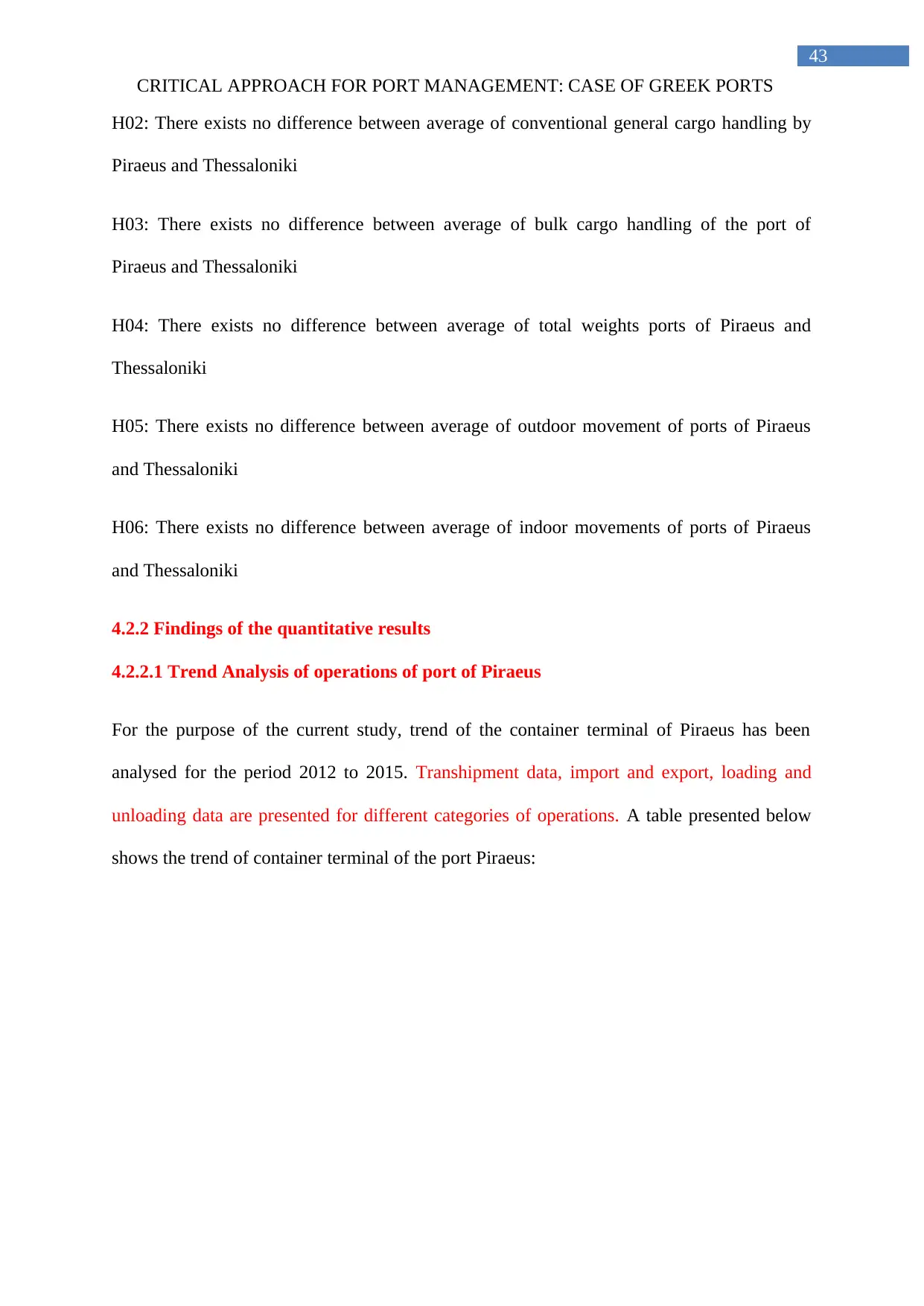
43
CRITICAL APPROACH FOR PORT MANAGEMENT: CASE OF GREEK PORTS
H02: There exists no difference between average of conventional general cargo handling by
Piraeus and Thessaloniki
H03: There exists no difference between average of bulk cargo handling of the port of
Piraeus and Thessaloniki
H04: There exists no difference between average of total weights ports of Piraeus and
Thessaloniki
H05: There exists no difference between average of outdoor movement of ports of Piraeus
and Thessaloniki
H06: There exists no difference between average of indoor movements of ports of Piraeus
and Thessaloniki
4.2.2 Findings of the quantitative results
4.2.2.1 Trend Analysis of operations of port of Piraeus
For the purpose of the current study, trend of the container terminal of Piraeus has been
analysed for the period 2012 to 2015. Transhipment data, import and export, loading and
unloading data are presented for different categories of operations. A table presented below
shows the trend of container terminal of the port Piraeus:
CRITICAL APPROACH FOR PORT MANAGEMENT: CASE OF GREEK PORTS
H02: There exists no difference between average of conventional general cargo handling by
Piraeus and Thessaloniki
H03: There exists no difference between average of bulk cargo handling of the port of
Piraeus and Thessaloniki
H04: There exists no difference between average of total weights ports of Piraeus and
Thessaloniki
H05: There exists no difference between average of outdoor movement of ports of Piraeus
and Thessaloniki
H06: There exists no difference between average of indoor movements of ports of Piraeus
and Thessaloniki
4.2.2 Findings of the quantitative results
4.2.2.1 Trend Analysis of operations of port of Piraeus
For the purpose of the current study, trend of the container terminal of Piraeus has been
analysed for the period 2012 to 2015. Transhipment data, import and export, loading and
unloading data are presented for different categories of operations. A table presented below
shows the trend of container terminal of the port Piraeus:
Secure Best Marks with AI Grader
Need help grading? Try our AI Grader for instant feedback on your assignments.

44
CRITICAL APPROACH FOR PORT MANAGEMENT: CASE OF GREEK PORTS
Analysis trend of container terminal of the port Piraeus
Table 8: Container Terminal (Container Terminal) (IN TEUs1)
2012 2013 2014 2015
Import and
Export 42,555 48,884 34,919 34,194
transhipment
4,83,97
2
5,20,72
2
4,27,21
4
2,29,08
4
Total 5,26,527 5,69,606 4,62,133 2,63,278
2012 2013 2014 2015
0
100,000
200,000
300,000
400,000
500,000
600,000
Year wise container terminal of Piraeus
Import and Export transshipment
Year
Cost
Figure 7: Container Terminal (Container Terminal)
Findings:
Based on the table and diagram presented above it can be hereby said that import and export
movement of the port Piraeus has sharply increased from 42555 (IN TEUs1) in 2012 to
48884 during 2013. However, the same drastically declined during the period 2014 as
compared to the year ago period. Based on the registered figures, it can be hereby stated the
import and export movement of the port further declined during the period 2015, reflecting a
CRITICAL APPROACH FOR PORT MANAGEMENT: CASE OF GREEK PORTS
Analysis trend of container terminal of the port Piraeus
Table 8: Container Terminal (Container Terminal) (IN TEUs1)
2012 2013 2014 2015
Import and
Export 42,555 48,884 34,919 34,194
transhipment
4,83,97
2
5,20,72
2
4,27,21
4
2,29,08
4
Total 5,26,527 5,69,606 4,62,133 2,63,278
2012 2013 2014 2015
0
100,000
200,000
300,000
400,000
500,000
600,000
Year wise container terminal of Piraeus
Import and Export transshipment
Year
Cost
Figure 7: Container Terminal (Container Terminal)
Findings:
Based on the table and diagram presented above it can be hereby said that import and export
movement of the port Piraeus has sharply increased from 42555 (IN TEUs1) in 2012 to
48884 during 2013. However, the same drastically declined during the period 2014 as
compared to the year ago period. Based on the registered figures, it can be hereby stated the
import and export movement of the port further declined during the period 2015, reflecting a

45
CRITICAL APPROACH FOR PORT MANAGEMENT: CASE OF GREEK PORTS
downward moving trend. Similarly, transhipment of the port also increased from 483972 in
2012 to 520722 in 2014, however, the same dropped sharply during the following years that
are during 2014 and 2015, leading to a decline in transhipment of the port. On the whole, the
total movement of the container terminal of the port Piraeus shows a declining trend (Taylor
et al. 2015).
4.2.2.2 Analysis trend of logistics vehicle station of car terminal of the port Piraeus
In the current study, trend of logistics vehicle station of car terminal of the port Piraeus has
been analysed for the period 2012 to 2015. A table presented below shows the trend of
logistics vehicle station of the port Piraeus:
Table 9: Logistics Vehicle Station (Car Terminal) (Car number)
2012 2013 2014 2015
Import and
Export 54,785 61,817 84,017 82,593
transhipment
4,03,97
0
3,86,86
5
2,75,64
8
2,58,79
3
Total 4,58,755 4,48,682 3,59,665 3,41,386
2012 2013 2014 2015
0
50,000
100,000
150,000
200,000
250,000
300,000
350,000
400,000
450,000
500,000
Year wise logistic vehicle station of Piraeus
Import and Export transshipment
Year
Cost
CRITICAL APPROACH FOR PORT MANAGEMENT: CASE OF GREEK PORTS
downward moving trend. Similarly, transhipment of the port also increased from 483972 in
2012 to 520722 in 2014, however, the same dropped sharply during the following years that
are during 2014 and 2015, leading to a decline in transhipment of the port. On the whole, the
total movement of the container terminal of the port Piraeus shows a declining trend (Taylor
et al. 2015).
4.2.2.2 Analysis trend of logistics vehicle station of car terminal of the port Piraeus
In the current study, trend of logistics vehicle station of car terminal of the port Piraeus has
been analysed for the period 2012 to 2015. A table presented below shows the trend of
logistics vehicle station of the port Piraeus:
Table 9: Logistics Vehicle Station (Car Terminal) (Car number)
2012 2013 2014 2015
Import and
Export 54,785 61,817 84,017 82,593
transhipment
4,03,97
0
3,86,86
5
2,75,64
8
2,58,79
3
Total 4,58,755 4,48,682 3,59,665 3,41,386
2012 2013 2014 2015
0
50,000
100,000
150,000
200,000
250,000
300,000
350,000
400,000
450,000
500,000
Year wise logistic vehicle station of Piraeus
Import and Export transshipment
Year
Cost
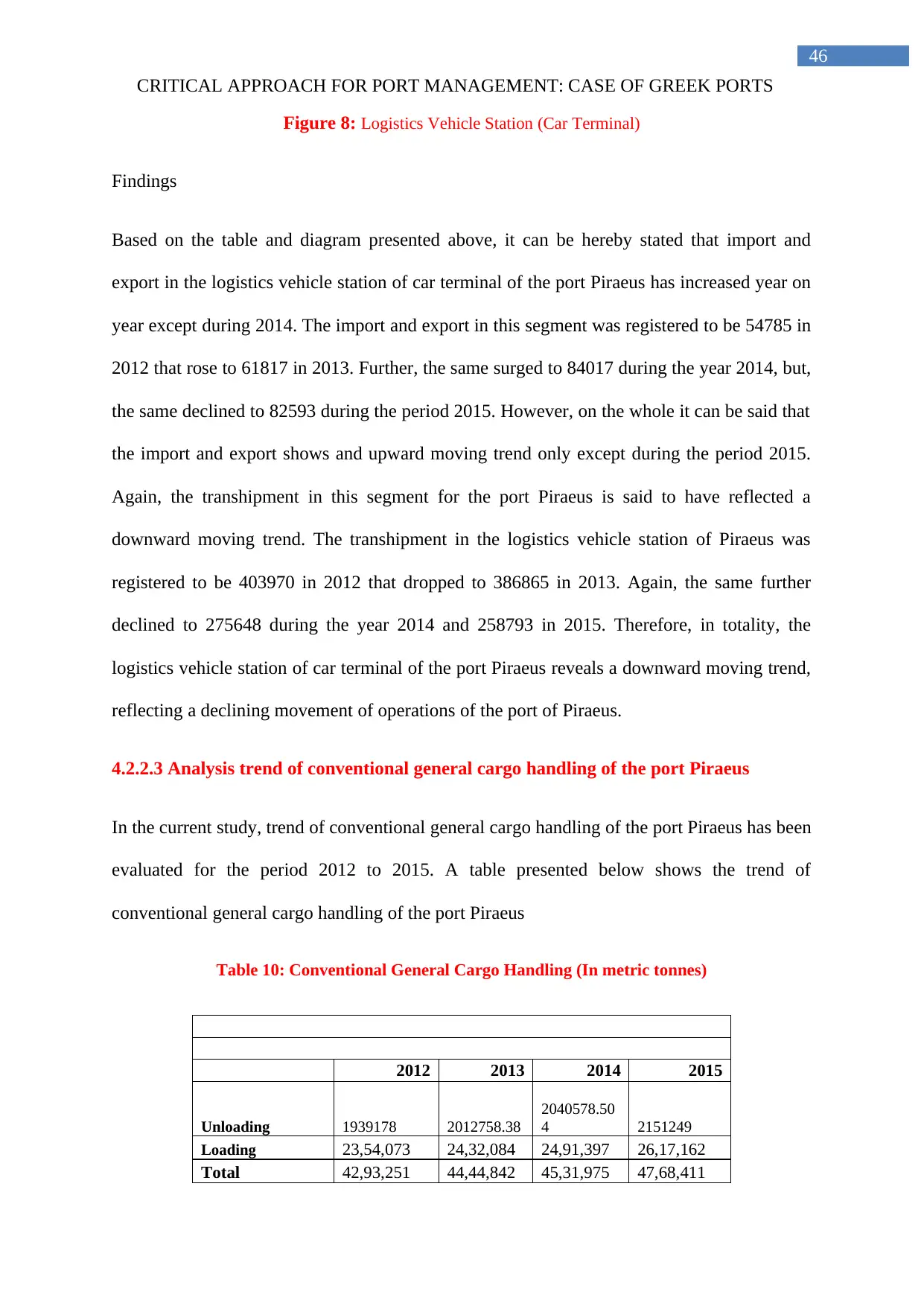
46
CRITICAL APPROACH FOR PORT MANAGEMENT: CASE OF GREEK PORTS
Figure 8: Logistics Vehicle Station (Car Terminal)
Findings
Based on the table and diagram presented above, it can be hereby stated that import and
export in the logistics vehicle station of car terminal of the port Piraeus has increased year on
year except during 2014. The import and export in this segment was registered to be 54785 in
2012 that rose to 61817 in 2013. Further, the same surged to 84017 during the year 2014, but,
the same declined to 82593 during the period 2015. However, on the whole it can be said that
the import and export shows and upward moving trend only except during the period 2015.
Again, the transhipment in this segment for the port Piraeus is said to have reflected a
downward moving trend. The transhipment in the logistics vehicle station of Piraeus was
registered to be 403970 in 2012 that dropped to 386865 in 2013. Again, the same further
declined to 275648 during the year 2014 and 258793 in 2015. Therefore, in totality, the
logistics vehicle station of car terminal of the port Piraeus reveals a downward moving trend,
reflecting a declining movement of operations of the port of Piraeus.
4.2.2.3 Analysis trend of conventional general cargo handling of the port Piraeus
In the current study, trend of conventional general cargo handling of the port Piraeus has been
evaluated for the period 2012 to 2015. A table presented below shows the trend of
conventional general cargo handling of the port Piraeus
Table 10: Conventional General Cargo Handling (In metric tonnes)
2012 2013 2014 2015
Unloading 1939178 2012758.38
2040578.50
4 2151249
Loading 23,54,073 24,32,084 24,91,397 26,17,162
Total 42,93,251 44,44,842 45,31,975 47,68,411
CRITICAL APPROACH FOR PORT MANAGEMENT: CASE OF GREEK PORTS
Figure 8: Logistics Vehicle Station (Car Terminal)
Findings
Based on the table and diagram presented above, it can be hereby stated that import and
export in the logistics vehicle station of car terminal of the port Piraeus has increased year on
year except during 2014. The import and export in this segment was registered to be 54785 in
2012 that rose to 61817 in 2013. Further, the same surged to 84017 during the year 2014, but,
the same declined to 82593 during the period 2015. However, on the whole it can be said that
the import and export shows and upward moving trend only except during the period 2015.
Again, the transhipment in this segment for the port Piraeus is said to have reflected a
downward moving trend. The transhipment in the logistics vehicle station of Piraeus was
registered to be 403970 in 2012 that dropped to 386865 in 2013. Again, the same further
declined to 275648 during the year 2014 and 258793 in 2015. Therefore, in totality, the
logistics vehicle station of car terminal of the port Piraeus reveals a downward moving trend,
reflecting a declining movement of operations of the port of Piraeus.
4.2.2.3 Analysis trend of conventional general cargo handling of the port Piraeus
In the current study, trend of conventional general cargo handling of the port Piraeus has been
evaluated for the period 2012 to 2015. A table presented below shows the trend of
conventional general cargo handling of the port Piraeus
Table 10: Conventional General Cargo Handling (In metric tonnes)
2012 2013 2014 2015
Unloading 1939178 2012758.38
2040578.50
4 2151249
Loading 23,54,073 24,32,084 24,91,397 26,17,162
Total 42,93,251 44,44,842 45,31,975 47,68,411
Paraphrase This Document
Need a fresh take? Get an instant paraphrase of this document with our AI Paraphraser

47
CRITICAL APPROACH FOR PORT MANAGEMENT: CASE OF GREEK PORTS
2012 2013 2014 2015
0
1000000
2000000
3000000
4000000
5000000
6000000
Year wise Conventional General Cargo Handling
Unloading Loading
Year
Cost
Figure 9: Conventional General Cargo Handling
Findings:
Based on the figures presented above in the table and the diagram it can be hereby be
mentioned that the unloading of the port of Piraeus has enhanced considerably during the
mentioned period of 2012 to 2015. The unloading data of conventional general cargo
handling reflects an increasing trend with unloading registered to be 1939178 in 2012,
20127558 in 2013, 2040578 in 2014 and 2151249 in 2015. Also, the loading of the
conventional general cargo handling of the port Piraeus also enhanced throughout the period.
loading was registered to be 2354073 in 2012 that increased to 2432084 in 2013. Again, the
same increased to 2491397 in 2014 in comparison to the year ago period. Also, loading
increased sharply to 2617162 in 2015 in comparison to the previous year period. Therefore,
CRITICAL APPROACH FOR PORT MANAGEMENT: CASE OF GREEK PORTS
2012 2013 2014 2015
0
1000000
2000000
3000000
4000000
5000000
6000000
Year wise Conventional General Cargo Handling
Unloading Loading
Year
Cost
Figure 9: Conventional General Cargo Handling
Findings:
Based on the figures presented above in the table and the diagram it can be hereby be
mentioned that the unloading of the port of Piraeus has enhanced considerably during the
mentioned period of 2012 to 2015. The unloading data of conventional general cargo
handling reflects an increasing trend with unloading registered to be 1939178 in 2012,
20127558 in 2013, 2040578 in 2014 and 2151249 in 2015. Also, the loading of the
conventional general cargo handling of the port Piraeus also enhanced throughout the period.
loading was registered to be 2354073 in 2012 that increased to 2432084 in 2013. Again, the
same increased to 2491397 in 2014 in comparison to the year ago period. Also, loading
increased sharply to 2617162 in 2015 in comparison to the previous year period. Therefore,

48
CRITICAL APPROACH FOR PORT MANAGEMENT: CASE OF GREEK PORTS
in totality as well, the movement of the conventional general cargo handling of the port
Piraeus shows an upward rising trajectory.
4.2.2.4 Analysis trend of bulk cargo handling of the port Piraeus
In the current study, trend of bulk cargo handling of the port Piraeus has been analysed for
the period 2012 to 2015. A table presented below shows the trend of bulk cargo handling of
the port Piraeus:
Table 11: Bulk Cargo Handling (In metric tonnes)
2012 2013 2014 2015
Loading 106801 132449 117978 149366
Unloading 275268 348246 348246 268568
Total 382069 480695 466224 417934
2012 2013 2014 2015
0
100000
200000
300000
400000
500000
600000
Year wise Bulk cargo handling expense of Piraeus
Loading Unloading
Year
Cost
Figure 10: Bulk Cargo Handling
CRITICAL APPROACH FOR PORT MANAGEMENT: CASE OF GREEK PORTS
in totality as well, the movement of the conventional general cargo handling of the port
Piraeus shows an upward rising trajectory.
4.2.2.4 Analysis trend of bulk cargo handling of the port Piraeus
In the current study, trend of bulk cargo handling of the port Piraeus has been analysed for
the period 2012 to 2015. A table presented below shows the trend of bulk cargo handling of
the port Piraeus:
Table 11: Bulk Cargo Handling (In metric tonnes)
2012 2013 2014 2015
Loading 106801 132449 117978 149366
Unloading 275268 348246 348246 268568
Total 382069 480695 466224 417934
2012 2013 2014 2015
0
100000
200000
300000
400000
500000
600000
Year wise Bulk cargo handling expense of Piraeus
Loading Unloading
Year
Cost
Figure 10: Bulk Cargo Handling

49
CRITICAL APPROACH FOR PORT MANAGEMENT: CASE OF GREEK PORTS
CRITICAL APPROACH FOR PORT MANAGEMENT: CASE OF GREEK PORTS
Secure Best Marks with AI Grader
Need help grading? Try our AI Grader for instant feedback on your assignments.
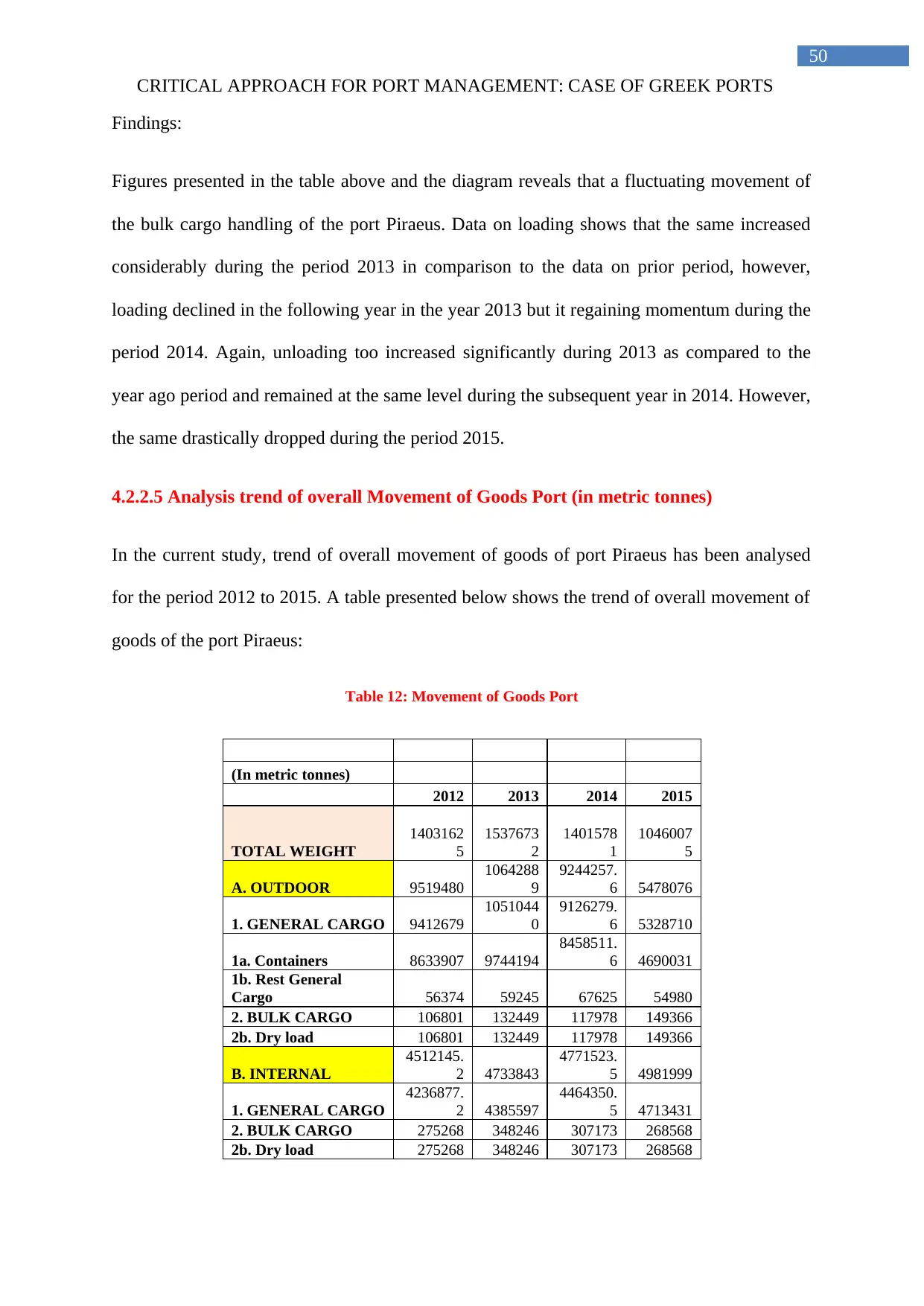
50
CRITICAL APPROACH FOR PORT MANAGEMENT: CASE OF GREEK PORTS
Findings:
Figures presented in the table above and the diagram reveals that a fluctuating movement of
the bulk cargo handling of the port Piraeus. Data on loading shows that the same increased
considerably during the period 2013 in comparison to the data on prior period, however,
loading declined in the following year in the year 2013 but it regaining momentum during the
period 2014. Again, unloading too increased significantly during 2013 as compared to the
year ago period and remained at the same level during the subsequent year in 2014. However,
the same drastically dropped during the period 2015.
4.2.2.5 Analysis trend of overall Movement of Goods Port (in metric tonnes)
In the current study, trend of overall movement of goods of port Piraeus has been analysed
for the period 2012 to 2015. A table presented below shows the trend of overall movement of
goods of the port Piraeus:
Table 12: Movement of Goods Port
(In metric tonnes)
2012 2013 2014 2015
TOTAL WEIGHT
1403162
5
1537673
2
1401578
1
1046007
5
A. OUTDOOR 9519480
1064288
9
9244257.
6 5478076
1. GENERAL CARGO 9412679
1051044
0
9126279.
6 5328710
1a. Containers 8633907 9744194
8458511.
6 4690031
1b. Rest General
Cargo 56374 59245 67625 54980
2. BULK CARGO 106801 132449 117978 149366
2b. Dry load 106801 132449 117978 149366
B. INTERNAL
4512145.
2 4733843
4771523.
5 4981999
1. GENERAL CARGO
4236877.
2 4385597
4464350.
5 4713431
2. BULK CARGO 275268 348246 307173 268568
2b. Dry load 275268 348246 307173 268568
CRITICAL APPROACH FOR PORT MANAGEMENT: CASE OF GREEK PORTS
Findings:
Figures presented in the table above and the diagram reveals that a fluctuating movement of
the bulk cargo handling of the port Piraeus. Data on loading shows that the same increased
considerably during the period 2013 in comparison to the data on prior period, however,
loading declined in the following year in the year 2013 but it regaining momentum during the
period 2014. Again, unloading too increased significantly during 2013 as compared to the
year ago period and remained at the same level during the subsequent year in 2014. However,
the same drastically dropped during the period 2015.
4.2.2.5 Analysis trend of overall Movement of Goods Port (in metric tonnes)
In the current study, trend of overall movement of goods of port Piraeus has been analysed
for the period 2012 to 2015. A table presented below shows the trend of overall movement of
goods of the port Piraeus:
Table 12: Movement of Goods Port
(In metric tonnes)
2012 2013 2014 2015
TOTAL WEIGHT
1403162
5
1537673
2
1401578
1
1046007
5
A. OUTDOOR 9519480
1064288
9
9244257.
6 5478076
1. GENERAL CARGO 9412679
1051044
0
9126279.
6 5328710
1a. Containers 8633907 9744194
8458511.
6 4690031
1b. Rest General
Cargo 56374 59245 67625 54980
2. BULK CARGO 106801 132449 117978 149366
2b. Dry load 106801 132449 117978 149366
B. INTERNAL
4512145.
2 4733843
4771523.
5 4981999
1. GENERAL CARGO
4236877.
2 4385597
4464350.
5 4713431
2. BULK CARGO 275268 348246 307173 268568
2b. Dry load 275268 348246 307173 268568

51
CRITICAL APPROACH FOR PORT MANAGEMENT: CASE OF GREEK PORTS
2012 2013 2014 2015
0
2000000
4000000
6000000
8000000
10000000
12000000
14000000
16000000
18000000
Year wise Movement of goods port of Piraeus
A. OUTDOOR B. INTERNAL
Year
Cost
Figure 11: Movement of Goods Port
Findings
Based the table and diagram presented above it can be hereby mentioned that the outdoor
movement of the goods surged in 2013 on comparison to the year ago period. However, it
started decreasing sharply in the subsequent years. Therefore, on the whole it can be hereby
mentioned that outdoor movement taking into account general cargo and bulk cargo have
declined significantly during the period 2015. Again, the internal movement of goods also
reflect a fluctuating trend where initially the figure rose during 2013 in comparison to the
figure registered during 2012; however, the same dipped considerably in the following two
years that is during 2014 and 2015.
CRITICAL APPROACH FOR PORT MANAGEMENT: CASE OF GREEK PORTS
2012 2013 2014 2015
0
2000000
4000000
6000000
8000000
10000000
12000000
14000000
16000000
18000000
Year wise Movement of goods port of Piraeus
A. OUTDOOR B. INTERNAL
Year
Cost
Figure 11: Movement of Goods Port
Findings
Based the table and diagram presented above it can be hereby mentioned that the outdoor
movement of the goods surged in 2013 on comparison to the year ago period. However, it
started decreasing sharply in the subsequent years. Therefore, on the whole it can be hereby
mentioned that outdoor movement taking into account general cargo and bulk cargo have
declined significantly during the period 2015. Again, the internal movement of goods also
reflect a fluctuating trend where initially the figure rose during 2013 in comparison to the
figure registered during 2012; however, the same dipped considerably in the following two
years that is during 2014 and 2015.

52
CRITICAL APPROACH FOR PORT MANAGEMENT: CASE OF GREEK PORTS
4.2.2.6 Trend Analysis of operations of port of Thessaloniki
In the current study, trend of container terminal of the port Thessaloniki has been analysed
for the period 2012 to 2015. A table presented below shows the trend of container terminal of
the port Piraeus:
Table 13: Container Terminal (Container Terminal) (IN TEUs1)
2012 2013 2014 2015
Import and Export 84,702 78,477 87,632 87,483
transhipment
2,33,19
8
2,43,83
3
2,62,36
8
2,64,26
8
Total 3,17,900 3,22,310 3,50,000 3,51,751
2012 2013 2014 2015
0
50,000
100,000
150,000
200,000
250,000
300,000
350,000
400,000
Year wise container terminal of Thessaloniki
Import and Export transshipment
Year
Cost
Figure 12: Container Terminal (Container Terminal)
Findings:
As per the data presented above, it can be hereby mentioned that imports and exports of the
container terminal of the port has increased during the period 2012 to 2015 with a drop only
during the year 2013. The import and export figure was registered to be 84702 in 2012,
CRITICAL APPROACH FOR PORT MANAGEMENT: CASE OF GREEK PORTS
4.2.2.6 Trend Analysis of operations of port of Thessaloniki
In the current study, trend of container terminal of the port Thessaloniki has been analysed
for the period 2012 to 2015. A table presented below shows the trend of container terminal of
the port Piraeus:
Table 13: Container Terminal (Container Terminal) (IN TEUs1)
2012 2013 2014 2015
Import and Export 84,702 78,477 87,632 87,483
transhipment
2,33,19
8
2,43,83
3
2,62,36
8
2,64,26
8
Total 3,17,900 3,22,310 3,50,000 3,51,751
2012 2013 2014 2015
0
50,000
100,000
150,000
200,000
250,000
300,000
350,000
400,000
Year wise container terminal of Thessaloniki
Import and Export transshipment
Year
Cost
Figure 12: Container Terminal (Container Terminal)
Findings:
As per the data presented above, it can be hereby mentioned that imports and exports of the
container terminal of the port has increased during the period 2012 to 2015 with a drop only
during the year 2013. The import and export figure was registered to be 84702 in 2012,
Paraphrase This Document
Need a fresh take? Get an instant paraphrase of this document with our AI Paraphraser
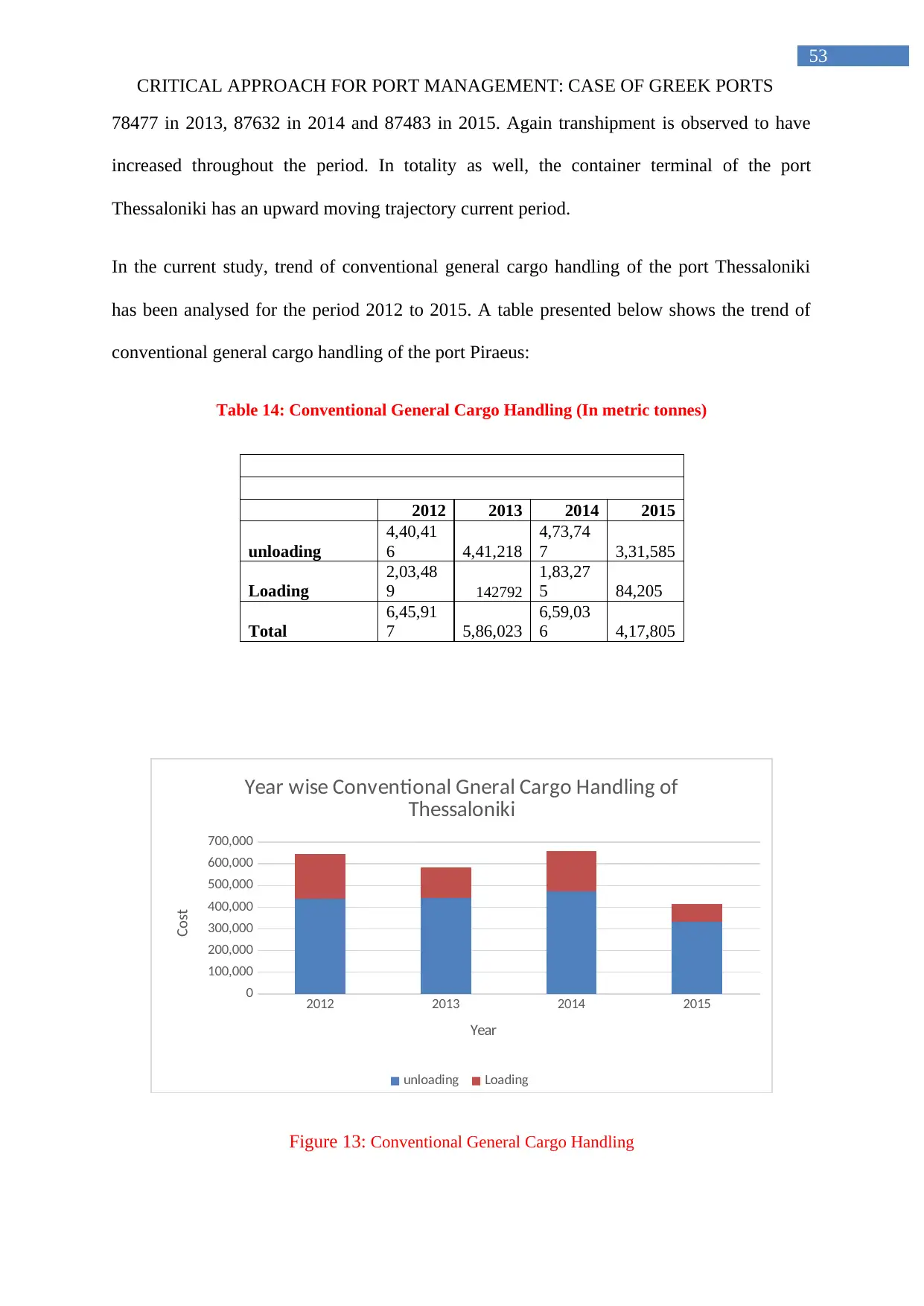
53
CRITICAL APPROACH FOR PORT MANAGEMENT: CASE OF GREEK PORTS
78477 in 2013, 87632 in 2014 and 87483 in 2015. Again transhipment is observed to have
increased throughout the period. In totality as well, the container terminal of the port
Thessaloniki has an upward moving trajectory current period.
In the current study, trend of conventional general cargo handling of the port Thessaloniki
has been analysed for the period 2012 to 2015. A table presented below shows the trend of
conventional general cargo handling of the port Piraeus:
Table 14: Conventional General Cargo Handling (In metric tonnes)
2012 2013 2014 2015
unloading
4,40,41
6 4,41,218
4,73,74
7 3,31,585
Loading
2,03,48
9 142792
1,83,27
5 84,205
Total
6,45,91
7 5,86,023
6,59,03
6 4,17,805
2012 2013 2014 2015
0
100,000
200,000
300,000
400,000
500,000
600,000
700,000
Year wise Conventional Gneral Cargo Handling of
Thessaloniki
unloading Loading
Year
Cost
Figure 13: Conventional General Cargo Handling
CRITICAL APPROACH FOR PORT MANAGEMENT: CASE OF GREEK PORTS
78477 in 2013, 87632 in 2014 and 87483 in 2015. Again transhipment is observed to have
increased throughout the period. In totality as well, the container terminal of the port
Thessaloniki has an upward moving trajectory current period.
In the current study, trend of conventional general cargo handling of the port Thessaloniki
has been analysed for the period 2012 to 2015. A table presented below shows the trend of
conventional general cargo handling of the port Piraeus:
Table 14: Conventional General Cargo Handling (In metric tonnes)
2012 2013 2014 2015
unloading
4,40,41
6 4,41,218
4,73,74
7 3,31,585
Loading
2,03,48
9 142792
1,83,27
5 84,205
Total
6,45,91
7 5,86,023
6,59,03
6 4,17,805
2012 2013 2014 2015
0
100,000
200,000
300,000
400,000
500,000
600,000
700,000
Year wise Conventional Gneral Cargo Handling of
Thessaloniki
unloading Loading
Year
Cost
Figure 13: Conventional General Cargo Handling
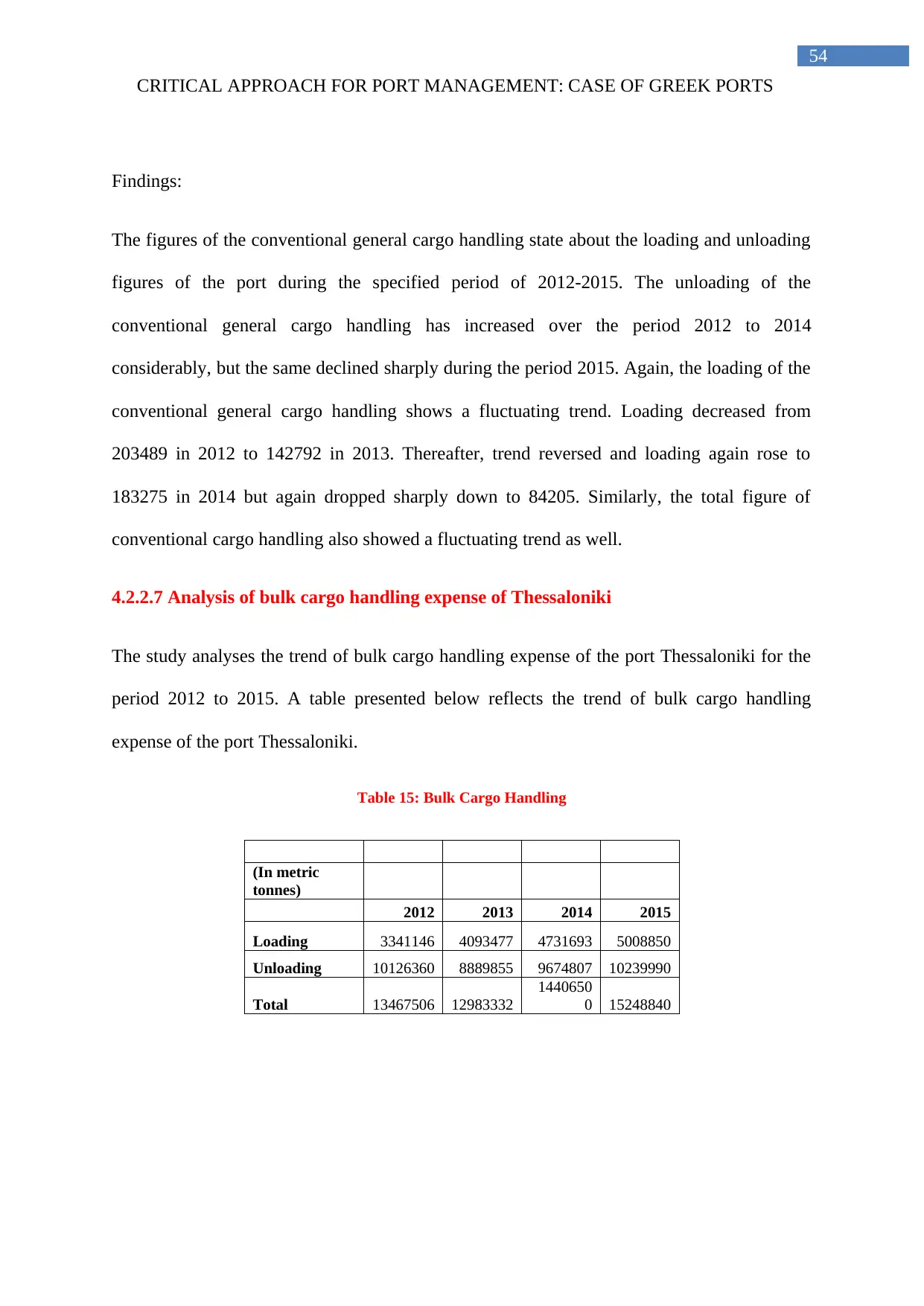
54
CRITICAL APPROACH FOR PORT MANAGEMENT: CASE OF GREEK PORTS
Findings:
The figures of the conventional general cargo handling state about the loading and unloading
figures of the port during the specified period of 2012-2015. The unloading of the
conventional general cargo handling has increased over the period 2012 to 2014
considerably, but the same declined sharply during the period 2015. Again, the loading of the
conventional general cargo handling shows a fluctuating trend. Loading decreased from
203489 in 2012 to 142792 in 2013. Thereafter, trend reversed and loading again rose to
183275 in 2014 but again dropped sharply down to 84205. Similarly, the total figure of
conventional cargo handling also showed a fluctuating trend as well.
4.2.2.7 Analysis of bulk cargo handling expense of Thessaloniki
The study analyses the trend of bulk cargo handling expense of the port Thessaloniki for the
period 2012 to 2015. A table presented below reflects the trend of bulk cargo handling
expense of the port Thessaloniki.
Table 15: Bulk Cargo Handling
(In metric
tonnes)
2012 2013 2014 2015
Loading 3341146 4093477 4731693 5008850
Unloading 10126360 8889855 9674807 10239990
Total 13467506 12983332
1440650
0 15248840
CRITICAL APPROACH FOR PORT MANAGEMENT: CASE OF GREEK PORTS
Findings:
The figures of the conventional general cargo handling state about the loading and unloading
figures of the port during the specified period of 2012-2015. The unloading of the
conventional general cargo handling has increased over the period 2012 to 2014
considerably, but the same declined sharply during the period 2015. Again, the loading of the
conventional general cargo handling shows a fluctuating trend. Loading decreased from
203489 in 2012 to 142792 in 2013. Thereafter, trend reversed and loading again rose to
183275 in 2014 but again dropped sharply down to 84205. Similarly, the total figure of
conventional cargo handling also showed a fluctuating trend as well.
4.2.2.7 Analysis of bulk cargo handling expense of Thessaloniki
The study analyses the trend of bulk cargo handling expense of the port Thessaloniki for the
period 2012 to 2015. A table presented below reflects the trend of bulk cargo handling
expense of the port Thessaloniki.
Table 15: Bulk Cargo Handling
(In metric
tonnes)
2012 2013 2014 2015
Loading 3341146 4093477 4731693 5008850
Unloading 10126360 8889855 9674807 10239990
Total 13467506 12983332
1440650
0 15248840
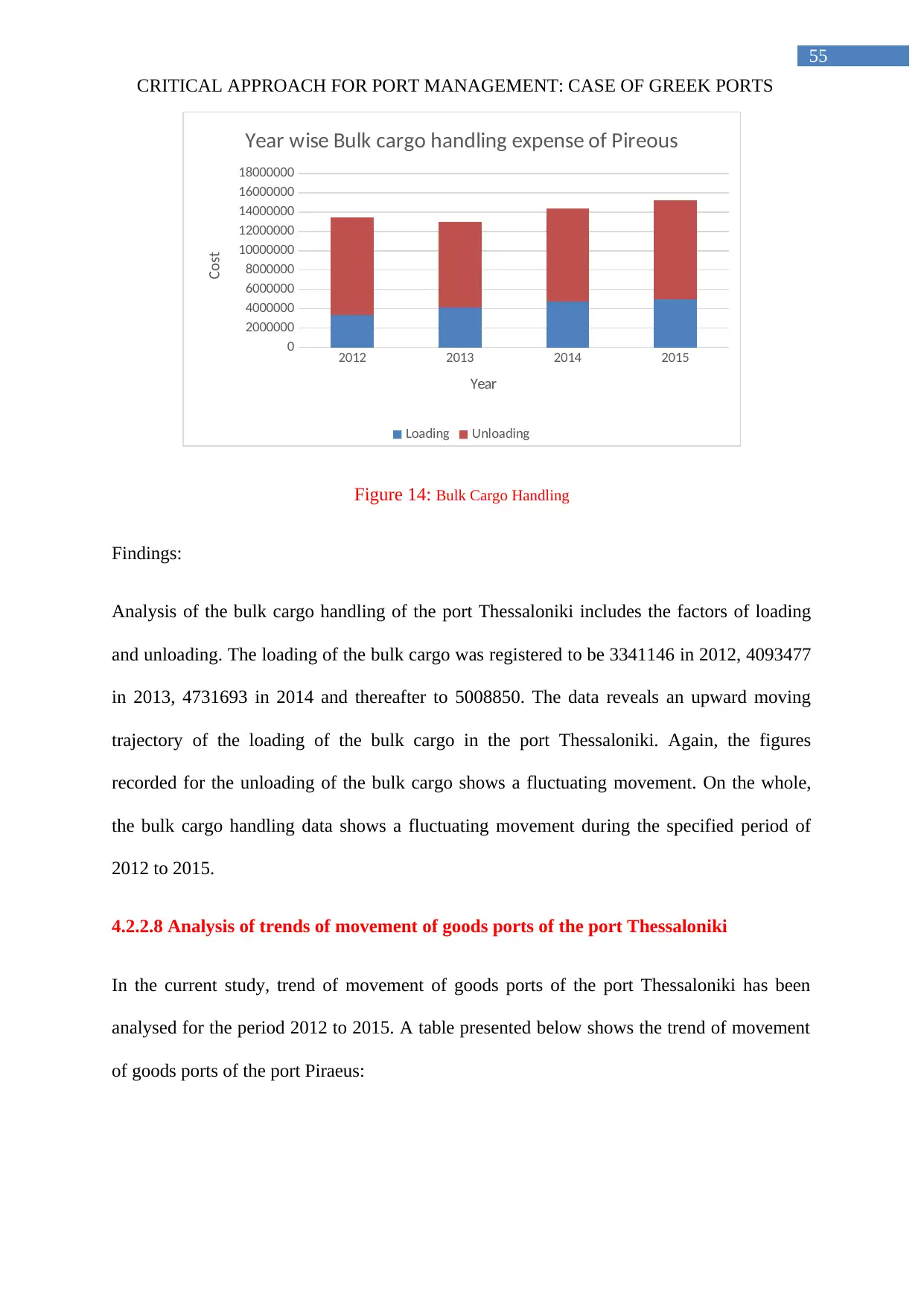
55
CRITICAL APPROACH FOR PORT MANAGEMENT: CASE OF GREEK PORTS
2012 2013 2014 2015
0
2000000
4000000
6000000
8000000
10000000
12000000
14000000
16000000
18000000
Year wise Bulk cargo handling expense of Pireous
Loading Unloading
Year
Cost
Figure 14: Bulk Cargo Handling
Findings:
Analysis of the bulk cargo handling of the port Thessaloniki includes the factors of loading
and unloading. The loading of the bulk cargo was registered to be 3341146 in 2012, 4093477
in 2013, 4731693 in 2014 and thereafter to 5008850. The data reveals an upward moving
trajectory of the loading of the bulk cargo in the port Thessaloniki. Again, the figures
recorded for the unloading of the bulk cargo shows a fluctuating movement. On the whole,
the bulk cargo handling data shows a fluctuating movement during the specified period of
2012 to 2015.
4.2.2.8 Analysis of trends of movement of goods ports of the port Thessaloniki
In the current study, trend of movement of goods ports of the port Thessaloniki has been
analysed for the period 2012 to 2015. A table presented below shows the trend of movement
of goods ports of the port Piraeus:
CRITICAL APPROACH FOR PORT MANAGEMENT: CASE OF GREEK PORTS
2012 2013 2014 2015
0
2000000
4000000
6000000
8000000
10000000
12000000
14000000
16000000
18000000
Year wise Bulk cargo handling expense of Pireous
Loading Unloading
Year
Cost
Figure 14: Bulk Cargo Handling
Findings:
Analysis of the bulk cargo handling of the port Thessaloniki includes the factors of loading
and unloading. The loading of the bulk cargo was registered to be 3341146 in 2012, 4093477
in 2013, 4731693 in 2014 and thereafter to 5008850. The data reveals an upward moving
trajectory of the loading of the bulk cargo in the port Thessaloniki. Again, the figures
recorded for the unloading of the bulk cargo shows a fluctuating movement. On the whole,
the bulk cargo handling data shows a fluctuating movement during the specified period of
2012 to 2015.
4.2.2.8 Analysis of trends of movement of goods ports of the port Thessaloniki
In the current study, trend of movement of goods ports of the port Thessaloniki has been
analysed for the period 2012 to 2015. A table presented below shows the trend of movement
of goods ports of the port Piraeus:
Secure Best Marks with AI Grader
Need help grading? Try our AI Grader for instant feedback on your assignments.
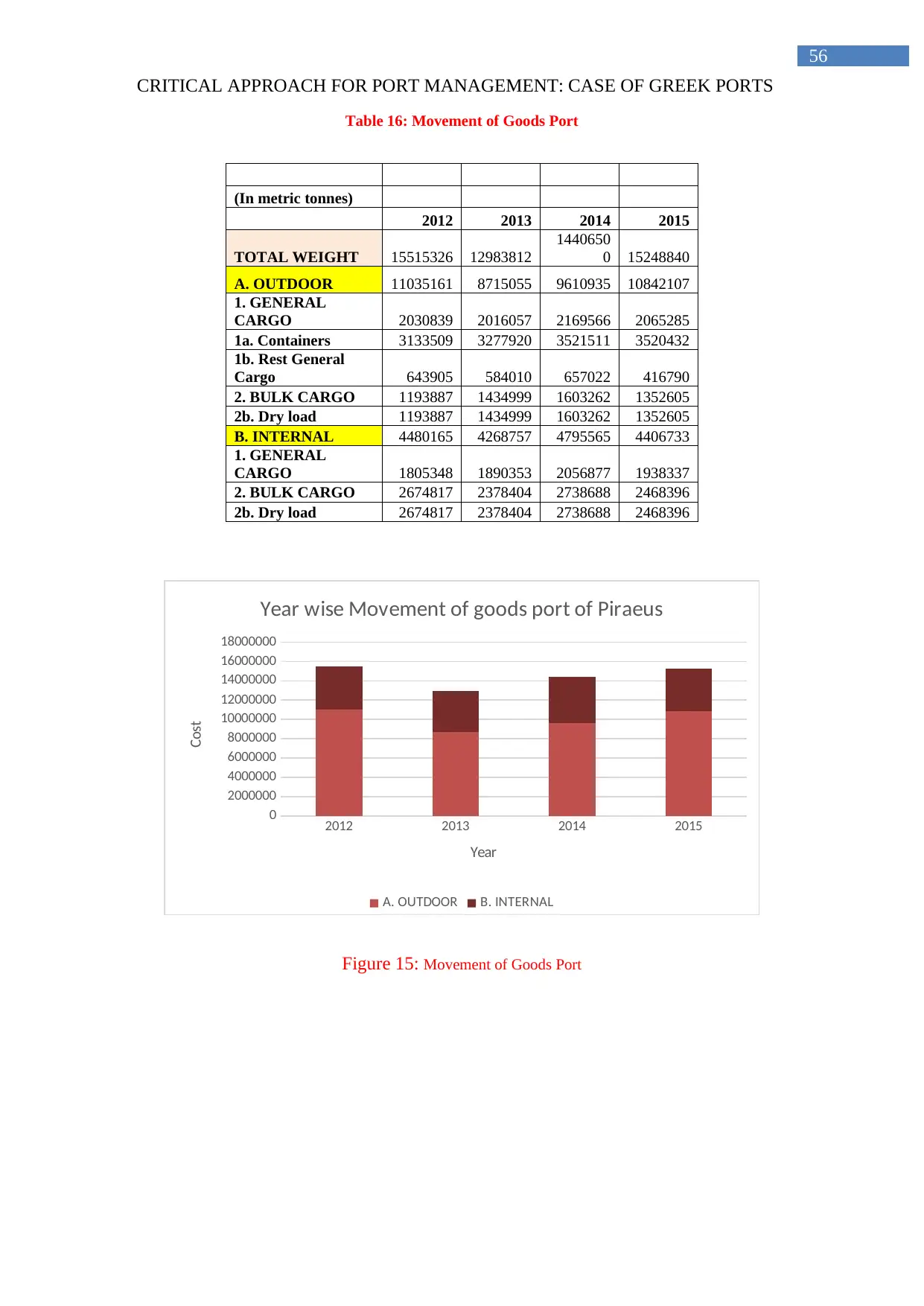
56
CRITICAL APPROACH FOR PORT MANAGEMENT: CASE OF GREEK PORTS
Table 16: Movement of Goods Port
(In metric tonnes)
2012 2013 2014 2015
TOTAL WEIGHT 15515326 12983812
1440650
0 15248840
A. OUTDOOR 11035161 8715055 9610935 10842107
1. GENERAL
CARGO 2030839 2016057 2169566 2065285
1a. Containers 3133509 3277920 3521511 3520432
1b. Rest General
Cargo 643905 584010 657022 416790
2. BULK CARGO 1193887 1434999 1603262 1352605
2b. Dry load 1193887 1434999 1603262 1352605
B. INTERNAL 4480165 4268757 4795565 4406733
1. GENERAL
CARGO 1805348 1890353 2056877 1938337
2. BULK CARGO 2674817 2378404 2738688 2468396
2b. Dry load 2674817 2378404 2738688 2468396
2012 2013 2014 2015
0
2000000
4000000
6000000
8000000
10000000
12000000
14000000
16000000
18000000
Year wise Movement of goods port of Piraeus
A. OUTDOOR B. INTERNAL
Year
Cost
Figure 15: Movement of Goods Port
CRITICAL APPROACH FOR PORT MANAGEMENT: CASE OF GREEK PORTS
Table 16: Movement of Goods Port
(In metric tonnes)
2012 2013 2014 2015
TOTAL WEIGHT 15515326 12983812
1440650
0 15248840
A. OUTDOOR 11035161 8715055 9610935 10842107
1. GENERAL
CARGO 2030839 2016057 2169566 2065285
1a. Containers 3133509 3277920 3521511 3520432
1b. Rest General
Cargo 643905 584010 657022 416790
2. BULK CARGO 1193887 1434999 1603262 1352605
2b. Dry load 1193887 1434999 1603262 1352605
B. INTERNAL 4480165 4268757 4795565 4406733
1. GENERAL
CARGO 1805348 1890353 2056877 1938337
2. BULK CARGO 2674817 2378404 2738688 2468396
2b. Dry load 2674817 2378404 2738688 2468396
2012 2013 2014 2015
0
2000000
4000000
6000000
8000000
10000000
12000000
14000000
16000000
18000000
Year wise Movement of goods port of Piraeus
A. OUTDOOR B. INTERNAL
Year
Cost
Figure 15: Movement of Goods Port

57
CRITICAL APPROACH FOR PORT MANAGEMENT: CASE OF GREEK PORTS
Findings:
The table and the diagram mentioned above shows the movement of goods port of the port
Thessaloniki. The movement of the goods port entails outdoor and internal movement of
goods. The outdoor facet of this movement decreased considerably from 11035161 in 2012 to
875055 in 2012. However, the same again increased to 9610935 in 2014 and to 10842107 in
2015. In essence, the outdoor movement of goods can be said to be fluctuating over the
specified period. Similarly, internal facet too seems to have haphazard movement where the
same decreased in 2013 to 428757 in 2013 in comparison to 2012. However, the same turned
round and showed an upward movement during 2014, but again drops to 4406733 in 2015.
4.3 Comparative Analysis of the port of Piraeus and Thessaloniki
For the purpose of carrying out a comparative analysis of the operations of the port of Piraeus
and Thessaloniki, (a t test: paired two sample for mean) has been conducted. The hypotheses
developed are tested for analysing the case:
The current study intends to test whether there is any significant difference between average
of the container terminal for the ports of Piraeus and Thessaloniki. The hypotheses developed
for this purpose is as mentioned below:
H01: There exists no variance between the average of the container terminal of the port
Piraeus and Thessaloniki (that is to say, Average of Container Terminal (Piraues)-
Average of Container Terminal of Thessaloniki=0)
Against the alternative Hypotheses
Alternative H: The average of the container terminal (Piraeus) is greater than that of
Thessaloniki
CRITICAL APPROACH FOR PORT MANAGEMENT: CASE OF GREEK PORTS
Findings:
The table and the diagram mentioned above shows the movement of goods port of the port
Thessaloniki. The movement of the goods port entails outdoor and internal movement of
goods. The outdoor facet of this movement decreased considerably from 11035161 in 2012 to
875055 in 2012. However, the same again increased to 9610935 in 2014 and to 10842107 in
2015. In essence, the outdoor movement of goods can be said to be fluctuating over the
specified period. Similarly, internal facet too seems to have haphazard movement where the
same decreased in 2013 to 428757 in 2013 in comparison to 2012. However, the same turned
round and showed an upward movement during 2014, but again drops to 4406733 in 2015.
4.3 Comparative Analysis of the port of Piraeus and Thessaloniki
For the purpose of carrying out a comparative analysis of the operations of the port of Piraeus
and Thessaloniki, (a t test: paired two sample for mean) has been conducted. The hypotheses
developed are tested for analysing the case:
The current study intends to test whether there is any significant difference between average
of the container terminal for the ports of Piraeus and Thessaloniki. The hypotheses developed
for this purpose is as mentioned below:
H01: There exists no variance between the average of the container terminal of the port
Piraeus and Thessaloniki (that is to say, Average of Container Terminal (Piraues)-
Average of Container Terminal of Thessaloniki=0)
Against the alternative Hypotheses
Alternative H: The average of the container terminal (Piraeus) is greater than that of
Thessaloniki
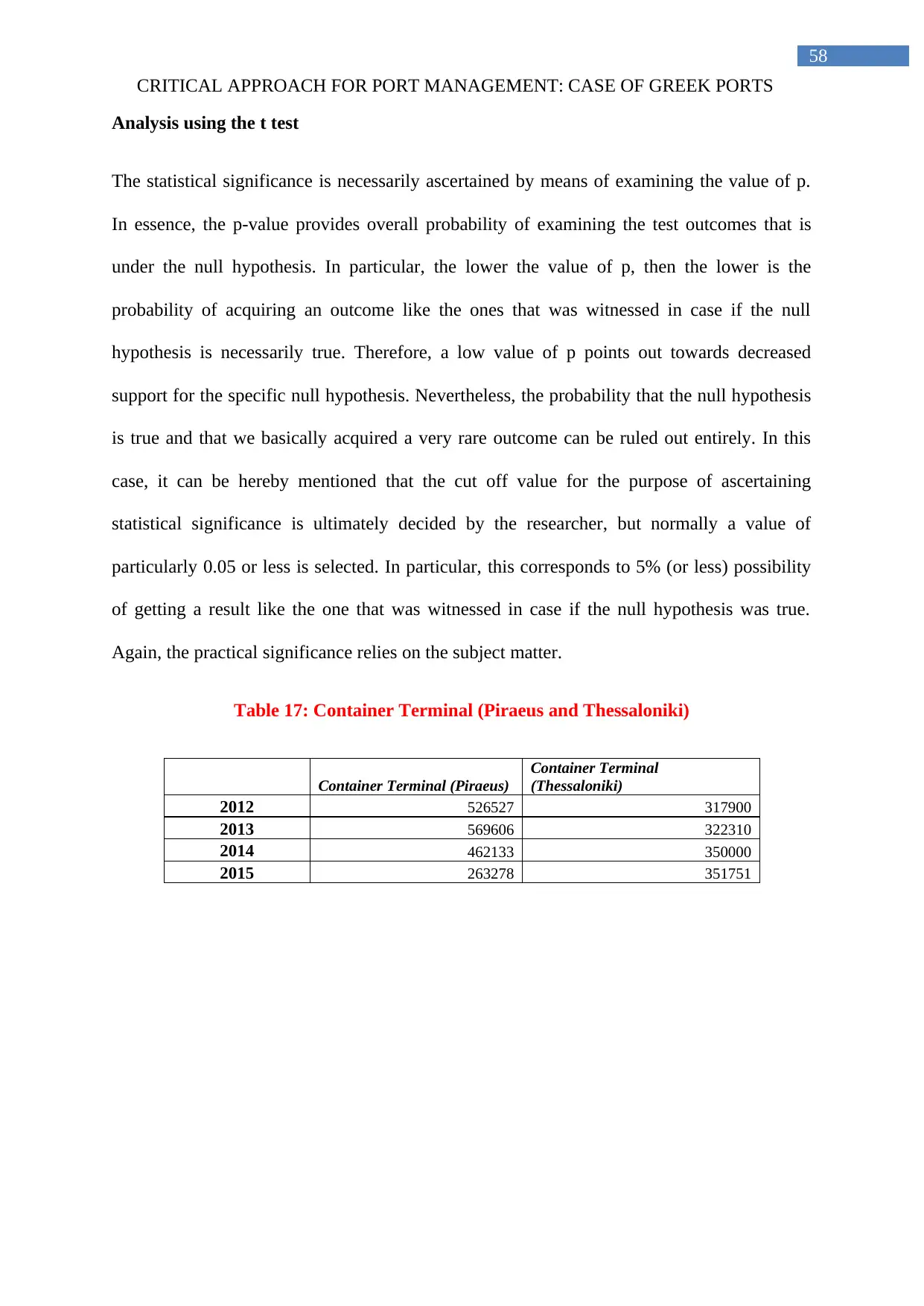
58
CRITICAL APPROACH FOR PORT MANAGEMENT: CASE OF GREEK PORTS
Analysis using the t test
The statistical significance is necessarily ascertained by means of examining the value of p.
In essence, the p-value provides overall probability of examining the test outcomes that is
under the null hypothesis. In particular, the lower the value of p, then the lower is the
probability of acquiring an outcome like the ones that was witnessed in case if the null
hypothesis is necessarily true. Therefore, a low value of p points out towards decreased
support for the specific null hypothesis. Nevertheless, the probability that the null hypothesis
is true and that we basically acquired a very rare outcome can be ruled out entirely. In this
case, it can be hereby mentioned that the cut off value for the purpose of ascertaining
statistical significance is ultimately decided by the researcher, but normally a value of
particularly 0.05 or less is selected. In particular, this corresponds to 5% (or less) possibility
of getting a result like the one that was witnessed in case if the null hypothesis was true.
Again, the practical significance relies on the subject matter.
Table 17: Container Terminal (Piraeus and Thessaloniki)
Container Terminal (Piraeus)
Container Terminal
(Thessaloniki)
2012 526527 317900
2013 569606 322310
2014 462133 350000
2015 263278 351751
CRITICAL APPROACH FOR PORT MANAGEMENT: CASE OF GREEK PORTS
Analysis using the t test
The statistical significance is necessarily ascertained by means of examining the value of p.
In essence, the p-value provides overall probability of examining the test outcomes that is
under the null hypothesis. In particular, the lower the value of p, then the lower is the
probability of acquiring an outcome like the ones that was witnessed in case if the null
hypothesis is necessarily true. Therefore, a low value of p points out towards decreased
support for the specific null hypothesis. Nevertheless, the probability that the null hypothesis
is true and that we basically acquired a very rare outcome can be ruled out entirely. In this
case, it can be hereby mentioned that the cut off value for the purpose of ascertaining
statistical significance is ultimately decided by the researcher, but normally a value of
particularly 0.05 or less is selected. In particular, this corresponds to 5% (or less) possibility
of getting a result like the one that was witnessed in case if the null hypothesis was true.
Again, the practical significance relies on the subject matter.
Table 17: Container Terminal (Piraeus and Thessaloniki)
Container Terminal (Piraeus)
Container Terminal
(Thessaloniki)
2012 526527 317900
2013 569606 322310
2014 462133 350000
2015 263278 351751
Paraphrase This Document
Need a fresh take? Get an instant paraphrase of this document with our AI Paraphraser
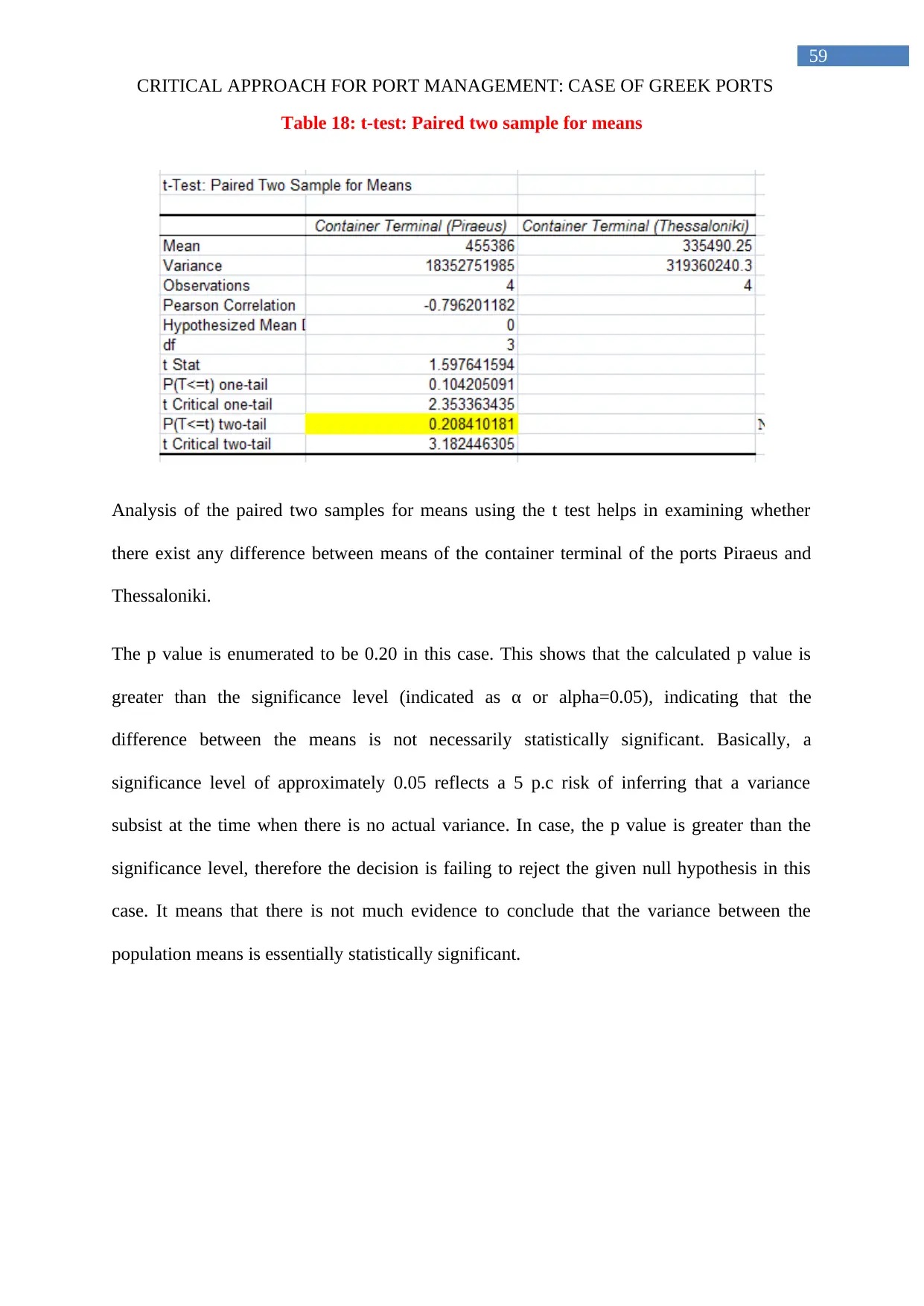
59
CRITICAL APPROACH FOR PORT MANAGEMENT: CASE OF GREEK PORTS
Table 18: t-test: Paired two sample for means
Analysis of the paired two samples for means using the t test helps in examining whether
there exist any difference between means of the container terminal of the ports Piraeus and
Thessaloniki.
The p value is enumerated to be 0.20 in this case. This shows that the calculated p value is
greater than the significance level (indicated as α or alpha=0.05), indicating that the
difference between the means is not necessarily statistically significant. Basically, a
significance level of approximately 0.05 reflects a 5 p.c risk of inferring that a variance
subsist at the time when there is no actual variance. In case, the p value is greater than the
significance level, therefore the decision is failing to reject the given null hypothesis in this
case. It means that there is not much evidence to conclude that the variance between the
population means is essentially statistically significant.
CRITICAL APPROACH FOR PORT MANAGEMENT: CASE OF GREEK PORTS
Table 18: t-test: Paired two sample for means
Analysis of the paired two samples for means using the t test helps in examining whether
there exist any difference between means of the container terminal of the ports Piraeus and
Thessaloniki.
The p value is enumerated to be 0.20 in this case. This shows that the calculated p value is
greater than the significance level (indicated as α or alpha=0.05), indicating that the
difference between the means is not necessarily statistically significant. Basically, a
significance level of approximately 0.05 reflects a 5 p.c risk of inferring that a variance
subsist at the time when there is no actual variance. In case, the p value is greater than the
significance level, therefore the decision is failing to reject the given null hypothesis in this
case. It means that there is not much evidence to conclude that the variance between the
population means is essentially statistically significant.
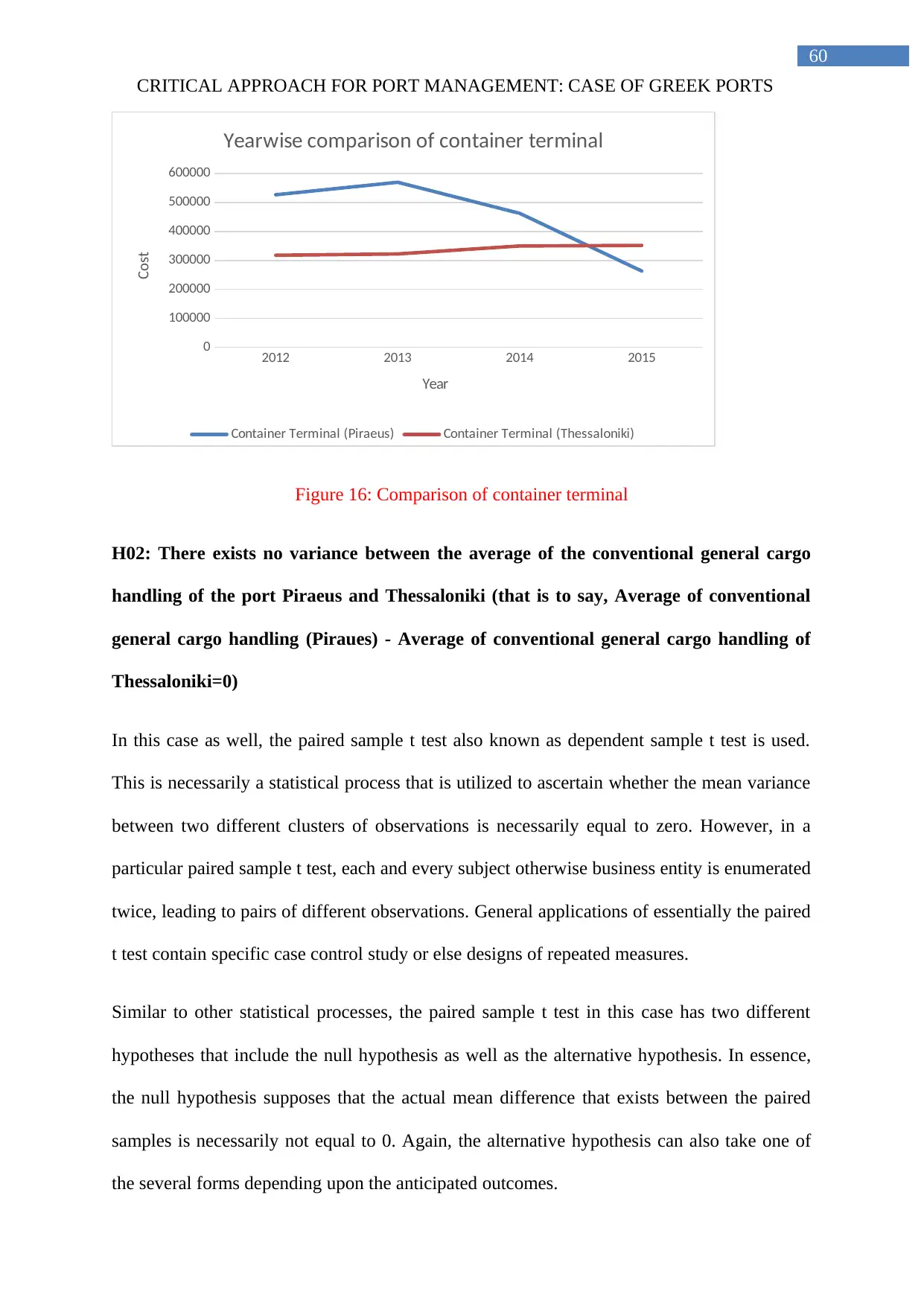
60
CRITICAL APPROACH FOR PORT MANAGEMENT: CASE OF GREEK PORTS
2012 2013 2014 2015
0
100000
200000
300000
400000
500000
600000
Yearwise comparison of container terminal
Container Terminal (Piraeus) Container Terminal (Thessaloniki)
Year
Cost
Figure 16: Comparison of container terminal
H02: There exists no variance between the average of the conventional general cargo
handling of the port Piraeus and Thessaloniki (that is to say, Average of conventional
general cargo handling (Piraues) - Average of conventional general cargo handling of
Thessaloniki=0)
In this case as well, the paired sample t test also known as dependent sample t test is used.
This is necessarily a statistical process that is utilized to ascertain whether the mean variance
between two different clusters of observations is necessarily equal to zero. However, in a
particular paired sample t test, each and every subject otherwise business entity is enumerated
twice, leading to pairs of different observations. General applications of essentially the paired
t test contain specific case control study or else designs of repeated measures.
Similar to other statistical processes, the paired sample t test in this case has two different
hypotheses that include the null hypothesis as well as the alternative hypothesis. In essence,
the null hypothesis supposes that the actual mean difference that exists between the paired
samples is necessarily not equal to 0. Again, the alternative hypothesis can also take one of
the several forms depending upon the anticipated outcomes.
CRITICAL APPROACH FOR PORT MANAGEMENT: CASE OF GREEK PORTS
2012 2013 2014 2015
0
100000
200000
300000
400000
500000
600000
Yearwise comparison of container terminal
Container Terminal (Piraeus) Container Terminal (Thessaloniki)
Year
Cost
Figure 16: Comparison of container terminal
H02: There exists no variance between the average of the conventional general cargo
handling of the port Piraeus and Thessaloniki (that is to say, Average of conventional
general cargo handling (Piraues) - Average of conventional general cargo handling of
Thessaloniki=0)
In this case as well, the paired sample t test also known as dependent sample t test is used.
This is necessarily a statistical process that is utilized to ascertain whether the mean variance
between two different clusters of observations is necessarily equal to zero. However, in a
particular paired sample t test, each and every subject otherwise business entity is enumerated
twice, leading to pairs of different observations. General applications of essentially the paired
t test contain specific case control study or else designs of repeated measures.
Similar to other statistical processes, the paired sample t test in this case has two different
hypotheses that include the null hypothesis as well as the alternative hypothesis. In essence,
the null hypothesis supposes that the actual mean difference that exists between the paired
samples is necessarily not equal to 0. Again, the alternative hypothesis can also take one of
the several forms depending upon the anticipated outcomes.

61
CRITICAL APPROACH FOR PORT MANAGEMENT: CASE OF GREEK PORTS
In case of analysing the average of the conventional general cargo handling, the p value is
calculated to be 0.00011. Here, in a bid to ascertain whether the difference between mean is
statistically significant, we compare the calculated p value to particularly the significance
value. Essentially, the significance level (represented as α or alpha) of 0.05 necessarily works
well. In this case, the calculated p value is said to be less than the α, therefore, it can be
hereby stated that the difference or variance between the means is necessarily statistically
significant. As the p value is lower than the significance level, then in that case the decision
to reject the current null hypothesis can be undertaken. It can be hereby inferred that the
variance between the means is necessarily statistically significant. In this case, it is necessary
to utilize specialised know-how to ascertain whether the variance is necessarily significant.
Thus, it can be hereby stated that there exists statistically significant difference between the
average of the conventional general cargo of the ports of Piraeus and Thessaloniki.
Table 19: Conventional General Cargo Handling (Piraeus and Thessaloniki)
Conventional General Cargo
Handling (Piraeus)
Conventional General Cargo
Handling (Thessaloniki)
2012 4293251 645917
2013 4444842.33 586023
2014 4531975.484 659036
2015 4768411 417805
CRITICAL APPROACH FOR PORT MANAGEMENT: CASE OF GREEK PORTS
In case of analysing the average of the conventional general cargo handling, the p value is
calculated to be 0.00011. Here, in a bid to ascertain whether the difference between mean is
statistically significant, we compare the calculated p value to particularly the significance
value. Essentially, the significance level (represented as α or alpha) of 0.05 necessarily works
well. In this case, the calculated p value is said to be less than the α, therefore, it can be
hereby stated that the difference or variance between the means is necessarily statistically
significant. As the p value is lower than the significance level, then in that case the decision
to reject the current null hypothesis can be undertaken. It can be hereby inferred that the
variance between the means is necessarily statistically significant. In this case, it is necessary
to utilize specialised know-how to ascertain whether the variance is necessarily significant.
Thus, it can be hereby stated that there exists statistically significant difference between the
average of the conventional general cargo of the ports of Piraeus and Thessaloniki.
Table 19: Conventional General Cargo Handling (Piraeus and Thessaloniki)
Conventional General Cargo
Handling (Piraeus)
Conventional General Cargo
Handling (Thessaloniki)
2012 4293251 645917
2013 4444842.33 586023
2014 4531975.484 659036
2015 4768411 417805
Secure Best Marks with AI Grader
Need help grading? Try our AI Grader for instant feedback on your assignments.
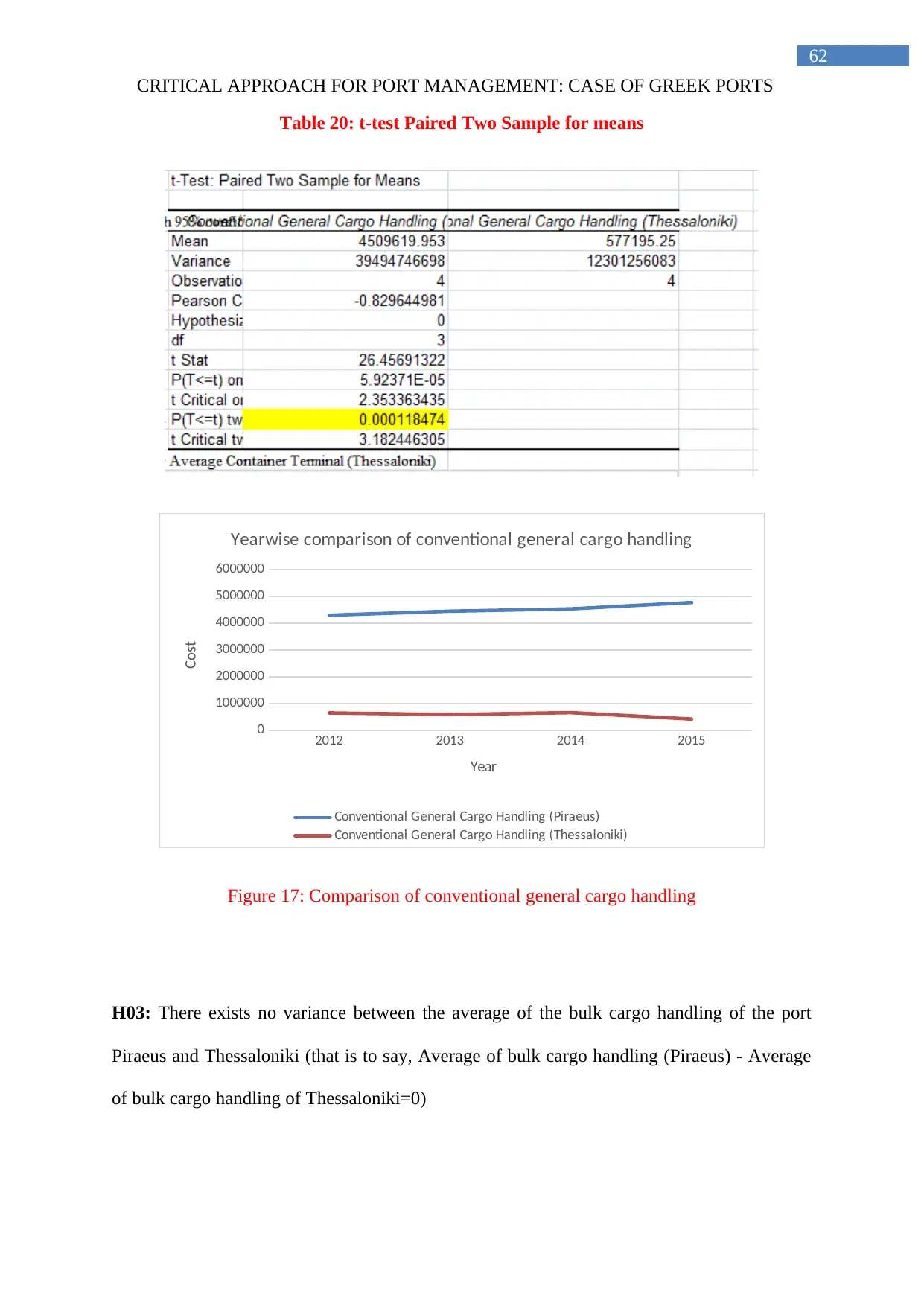
62
CRITICAL APPROACH FOR PORT MANAGEMENT: CASE OF GREEK PORTS
Table 20: t-test Paired Two Sample for means
2012 2013 2014 2015
0
1000000
2000000
3000000
4000000
5000000
6000000
Yearwise comparison of conventional general cargo handling
Conventional General Cargo Handling (Piraeus)
Conventional General Cargo Handling (Thessaloniki)
Year
Cost
Figure 17: Comparison of conventional general cargo handling
H03: There exists no variance between the average of the bulk cargo handling of the port
Piraeus and Thessaloniki (that is to say, Average of bulk cargo handling (Piraeus) - Average
of bulk cargo handling of Thessaloniki=0)
CRITICAL APPROACH FOR PORT MANAGEMENT: CASE OF GREEK PORTS
Table 20: t-test Paired Two Sample for means
2012 2013 2014 2015
0
1000000
2000000
3000000
4000000
5000000
6000000
Yearwise comparison of conventional general cargo handling
Conventional General Cargo Handling (Piraeus)
Conventional General Cargo Handling (Thessaloniki)
Year
Cost
Figure 17: Comparison of conventional general cargo handling
H03: There exists no variance between the average of the bulk cargo handling of the port
Piraeus and Thessaloniki (that is to say, Average of bulk cargo handling (Piraeus) - Average
of bulk cargo handling of Thessaloniki=0)
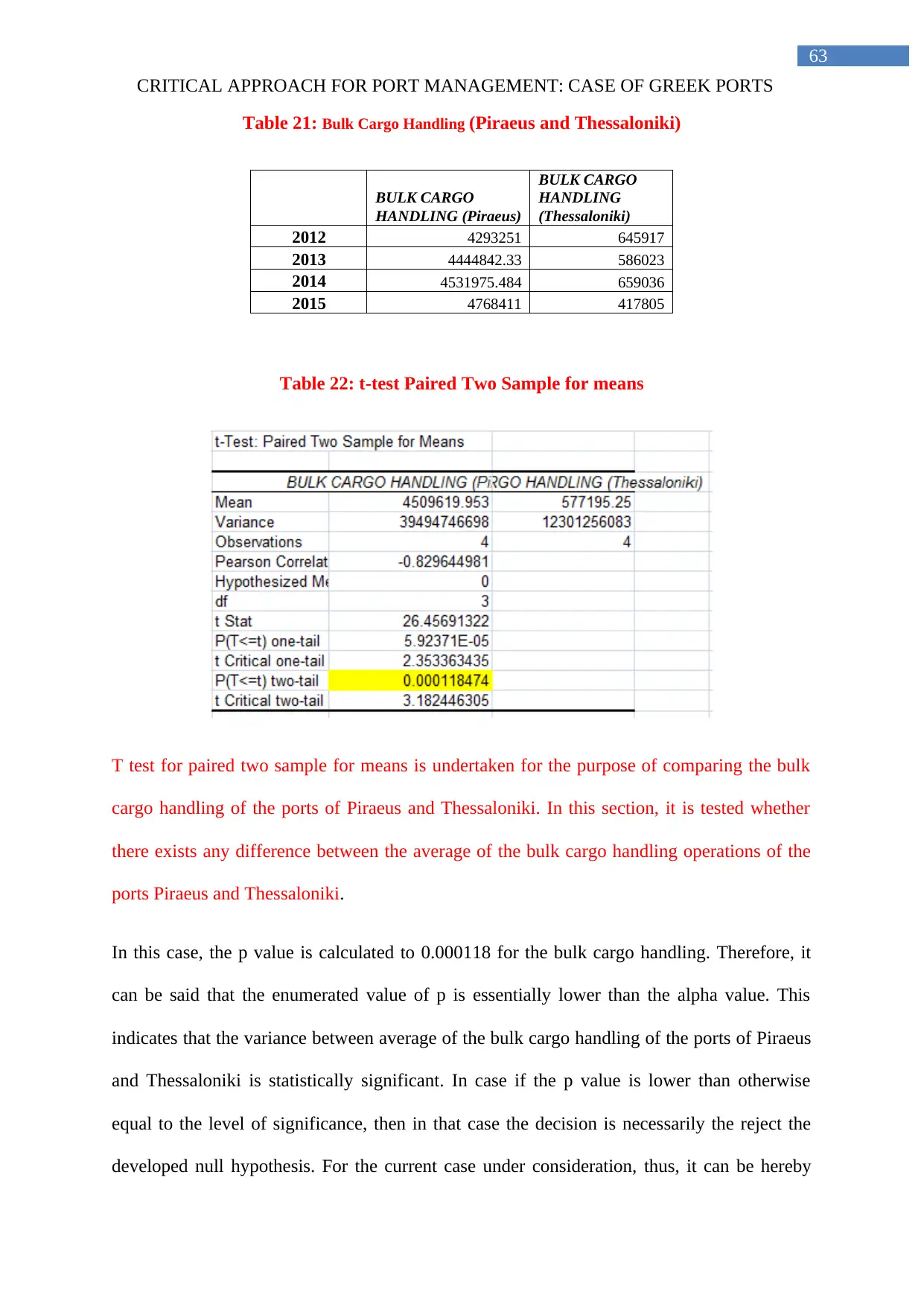
63
CRITICAL APPROACH FOR PORT MANAGEMENT: CASE OF GREEK PORTS
Table 21: Bulk Cargo Handling (Piraeus and Thessaloniki)
BULK CARGO
HANDLING (Piraeus)
BULK CARGO
HANDLING
(Thessaloniki)
2012 4293251 645917
2013 4444842.33 586023
2014 4531975.484 659036
2015 4768411 417805
Table 22: t-test Paired Two Sample for means
T test for paired two sample for means is undertaken for the purpose of comparing the bulk
cargo handling of the ports of Piraeus and Thessaloniki. In this section, it is tested whether
there exists any difference between the average of the bulk cargo handling operations of the
ports Piraeus and Thessaloniki.
In this case, the p value is calculated to 0.000118 for the bulk cargo handling. Therefore, it
can be said that the enumerated value of p is essentially lower than the alpha value. This
indicates that the variance between average of the bulk cargo handling of the ports of Piraeus
and Thessaloniki is statistically significant. In case if the p value is lower than otherwise
equal to the level of significance, then in that case the decision is necessarily the reject the
developed null hypothesis. For the current case under consideration, thus, it can be hereby
CRITICAL APPROACH FOR PORT MANAGEMENT: CASE OF GREEK PORTS
Table 21: Bulk Cargo Handling (Piraeus and Thessaloniki)
BULK CARGO
HANDLING (Piraeus)
BULK CARGO
HANDLING
(Thessaloniki)
2012 4293251 645917
2013 4444842.33 586023
2014 4531975.484 659036
2015 4768411 417805
Table 22: t-test Paired Two Sample for means
T test for paired two sample for means is undertaken for the purpose of comparing the bulk
cargo handling of the ports of Piraeus and Thessaloniki. In this section, it is tested whether
there exists any difference between the average of the bulk cargo handling operations of the
ports Piraeus and Thessaloniki.
In this case, the p value is calculated to 0.000118 for the bulk cargo handling. Therefore, it
can be said that the enumerated value of p is essentially lower than the alpha value. This
indicates that the variance between average of the bulk cargo handling of the ports of Piraeus
and Thessaloniki is statistically significant. In case if the p value is lower than otherwise
equal to the level of significance, then in that case the decision is necessarily the reject the
developed null hypothesis. For the current case under consideration, thus, it can be hereby
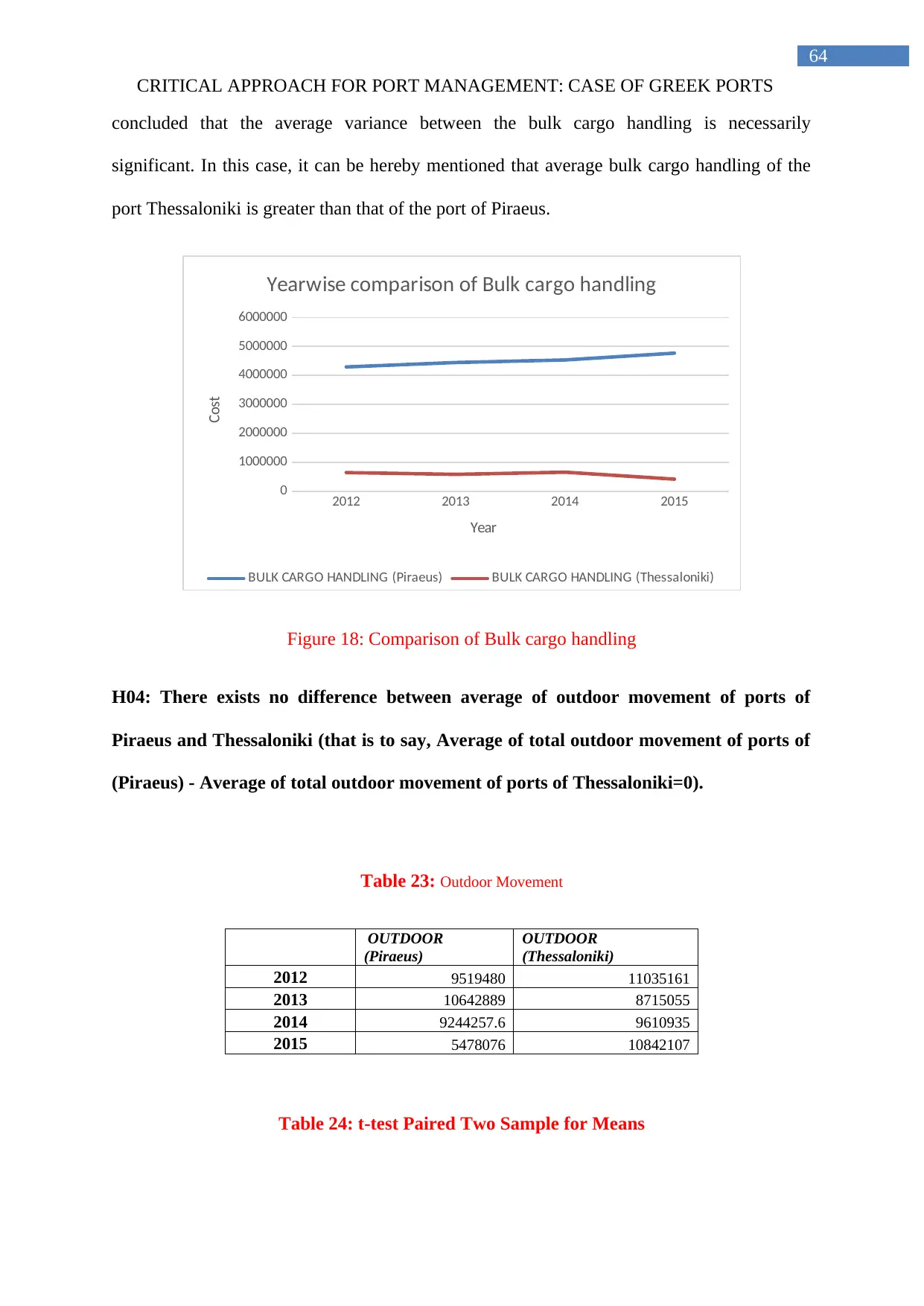
64
CRITICAL APPROACH FOR PORT MANAGEMENT: CASE OF GREEK PORTS
concluded that the average variance between the bulk cargo handling is necessarily
significant. In this case, it can be hereby mentioned that average bulk cargo handling of the
port Thessaloniki is greater than that of the port of Piraeus.
2012 2013 2014 2015
0
1000000
2000000
3000000
4000000
5000000
6000000
Yearwise comparison of Bulk cargo handling
BULK CARGO HANDLING (Piraeus) BULK CARGO HANDLING (Thessaloniki)
Year
Cost
Figure 18: Comparison of Bulk cargo handling
H04: There exists no difference between average of outdoor movement of ports of
Piraeus and Thessaloniki (that is to say, Average of total outdoor movement of ports of
(Piraeus) - Average of total outdoor movement of ports of Thessaloniki=0).
Table 23: Outdoor Movement
OUTDOOR
(Piraeus)
OUTDOOR
(Thessaloniki)
2012 9519480 11035161
2013 10642889 8715055
2014 9244257.6 9610935
2015 5478076 10842107
Table 24: t-test Paired Two Sample for Means
CRITICAL APPROACH FOR PORT MANAGEMENT: CASE OF GREEK PORTS
concluded that the average variance between the bulk cargo handling is necessarily
significant. In this case, it can be hereby mentioned that average bulk cargo handling of the
port Thessaloniki is greater than that of the port of Piraeus.
2012 2013 2014 2015
0
1000000
2000000
3000000
4000000
5000000
6000000
Yearwise comparison of Bulk cargo handling
BULK CARGO HANDLING (Piraeus) BULK CARGO HANDLING (Thessaloniki)
Year
Cost
Figure 18: Comparison of Bulk cargo handling
H04: There exists no difference between average of outdoor movement of ports of
Piraeus and Thessaloniki (that is to say, Average of total outdoor movement of ports of
(Piraeus) - Average of total outdoor movement of ports of Thessaloniki=0).
Table 23: Outdoor Movement
OUTDOOR
(Piraeus)
OUTDOOR
(Thessaloniki)
2012 9519480 11035161
2013 10642889 8715055
2014 9244257.6 9610935
2015 5478076 10842107
Table 24: t-test Paired Two Sample for Means
Paraphrase This Document
Need a fresh take? Get an instant paraphrase of this document with our AI Paraphraser

65
CRITICAL APPROACH FOR PORT MANAGEMENT: CASE OF GREEK PORTS
Analysis of the outdoor movement of the two different ports is carried out using the t test that
is the paired two samples for particularly for means. In this current section, it is examined
whether there subsist any variance between the mean of outdoor movements of the ports
Piraeus as well as Thessaloniki. For the purpose of ascertainment whether difference between
the average of outdoor movements of the ports is statistically significant, we analyse the
enumerated value of p to the level of significance. Based on this study, the level of
significance of 0.05 is said to be the best.
In this case, the p value is calculated to be 0.4470 that is greater than the level of significance.
In this case of comparison between outdoor movements, it can be hereby mentioned that the p
value is higher than the value of alpha (that is 0.05). This reflects that the difference between
the average of the outdoor movement of goods of the ports Piraeus and Thessaloniki is not
statistically significant that directs towards failure of rejection of the null hypothesis. As the p
value is greater than the level of significance, the choice is to fail to essentially reject the
specified null hypothesis in this case. Also, this indicates towards the fact that there is no
adequate evidence to substantiate the fact that the variance between the means is statistically
significant.
CRITICAL APPROACH FOR PORT MANAGEMENT: CASE OF GREEK PORTS
Analysis of the outdoor movement of the two different ports is carried out using the t test that
is the paired two samples for particularly for means. In this current section, it is examined
whether there subsist any variance between the mean of outdoor movements of the ports
Piraeus as well as Thessaloniki. For the purpose of ascertainment whether difference between
the average of outdoor movements of the ports is statistically significant, we analyse the
enumerated value of p to the level of significance. Based on this study, the level of
significance of 0.05 is said to be the best.
In this case, the p value is calculated to be 0.4470 that is greater than the level of significance.
In this case of comparison between outdoor movements, it can be hereby mentioned that the p
value is higher than the value of alpha (that is 0.05). This reflects that the difference between
the average of the outdoor movement of goods of the ports Piraeus and Thessaloniki is not
statistically significant that directs towards failure of rejection of the null hypothesis. As the p
value is greater than the level of significance, the choice is to fail to essentially reject the
specified null hypothesis in this case. Also, this indicates towards the fact that there is no
adequate evidence to substantiate the fact that the variance between the means is statistically
significant.

66
CRITICAL APPROACH FOR PORT MANAGEMENT: CASE OF GREEK PORTS
Key result: The null hypothesis states that mean difference between outdoor movement of
the ports Piraeus and Thessaloniki is equal to zero. As the p value is 0.4470, that is greater
than the level of significance of 0.05, then the decision is to failing to reject the specified null
hypothesis and infer that there is variance in the mean between outdoor movements of the
two ports.
2012 2013 2014 2015
0
2000000
4000000
6000000
8000000
10000000
12000000
Yearwise comparison of outdoor trading
OUTDOOR (Piraeus) OUTDOOR (Thessaloniki)
Year
Cost
Figure 19: Comparison of outdoor trading
H05: There exists no difference between average of internal movement of ports of
Piraeus and Thessaloniki (that is to say, Average of internal movement of ports of
(Piraeus) - Average of internal movement of ports of Thessaloniki=0).
CRITICAL APPROACH FOR PORT MANAGEMENT: CASE OF GREEK PORTS
Key result: The null hypothesis states that mean difference between outdoor movement of
the ports Piraeus and Thessaloniki is equal to zero. As the p value is 0.4470, that is greater
than the level of significance of 0.05, then the decision is to failing to reject the specified null
hypothesis and infer that there is variance in the mean between outdoor movements of the
two ports.
2012 2013 2014 2015
0
2000000
4000000
6000000
8000000
10000000
12000000
Yearwise comparison of outdoor trading
OUTDOOR (Piraeus) OUTDOOR (Thessaloniki)
Year
Cost
Figure 19: Comparison of outdoor trading
H05: There exists no difference between average of internal movement of ports of
Piraeus and Thessaloniki (that is to say, Average of internal movement of ports of
(Piraeus) - Average of internal movement of ports of Thessaloniki=0).
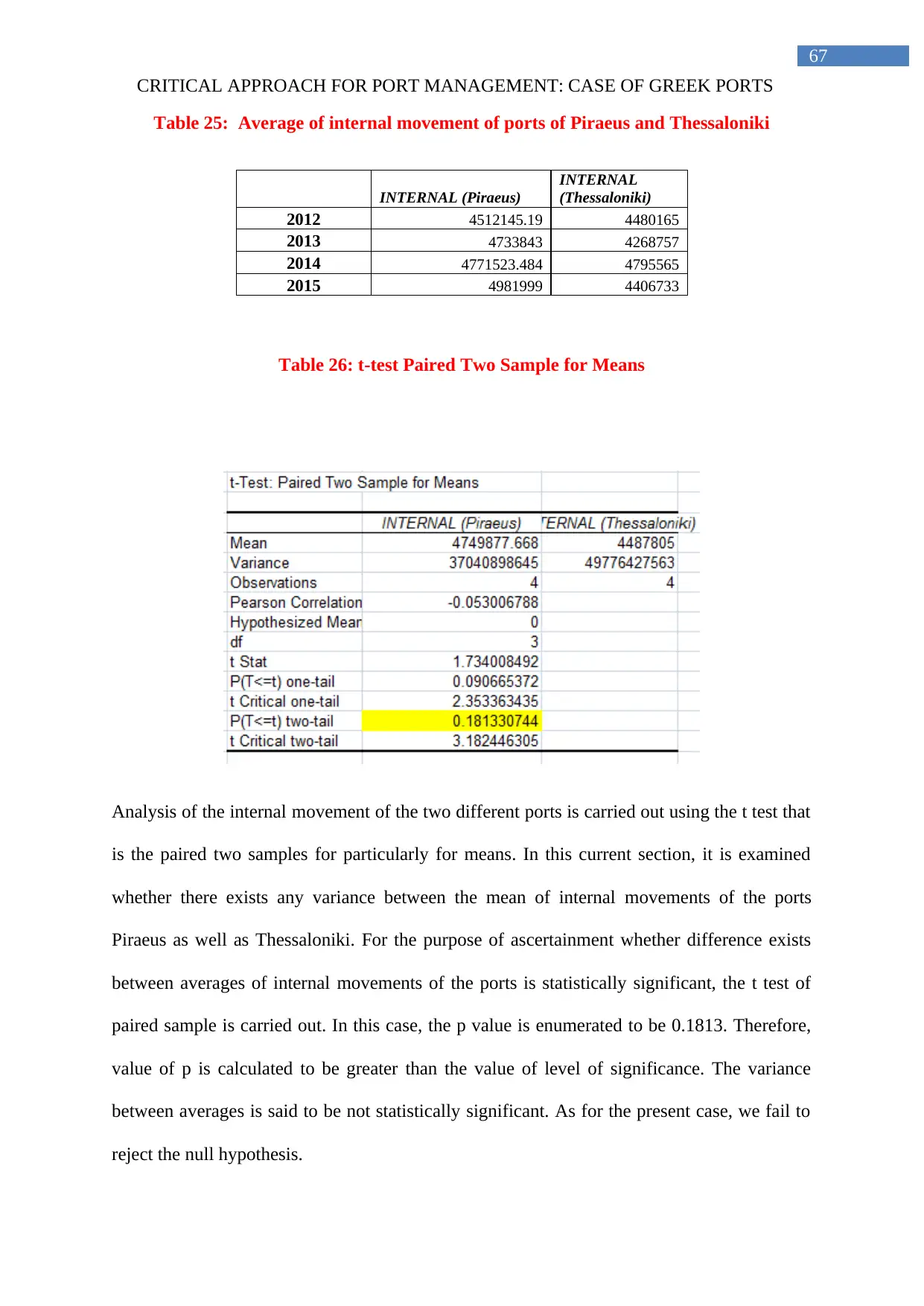
67
CRITICAL APPROACH FOR PORT MANAGEMENT: CASE OF GREEK PORTS
Table 25: Average of internal movement of ports of Piraeus and Thessaloniki
INTERNAL (Piraeus)
INTERNAL
(Thessaloniki)
2012 4512145.19 4480165
2013 4733843 4268757
2014 4771523.484 4795565
2015 4981999 4406733
Table 26: t-test Paired Two Sample for Means
Analysis of the internal movement of the two different ports is carried out using the t test that
is the paired two samples for particularly for means. In this current section, it is examined
whether there exists any variance between the mean of internal movements of the ports
Piraeus as well as Thessaloniki. For the purpose of ascertainment whether difference exists
between averages of internal movements of the ports is statistically significant, the t test of
paired sample is carried out. In this case, the p value is enumerated to be 0.1813. Therefore,
value of p is calculated to be greater than the value of level of significance. The variance
between averages is said to be not statistically significant. As for the present case, we fail to
reject the null hypothesis.
CRITICAL APPROACH FOR PORT MANAGEMENT: CASE OF GREEK PORTS
Table 25: Average of internal movement of ports of Piraeus and Thessaloniki
INTERNAL (Piraeus)
INTERNAL
(Thessaloniki)
2012 4512145.19 4480165
2013 4733843 4268757
2014 4771523.484 4795565
2015 4981999 4406733
Table 26: t-test Paired Two Sample for Means
Analysis of the internal movement of the two different ports is carried out using the t test that
is the paired two samples for particularly for means. In this current section, it is examined
whether there exists any variance between the mean of internal movements of the ports
Piraeus as well as Thessaloniki. For the purpose of ascertainment whether difference exists
between averages of internal movements of the ports is statistically significant, the t test of
paired sample is carried out. In this case, the p value is enumerated to be 0.1813. Therefore,
value of p is calculated to be greater than the value of level of significance. The variance
between averages is said to be not statistically significant. As for the present case, we fail to
reject the null hypothesis.
Secure Best Marks with AI Grader
Need help grading? Try our AI Grader for instant feedback on your assignments.
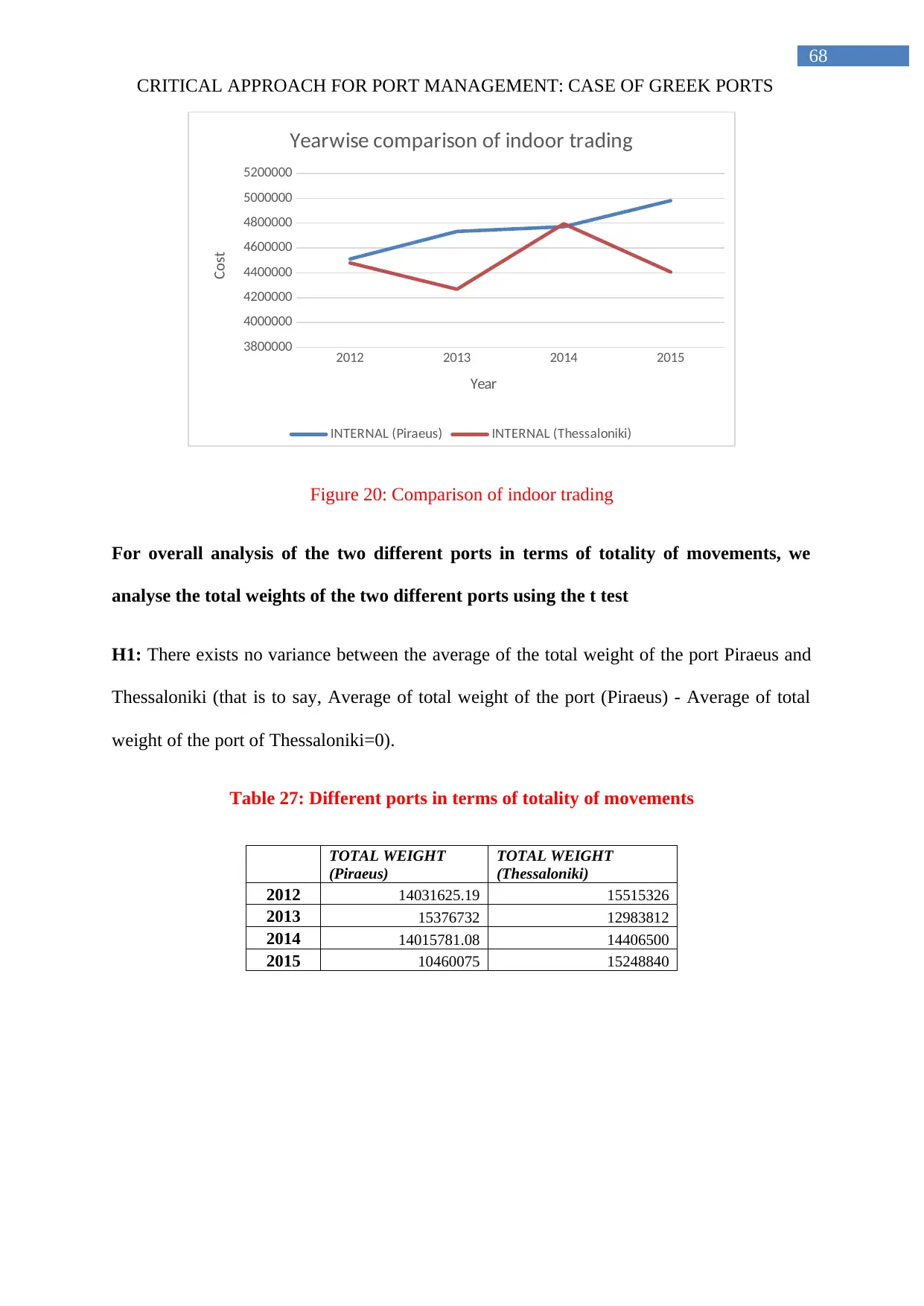
68
CRITICAL APPROACH FOR PORT MANAGEMENT: CASE OF GREEK PORTS
2012 2013 2014 2015
3800000
4000000
4200000
4400000
4600000
4800000
5000000
5200000
Yearwise comparison of indoor trading
INTERNAL (Piraeus) INTERNAL (Thessaloniki)
Year
Cost
Figure 20: Comparison of indoor trading
For overall analysis of the two different ports in terms of totality of movements, we
analyse the total weights of the two different ports using the t test
H1: There exists no variance between the average of the total weight of the port Piraeus and
Thessaloniki (that is to say, Average of total weight of the port (Piraeus) - Average of total
weight of the port of Thessaloniki=0).
Table 27: Different ports in terms of totality of movements
TOTAL WEIGHT
(Piraeus)
TOTAL WEIGHT
(Thessaloniki)
2012 14031625.19 15515326
2013 15376732 12983812
2014 14015781.08 14406500
2015 10460075 15248840
CRITICAL APPROACH FOR PORT MANAGEMENT: CASE OF GREEK PORTS
2012 2013 2014 2015
3800000
4000000
4200000
4400000
4600000
4800000
5000000
5200000
Yearwise comparison of indoor trading
INTERNAL (Piraeus) INTERNAL (Thessaloniki)
Year
Cost
Figure 20: Comparison of indoor trading
For overall analysis of the two different ports in terms of totality of movements, we
analyse the total weights of the two different ports using the t test
H1: There exists no variance between the average of the total weight of the port Piraeus and
Thessaloniki (that is to say, Average of total weight of the port (Piraeus) - Average of total
weight of the port of Thessaloniki=0).
Table 27: Different ports in terms of totality of movements
TOTAL WEIGHT
(Piraeus)
TOTAL WEIGHT
(Thessaloniki)
2012 14031625.19 15515326
2013 15376732 12983812
2014 14015781.08 14406500
2015 10460075 15248840

69
CRITICAL APPROACH FOR PORT MANAGEMENT: CASE OF GREEK PORTS
Table 28: t-test Paired Two Sample for Means
T test for paired two samples for means is undertaken for the purpose of comparing the total
weight of the ports of Piraeus and Thessaloniki. In this current segment, it is examined
whether there subsist any variance between the mean of total weights of the ports Piraeus as
well as Thessaloniki. For the purpose of ascertainment whether difference between the
average of total weight of the ports is statistically significant, we analyse the enumerated
value of p to the level of significance. Based on this study, the level of significance that
stands at 0.05 is considered to be the best. Particularly, the significance level is 0.05 that
replicates a 5% of risk of concluding that a difference exists when necessarily there exist no
real difference.
In this case of total weights of the ports Piraeus and Thessaloniki, it can be hereby observed
that p value stands at 0.5240. In this case, the p value is greater the level of significance of
0.05, therefore, the variance between the means is said to be essentially statistically
significant. As the p value is greater than the significance level, then the decision can be
undertaken regarding failure to rejection of provided null hypothesis. Based on the outcomes
of the test, it can be hereby concluded that the variance between the means is necessarily
CRITICAL APPROACH FOR PORT MANAGEMENT: CASE OF GREEK PORTS
Table 28: t-test Paired Two Sample for Means
T test for paired two samples for means is undertaken for the purpose of comparing the total
weight of the ports of Piraeus and Thessaloniki. In this current segment, it is examined
whether there subsist any variance between the mean of total weights of the ports Piraeus as
well as Thessaloniki. For the purpose of ascertainment whether difference between the
average of total weight of the ports is statistically significant, we analyse the enumerated
value of p to the level of significance. Based on this study, the level of significance that
stands at 0.05 is considered to be the best. Particularly, the significance level is 0.05 that
replicates a 5% of risk of concluding that a difference exists when necessarily there exist no
real difference.
In this case of total weights of the ports Piraeus and Thessaloniki, it can be hereby observed
that p value stands at 0.5240. In this case, the p value is greater the level of significance of
0.05, therefore, the variance between the means is said to be essentially statistically
significant. As the p value is greater than the significance level, then the decision can be
undertaken regarding failure to rejection of provided null hypothesis. Based on the outcomes
of the test, it can be hereby concluded that the variance between the means is necessarily
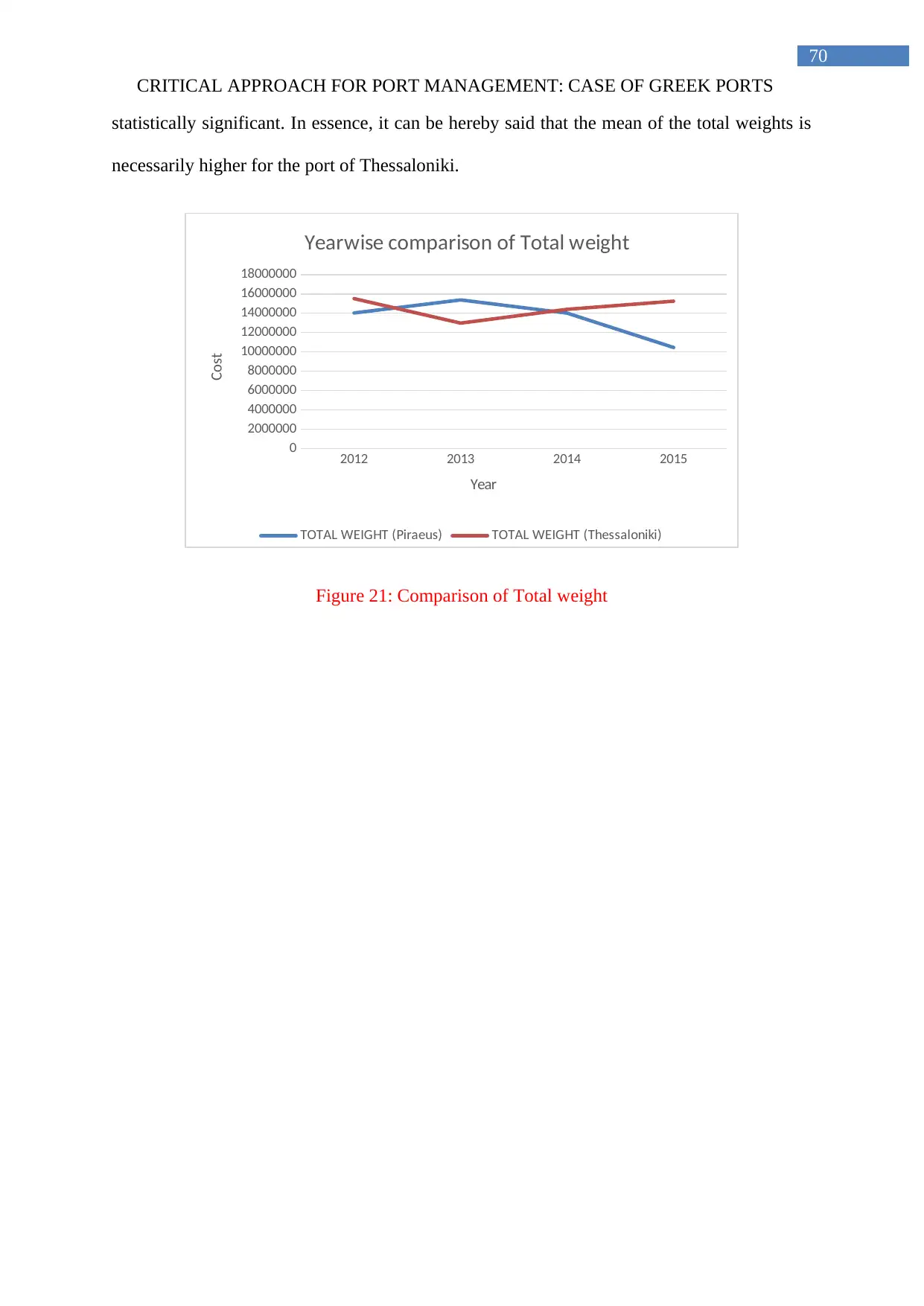
70
CRITICAL APPROACH FOR PORT MANAGEMENT: CASE OF GREEK PORTS
statistically significant. In essence, it can be hereby said that the mean of the total weights is
necessarily higher for the port of Thessaloniki.
2012 2013 2014 2015
0
2000000
4000000
6000000
8000000
10000000
12000000
14000000
16000000
18000000
Yearwise comparison of Total weight
TOTAL WEIGHT (Piraeus) TOTAL WEIGHT (Thessaloniki)
Year
Cost
Figure 21: Comparison of Total weight
CRITICAL APPROACH FOR PORT MANAGEMENT: CASE OF GREEK PORTS
statistically significant. In essence, it can be hereby said that the mean of the total weights is
necessarily higher for the port of Thessaloniki.
2012 2013 2014 2015
0
2000000
4000000
6000000
8000000
10000000
12000000
14000000
16000000
18000000
Yearwise comparison of Total weight
TOTAL WEIGHT (Piraeus) TOTAL WEIGHT (Thessaloniki)
Year
Cost
Figure 21: Comparison of Total weight
Paraphrase This Document
Need a fresh take? Get an instant paraphrase of this document with our AI Paraphraser
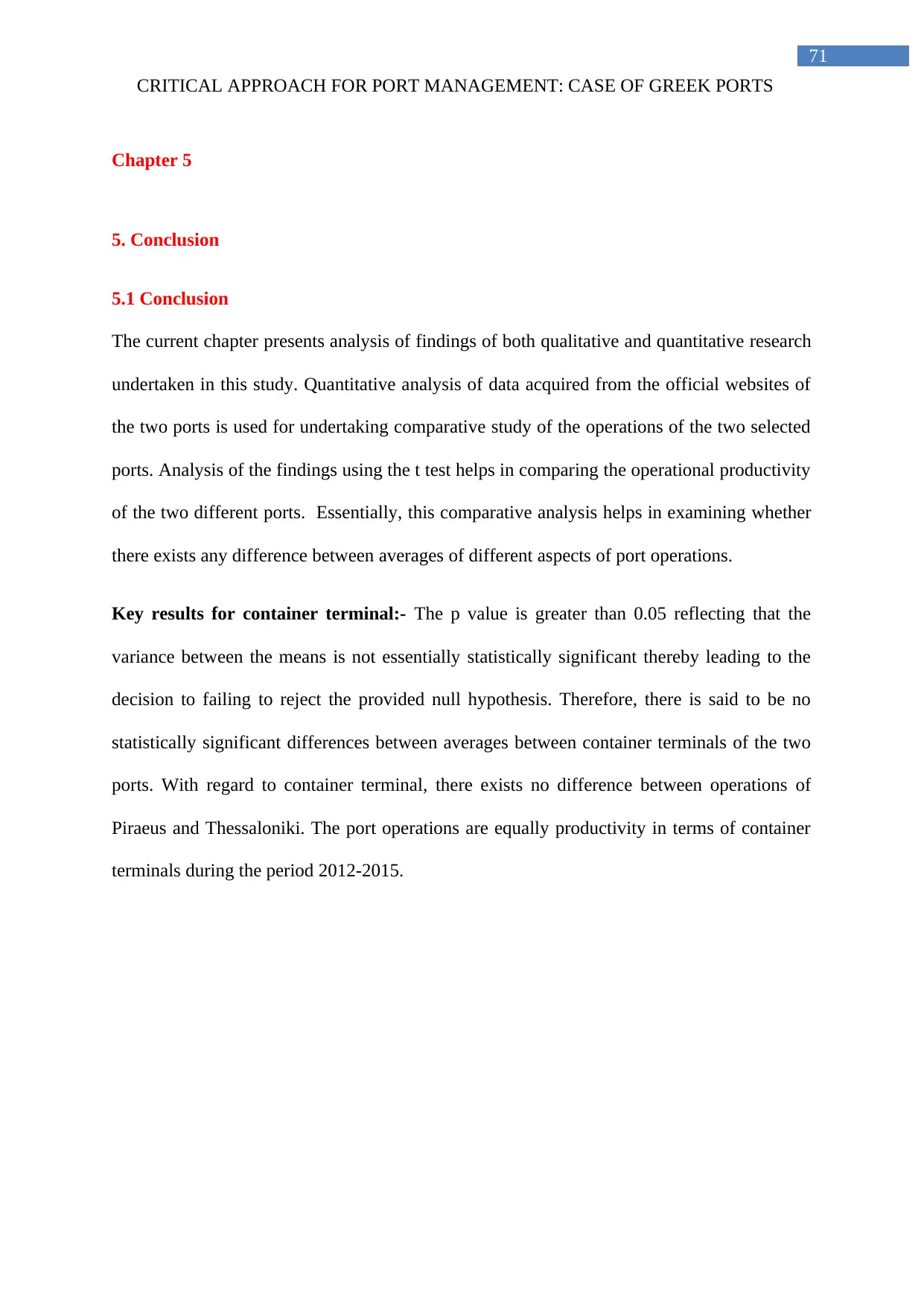
71
CRITICAL APPROACH FOR PORT MANAGEMENT: CASE OF GREEK PORTS
Chapter 5
5. Conclusion
5.1 Conclusion
The current chapter presents analysis of findings of both qualitative and quantitative research
undertaken in this study. Quantitative analysis of data acquired from the official websites of
the two ports is used for undertaking comparative study of the operations of the two selected
ports. Analysis of the findings using the t test helps in comparing the operational productivity
of the two different ports. Essentially, this comparative analysis helps in examining whether
there exists any difference between averages of different aspects of port operations.
Key results for container terminal:- The p value is greater than 0.05 reflecting that the
variance between the means is not essentially statistically significant thereby leading to the
decision to failing to reject the provided null hypothesis. Therefore, there is said to be no
statistically significant differences between averages between container terminals of the two
ports. With regard to container terminal, there exists no difference between operations of
Piraeus and Thessaloniki. The port operations are equally productivity in terms of container
terminals during the period 2012-2015.
CRITICAL APPROACH FOR PORT MANAGEMENT: CASE OF GREEK PORTS
Chapter 5
5. Conclusion
5.1 Conclusion
The current chapter presents analysis of findings of both qualitative and quantitative research
undertaken in this study. Quantitative analysis of data acquired from the official websites of
the two ports is used for undertaking comparative study of the operations of the two selected
ports. Analysis of the findings using the t test helps in comparing the operational productivity
of the two different ports. Essentially, this comparative analysis helps in examining whether
there exists any difference between averages of different aspects of port operations.
Key results for container terminal:- The p value is greater than 0.05 reflecting that the
variance between the means is not essentially statistically significant thereby leading to the
decision to failing to reject the provided null hypothesis. Therefore, there is said to be no
statistically significant differences between averages between container terminals of the two
ports. With regard to container terminal, there exists no difference between operations of
Piraeus and Thessaloniki. The port operations are equally productivity in terms of container
terminals during the period 2012-2015.

72
CRITICAL APPROACH FOR PORT MANAGEMENT: CASE OF GREEK PORTS
Key results for conventional general cargo handling :- Here in this case, the p value is
said to be less than the significance value of alpha that is 0.05. Thus, it can be hereby
mentioned that the difference between averages is essentially statistically significant and the
null hypothesis is rejected in this case. Thus, it can be hereby stated that there exists
statistically significant difference between the average of the conventional general cargo of
the ports of Piraeus and Thessaloniki. Based on results of the operations on conventional
general cargo handling it can be hereby inferred that there is variation in the conventional
general cargo of the ports. This is primarily due to the shortage of skilled labour and
knowledge, especially in the novel operation and service systems, deficiency in proper
strategic management along with operations system and shortages of information systems.
Key results for bulk cargo handling: - In this case, the p value calculated to be 0.000118
for the bulk cargo handling is less than the level of significance that is 0.05. Therefore, the
decision is necessarily to reject the developed null hypothesis and establish the fact average
variance between the bulk cargo handling of the two ports is necessarily significant. The
mean of bulk cargo handling is said to be higher for Thessaloniki in comparison to the port
Piraeus. Therefore, Piraeus can attain higher efficiency in comparison to Thessaloniki and the
port Thessaloniki can augment its operations in this segment by means of attainment of
technological advancement in designs of ships along with lifting equipment, rapid
development and enhancement of bulk cargo, influence of unitisation and implementation of
novel and modern techniques of refrigerators, mainly container carriage. Essentially, Piraeus
can in this case develop novel notions for particularly ship technology and handling of cargo.
Key results for Outdoor Movements in the ports: - The p value calculated to be 0.4470 is
greater than the level of significance. As the p value is greater than the level of significance,
the choice is to fail to essentially reject the specified null hypothesis in this case. Therefore,
there is there is no variance in the mean between outdoor movements of the two ports.
CRITICAL APPROACH FOR PORT MANAGEMENT: CASE OF GREEK PORTS
Key results for conventional general cargo handling :- Here in this case, the p value is
said to be less than the significance value of alpha that is 0.05. Thus, it can be hereby
mentioned that the difference between averages is essentially statistically significant and the
null hypothesis is rejected in this case. Thus, it can be hereby stated that there exists
statistically significant difference between the average of the conventional general cargo of
the ports of Piraeus and Thessaloniki. Based on results of the operations on conventional
general cargo handling it can be hereby inferred that there is variation in the conventional
general cargo of the ports. This is primarily due to the shortage of skilled labour and
knowledge, especially in the novel operation and service systems, deficiency in proper
strategic management along with operations system and shortages of information systems.
Key results for bulk cargo handling: - In this case, the p value calculated to be 0.000118
for the bulk cargo handling is less than the level of significance that is 0.05. Therefore, the
decision is necessarily to reject the developed null hypothesis and establish the fact average
variance between the bulk cargo handling of the two ports is necessarily significant. The
mean of bulk cargo handling is said to be higher for Thessaloniki in comparison to the port
Piraeus. Therefore, Piraeus can attain higher efficiency in comparison to Thessaloniki and the
port Thessaloniki can augment its operations in this segment by means of attainment of
technological advancement in designs of ships along with lifting equipment, rapid
development and enhancement of bulk cargo, influence of unitisation and implementation of
novel and modern techniques of refrigerators, mainly container carriage. Essentially, Piraeus
can in this case develop novel notions for particularly ship technology and handling of cargo.
Key results for Outdoor Movements in the ports: - The p value calculated to be 0.4470 is
greater than the level of significance. As the p value is greater than the level of significance,
the choice is to fail to essentially reject the specified null hypothesis in this case. Therefore,
there is there is no variance in the mean between outdoor movements of the two ports.
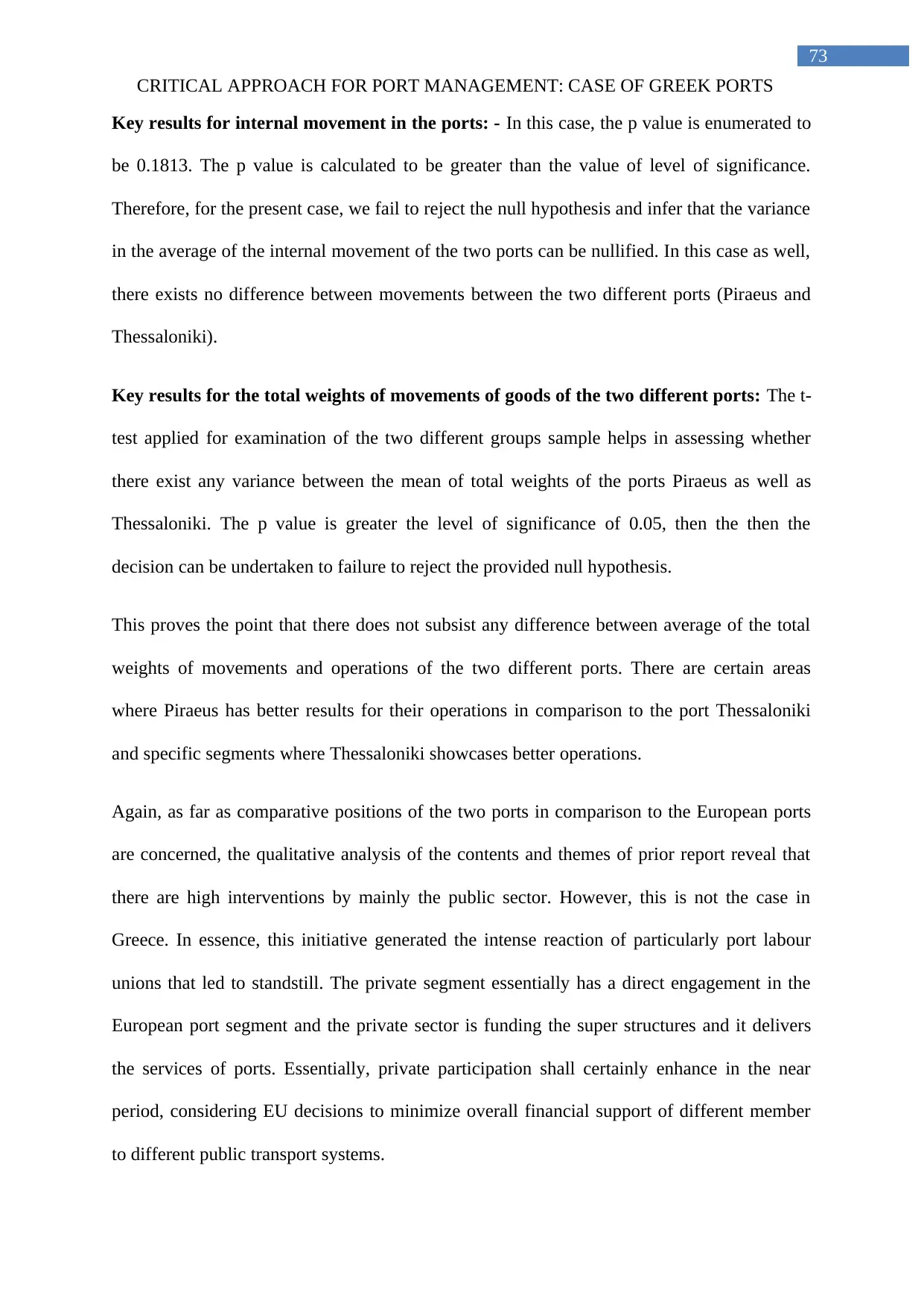
73
CRITICAL APPROACH FOR PORT MANAGEMENT: CASE OF GREEK PORTS
Key results for internal movement in the ports: - In this case, the p value is enumerated to
be 0.1813. The p value is calculated to be greater than the value of level of significance.
Therefore, for the present case, we fail to reject the null hypothesis and infer that the variance
in the average of the internal movement of the two ports can be nullified. In this case as well,
there exists no difference between movements between the two different ports (Piraeus and
Thessaloniki).
Key results for the total weights of movements of goods of the two different ports: The t-
test applied for examination of the two different groups sample helps in assessing whether
there exist any variance between the mean of total weights of the ports Piraeus as well as
Thessaloniki. The p value is greater the level of significance of 0.05, then the then the
decision can be undertaken to failure to reject the provided null hypothesis.
This proves the point that there does not subsist any difference between average of the total
weights of movements and operations of the two different ports. There are certain areas
where Piraeus has better results for their operations in comparison to the port Thessaloniki
and specific segments where Thessaloniki showcases better operations.
Again, as far as comparative positions of the two ports in comparison to the European ports
are concerned, the qualitative analysis of the contents and themes of prior report reveal that
there are high interventions by mainly the public sector. However, this is not the case in
Greece. In essence, this initiative generated the intense reaction of particularly port labour
unions that led to standstill. The private segment essentially has a direct engagement in the
European port segment and the private sector is funding the super structures and it delivers
the services of ports. Essentially, private participation shall certainly enhance in the near
period, considering EU decisions to minimize overall financial support of different member
to different public transport systems.
CRITICAL APPROACH FOR PORT MANAGEMENT: CASE OF GREEK PORTS
Key results for internal movement in the ports: - In this case, the p value is enumerated to
be 0.1813. The p value is calculated to be greater than the value of level of significance.
Therefore, for the present case, we fail to reject the null hypothesis and infer that the variance
in the average of the internal movement of the two ports can be nullified. In this case as well,
there exists no difference between movements between the two different ports (Piraeus and
Thessaloniki).
Key results for the total weights of movements of goods of the two different ports: The t-
test applied for examination of the two different groups sample helps in assessing whether
there exist any variance between the mean of total weights of the ports Piraeus as well as
Thessaloniki. The p value is greater the level of significance of 0.05, then the then the
decision can be undertaken to failure to reject the provided null hypothesis.
This proves the point that there does not subsist any difference between average of the total
weights of movements and operations of the two different ports. There are certain areas
where Piraeus has better results for their operations in comparison to the port Thessaloniki
and specific segments where Thessaloniki showcases better operations.
Again, as far as comparative positions of the two ports in comparison to the European ports
are concerned, the qualitative analysis of the contents and themes of prior report reveal that
there are high interventions by mainly the public sector. However, this is not the case in
Greece. In essence, this initiative generated the intense reaction of particularly port labour
unions that led to standstill. The private segment essentially has a direct engagement in the
European port segment and the private sector is funding the super structures and it delivers
the services of ports. Essentially, private participation shall certainly enhance in the near
period, considering EU decisions to minimize overall financial support of different member
to different public transport systems.
Secure Best Marks with AI Grader
Need help grading? Try our AI Grader for instant feedback on your assignments.
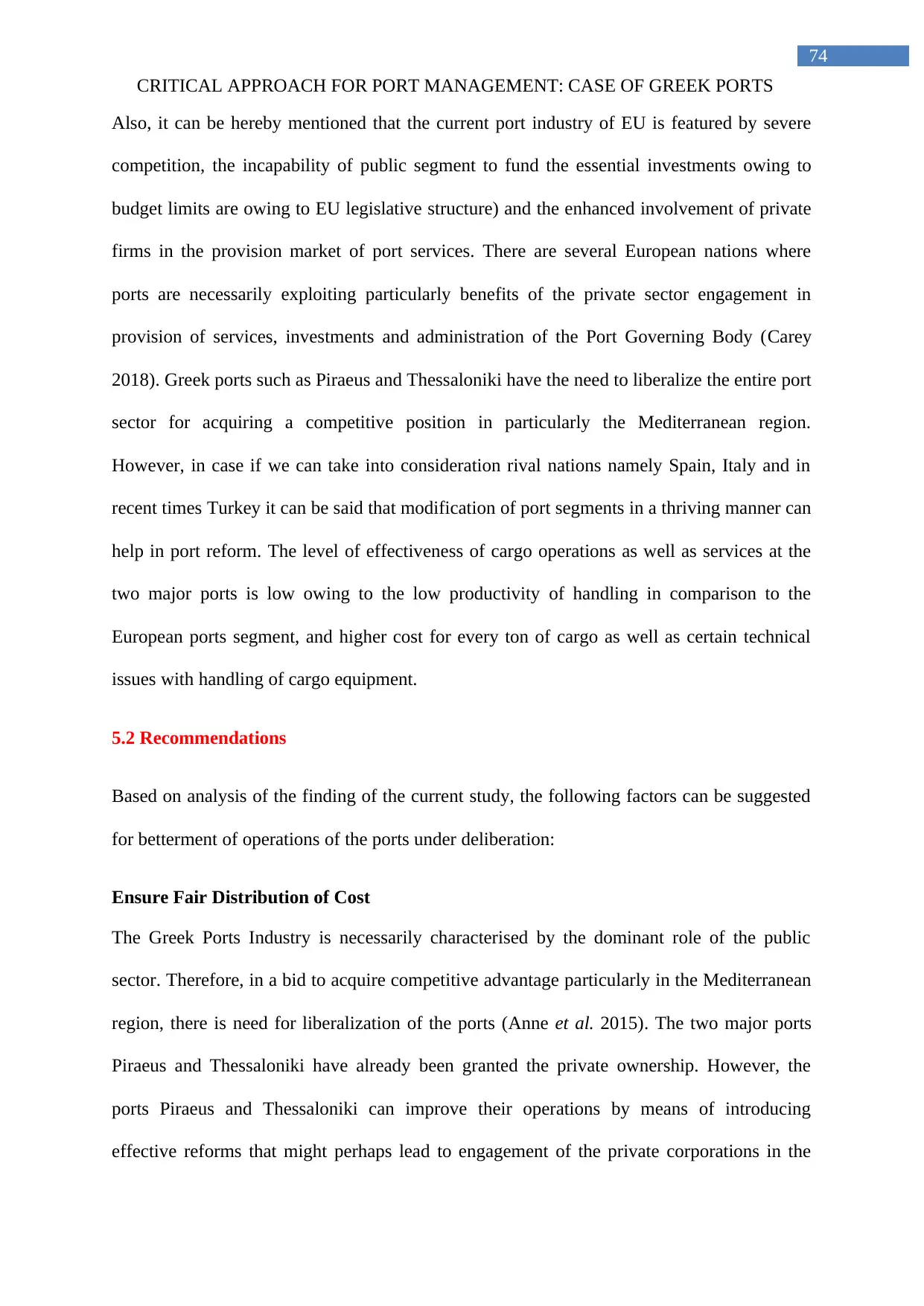
74
CRITICAL APPROACH FOR PORT MANAGEMENT: CASE OF GREEK PORTS
Also, it can be hereby mentioned that the current port industry of EU is featured by severe
competition, the incapability of public segment to fund the essential investments owing to
budget limits are owing to EU legislative structure) and the enhanced involvement of private
firms in the provision market of port services. There are several European nations where
ports are necessarily exploiting particularly benefits of the private sector engagement in
provision of services, investments and administration of the Port Governing Body (Carey
2018). Greek ports such as Piraeus and Thessaloniki have the need to liberalize the entire port
sector for acquiring a competitive position in particularly the Mediterranean region.
However, in case if we can take into consideration rival nations namely Spain, Italy and in
recent times Turkey it can be said that modification of port segments in a thriving manner can
help in port reform. The level of effectiveness of cargo operations as well as services at the
two major ports is low owing to the low productivity of handling in comparison to the
European ports segment, and higher cost for every ton of cargo as well as certain technical
issues with handling of cargo equipment.
5.2 Recommendations
Based on analysis of the finding of the current study, the following factors can be suggested
for betterment of operations of the ports under deliberation:
Ensure Fair Distribution of Cost
The Greek Ports Industry is necessarily characterised by the dominant role of the public
sector. Therefore, in a bid to acquire competitive advantage particularly in the Mediterranean
region, there is need for liberalization of the ports (Anne et al. 2015). The two major ports
Piraeus and Thessaloniki have already been granted the private ownership. However, the
ports Piraeus and Thessaloniki can improve their operations by means of introducing
effective reforms that might perhaps lead to engagement of the private corporations in the
CRITICAL APPROACH FOR PORT MANAGEMENT: CASE OF GREEK PORTS
Also, it can be hereby mentioned that the current port industry of EU is featured by severe
competition, the incapability of public segment to fund the essential investments owing to
budget limits are owing to EU legislative structure) and the enhanced involvement of private
firms in the provision market of port services. There are several European nations where
ports are necessarily exploiting particularly benefits of the private sector engagement in
provision of services, investments and administration of the Port Governing Body (Carey
2018). Greek ports such as Piraeus and Thessaloniki have the need to liberalize the entire port
sector for acquiring a competitive position in particularly the Mediterranean region.
However, in case if we can take into consideration rival nations namely Spain, Italy and in
recent times Turkey it can be said that modification of port segments in a thriving manner can
help in port reform. The level of effectiveness of cargo operations as well as services at the
two major ports is low owing to the low productivity of handling in comparison to the
European ports segment, and higher cost for every ton of cargo as well as certain technical
issues with handling of cargo equipment.
5.2 Recommendations
Based on analysis of the finding of the current study, the following factors can be suggested
for betterment of operations of the ports under deliberation:
Ensure Fair Distribution of Cost
The Greek Ports Industry is necessarily characterised by the dominant role of the public
sector. Therefore, in a bid to acquire competitive advantage particularly in the Mediterranean
region, there is need for liberalization of the ports (Anne et al. 2015). The two major ports
Piraeus and Thessaloniki have already been granted the private ownership. However, the
ports Piraeus and Thessaloniki can improve their operations by means of introducing
effective reforms that might perhaps lead to engagement of the private corporations in the

75
CRITICAL APPROACH FOR PORT MANAGEMENT: CASE OF GREEK PORTS
market for services provision of port. The current performance and condition is necessarily
the fair distribution of the production cost of the port services that is something that is also
favourable for particularly the EU (Athanasatos et al. 2014).
Following Methodological Framework
Also, it is recommended that the ports follow a methodological framework that in turn can
contribute towards proper distribution of the fair cost founded on the specific principle titled
“beneficiary pays” particularly on the advantages gathered by each and every segment.
Essentially, the framework that is a proposal for future research is selection of a case study on
necessarily passenger port. The structure can be considered to be an effective tool that can be
used for defining the regulations controlling the system of the Greek port (Bichou 2014). The
pertinent regulatory bodies might possibly be used both before as well as after the execution
of the projected reform for the development of the ports under deliberation. In essence, the
intention of the government of Greece is to introduce a concession procedure in the case of
two major container ports of the nation. In case of Greece, particularly the public segment
need not accept a specific concession fee that is less than the real value of the infrastructure
of the port as well as superstructures (Chapsos and Kitchen 2015).
Synchronization of different kinds of equipment and intricate stratagems
Again, there is need for improvement of productivity by means of superior planning.
Essentially, over the past decade, it can be observed that huge amounts of money have been
invested in essentially the transport segment. Appropriate productivity is not possible without
aligning procedures across the entire terminal (Chlomoudis et al. 2016). However, it can be
hereby said that there is need to synchronize various kinds of equipment and intricate
stratagems. Nevertheless, comparatively very little attention is provided to the utilization of
operations research mechanisms along with techniques for optimizing operations.
CRITICAL APPROACH FOR PORT MANAGEMENT: CASE OF GREEK PORTS
market for services provision of port. The current performance and condition is necessarily
the fair distribution of the production cost of the port services that is something that is also
favourable for particularly the EU (Athanasatos et al. 2014).
Following Methodological Framework
Also, it is recommended that the ports follow a methodological framework that in turn can
contribute towards proper distribution of the fair cost founded on the specific principle titled
“beneficiary pays” particularly on the advantages gathered by each and every segment.
Essentially, the framework that is a proposal for future research is selection of a case study on
necessarily passenger port. The structure can be considered to be an effective tool that can be
used for defining the regulations controlling the system of the Greek port (Bichou 2014). The
pertinent regulatory bodies might possibly be used both before as well as after the execution
of the projected reform for the development of the ports under deliberation. In essence, the
intention of the government of Greece is to introduce a concession procedure in the case of
two major container ports of the nation. In case of Greece, particularly the public segment
need not accept a specific concession fee that is less than the real value of the infrastructure
of the port as well as superstructures (Chapsos and Kitchen 2015).
Synchronization of different kinds of equipment and intricate stratagems
Again, there is need for improvement of productivity by means of superior planning.
Essentially, over the past decade, it can be observed that huge amounts of money have been
invested in essentially the transport segment. Appropriate productivity is not possible without
aligning procedures across the entire terminal (Chlomoudis et al. 2016). However, it can be
hereby said that there is need to synchronize various kinds of equipment and intricate
stratagems. Nevertheless, comparatively very little attention is provided to the utilization of
operations research mechanisms along with techniques for optimizing operations.
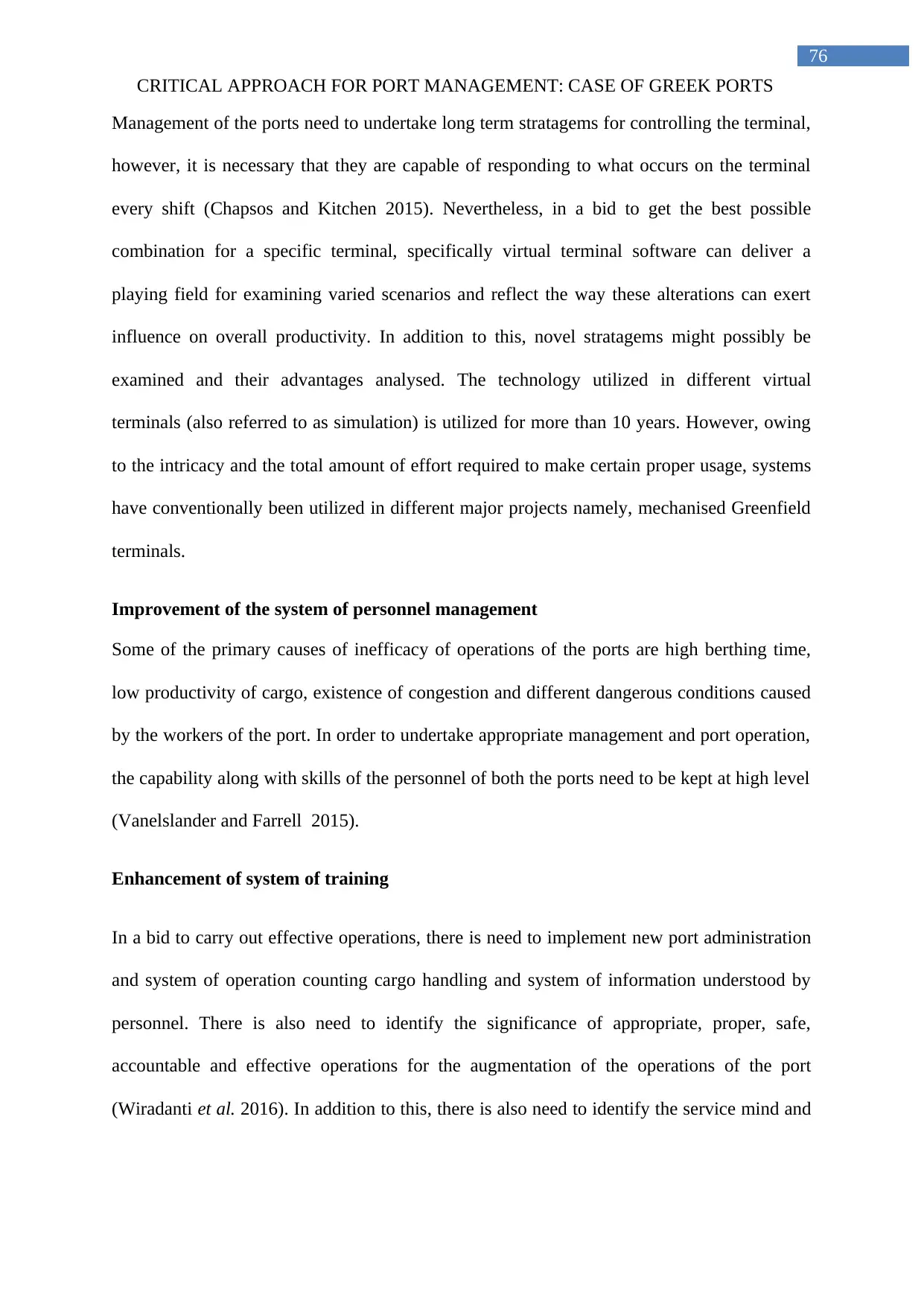
76
CRITICAL APPROACH FOR PORT MANAGEMENT: CASE OF GREEK PORTS
Management of the ports need to undertake long term stratagems for controlling the terminal,
however, it is necessary that they are capable of responding to what occurs on the terminal
every shift (Chapsos and Kitchen 2015). Nevertheless, in a bid to get the best possible
combination for a specific terminal, specifically virtual terminal software can deliver a
playing field for examining varied scenarios and reflect the way these alterations can exert
influence on overall productivity. In addition to this, novel stratagems might possibly be
examined and their advantages analysed. The technology utilized in different virtual
terminals (also referred to as simulation) is utilized for more than 10 years. However, owing
to the intricacy and the total amount of effort required to make certain proper usage, systems
have conventionally been utilized in different major projects namely, mechanised Greenfield
terminals.
Improvement of the system of personnel management
Some of the primary causes of inefficacy of operations of the ports are high berthing time,
low productivity of cargo, existence of congestion and different dangerous conditions caused
by the workers of the port. In order to undertake appropriate management and port operation,
the capability along with skills of the personnel of both the ports need to be kept at high level
(Vanelslander and Farrell 2015).
Enhancement of system of training
In a bid to carry out effective operations, there is need to implement new port administration
and system of operation counting cargo handling and system of information understood by
personnel. There is also need to identify the significance of appropriate, proper, safe,
accountable and effective operations for the augmentation of the operations of the port
(Wiradanti et al. 2016). In addition to this, there is also need to identify the service mind and
CRITICAL APPROACH FOR PORT MANAGEMENT: CASE OF GREEK PORTS
Management of the ports need to undertake long term stratagems for controlling the terminal,
however, it is necessary that they are capable of responding to what occurs on the terminal
every shift (Chapsos and Kitchen 2015). Nevertheless, in a bid to get the best possible
combination for a specific terminal, specifically virtual terminal software can deliver a
playing field for examining varied scenarios and reflect the way these alterations can exert
influence on overall productivity. In addition to this, novel stratagems might possibly be
examined and their advantages analysed. The technology utilized in different virtual
terminals (also referred to as simulation) is utilized for more than 10 years. However, owing
to the intricacy and the total amount of effort required to make certain proper usage, systems
have conventionally been utilized in different major projects namely, mechanised Greenfield
terminals.
Improvement of the system of personnel management
Some of the primary causes of inefficacy of operations of the ports are high berthing time,
low productivity of cargo, existence of congestion and different dangerous conditions caused
by the workers of the port. In order to undertake appropriate management and port operation,
the capability along with skills of the personnel of both the ports need to be kept at high level
(Vanelslander and Farrell 2015).
Enhancement of system of training
In a bid to carry out effective operations, there is need to implement new port administration
and system of operation counting cargo handling and system of information understood by
personnel. There is also need to identify the significance of appropriate, proper, safe,
accountable and effective operations for the augmentation of the operations of the port
(Wiradanti et al. 2016). In addition to this, there is also need to identify the service mind and
Paraphrase This Document
Need a fresh take? Get an instant paraphrase of this document with our AI Paraphraser

77
CRITICAL APPROACH FOR PORT MANAGEMENT: CASE OF GREEK PORTS
augment the image of the business concern. Furthermore, there is need to instil a cost
awareness in the personnel.
Enhancement of reliability as well as safety
It is suggested that vehicles un-associated to port actions both entering as well as leaving the
port area need to be minimized by means of constructing parking lots. Speedy and
effectiveness handling of different container cargo can be carried out by means of
improvement of efficacy of operations, service as well as port management is also necessary
(Zhang and Lam 2017). Automation initiated by way of novel technologies and remote
control can be considered to be extremely important. Management of the company can
concentrate on port security and keep a track of smuggling, asylum seekers, unlawful
immigrants, theft along with pilferage of cargo. A port facility security plan can be drafted
and implemented for management of overall quality and safety (Chlomoudis et al. 2016). In
addition to this, environmental along with safety issues measures can be properly instituted in
the ports and executed as per global standards.
On the whole, based on findings of the study, it can be hereby stated that there does not
subsist any variances between mean of total movements and operations of two diverse ports.
There are specific areas where the port of Piraeus has improved outcomes for operations in
comparison to the port Thessaloniki and specific segments where Thessaloniki reflects better
operations.
CRITICAL APPROACH FOR PORT MANAGEMENT: CASE OF GREEK PORTS
augment the image of the business concern. Furthermore, there is need to instil a cost
awareness in the personnel.
Enhancement of reliability as well as safety
It is suggested that vehicles un-associated to port actions both entering as well as leaving the
port area need to be minimized by means of constructing parking lots. Speedy and
effectiveness handling of different container cargo can be carried out by means of
improvement of efficacy of operations, service as well as port management is also necessary
(Zhang and Lam 2017). Automation initiated by way of novel technologies and remote
control can be considered to be extremely important. Management of the company can
concentrate on port security and keep a track of smuggling, asylum seekers, unlawful
immigrants, theft along with pilferage of cargo. A port facility security plan can be drafted
and implemented for management of overall quality and safety (Chlomoudis et al. 2016). In
addition to this, environmental along with safety issues measures can be properly instituted in
the ports and executed as per global standards.
On the whole, based on findings of the study, it can be hereby stated that there does not
subsist any variances between mean of total movements and operations of two diverse ports.
There are specific areas where the port of Piraeus has improved outcomes for operations in
comparison to the port Thessaloniki and specific segments where Thessaloniki reflects better
operations.
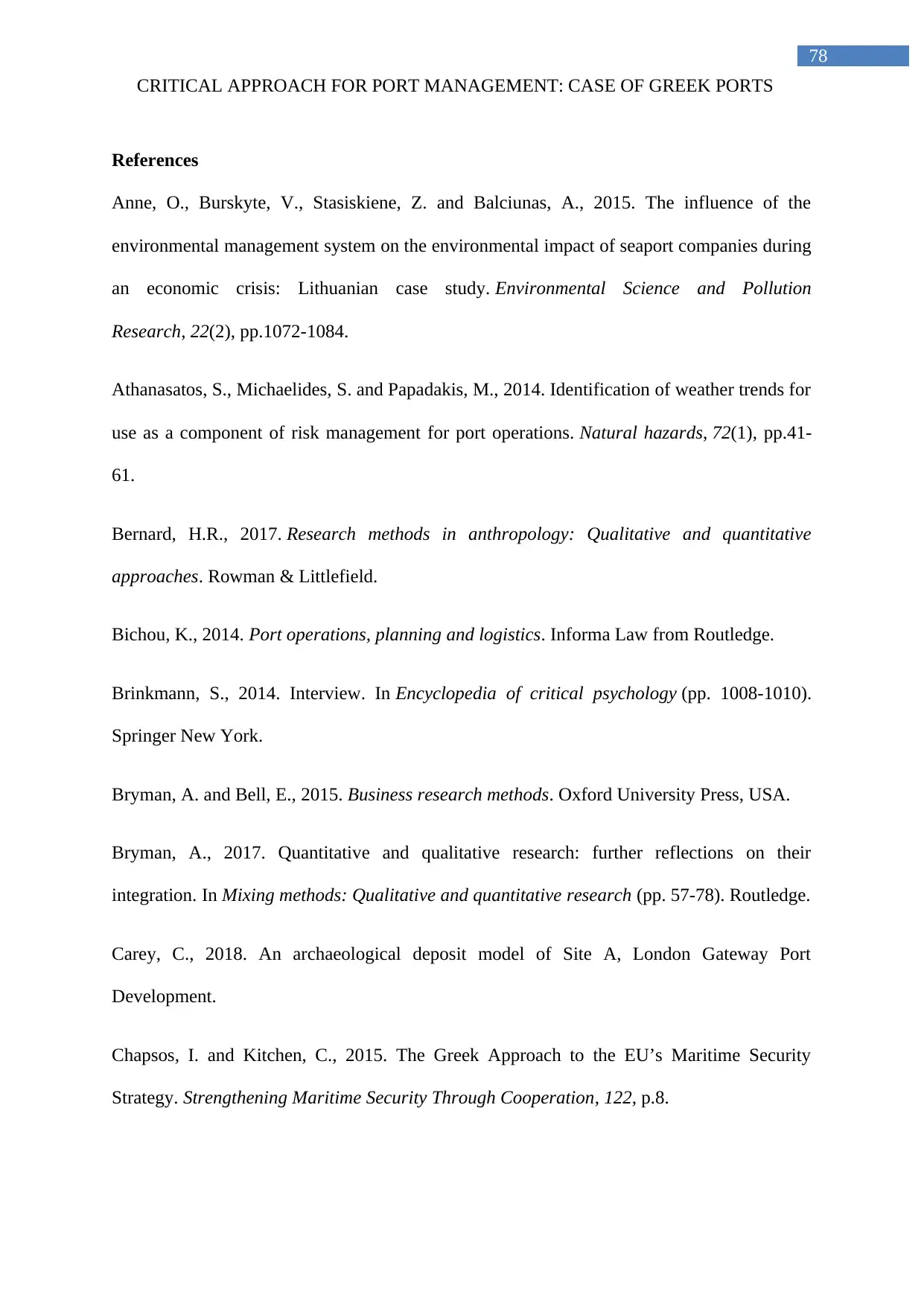
78
CRITICAL APPROACH FOR PORT MANAGEMENT: CASE OF GREEK PORTS
References
Anne, O., Burskyte, V., Stasiskiene, Z. and Balciunas, A., 2015. The influence of the
environmental management system on the environmental impact of seaport companies during
an economic crisis: Lithuanian case study. Environmental Science and Pollution
Research, 22(2), pp.1072-1084.
Athanasatos, S., Michaelides, S. and Papadakis, M., 2014. Identification of weather trends for
use as a component of risk management for port operations. Natural hazards, 72(1), pp.41-
61.
Bernard, H.R., 2017. Research methods in anthropology: Qualitative and quantitative
approaches. Rowman & Littlefield.
Bichou, K., 2014. Port operations, planning and logistics. Informa Law from Routledge.
Brinkmann, S., 2014. Interview. In Encyclopedia of critical psychology (pp. 1008-1010).
Springer New York.
Bryman, A. and Bell, E., 2015. Business research methods. Oxford University Press, USA.
Bryman, A., 2017. Quantitative and qualitative research: further reflections on their
integration. In Mixing methods: Qualitative and quantitative research (pp. 57-78). Routledge.
Carey, C., 2018. An archaeological deposit model of Site A, London Gateway Port
Development.
Chapsos, I. and Kitchen, C., 2015. The Greek Approach to the EU’s Maritime Security
Strategy. Strengthening Maritime Security Through Cooperation, 122, p.8.
CRITICAL APPROACH FOR PORT MANAGEMENT: CASE OF GREEK PORTS
References
Anne, O., Burskyte, V., Stasiskiene, Z. and Balciunas, A., 2015. The influence of the
environmental management system on the environmental impact of seaport companies during
an economic crisis: Lithuanian case study. Environmental Science and Pollution
Research, 22(2), pp.1072-1084.
Athanasatos, S., Michaelides, S. and Papadakis, M., 2014. Identification of weather trends for
use as a component of risk management for port operations. Natural hazards, 72(1), pp.41-
61.
Bernard, H.R., 2017. Research methods in anthropology: Qualitative and quantitative
approaches. Rowman & Littlefield.
Bichou, K., 2014. Port operations, planning and logistics. Informa Law from Routledge.
Brinkmann, S., 2014. Interview. In Encyclopedia of critical psychology (pp. 1008-1010).
Springer New York.
Bryman, A. and Bell, E., 2015. Business research methods. Oxford University Press, USA.
Bryman, A., 2017. Quantitative and qualitative research: further reflections on their
integration. In Mixing methods: Qualitative and quantitative research (pp. 57-78). Routledge.
Carey, C., 2018. An archaeological deposit model of Site A, London Gateway Port
Development.
Chapsos, I. and Kitchen, C., 2015. The Greek Approach to the EU’s Maritime Security
Strategy. Strengthening Maritime Security Through Cooperation, 122, p.8.
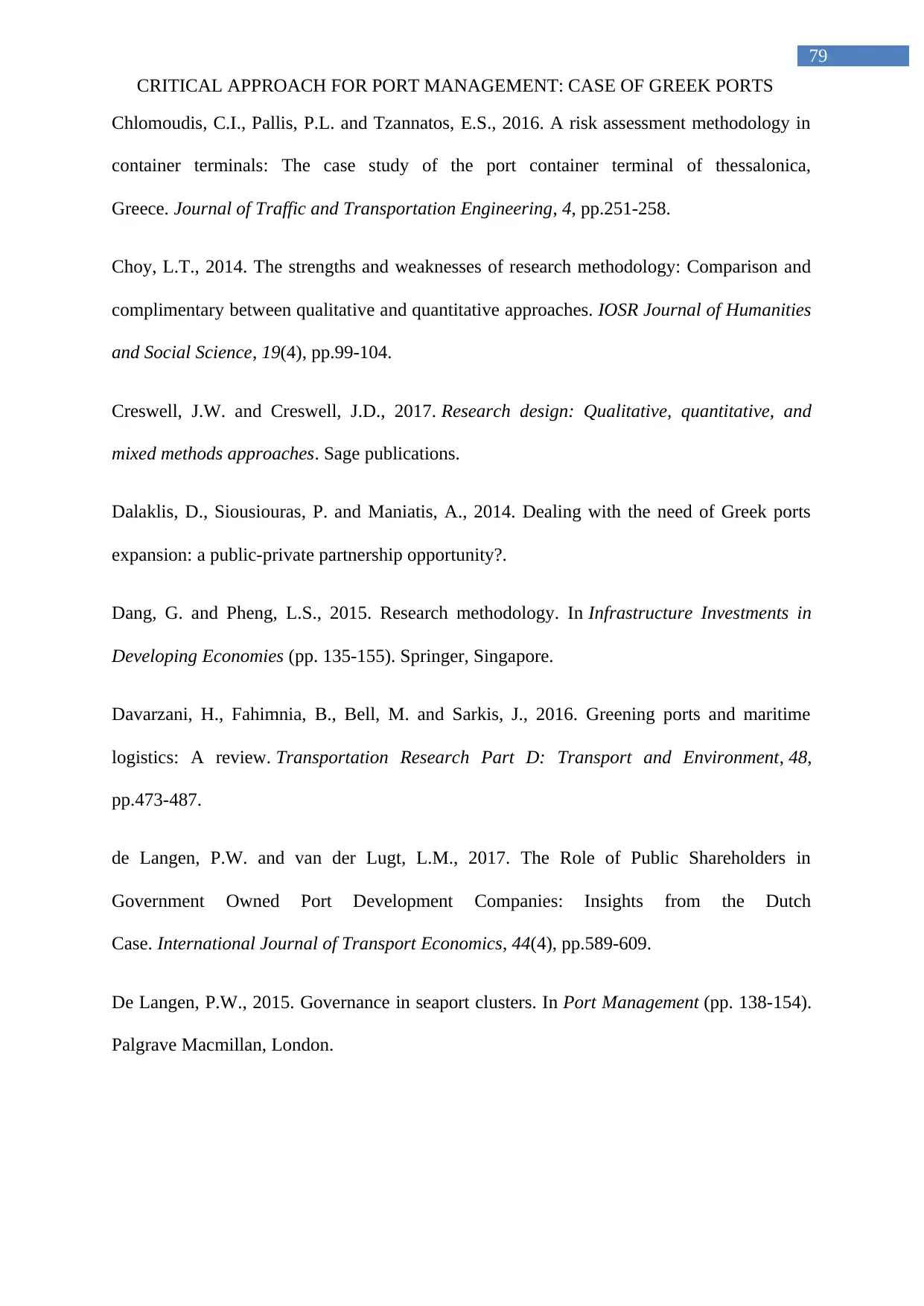
79
CRITICAL APPROACH FOR PORT MANAGEMENT: CASE OF GREEK PORTS
Chlomoudis, C.I., Pallis, P.L. and Tzannatos, E.S., 2016. A risk assessment methodology in
container terminals: The case study of the port container terminal of thessalonica,
Greece. Journal of Traffic and Transportation Engineering, 4, pp.251-258.
Choy, L.T., 2014. The strengths and weaknesses of research methodology: Comparison and
complimentary between qualitative and quantitative approaches. IOSR Journal of Humanities
and Social Science, 19(4), pp.99-104.
Creswell, J.W. and Creswell, J.D., 2017. Research design: Qualitative, quantitative, and
mixed methods approaches. Sage publications.
Dalaklis, D., Siousiouras, P. and Maniatis, A., 2014. Dealing with the need of Greek ports
expansion: a public-private partnership opportunity?.
Dang, G. and Pheng, L.S., 2015. Research methodology. In Infrastructure Investments in
Developing Economies (pp. 135-155). Springer, Singapore.
Davarzani, H., Fahimnia, B., Bell, M. and Sarkis, J., 2016. Greening ports and maritime
logistics: A review. Transportation Research Part D: Transport and Environment, 48,
pp.473-487.
de Langen, P.W. and van der Lugt, L.M., 2017. The Role of Public Shareholders in
Government Owned Port Development Companies: Insights from the Dutch
Case. International Journal of Transport Economics, 44(4), pp.589-609.
De Langen, P.W., 2015. Governance in seaport clusters. In Port Management (pp. 138-154).
Palgrave Macmillan, London.
CRITICAL APPROACH FOR PORT MANAGEMENT: CASE OF GREEK PORTS
Chlomoudis, C.I., Pallis, P.L. and Tzannatos, E.S., 2016. A risk assessment methodology in
container terminals: The case study of the port container terminal of thessalonica,
Greece. Journal of Traffic and Transportation Engineering, 4, pp.251-258.
Choy, L.T., 2014. The strengths and weaknesses of research methodology: Comparison and
complimentary between qualitative and quantitative approaches. IOSR Journal of Humanities
and Social Science, 19(4), pp.99-104.
Creswell, J.W. and Creswell, J.D., 2017. Research design: Qualitative, quantitative, and
mixed methods approaches. Sage publications.
Dalaklis, D., Siousiouras, P. and Maniatis, A., 2014. Dealing with the need of Greek ports
expansion: a public-private partnership opportunity?.
Dang, G. and Pheng, L.S., 2015. Research methodology. In Infrastructure Investments in
Developing Economies (pp. 135-155). Springer, Singapore.
Davarzani, H., Fahimnia, B., Bell, M. and Sarkis, J., 2016. Greening ports and maritime
logistics: A review. Transportation Research Part D: Transport and Environment, 48,
pp.473-487.
de Langen, P.W. and van der Lugt, L.M., 2017. The Role of Public Shareholders in
Government Owned Port Development Companies: Insights from the Dutch
Case. International Journal of Transport Economics, 44(4), pp.589-609.
De Langen, P.W., 2015. Governance in seaport clusters. In Port Management (pp. 138-154).
Palgrave Macmillan, London.
Secure Best Marks with AI Grader
Need help grading? Try our AI Grader for instant feedback on your assignments.
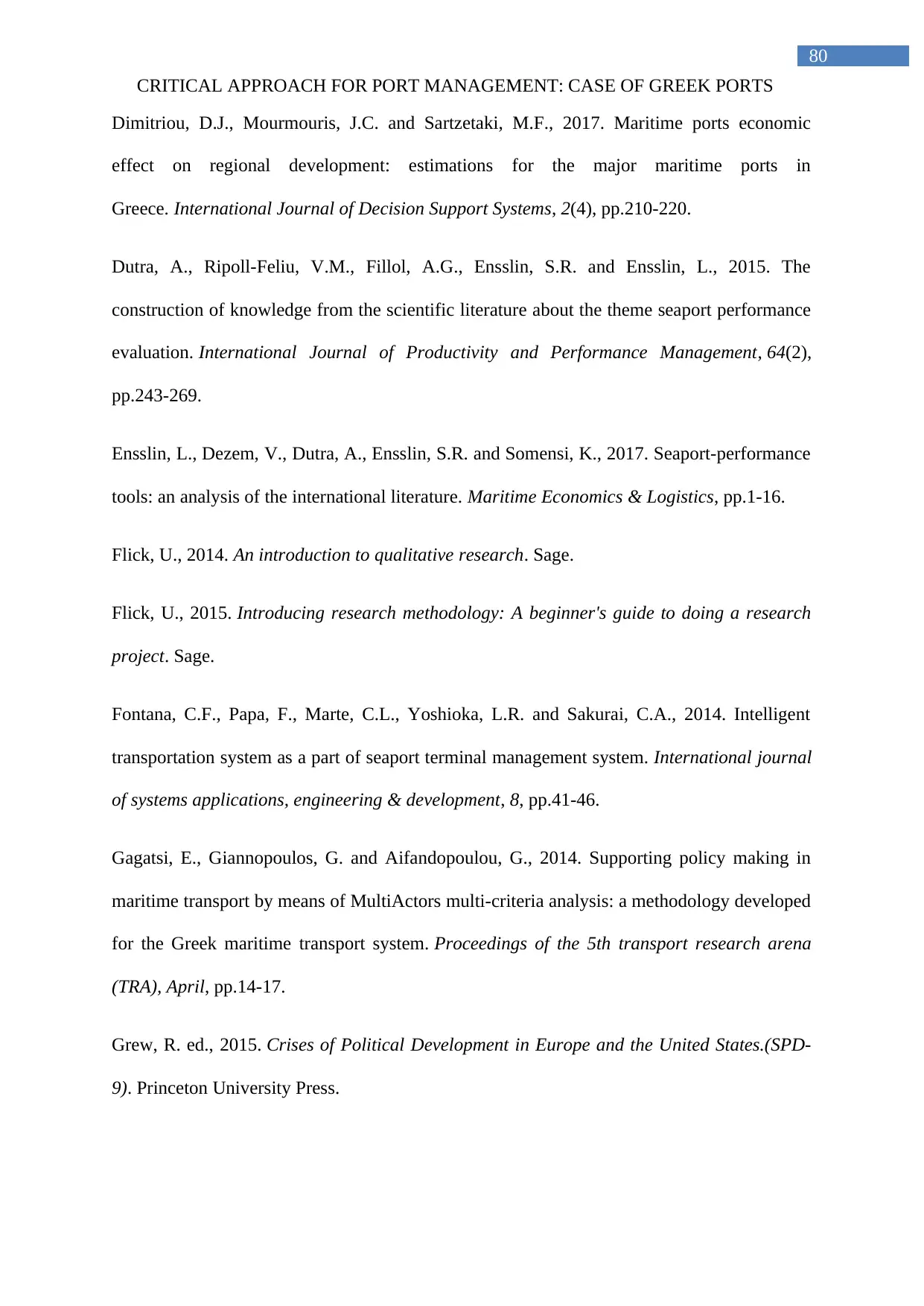
80
CRITICAL APPROACH FOR PORT MANAGEMENT: CASE OF GREEK PORTS
Dimitriou, D.J., Mourmouris, J.C. and Sartzetaki, M.F., 2017. Maritime ports economic
effect on regional development: estimations for the major maritime ports in
Greece. International Journal of Decision Support Systems, 2(4), pp.210-220.
Dutra, A., Ripoll-Feliu, V.M., Fillol, A.G., Ensslin, S.R. and Ensslin, L., 2015. The
construction of knowledge from the scientific literature about the theme seaport performance
evaluation. International Journal of Productivity and Performance Management, 64(2),
pp.243-269.
Ensslin, L., Dezem, V., Dutra, A., Ensslin, S.R. and Somensi, K., 2017. Seaport-performance
tools: an analysis of the international literature. Maritime Economics & Logistics, pp.1-16.
Flick, U., 2014. An introduction to qualitative research. Sage.
Flick, U., 2015. Introducing research methodology: A beginner's guide to doing a research
project. Sage.
Fontana, C.F., Papa, F., Marte, C.L., Yoshioka, L.R. and Sakurai, C.A., 2014. Intelligent
transportation system as a part of seaport terminal management system. International journal
of systems applications, engineering & development, 8, pp.41-46.
Gagatsi, E., Giannopoulos, G. and Aifandopoulou, G., 2014. Supporting policy making in
maritime transport by means of MultiActors multi-criteria analysis: a methodology developed
for the Greek maritime transport system. Proceedings of the 5th transport research arena
(TRA), April, pp.14-17.
Grew, R. ed., 2015. Crises of Political Development in Europe and the United States.(SPD-
9). Princeton University Press.
CRITICAL APPROACH FOR PORT MANAGEMENT: CASE OF GREEK PORTS
Dimitriou, D.J., Mourmouris, J.C. and Sartzetaki, M.F., 2017. Maritime ports economic
effect on regional development: estimations for the major maritime ports in
Greece. International Journal of Decision Support Systems, 2(4), pp.210-220.
Dutra, A., Ripoll-Feliu, V.M., Fillol, A.G., Ensslin, S.R. and Ensslin, L., 2015. The
construction of knowledge from the scientific literature about the theme seaport performance
evaluation. International Journal of Productivity and Performance Management, 64(2),
pp.243-269.
Ensslin, L., Dezem, V., Dutra, A., Ensslin, S.R. and Somensi, K., 2017. Seaport-performance
tools: an analysis of the international literature. Maritime Economics & Logistics, pp.1-16.
Flick, U., 2014. An introduction to qualitative research. Sage.
Flick, U., 2015. Introducing research methodology: A beginner's guide to doing a research
project. Sage.
Fontana, C.F., Papa, F., Marte, C.L., Yoshioka, L.R. and Sakurai, C.A., 2014. Intelligent
transportation system as a part of seaport terminal management system. International journal
of systems applications, engineering & development, 8, pp.41-46.
Gagatsi, E., Giannopoulos, G. and Aifandopoulou, G., 2014. Supporting policy making in
maritime transport by means of MultiActors multi-criteria analysis: a methodology developed
for the Greek maritime transport system. Proceedings of the 5th transport research arena
(TRA), April, pp.14-17.
Grew, R. ed., 2015. Crises of Political Development in Europe and the United States.(SPD-
9). Princeton University Press.
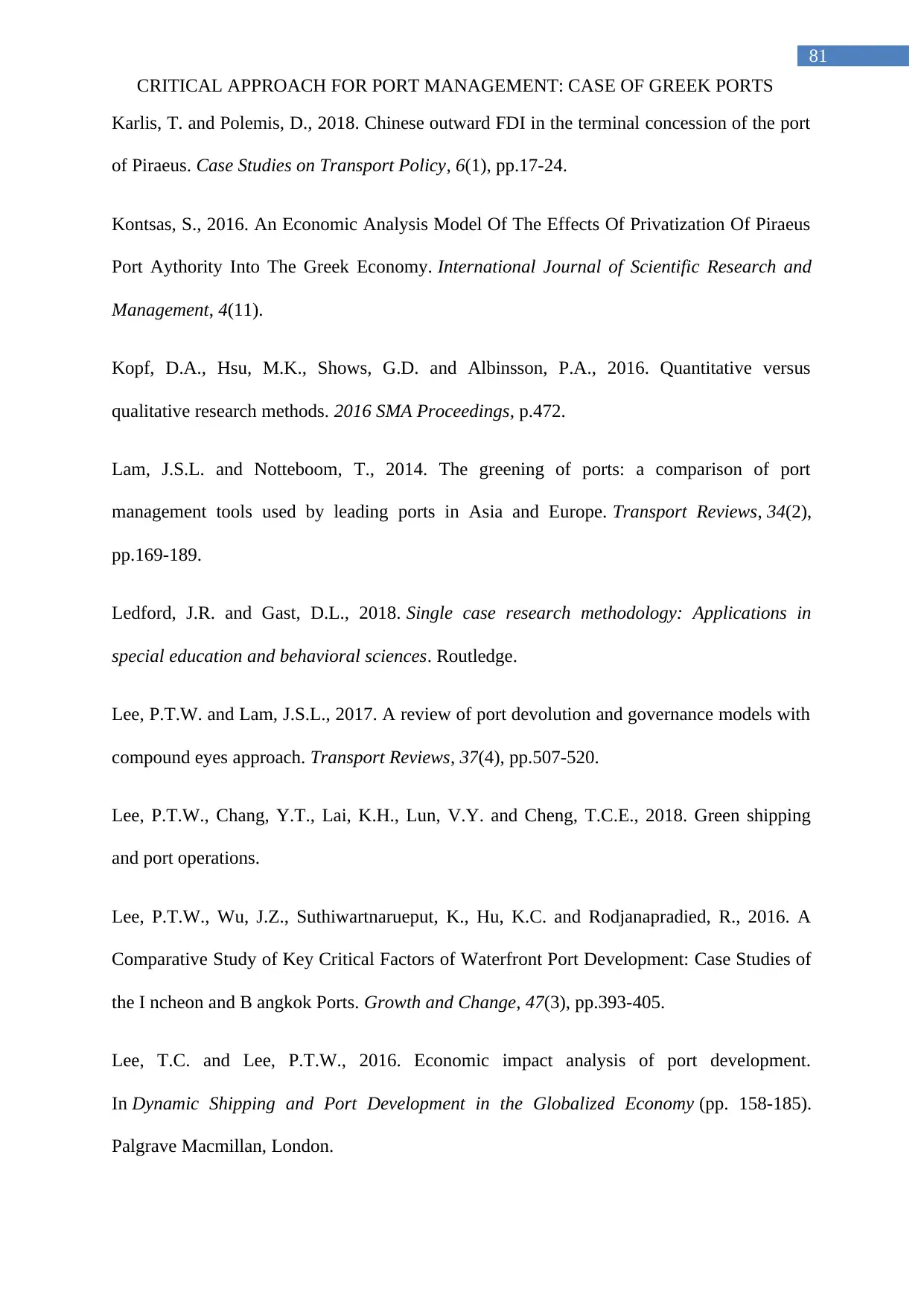
81
CRITICAL APPROACH FOR PORT MANAGEMENT: CASE OF GREEK PORTS
Karlis, T. and Polemis, D., 2018. Chinese outward FDI in the terminal concession of the port
of Piraeus. Case Studies on Transport Policy, 6(1), pp.17-24.
Kontsas, S., 2016. An Economic Analysis Model Of The Effects Of Privatization Of Piraeus
Port Aythority Into The Greek Economy. International Journal of Scientific Research and
Management, 4(11).
Kopf, D.A., Hsu, M.K., Shows, G.D. and Albinsson, P.A., 2016. Quantitative versus
qualitative research methods. 2016 SMA Proceedings, p.472.
Lam, J.S.L. and Notteboom, T., 2014. The greening of ports: a comparison of port
management tools used by leading ports in Asia and Europe. Transport Reviews, 34(2),
pp.169-189.
Ledford, J.R. and Gast, D.L., 2018. Single case research methodology: Applications in
special education and behavioral sciences. Routledge.
Lee, P.T.W. and Lam, J.S.L., 2017. A review of port devolution and governance models with
compound eyes approach. Transport Reviews, 37(4), pp.507-520.
Lee, P.T.W., Chang, Y.T., Lai, K.H., Lun, V.Y. and Cheng, T.C.E., 2018. Green shipping
and port operations.
Lee, P.T.W., Wu, J.Z., Suthiwartnarueput, K., Hu, K.C. and Rodjanapradied, R., 2016. A
Comparative Study of Key Critical Factors of Waterfront Port Development: Case Studies of
the I ncheon and B angkok Ports. Growth and Change, 47(3), pp.393-405.
Lee, T.C. and Lee, P.T.W., 2016. Economic impact analysis of port development.
In Dynamic Shipping and Port Development in the Globalized Economy (pp. 158-185).
Palgrave Macmillan, London.
CRITICAL APPROACH FOR PORT MANAGEMENT: CASE OF GREEK PORTS
Karlis, T. and Polemis, D., 2018. Chinese outward FDI in the terminal concession of the port
of Piraeus. Case Studies on Transport Policy, 6(1), pp.17-24.
Kontsas, S., 2016. An Economic Analysis Model Of The Effects Of Privatization Of Piraeus
Port Aythority Into The Greek Economy. International Journal of Scientific Research and
Management, 4(11).
Kopf, D.A., Hsu, M.K., Shows, G.D. and Albinsson, P.A., 2016. Quantitative versus
qualitative research methods. 2016 SMA Proceedings, p.472.
Lam, J.S.L. and Notteboom, T., 2014. The greening of ports: a comparison of port
management tools used by leading ports in Asia and Europe. Transport Reviews, 34(2),
pp.169-189.
Ledford, J.R. and Gast, D.L., 2018. Single case research methodology: Applications in
special education and behavioral sciences. Routledge.
Lee, P.T.W. and Lam, J.S.L., 2017. A review of port devolution and governance models with
compound eyes approach. Transport Reviews, 37(4), pp.507-520.
Lee, P.T.W., Chang, Y.T., Lai, K.H., Lun, V.Y. and Cheng, T.C.E., 2018. Green shipping
and port operations.
Lee, P.T.W., Wu, J.Z., Suthiwartnarueput, K., Hu, K.C. and Rodjanapradied, R., 2016. A
Comparative Study of Key Critical Factors of Waterfront Port Development: Case Studies of
the I ncheon and B angkok Ports. Growth and Change, 47(3), pp.393-405.
Lee, T.C. and Lee, P.T.W., 2016. Economic impact analysis of port development.
In Dynamic Shipping and Port Development in the Globalized Economy (pp. 158-185).
Palgrave Macmillan, London.
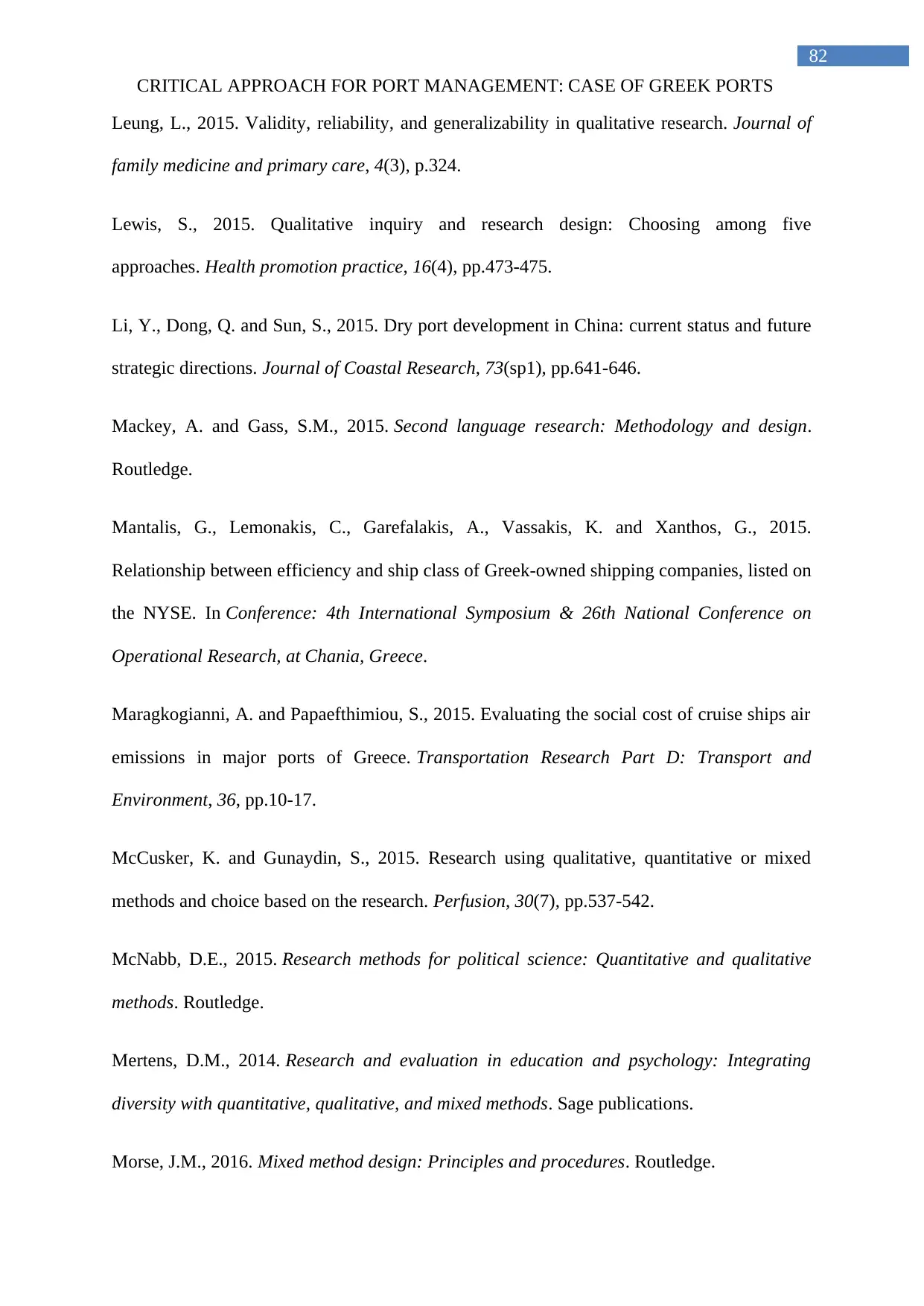
82
CRITICAL APPROACH FOR PORT MANAGEMENT: CASE OF GREEK PORTS
Leung, L., 2015. Validity, reliability, and generalizability in qualitative research. Journal of
family medicine and primary care, 4(3), p.324.
Lewis, S., 2015. Qualitative inquiry and research design: Choosing among five
approaches. Health promotion practice, 16(4), pp.473-475.
Li, Y., Dong, Q. and Sun, S., 2015. Dry port development in China: current status and future
strategic directions. Journal of Coastal Research, 73(sp1), pp.641-646.
Mackey, A. and Gass, S.M., 2015. Second language research: Methodology and design.
Routledge.
Mantalis, G., Lemonakis, C., Garefalakis, A., Vassakis, K. and Xanthos, G., 2015.
Relationship between efficiency and ship class of Greek-owned shipping companies, listed on
the NYSE. In Conference: 4th International Symposium & 26th National Conference on
Operational Research, at Chania, Greece.
Maragkogianni, A. and Papaefthimiou, S., 2015. Evaluating the social cost of cruise ships air
emissions in major ports of Greece. Transportation Research Part D: Transport and
Environment, 36, pp.10-17.
McCusker, K. and Gunaydin, S., 2015. Research using qualitative, quantitative or mixed
methods and choice based on the research. Perfusion, 30(7), pp.537-542.
McNabb, D.E., 2015. Research methods for political science: Quantitative and qualitative
methods. Routledge.
Mertens, D.M., 2014. Research and evaluation in education and psychology: Integrating
diversity with quantitative, qualitative, and mixed methods. Sage publications.
Morse, J.M., 2016. Mixed method design: Principles and procedures. Routledge.
CRITICAL APPROACH FOR PORT MANAGEMENT: CASE OF GREEK PORTS
Leung, L., 2015. Validity, reliability, and generalizability in qualitative research. Journal of
family medicine and primary care, 4(3), p.324.
Lewis, S., 2015. Qualitative inquiry and research design: Choosing among five
approaches. Health promotion practice, 16(4), pp.473-475.
Li, Y., Dong, Q. and Sun, S., 2015. Dry port development in China: current status and future
strategic directions. Journal of Coastal Research, 73(sp1), pp.641-646.
Mackey, A. and Gass, S.M., 2015. Second language research: Methodology and design.
Routledge.
Mantalis, G., Lemonakis, C., Garefalakis, A., Vassakis, K. and Xanthos, G., 2015.
Relationship between efficiency and ship class of Greek-owned shipping companies, listed on
the NYSE. In Conference: 4th International Symposium & 26th National Conference on
Operational Research, at Chania, Greece.
Maragkogianni, A. and Papaefthimiou, S., 2015. Evaluating the social cost of cruise ships air
emissions in major ports of Greece. Transportation Research Part D: Transport and
Environment, 36, pp.10-17.
McCusker, K. and Gunaydin, S., 2015. Research using qualitative, quantitative or mixed
methods and choice based on the research. Perfusion, 30(7), pp.537-542.
McNabb, D.E., 2015. Research methods for political science: Quantitative and qualitative
methods. Routledge.
Mertens, D.M., 2014. Research and evaluation in education and psychology: Integrating
diversity with quantitative, qualitative, and mixed methods. Sage publications.
Morse, J.M., 2016. Mixed method design: Principles and procedures. Routledge.
Paraphrase This Document
Need a fresh take? Get an instant paraphrase of this document with our AI Paraphraser
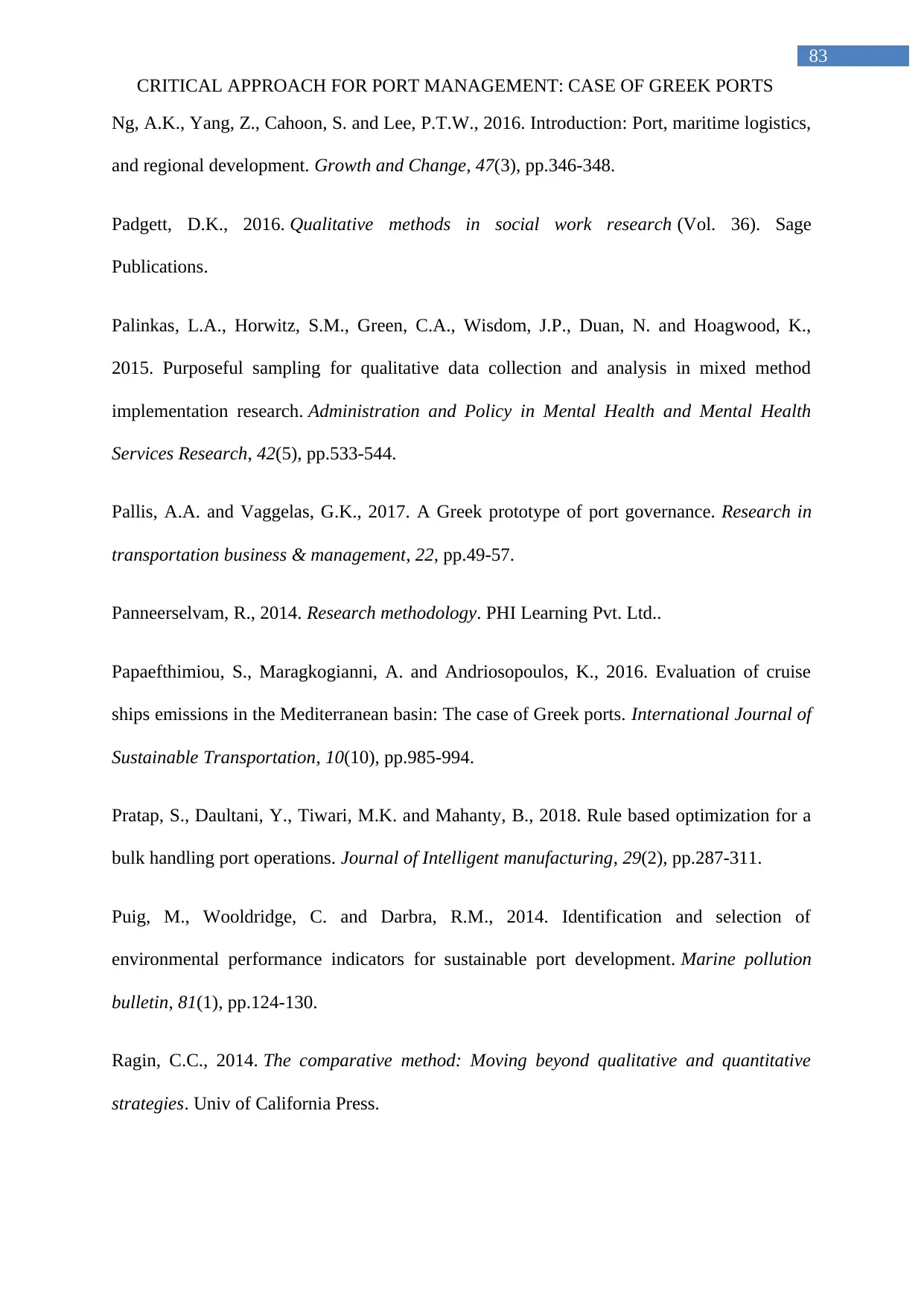
83
CRITICAL APPROACH FOR PORT MANAGEMENT: CASE OF GREEK PORTS
Ng, A.K., Yang, Z., Cahoon, S. and Lee, P.T.W., 2016. Introduction: Port, maritime logistics,
and regional development. Growth and Change, 47(3), pp.346-348.
Padgett, D.K., 2016. Qualitative methods in social work research (Vol. 36). Sage
Publications.
Palinkas, L.A., Horwitz, S.M., Green, C.A., Wisdom, J.P., Duan, N. and Hoagwood, K.,
2015. Purposeful sampling for qualitative data collection and analysis in mixed method
implementation research. Administration and Policy in Mental Health and Mental Health
Services Research, 42(5), pp.533-544.
Pallis, A.A. and Vaggelas, G.K., 2017. A Greek prototype of port governance. Research in
transportation business & management, 22, pp.49-57.
Panneerselvam, R., 2014. Research methodology. PHI Learning Pvt. Ltd..
Papaefthimiou, S., Maragkogianni, A. and Andriosopoulos, K., 2016. Evaluation of cruise
ships emissions in the Mediterranean basin: The case of Greek ports. International Journal of
Sustainable Transportation, 10(10), pp.985-994.
Pratap, S., Daultani, Y., Tiwari, M.K. and Mahanty, B., 2018. Rule based optimization for a
bulk handling port operations. Journal of Intelligent manufacturing, 29(2), pp.287-311.
Puig, M., Wooldridge, C. and Darbra, R.M., 2014. Identification and selection of
environmental performance indicators for sustainable port development. Marine pollution
bulletin, 81(1), pp.124-130.
Ragin, C.C., 2014. The comparative method: Moving beyond qualitative and quantitative
strategies. Univ of California Press.
CRITICAL APPROACH FOR PORT MANAGEMENT: CASE OF GREEK PORTS
Ng, A.K., Yang, Z., Cahoon, S. and Lee, P.T.W., 2016. Introduction: Port, maritime logistics,
and regional development. Growth and Change, 47(3), pp.346-348.
Padgett, D.K., 2016. Qualitative methods in social work research (Vol. 36). Sage
Publications.
Palinkas, L.A., Horwitz, S.M., Green, C.A., Wisdom, J.P., Duan, N. and Hoagwood, K.,
2015. Purposeful sampling for qualitative data collection and analysis in mixed method
implementation research. Administration and Policy in Mental Health and Mental Health
Services Research, 42(5), pp.533-544.
Pallis, A.A. and Vaggelas, G.K., 2017. A Greek prototype of port governance. Research in
transportation business & management, 22, pp.49-57.
Panneerselvam, R., 2014. Research methodology. PHI Learning Pvt. Ltd..
Papaefthimiou, S., Maragkogianni, A. and Andriosopoulos, K., 2016. Evaluation of cruise
ships emissions in the Mediterranean basin: The case of Greek ports. International Journal of
Sustainable Transportation, 10(10), pp.985-994.
Pratap, S., Daultani, Y., Tiwari, M.K. and Mahanty, B., 2018. Rule based optimization for a
bulk handling port operations. Journal of Intelligent manufacturing, 29(2), pp.287-311.
Puig, M., Wooldridge, C. and Darbra, R.M., 2014. Identification and selection of
environmental performance indicators for sustainable port development. Marine pollution
bulletin, 81(1), pp.124-130.
Ragin, C.C., 2014. The comparative method: Moving beyond qualitative and quantitative
strategies. Univ of California Press.
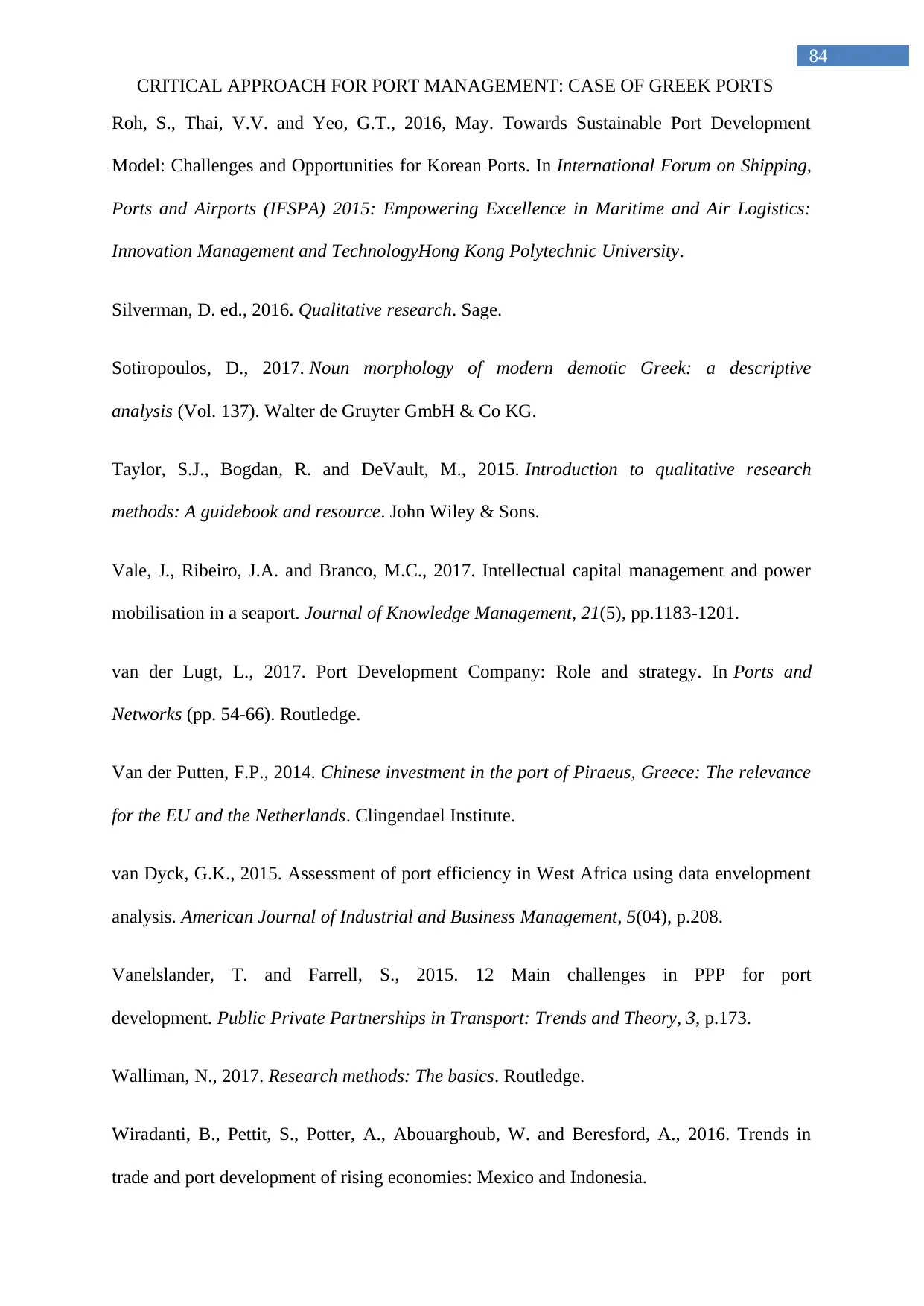
84
CRITICAL APPROACH FOR PORT MANAGEMENT: CASE OF GREEK PORTS
Roh, S., Thai, V.V. and Yeo, G.T., 2016, May. Towards Sustainable Port Development
Model: Challenges and Opportunities for Korean Ports. In International Forum on Shipping,
Ports and Airports (IFSPA) 2015: Empowering Excellence in Maritime and Air Logistics:
Innovation Management and TechnologyHong Kong Polytechnic University.
Silverman, D. ed., 2016. Qualitative research. Sage.
Sotiropoulos, D., 2017. Noun morphology of modern demotic Greek: a descriptive
analysis (Vol. 137). Walter de Gruyter GmbH & Co KG.
Taylor, S.J., Bogdan, R. and DeVault, M., 2015. Introduction to qualitative research
methods: A guidebook and resource. John Wiley & Sons.
Vale, J., Ribeiro, J.A. and Branco, M.C., 2017. Intellectual capital management and power
mobilisation in a seaport. Journal of Knowledge Management, 21(5), pp.1183-1201.
van der Lugt, L., 2017. Port Development Company: Role and strategy. In Ports and
Networks (pp. 54-66). Routledge.
Van der Putten, F.P., 2014. Chinese investment in the port of Piraeus, Greece: The relevance
for the EU and the Netherlands. Clingendael Institute.
van Dyck, G.K., 2015. Assessment of port efficiency in West Africa using data envelopment
analysis. American Journal of Industrial and Business Management, 5(04), p.208.
Vanelslander, T. and Farrell, S., 2015. 12 Main challenges in PPP for port
development. Public Private Partnerships in Transport: Trends and Theory, 3, p.173.
Walliman, N., 2017. Research methods: The basics. Routledge.
Wiradanti, B., Pettit, S., Potter, A., Abouarghoub, W. and Beresford, A., 2016. Trends in
trade and port development of rising economies: Mexico and Indonesia.
CRITICAL APPROACH FOR PORT MANAGEMENT: CASE OF GREEK PORTS
Roh, S., Thai, V.V. and Yeo, G.T., 2016, May. Towards Sustainable Port Development
Model: Challenges and Opportunities for Korean Ports. In International Forum on Shipping,
Ports and Airports (IFSPA) 2015: Empowering Excellence in Maritime and Air Logistics:
Innovation Management and TechnologyHong Kong Polytechnic University.
Silverman, D. ed., 2016. Qualitative research. Sage.
Sotiropoulos, D., 2017. Noun morphology of modern demotic Greek: a descriptive
analysis (Vol. 137). Walter de Gruyter GmbH & Co KG.
Taylor, S.J., Bogdan, R. and DeVault, M., 2015. Introduction to qualitative research
methods: A guidebook and resource. John Wiley & Sons.
Vale, J., Ribeiro, J.A. and Branco, M.C., 2017. Intellectual capital management and power
mobilisation in a seaport. Journal of Knowledge Management, 21(5), pp.1183-1201.
van der Lugt, L., 2017. Port Development Company: Role and strategy. In Ports and
Networks (pp. 54-66). Routledge.
Van der Putten, F.P., 2014. Chinese investment in the port of Piraeus, Greece: The relevance
for the EU and the Netherlands. Clingendael Institute.
van Dyck, G.K., 2015. Assessment of port efficiency in West Africa using data envelopment
analysis. American Journal of Industrial and Business Management, 5(04), p.208.
Vanelslander, T. and Farrell, S., 2015. 12 Main challenges in PPP for port
development. Public Private Partnerships in Transport: Trends and Theory, 3, p.173.
Walliman, N., 2017. Research methods: The basics. Routledge.
Wiradanti, B., Pettit, S., Potter, A., Abouarghoub, W. and Beresford, A., 2016. Trends in
trade and port development of rising economies: Mexico and Indonesia.
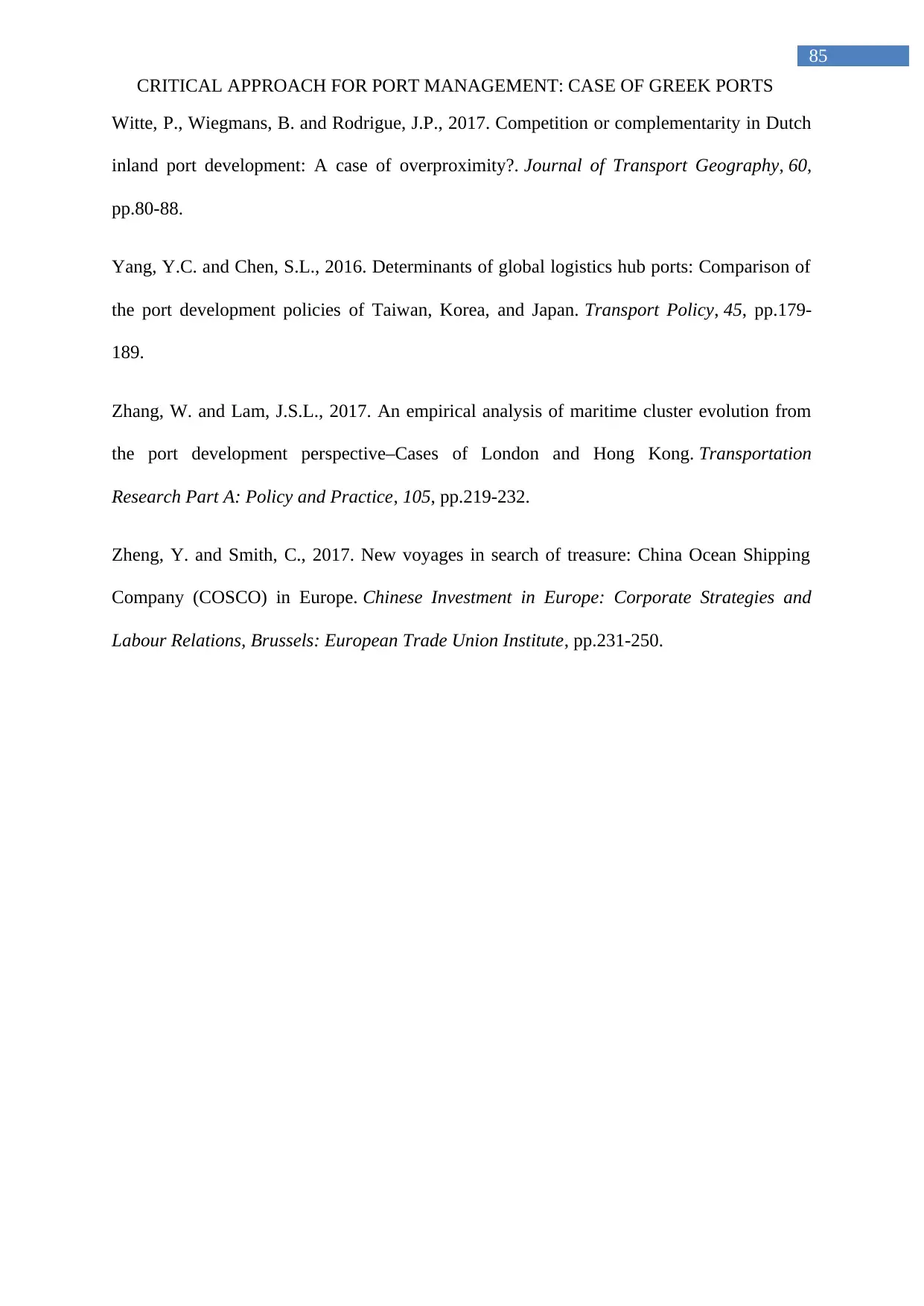
85
CRITICAL APPROACH FOR PORT MANAGEMENT: CASE OF GREEK PORTS
Witte, P., Wiegmans, B. and Rodrigue, J.P., 2017. Competition or complementarity in Dutch
inland port development: A case of overproximity?. Journal of Transport Geography, 60,
pp.80-88.
Yang, Y.C. and Chen, S.L., 2016. Determinants of global logistics hub ports: Comparison of
the port development policies of Taiwan, Korea, and Japan. Transport Policy, 45, pp.179-
189.
Zhang, W. and Lam, J.S.L., 2017. An empirical analysis of maritime cluster evolution from
the port development perspective–Cases of London and Hong Kong. Transportation
Research Part A: Policy and Practice, 105, pp.219-232.
Zheng, Y. and Smith, C., 2017. New voyages in search of treasure: China Ocean Shipping
Company (COSCO) in Europe. Chinese Investment in Europe: Corporate Strategies and
Labour Relations, Brussels: European Trade Union Institute, pp.231-250.
CRITICAL APPROACH FOR PORT MANAGEMENT: CASE OF GREEK PORTS
Witte, P., Wiegmans, B. and Rodrigue, J.P., 2017. Competition or complementarity in Dutch
inland port development: A case of overproximity?. Journal of Transport Geography, 60,
pp.80-88.
Yang, Y.C. and Chen, S.L., 2016. Determinants of global logistics hub ports: Comparison of
the port development policies of Taiwan, Korea, and Japan. Transport Policy, 45, pp.179-
189.
Zhang, W. and Lam, J.S.L., 2017. An empirical analysis of maritime cluster evolution from
the port development perspective–Cases of London and Hong Kong. Transportation
Research Part A: Policy and Practice, 105, pp.219-232.
Zheng, Y. and Smith, C., 2017. New voyages in search of treasure: China Ocean Shipping
Company (COSCO) in Europe. Chinese Investment in Europe: Corporate Strategies and
Labour Relations, Brussels: European Trade Union Institute, pp.231-250.
1 out of 85
Related Documents
Your All-in-One AI-Powered Toolkit for Academic Success.
+13062052269
info@desklib.com
Available 24*7 on WhatsApp / Email
![[object Object]](/_next/static/media/star-bottom.7253800d.svg)
Unlock your academic potential
© 2024 | Zucol Services PVT LTD | All rights reserved.





